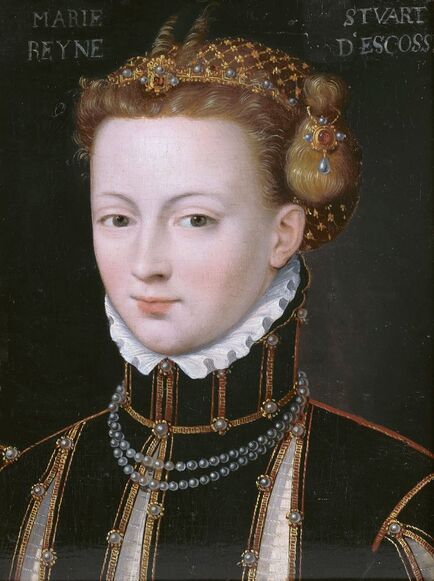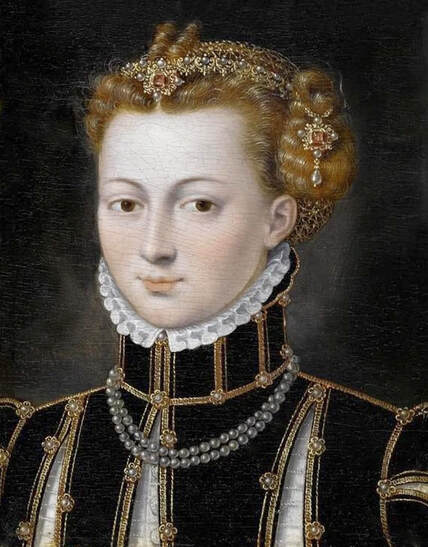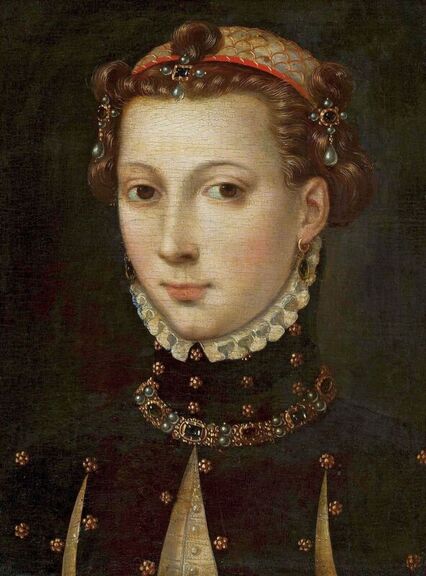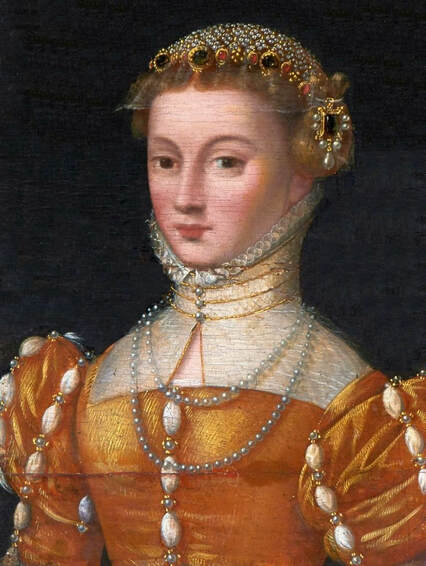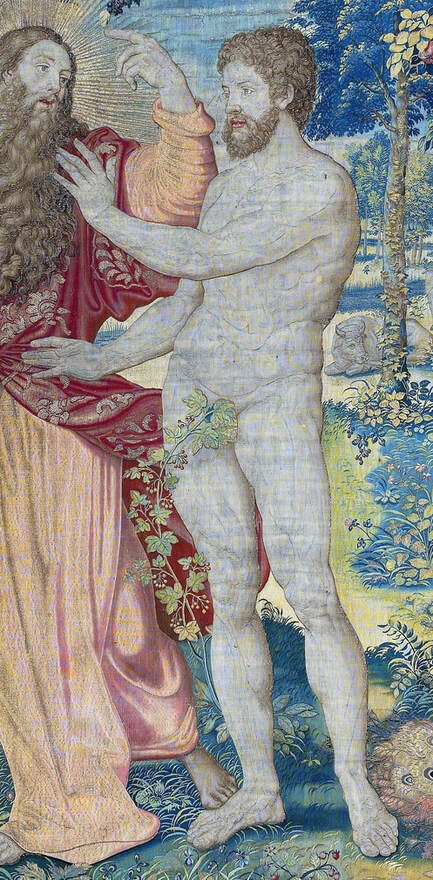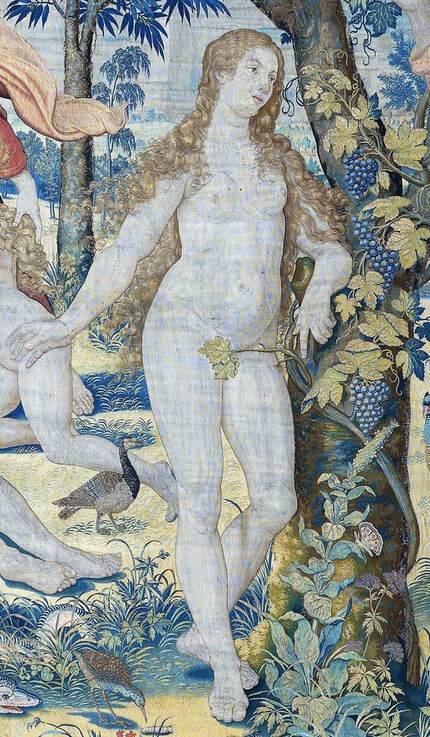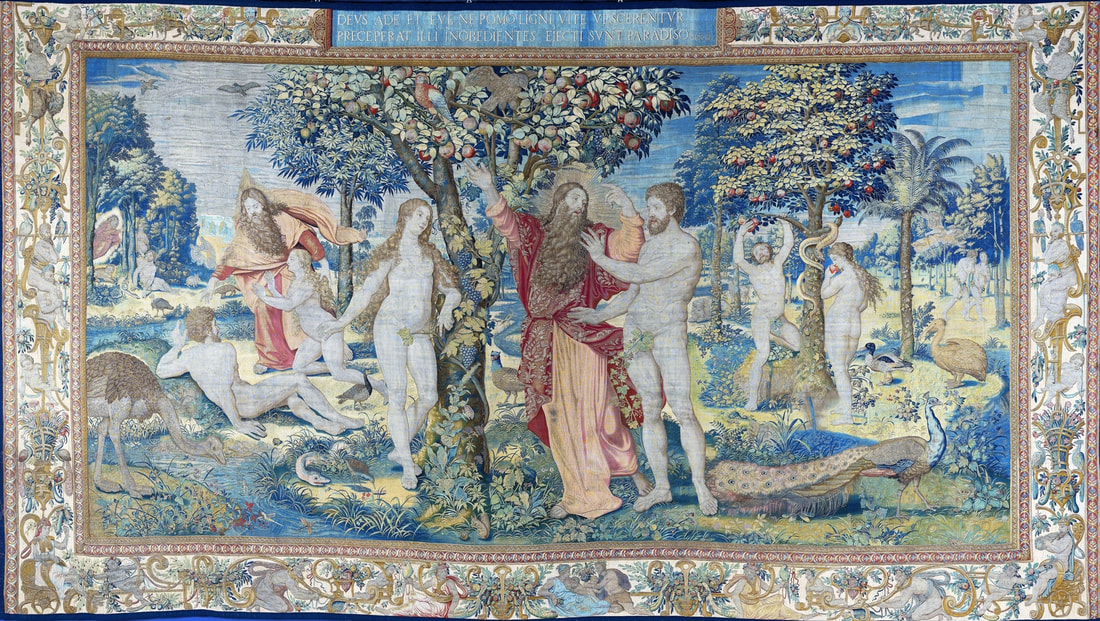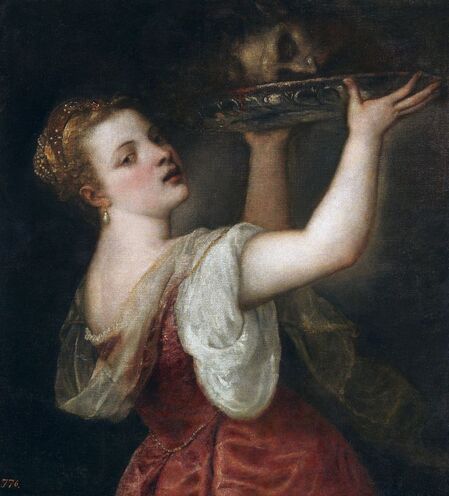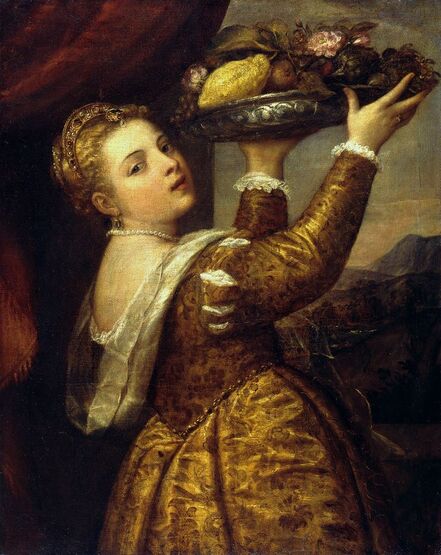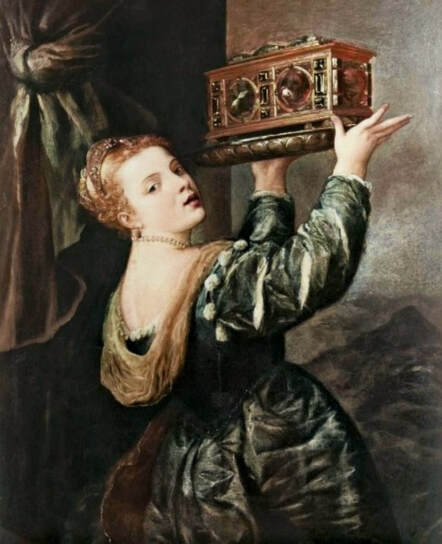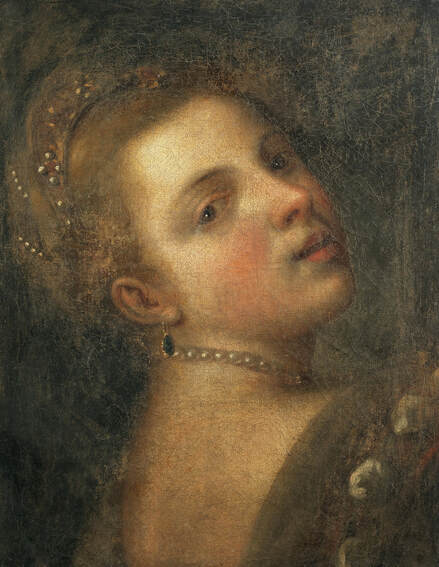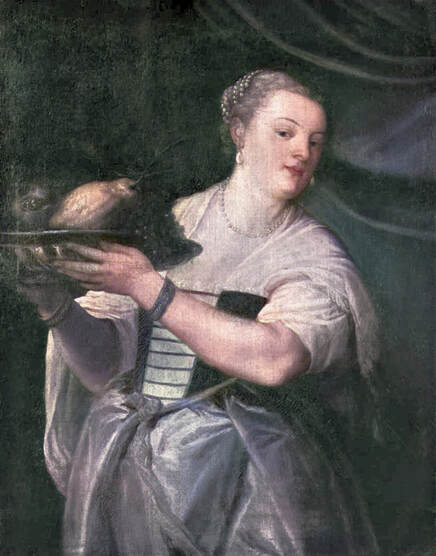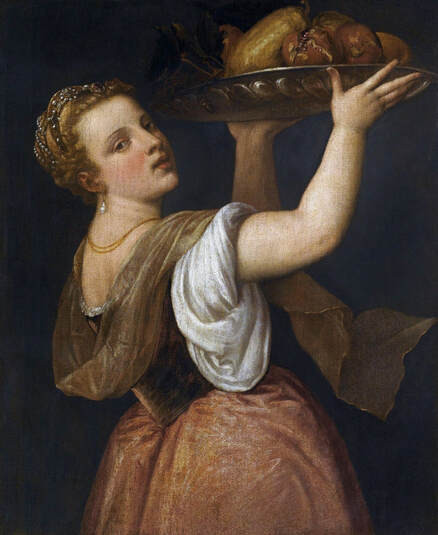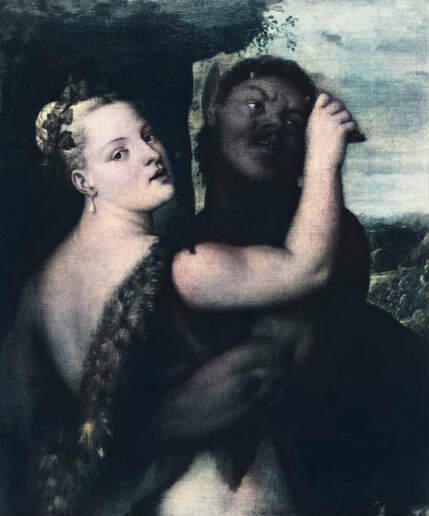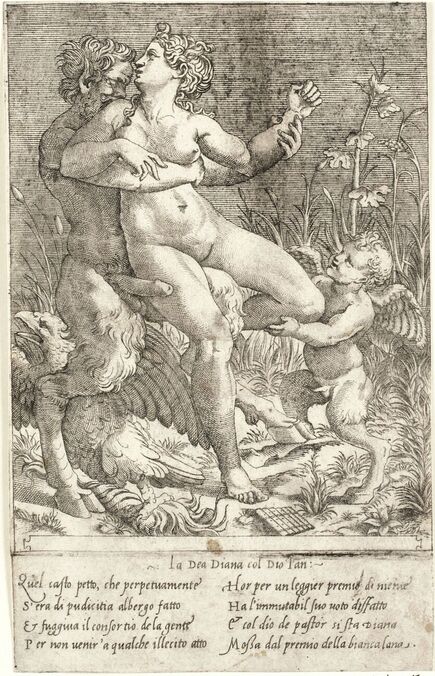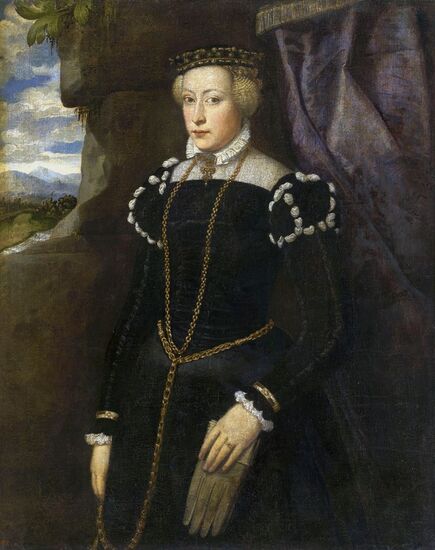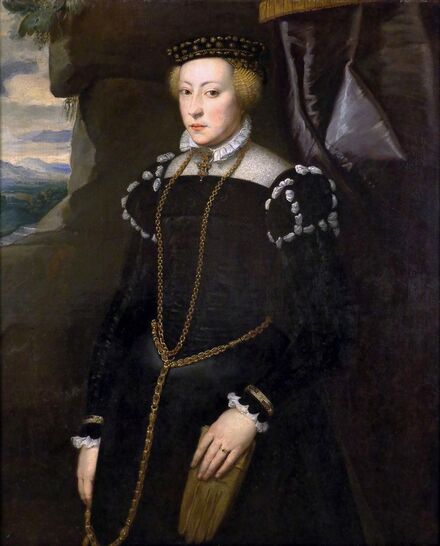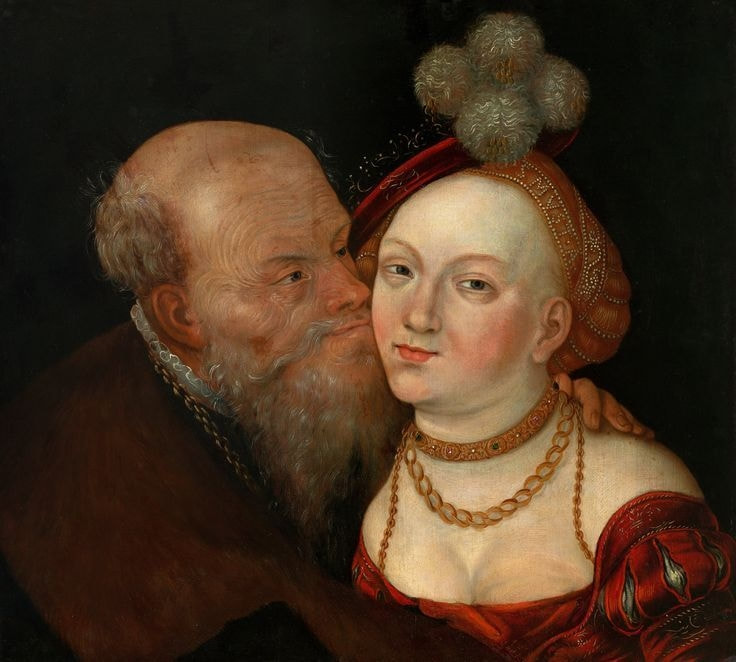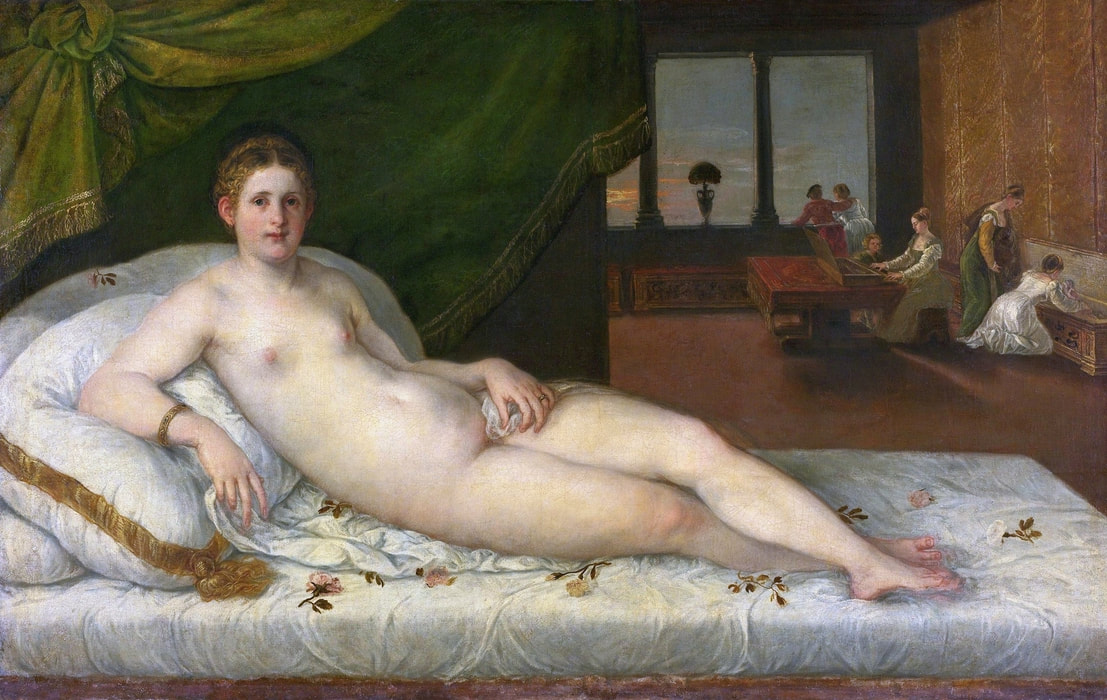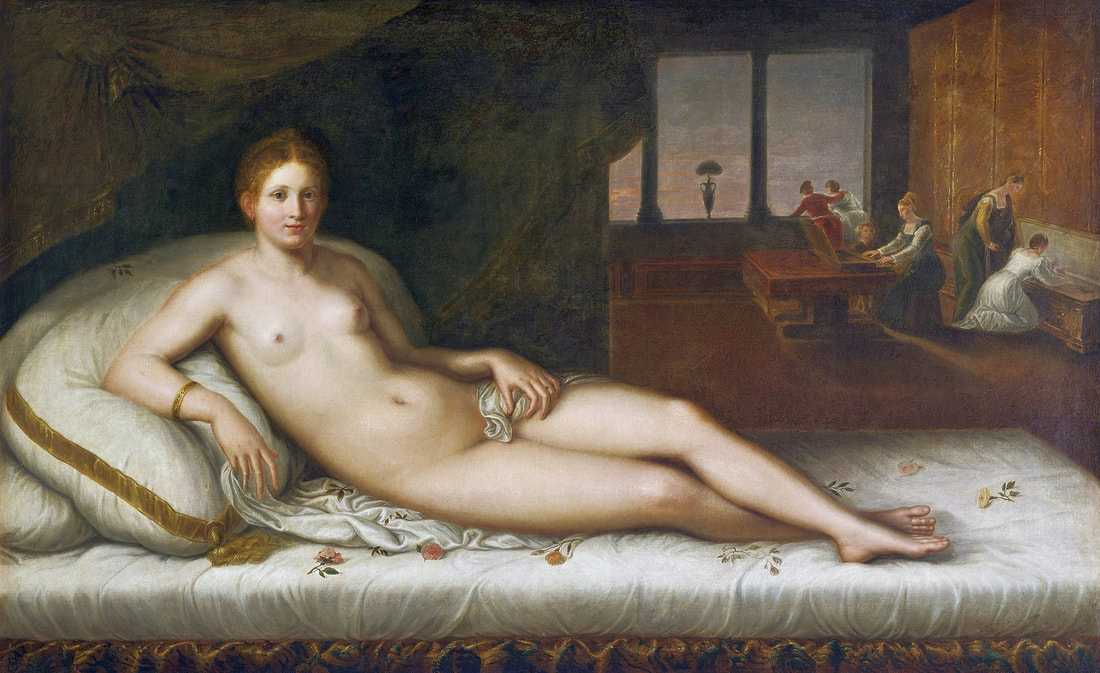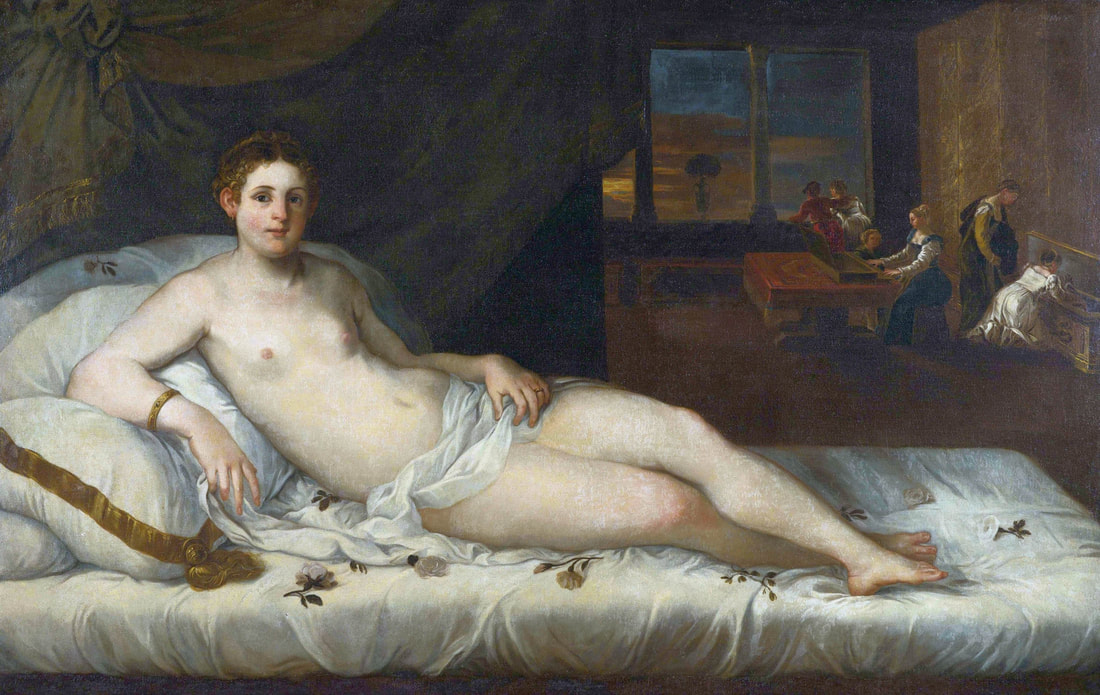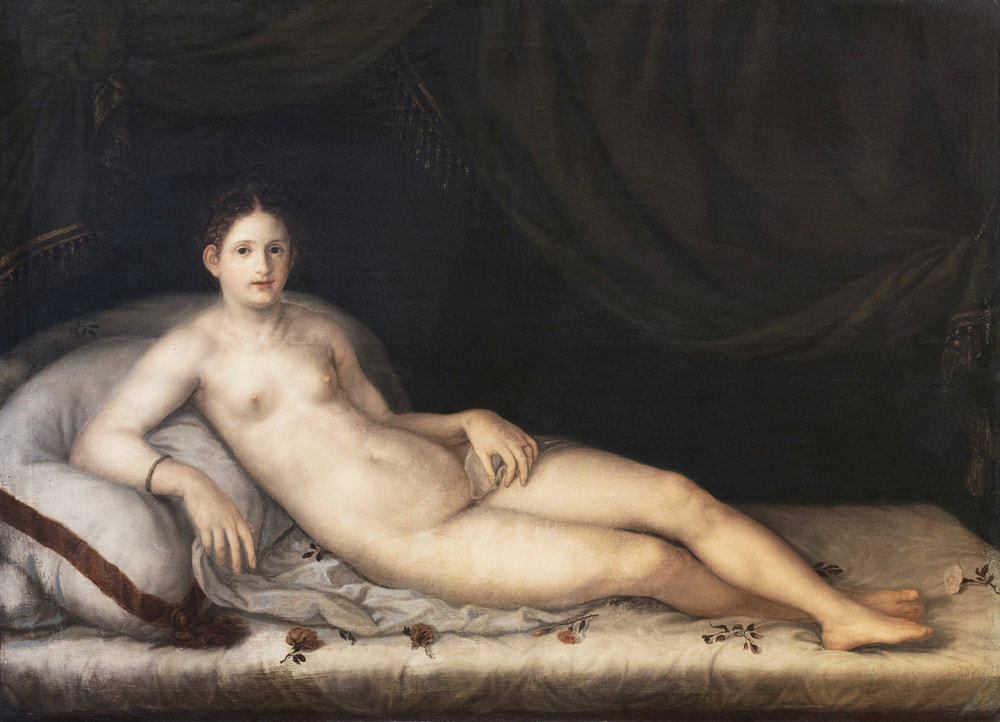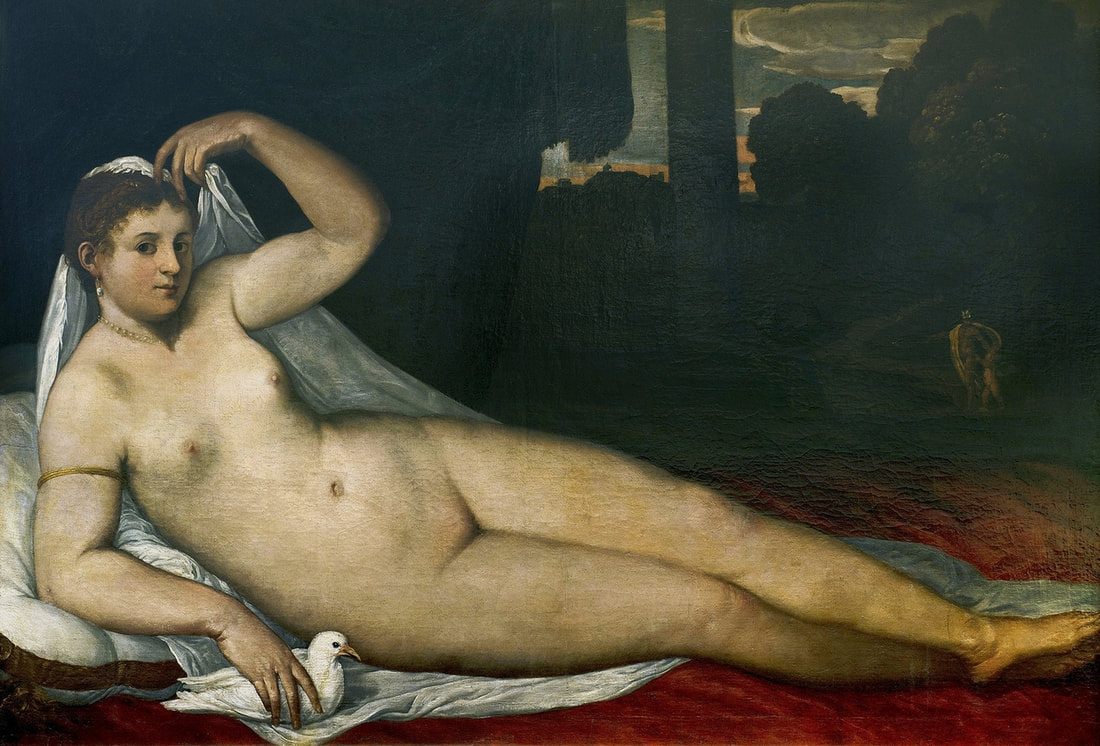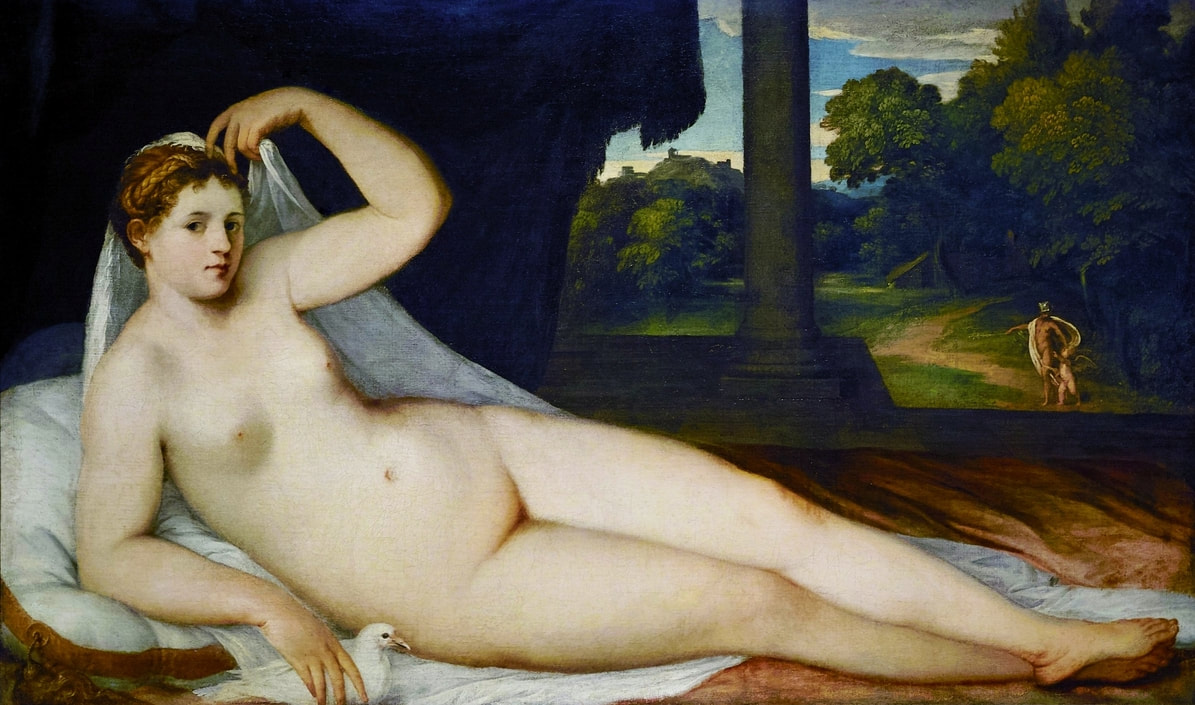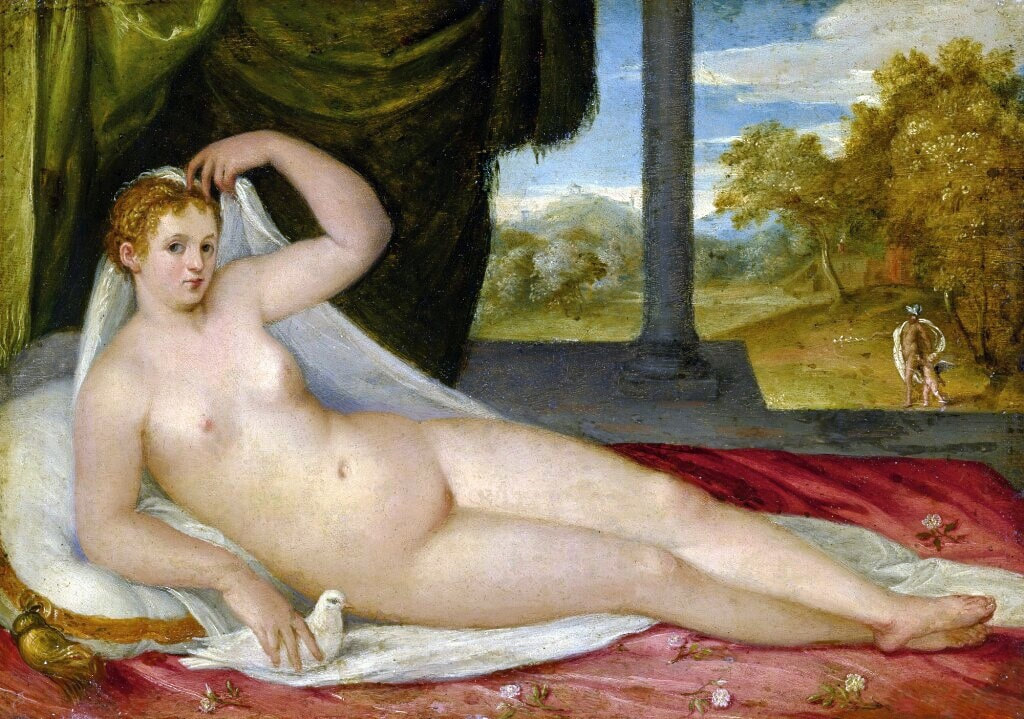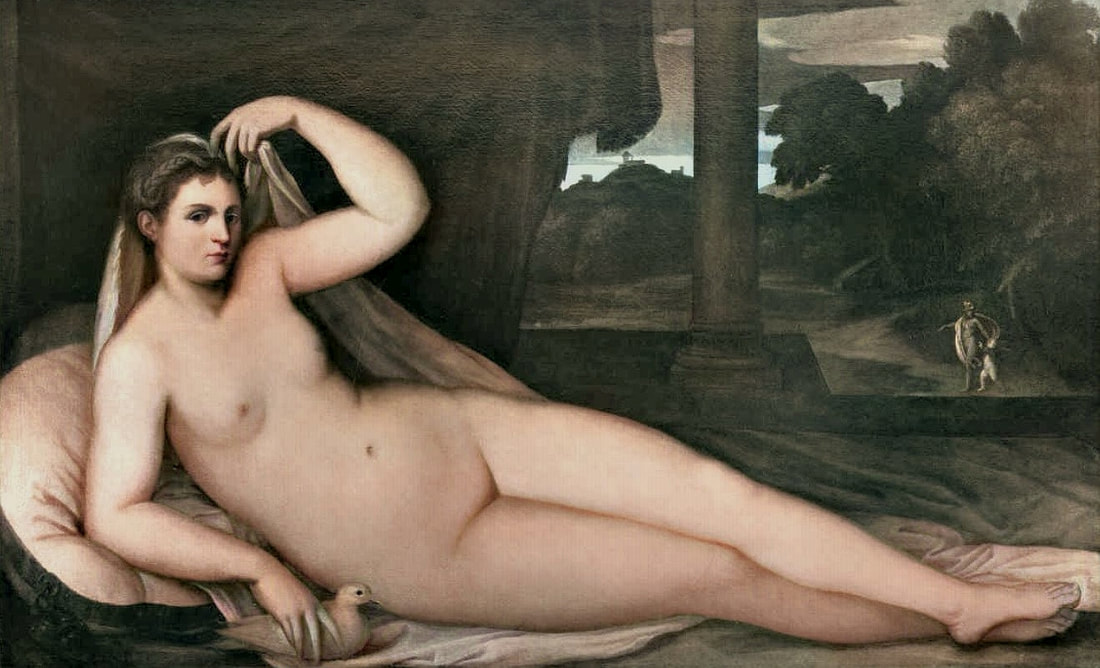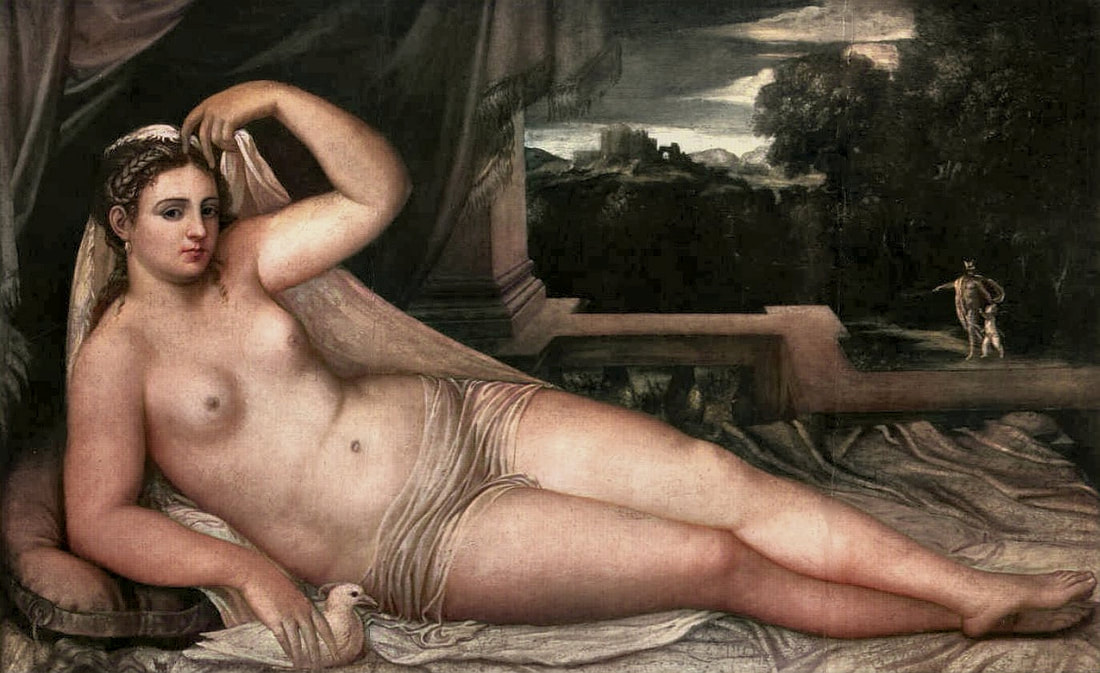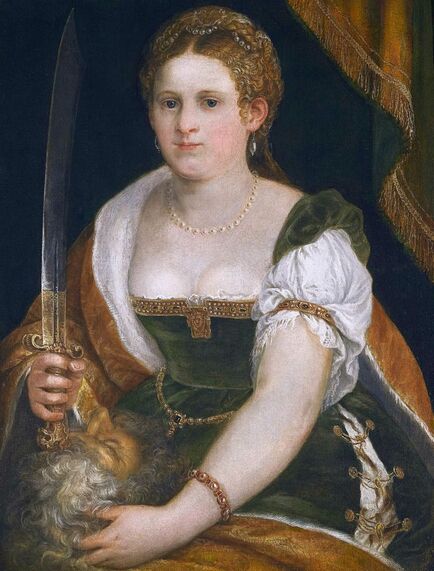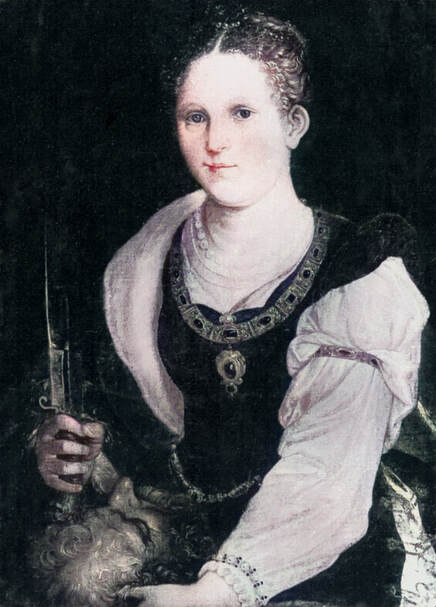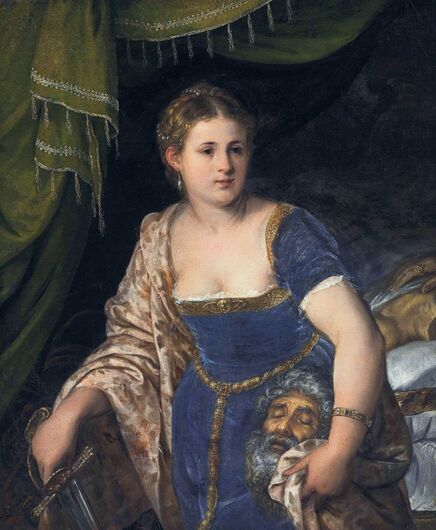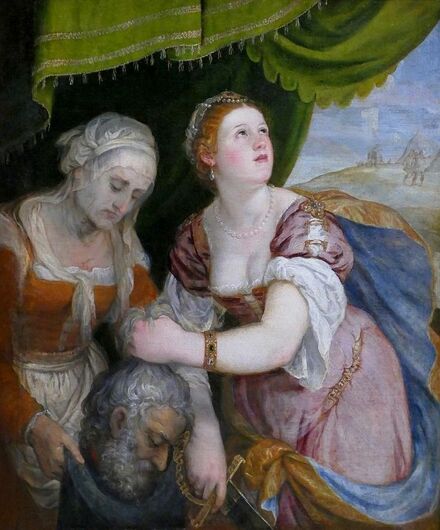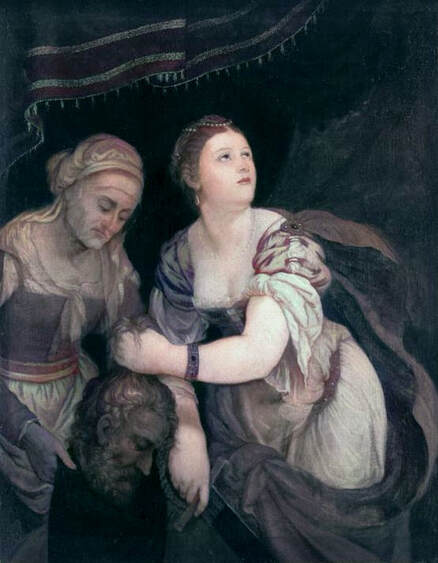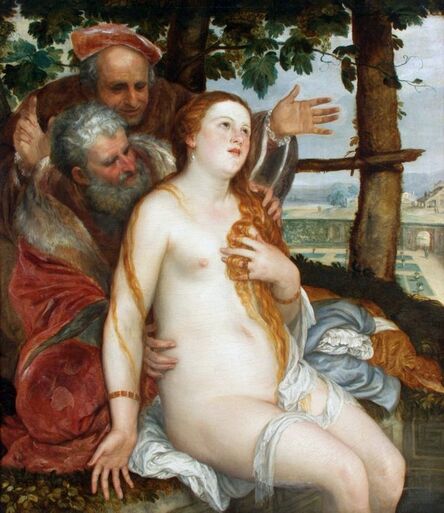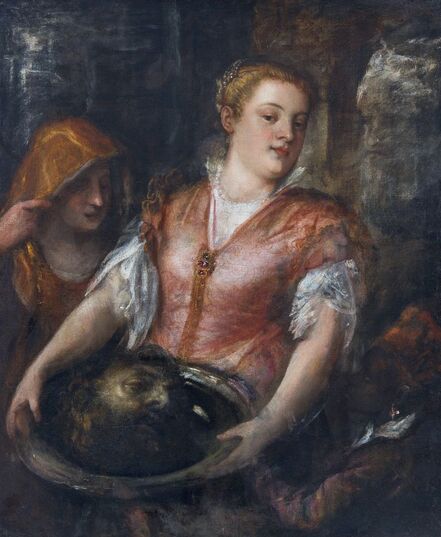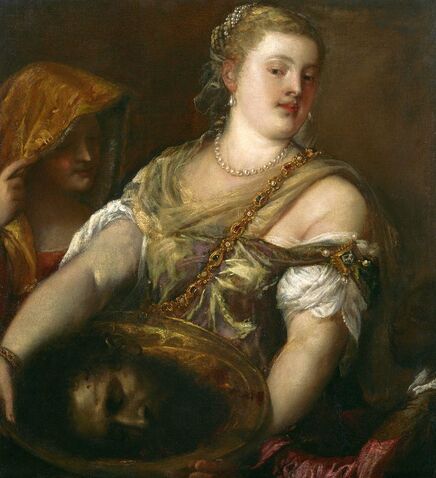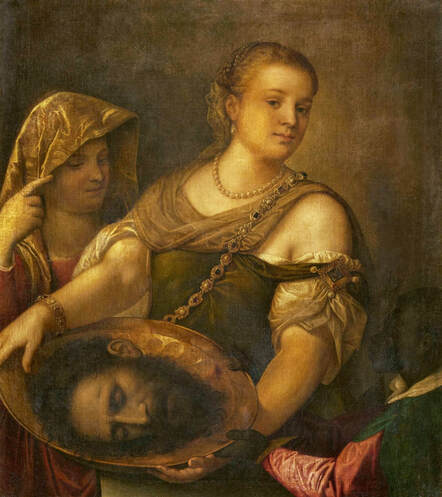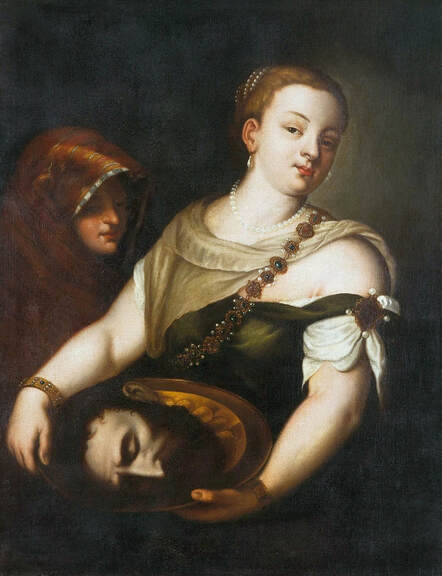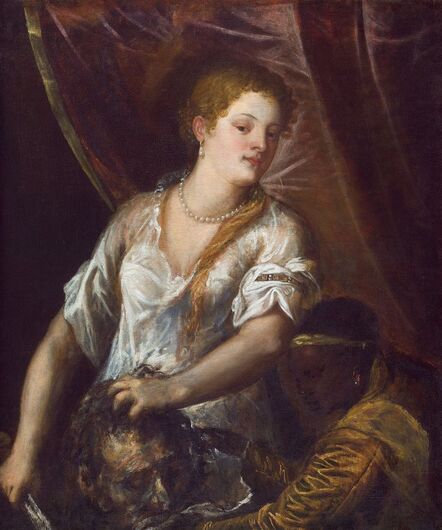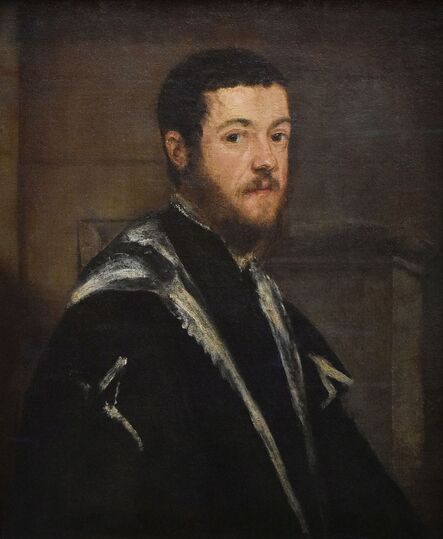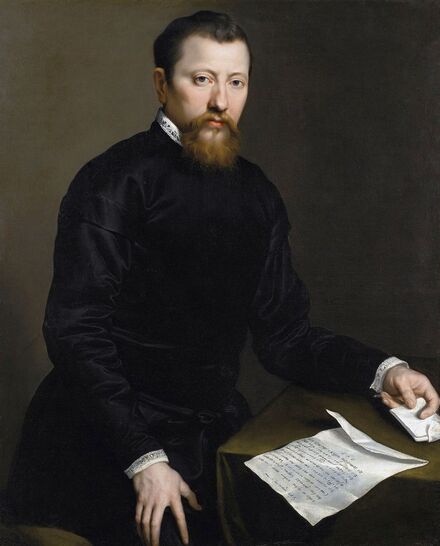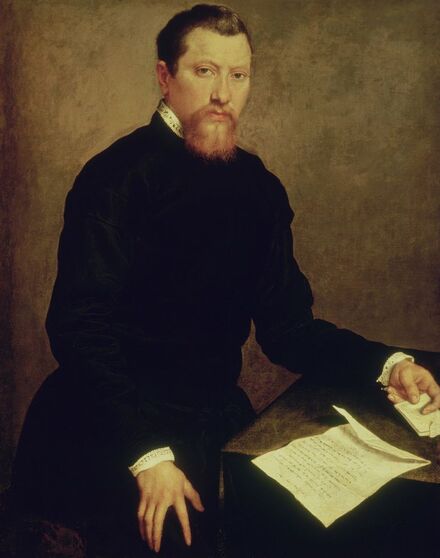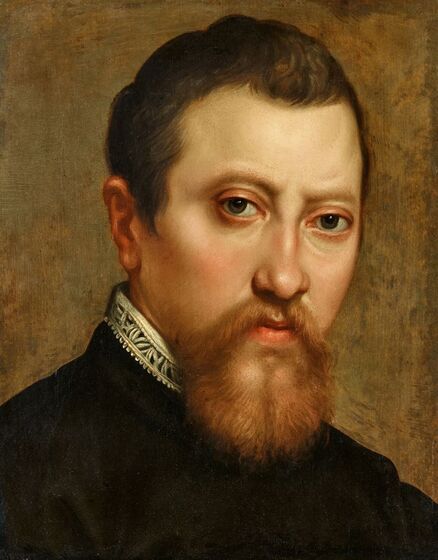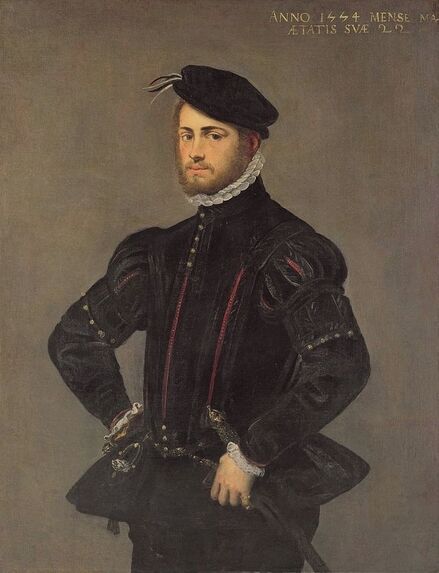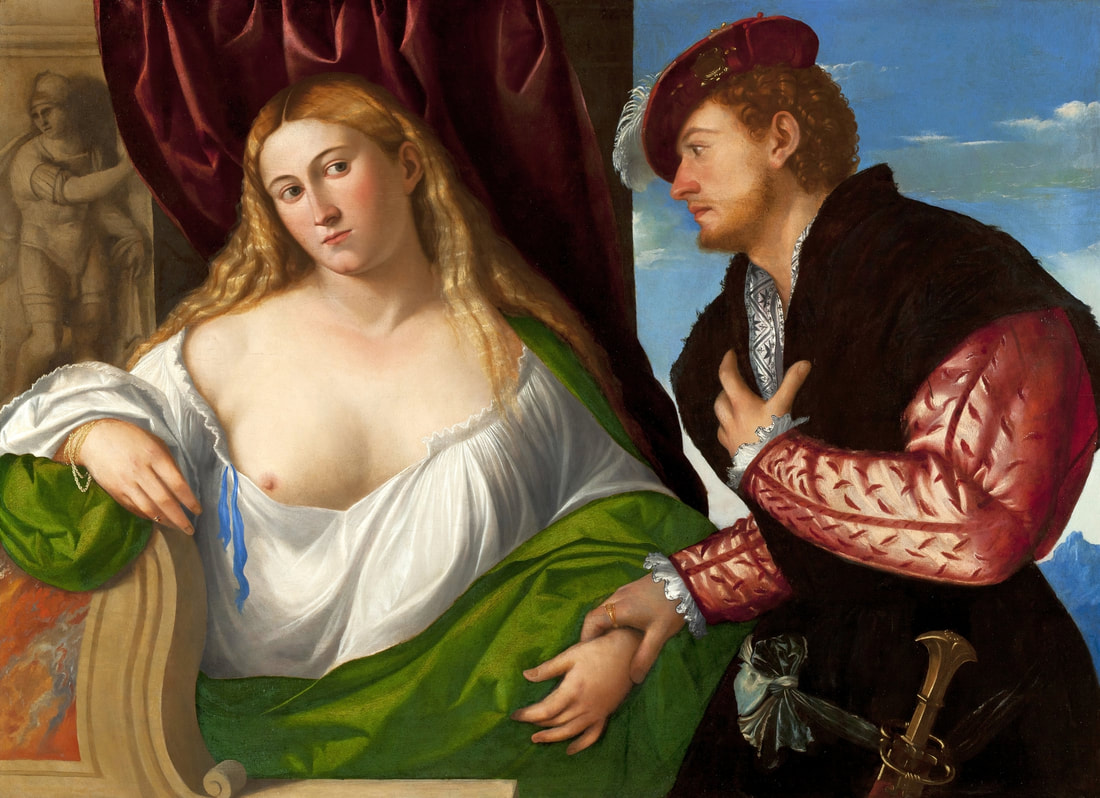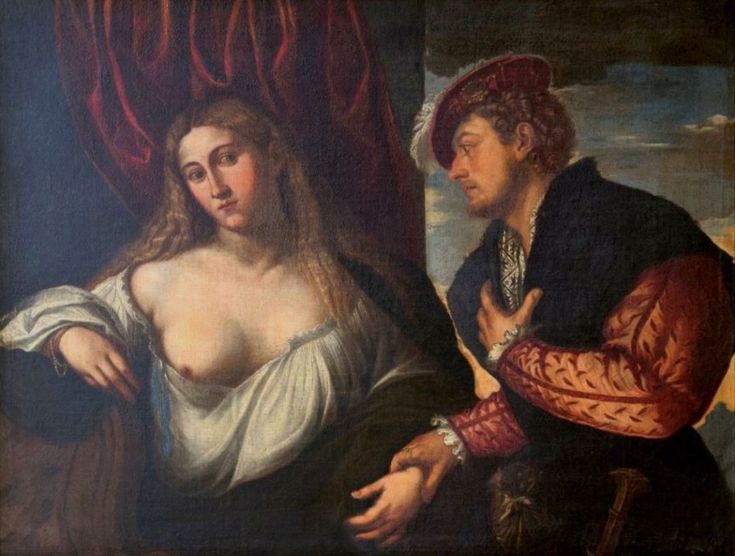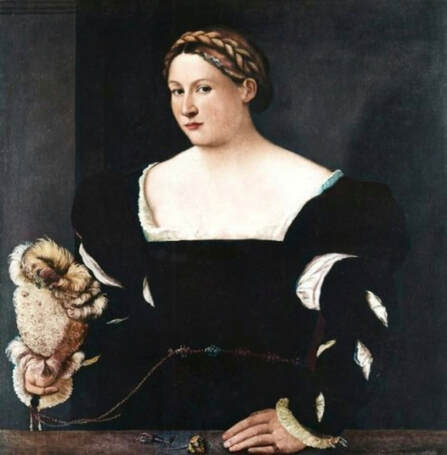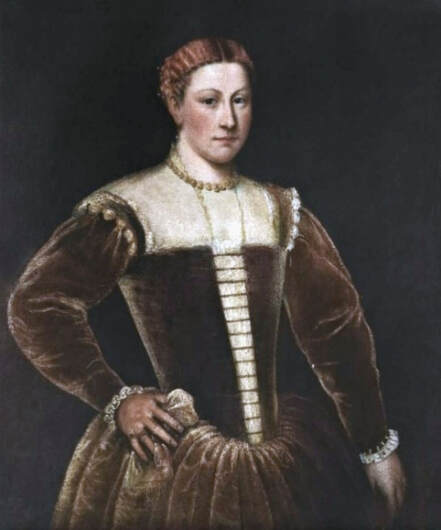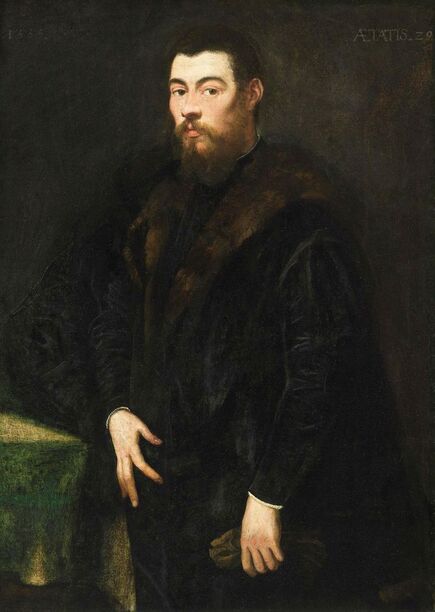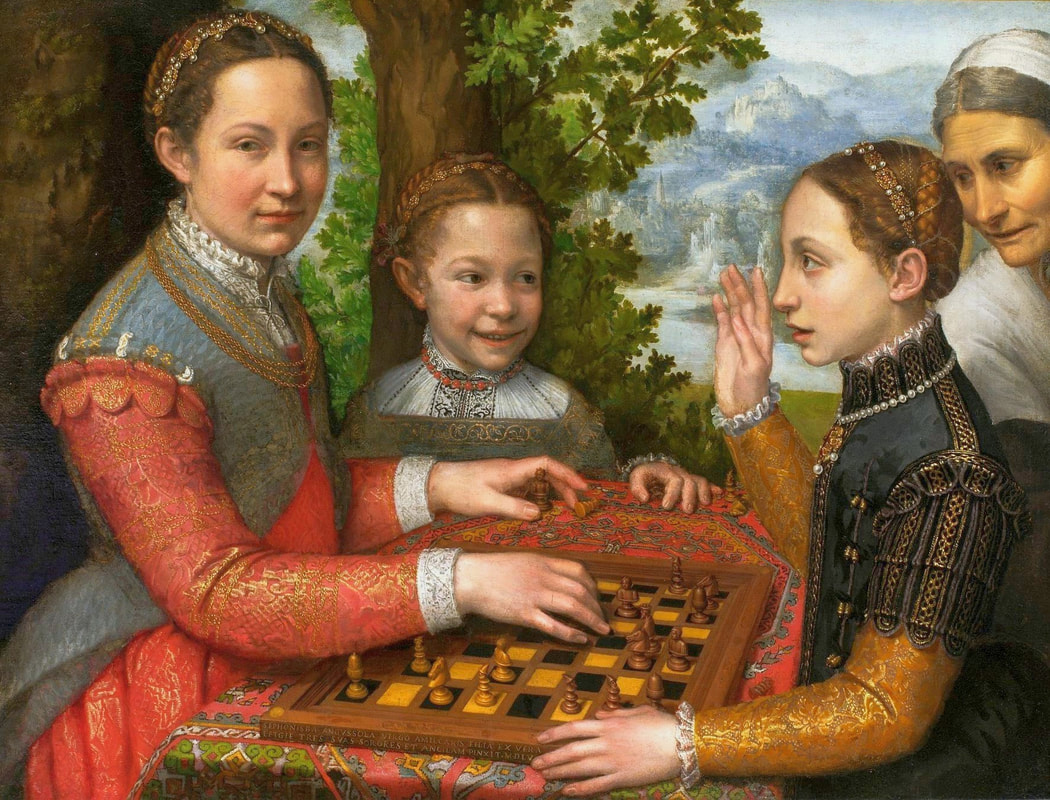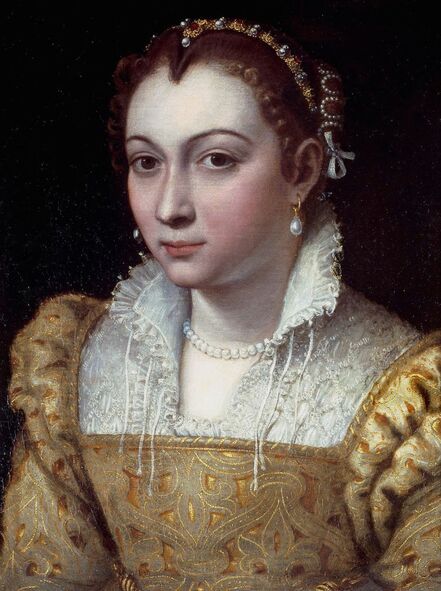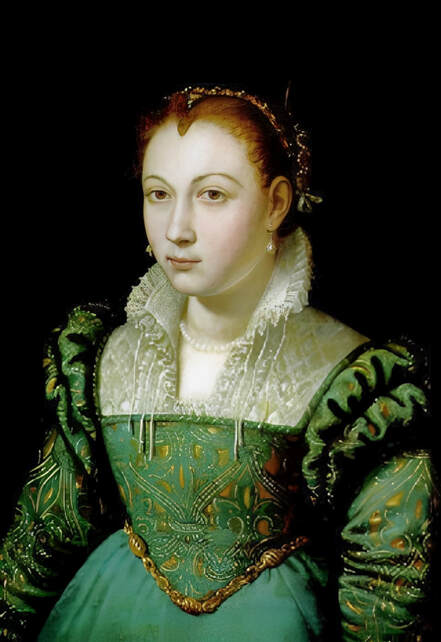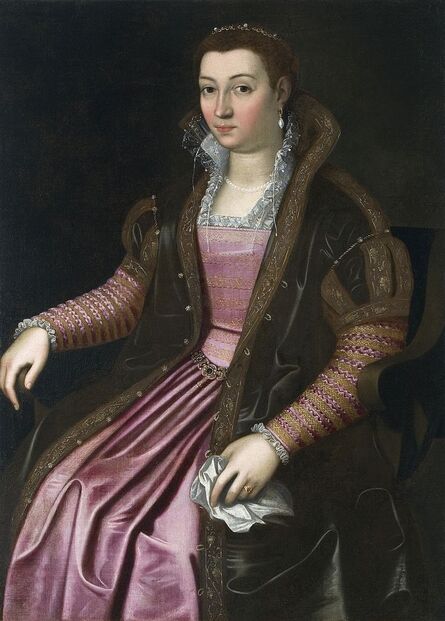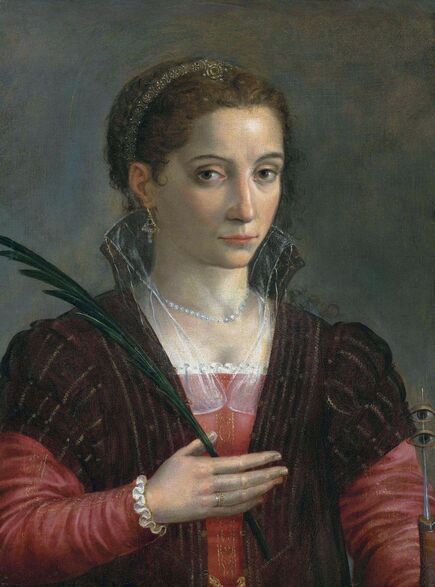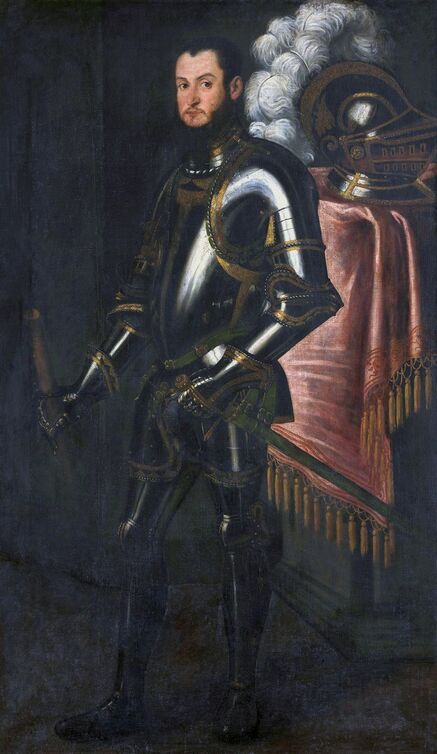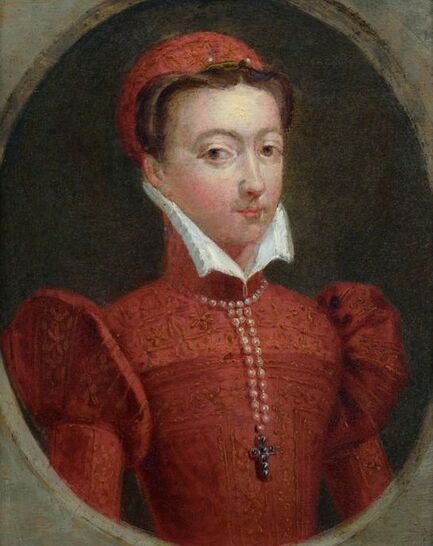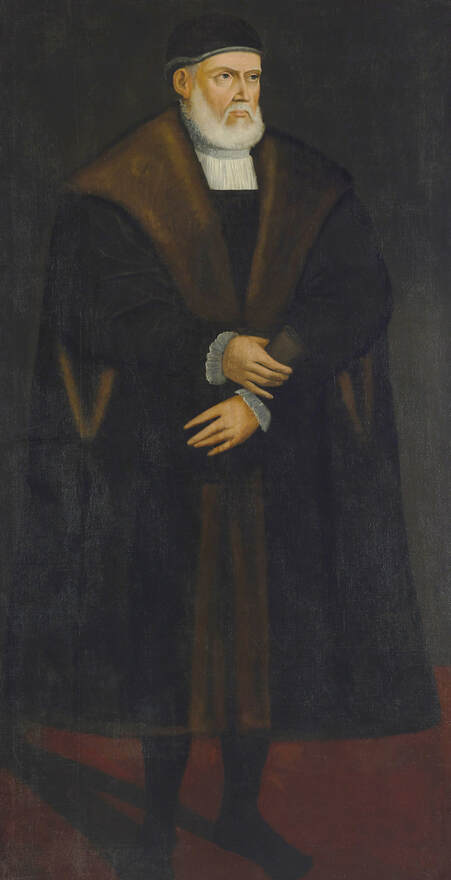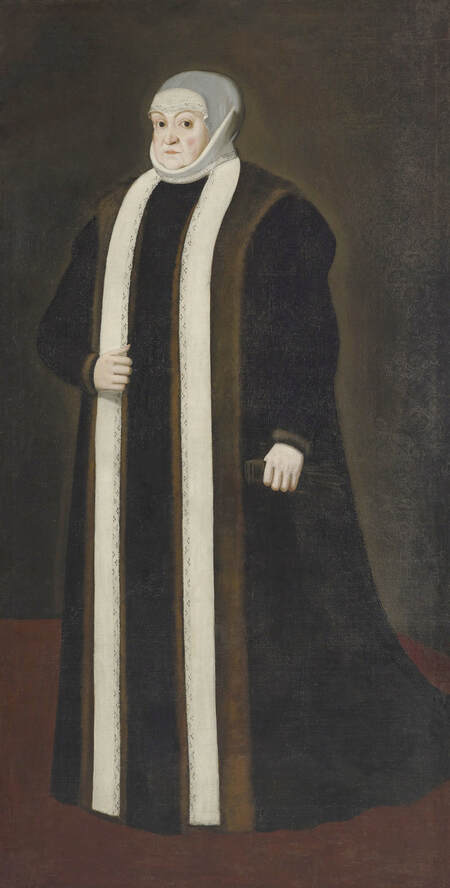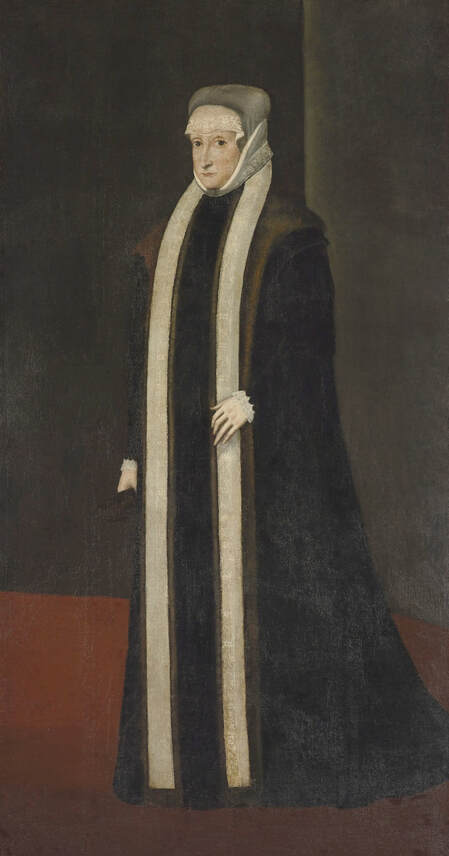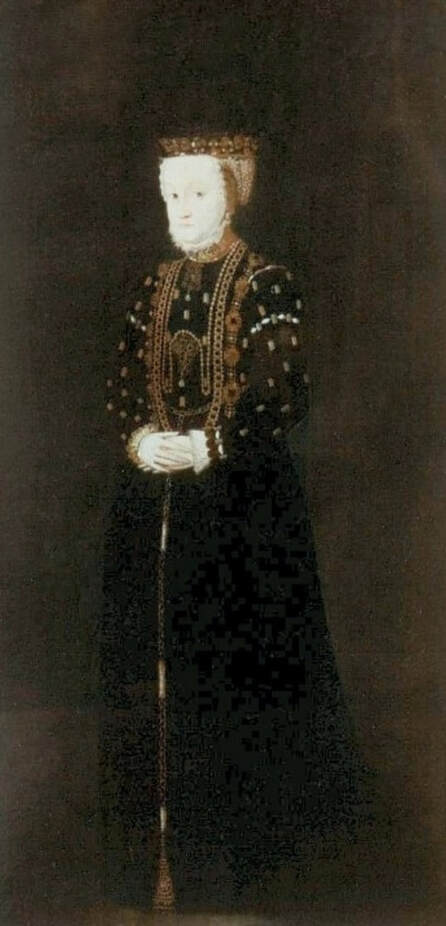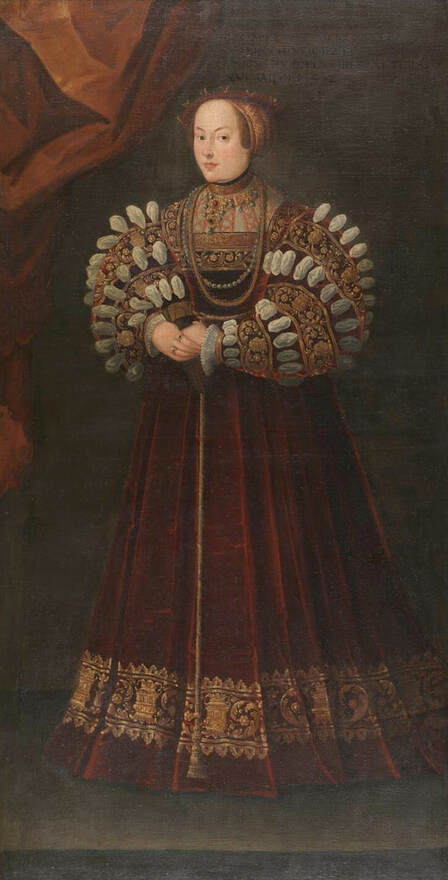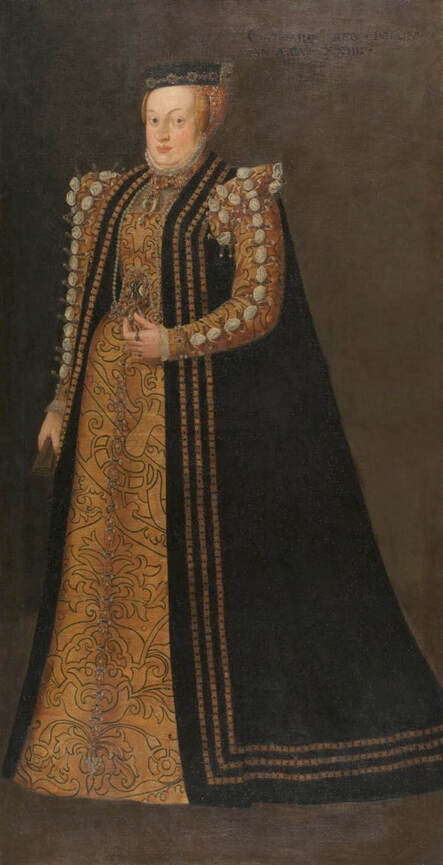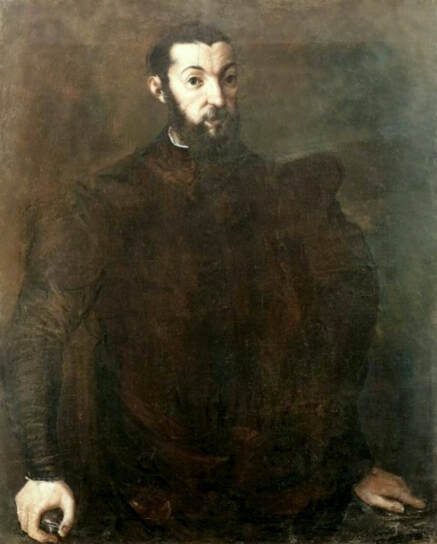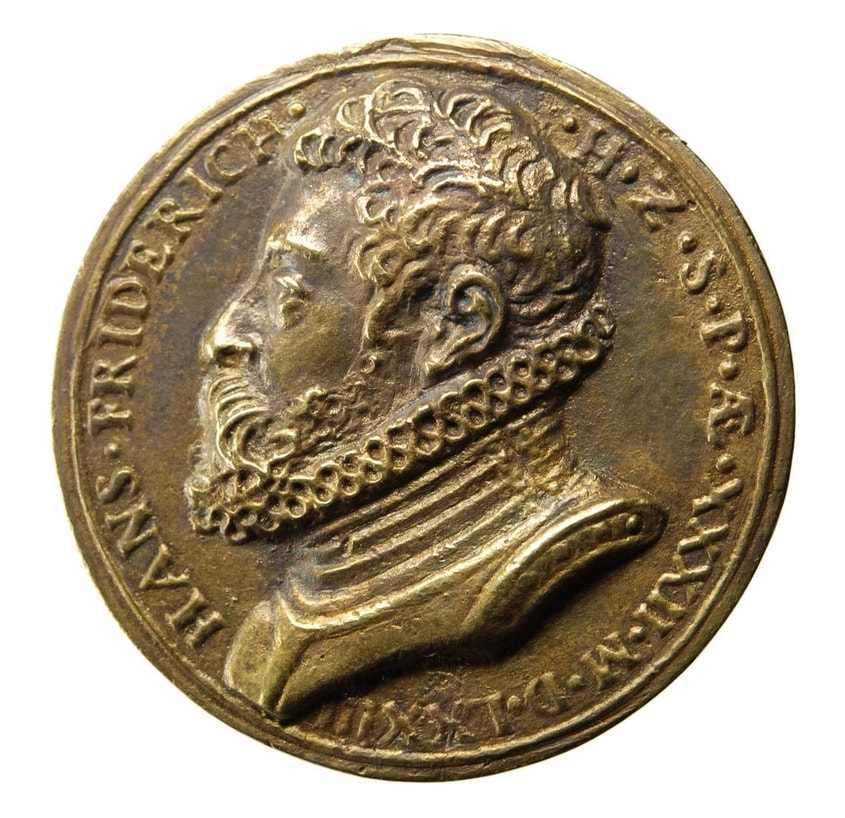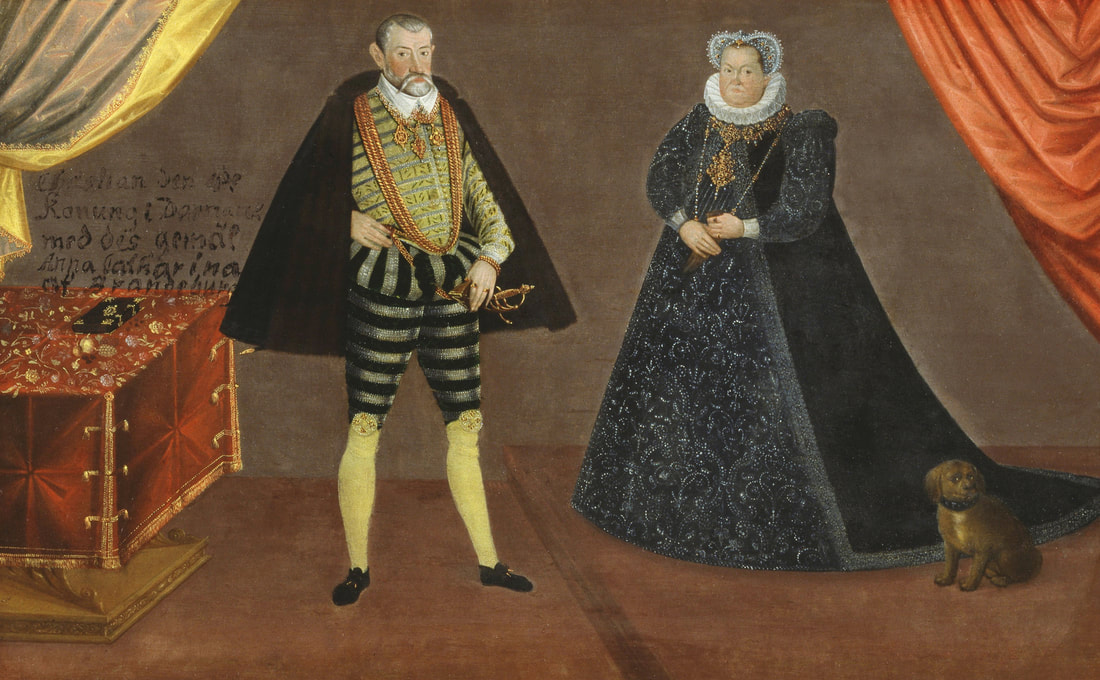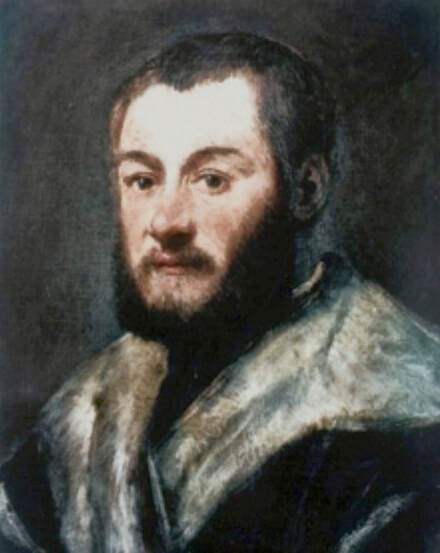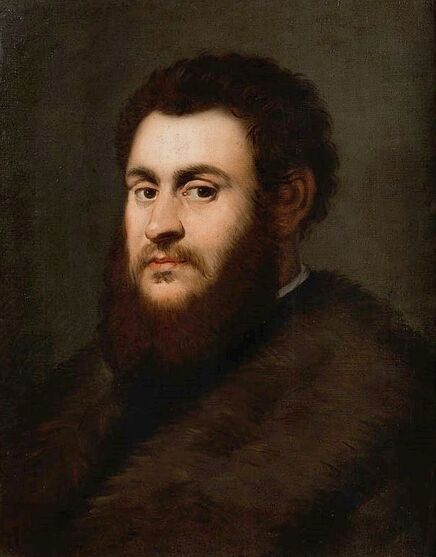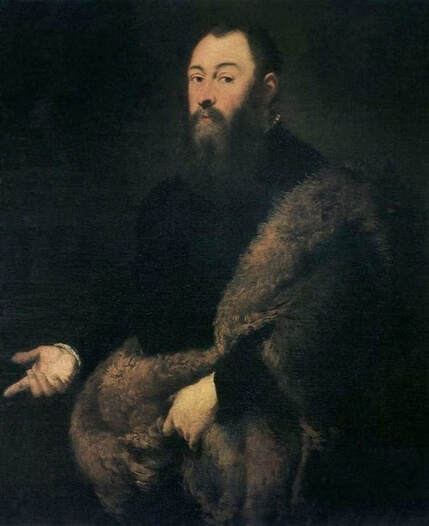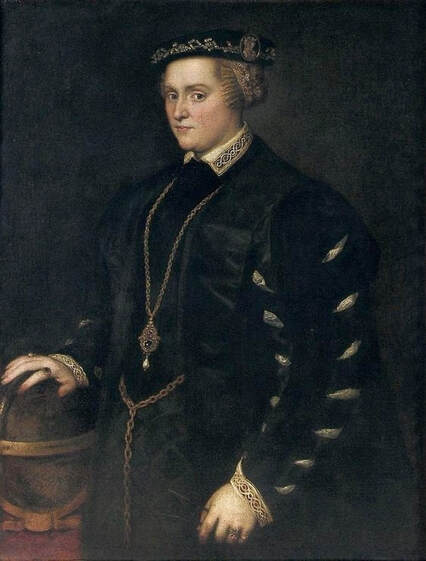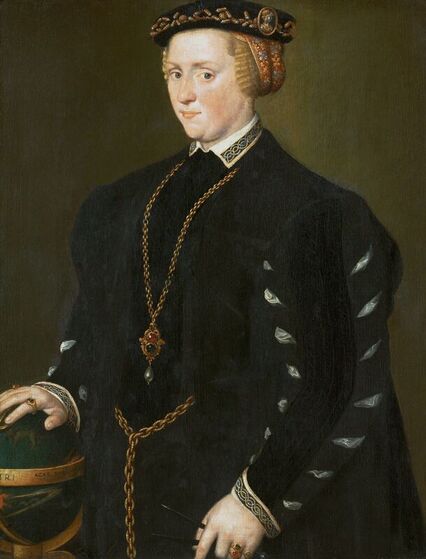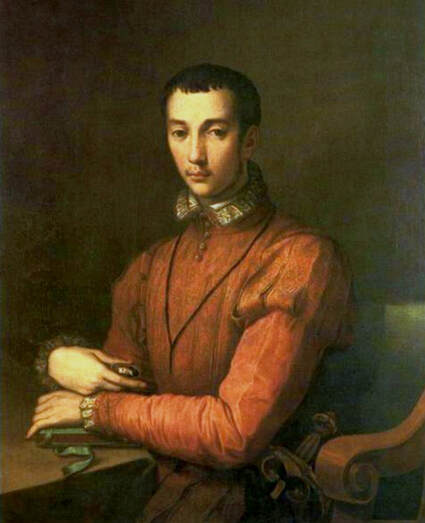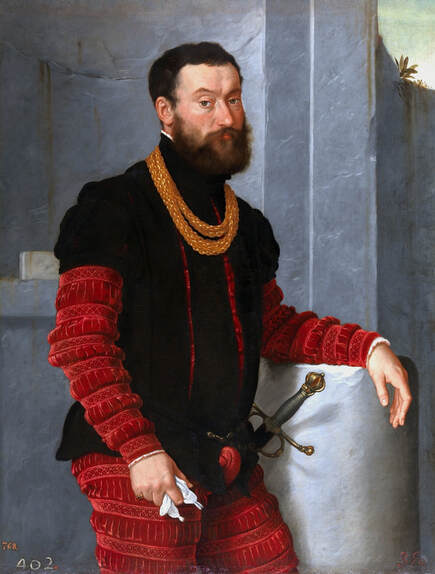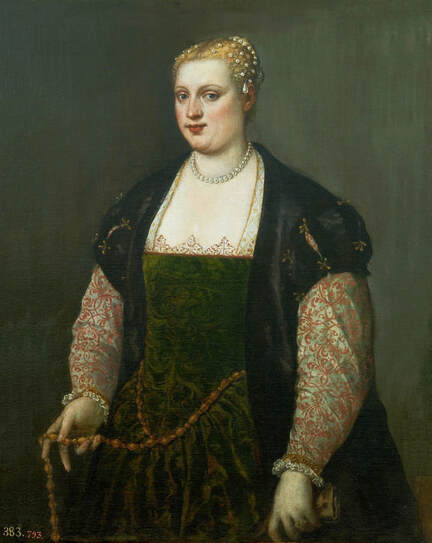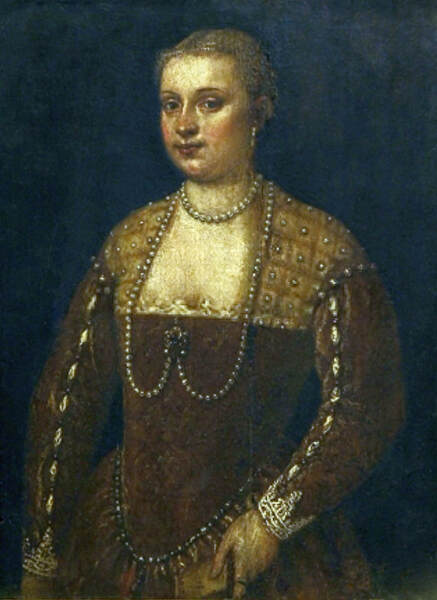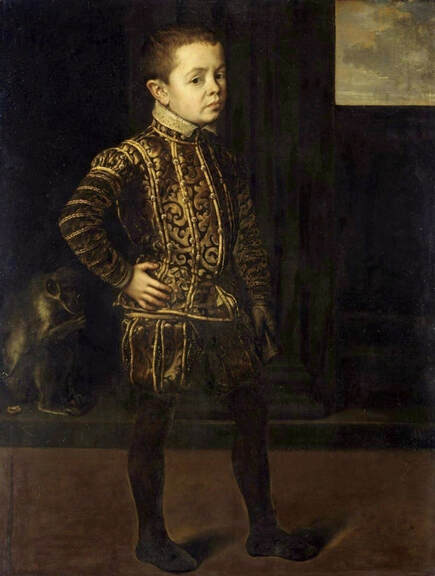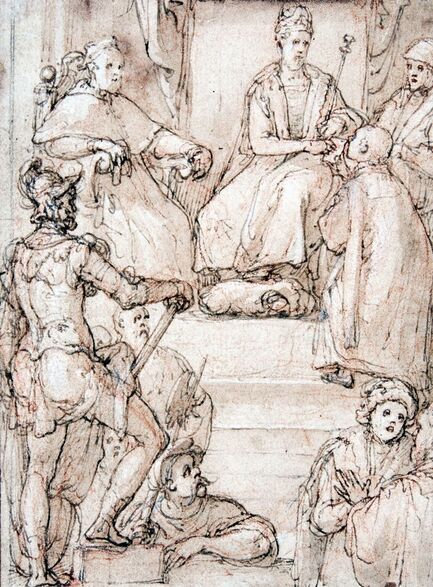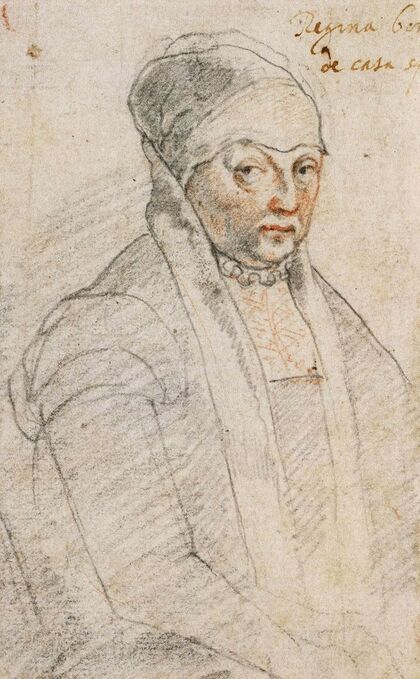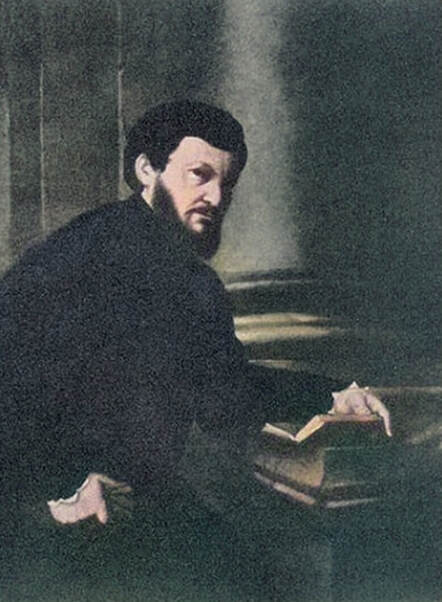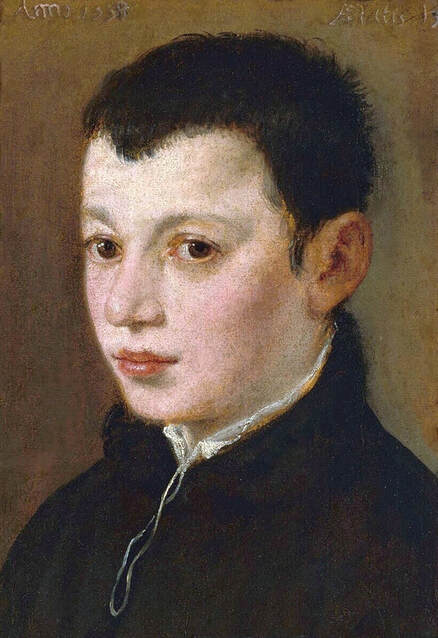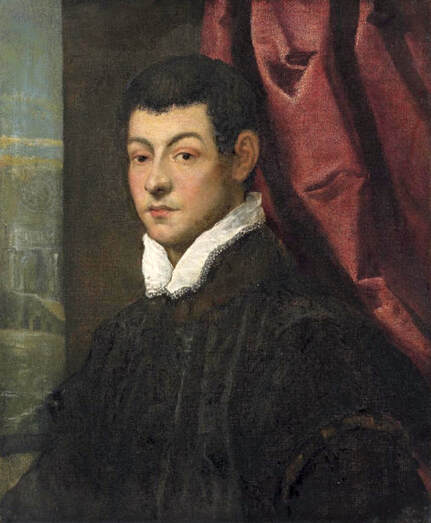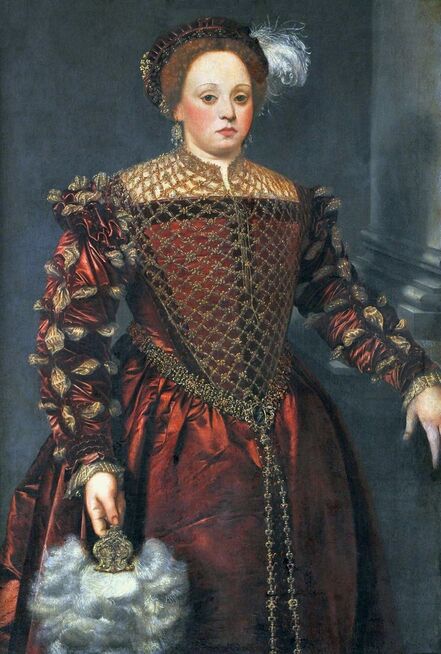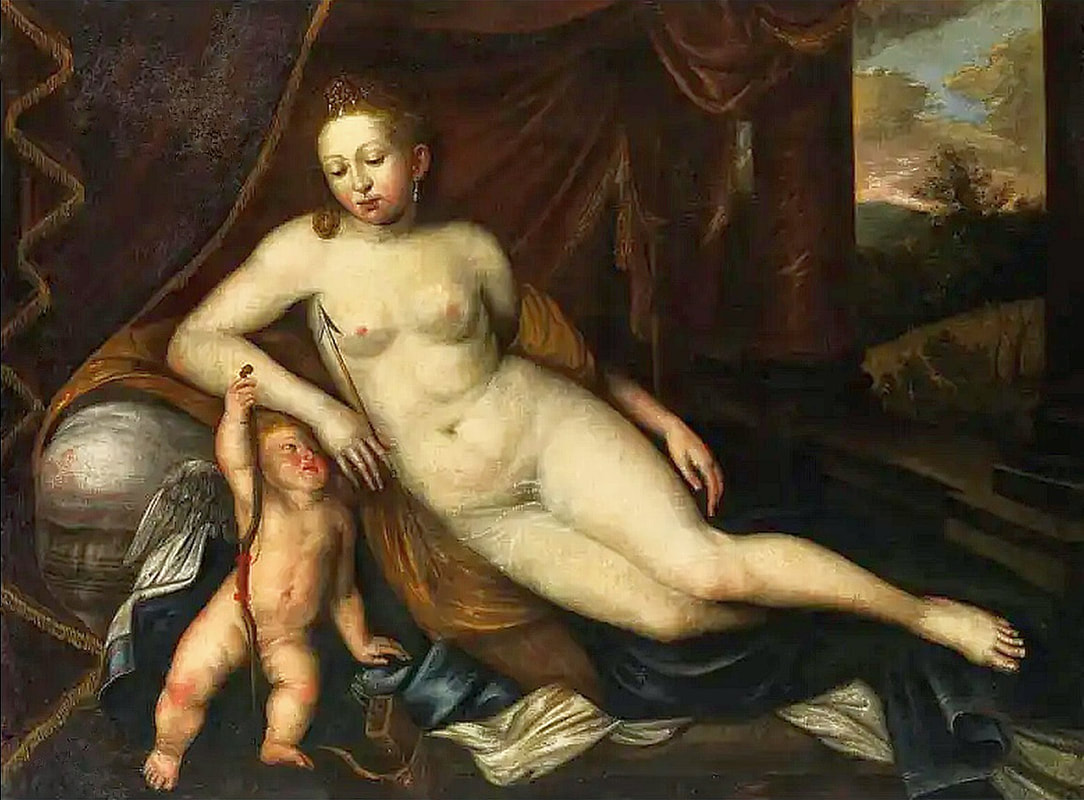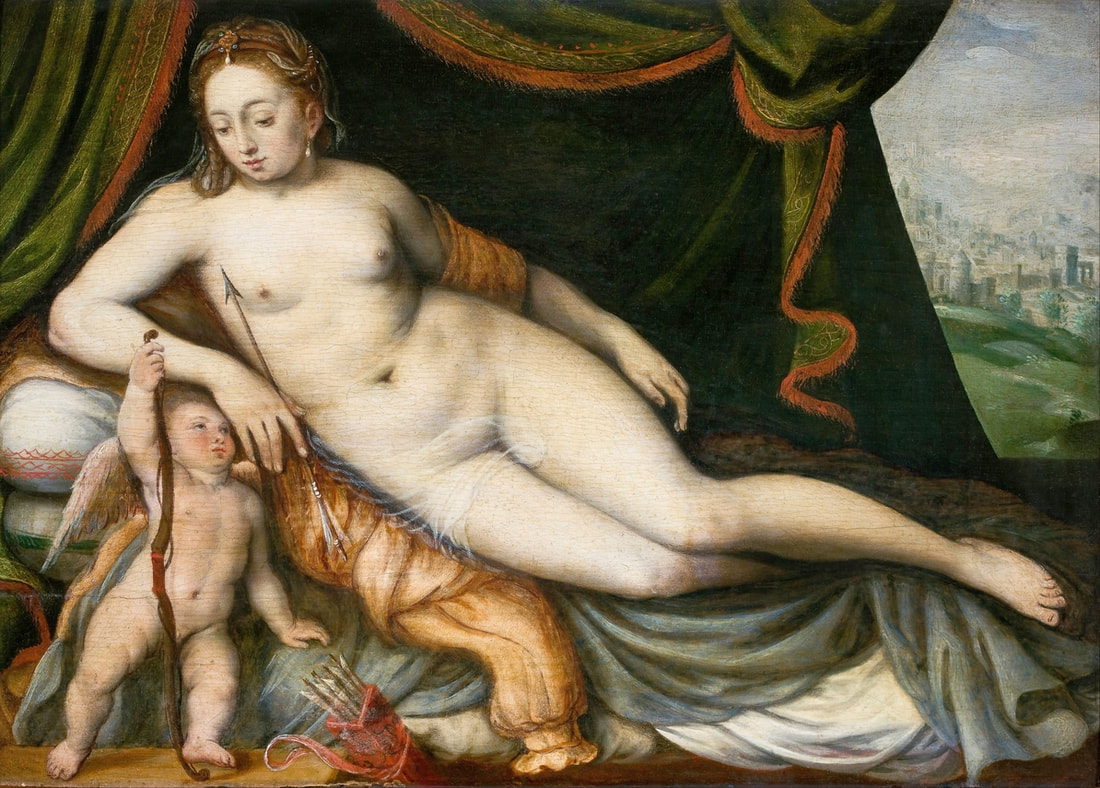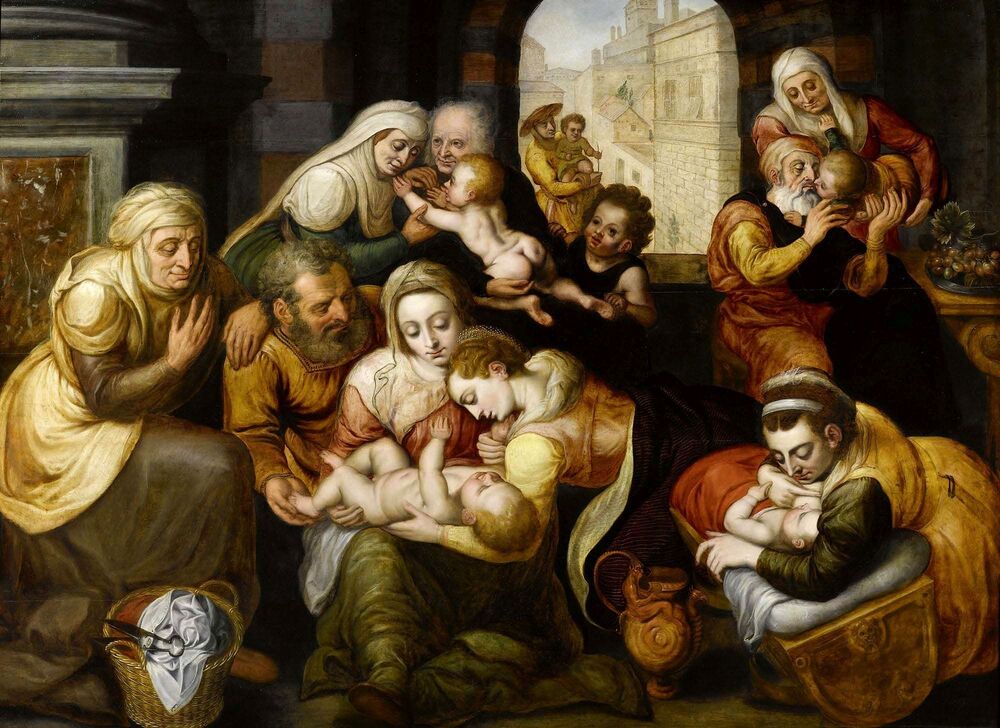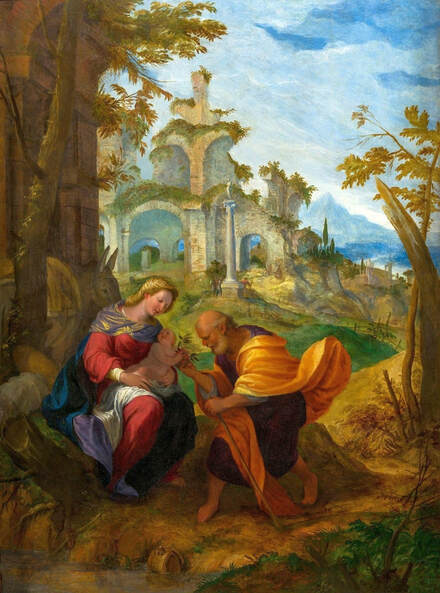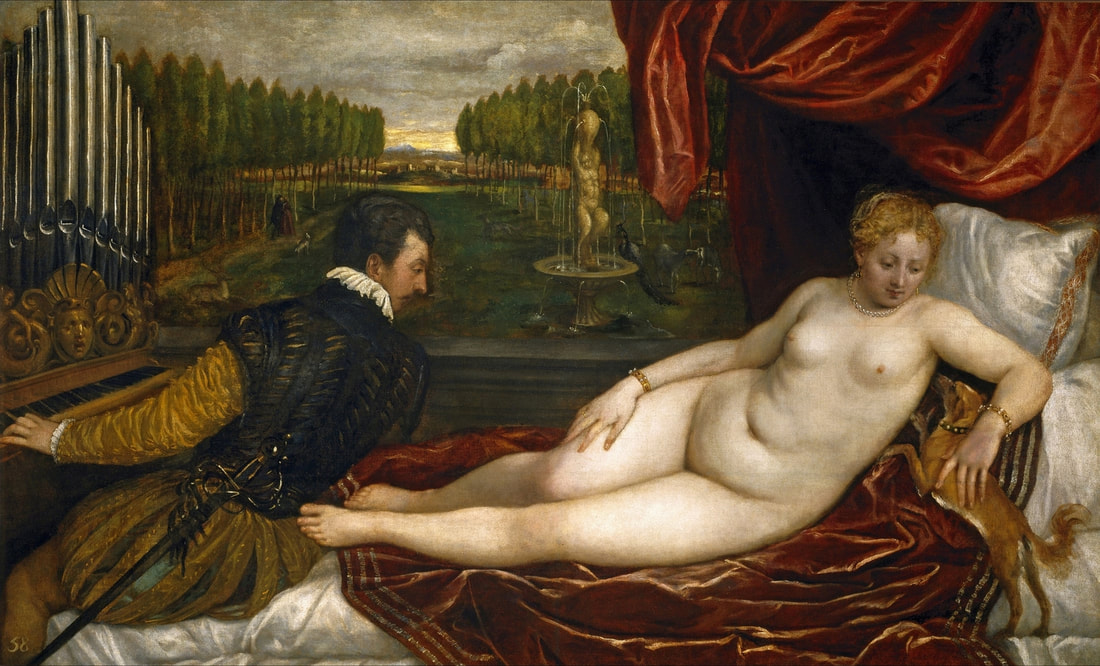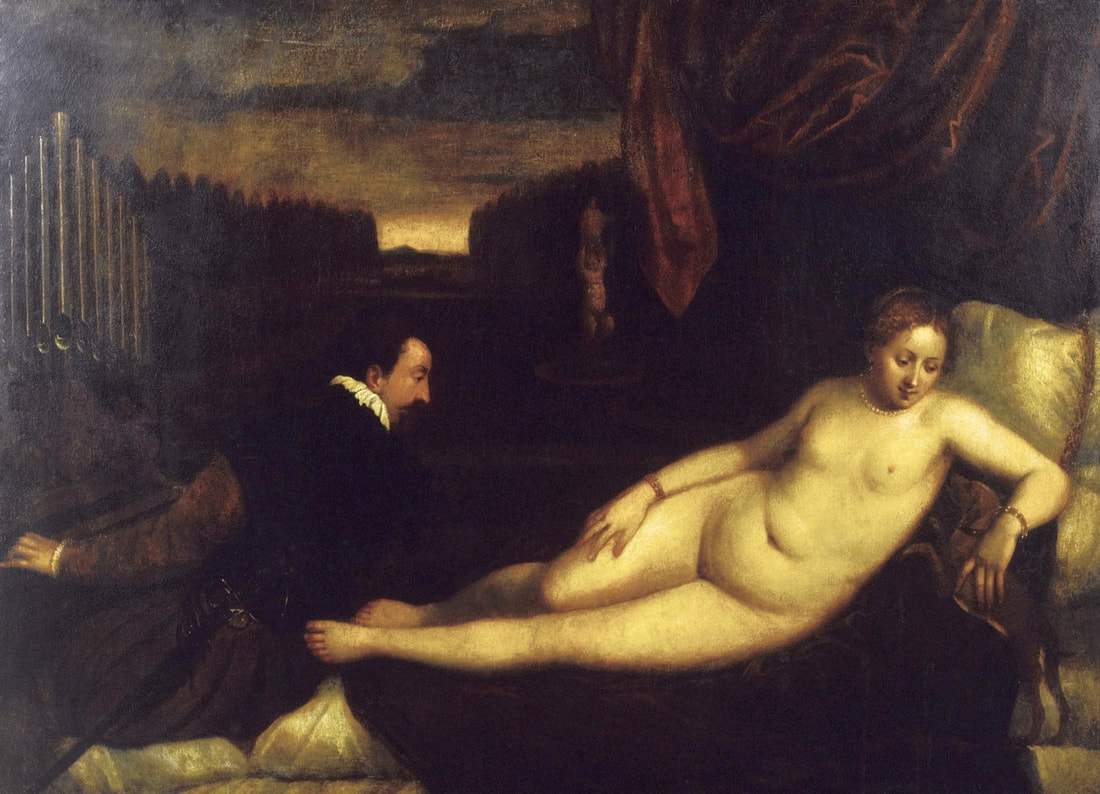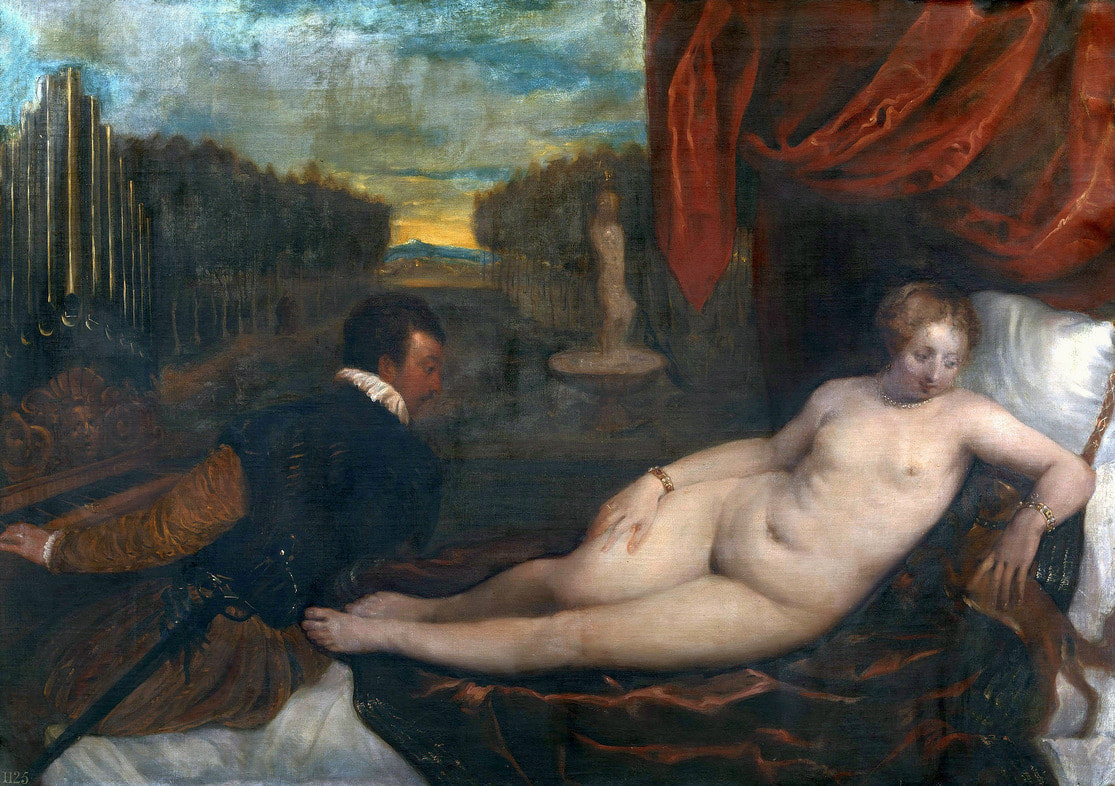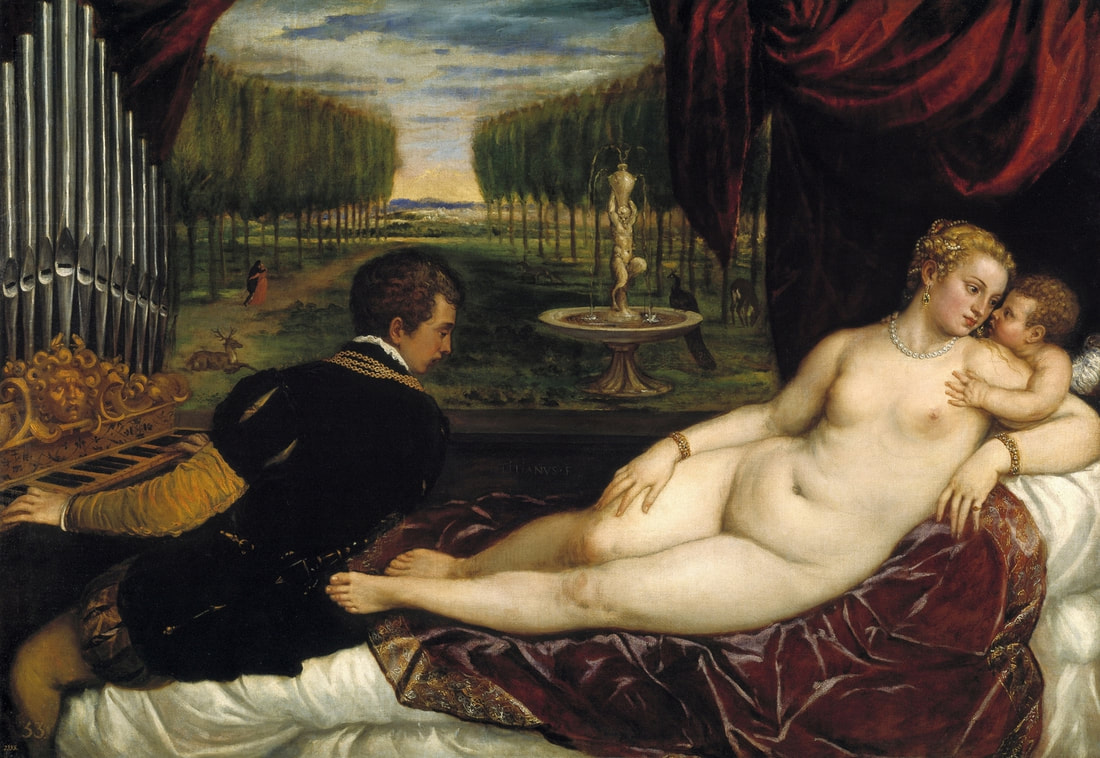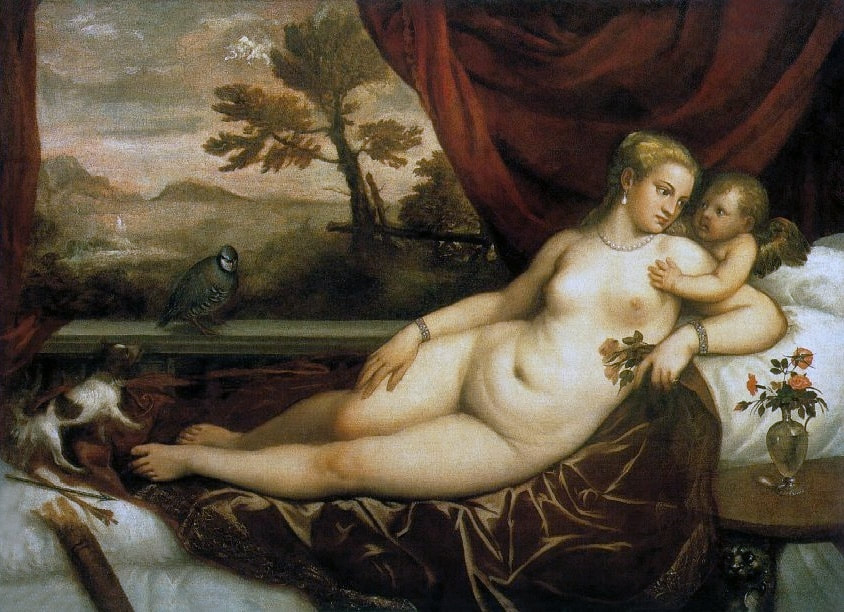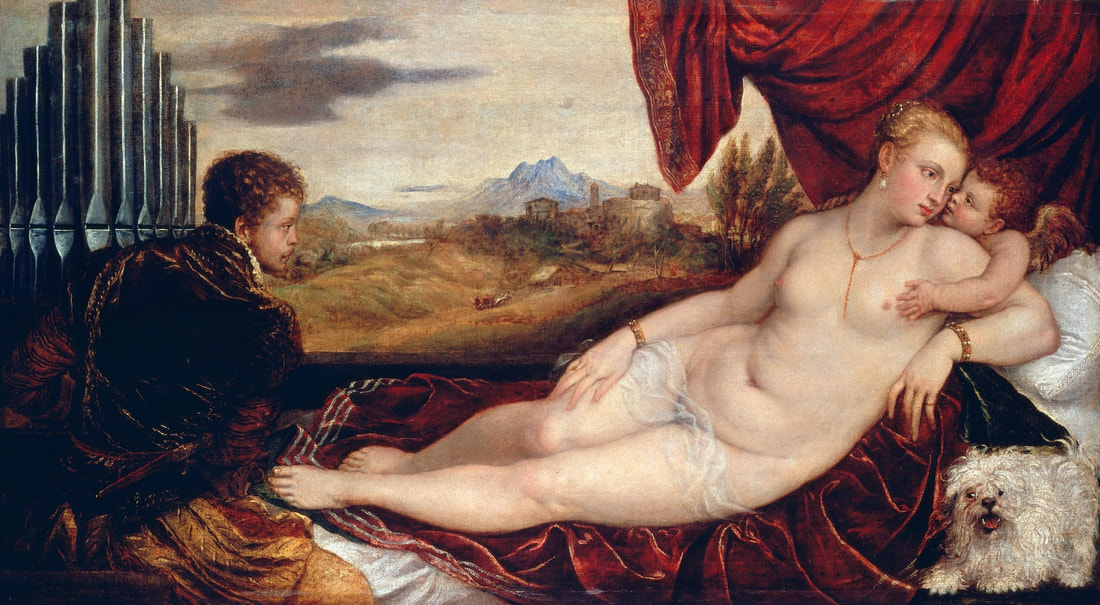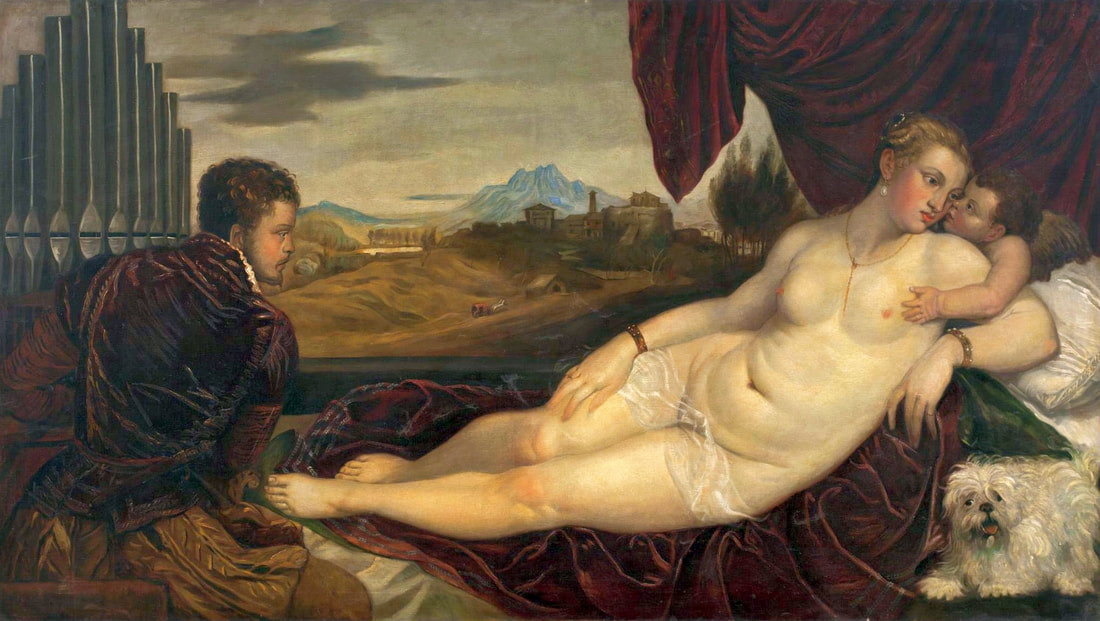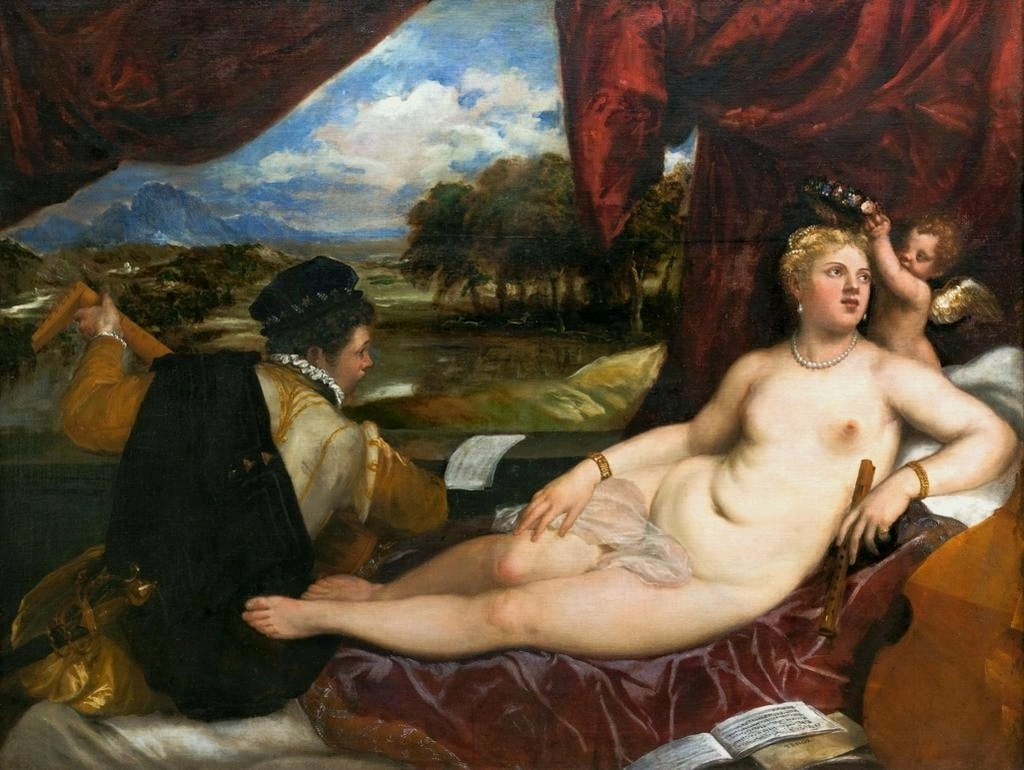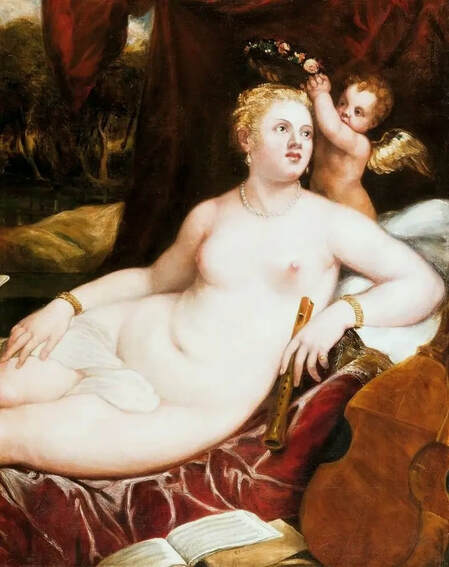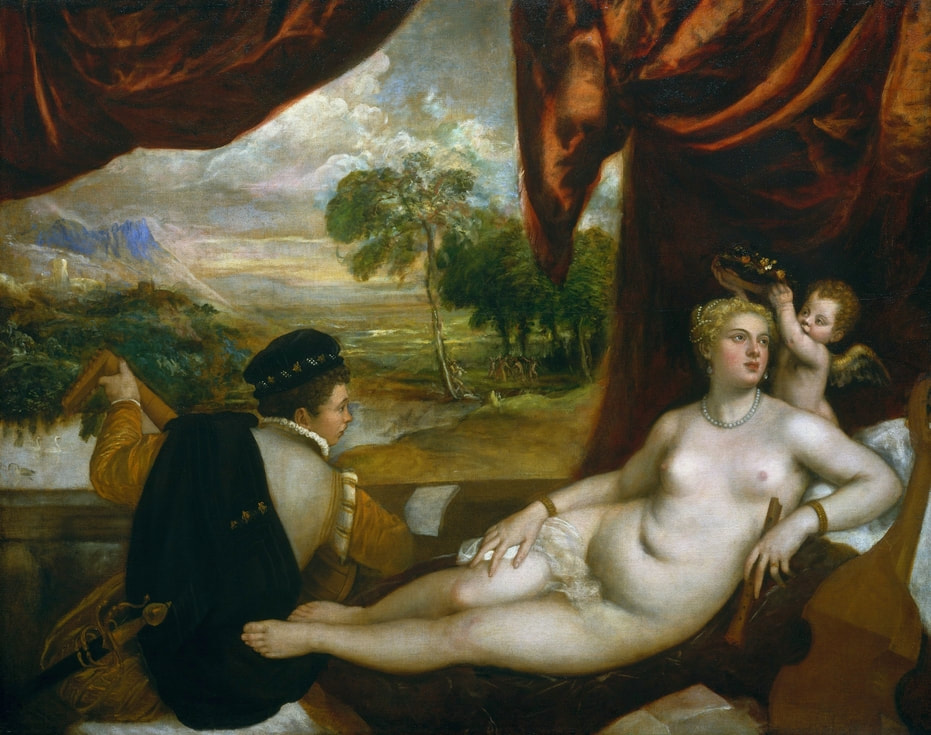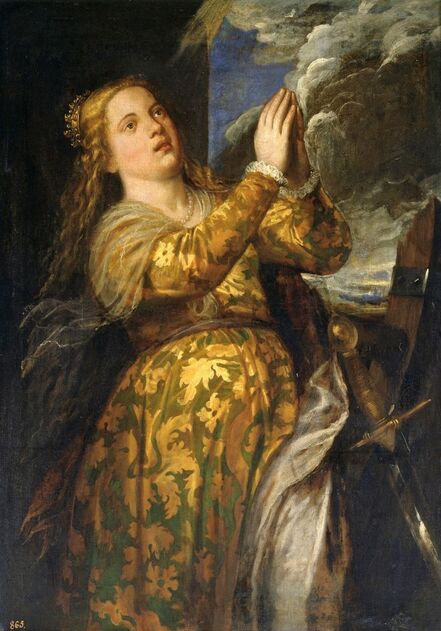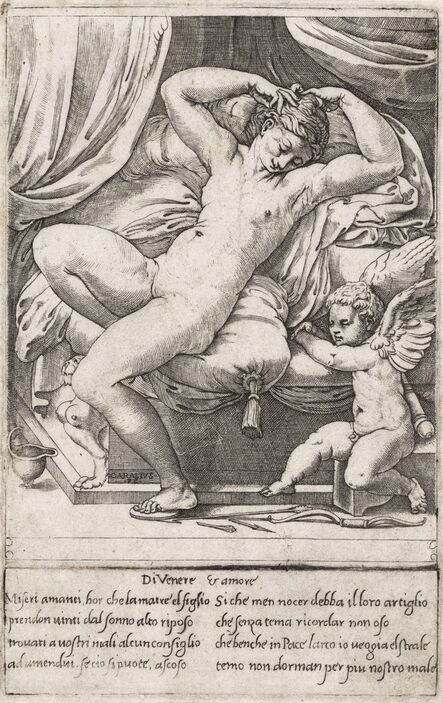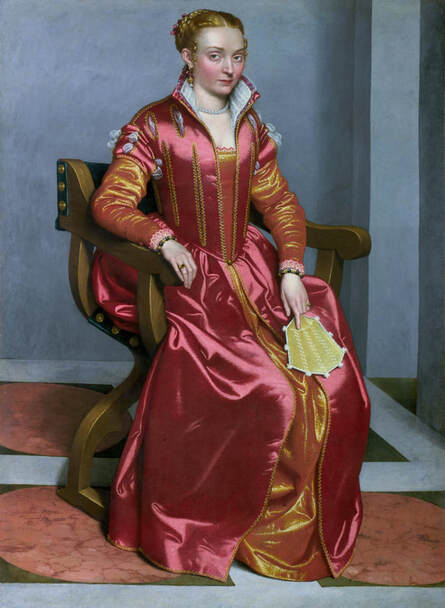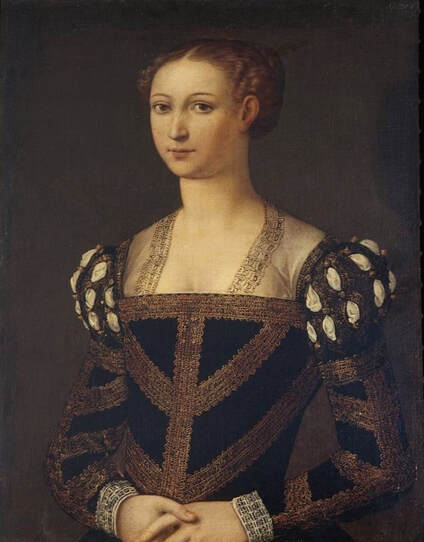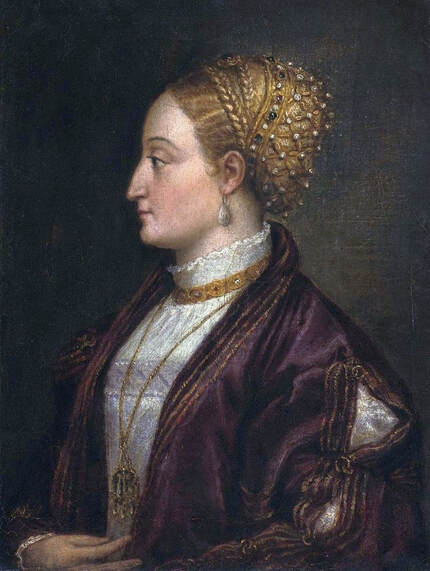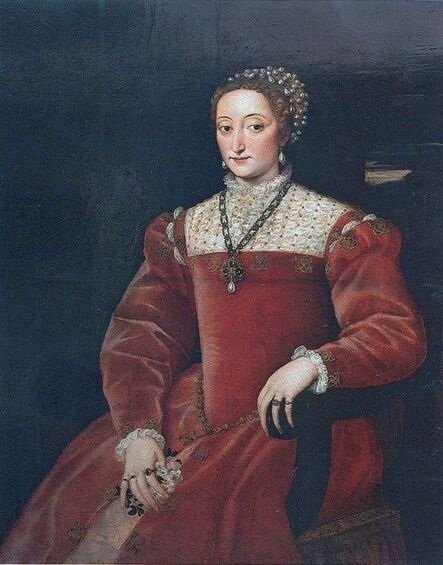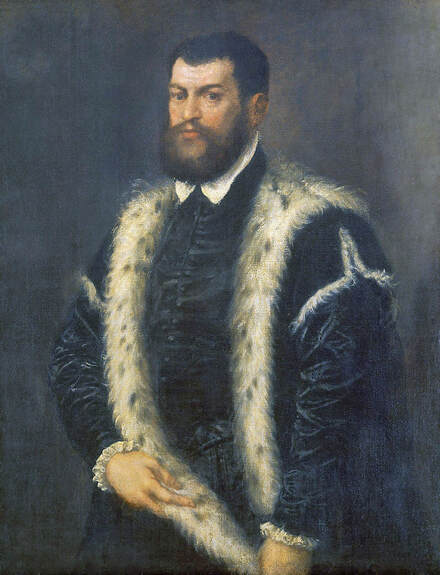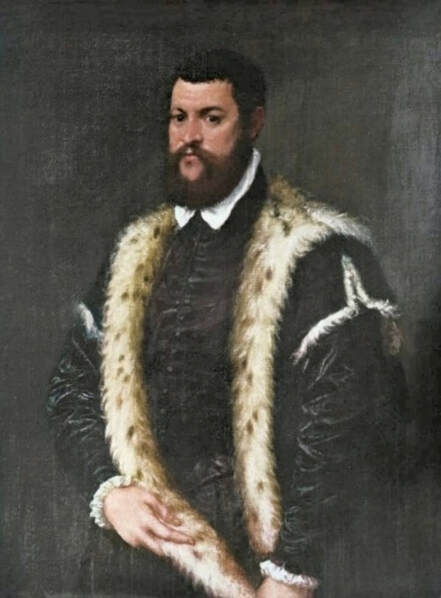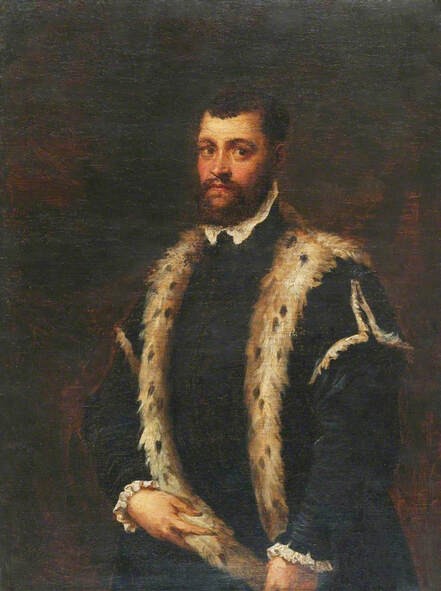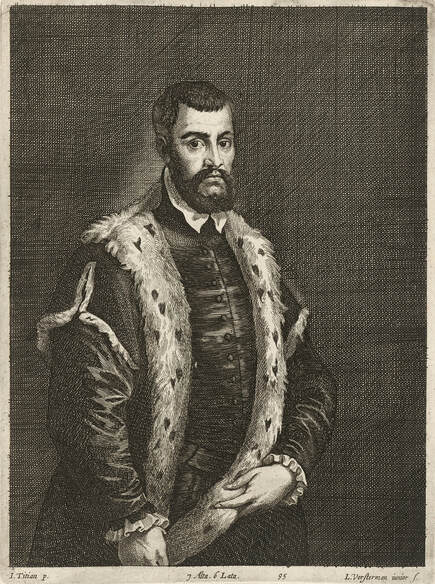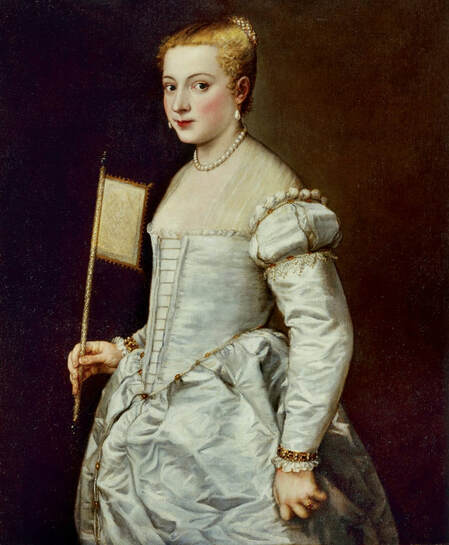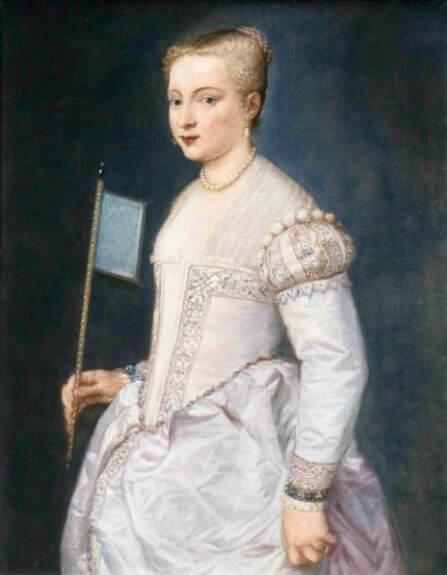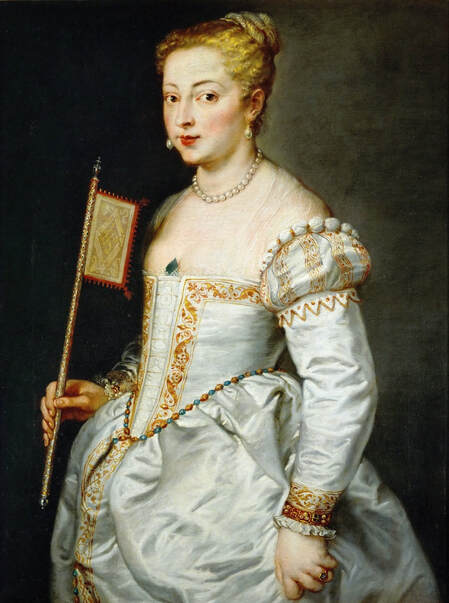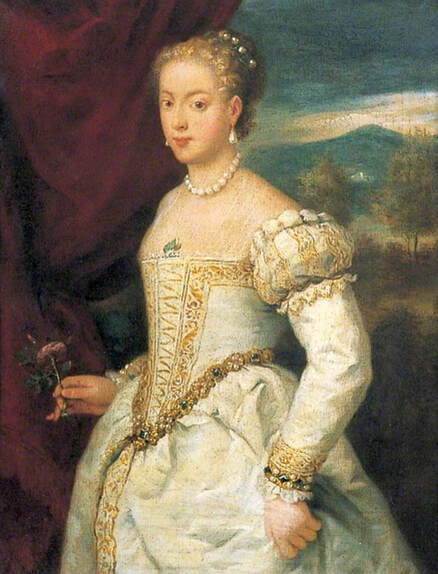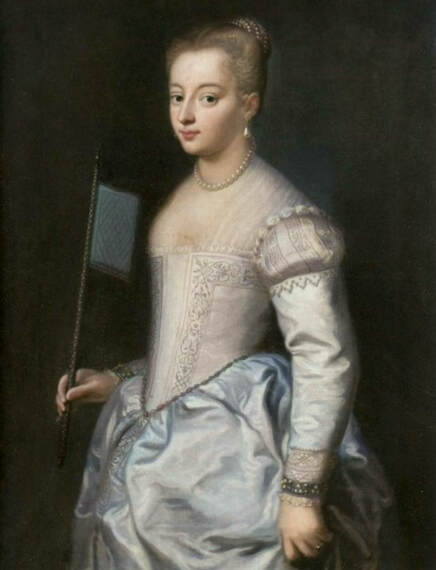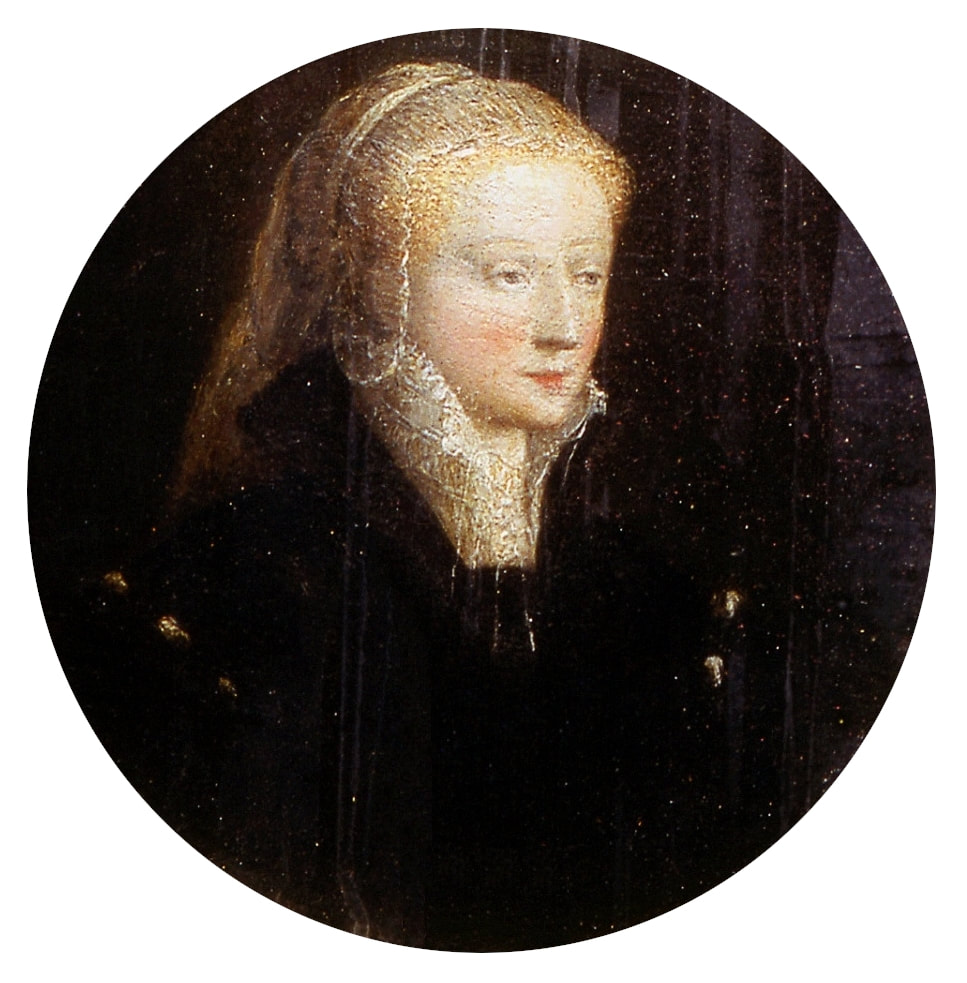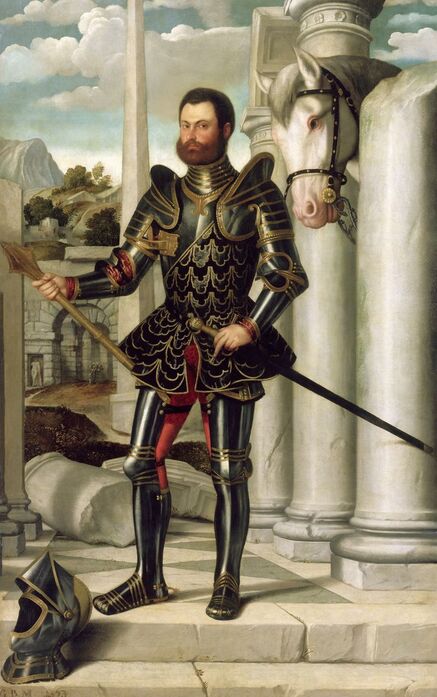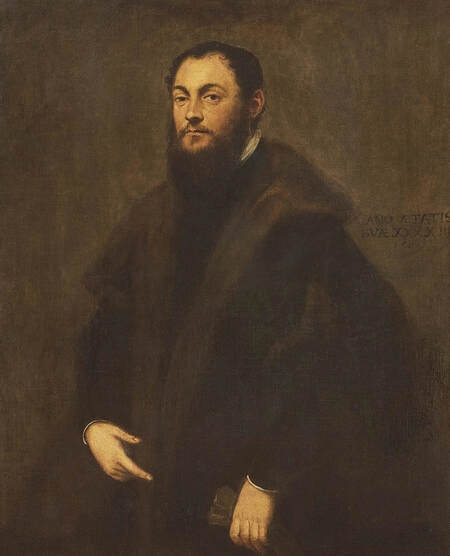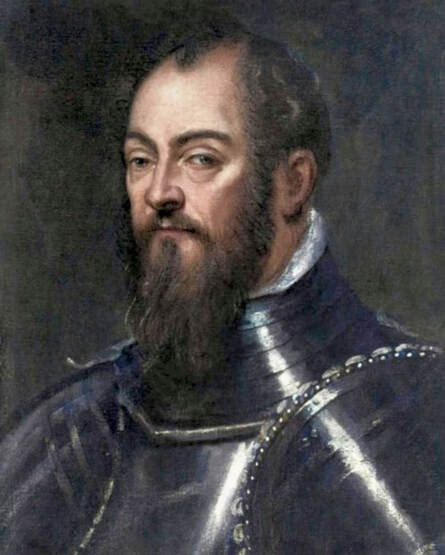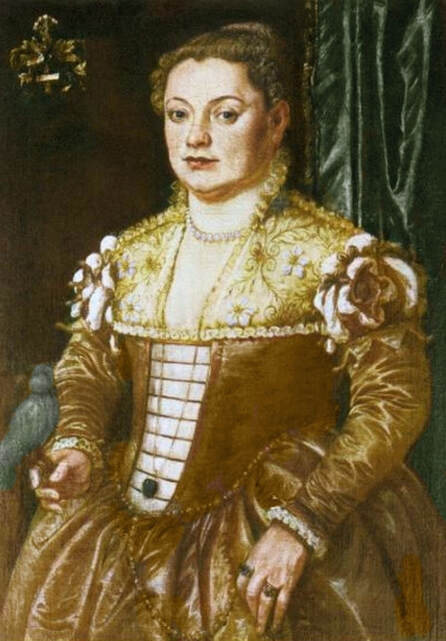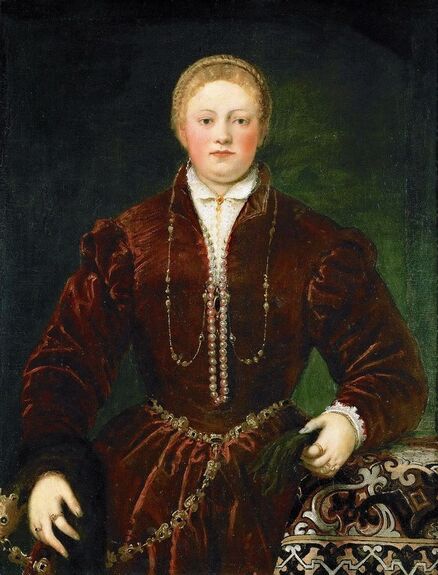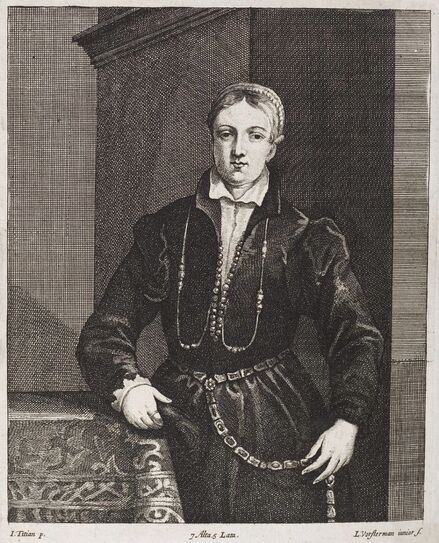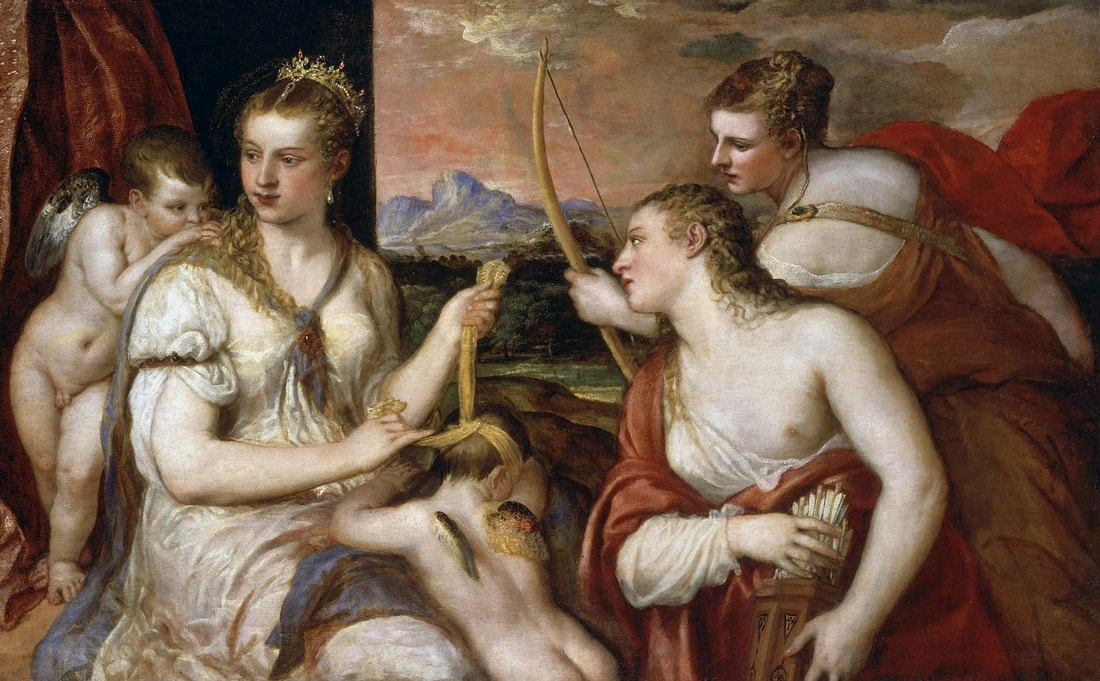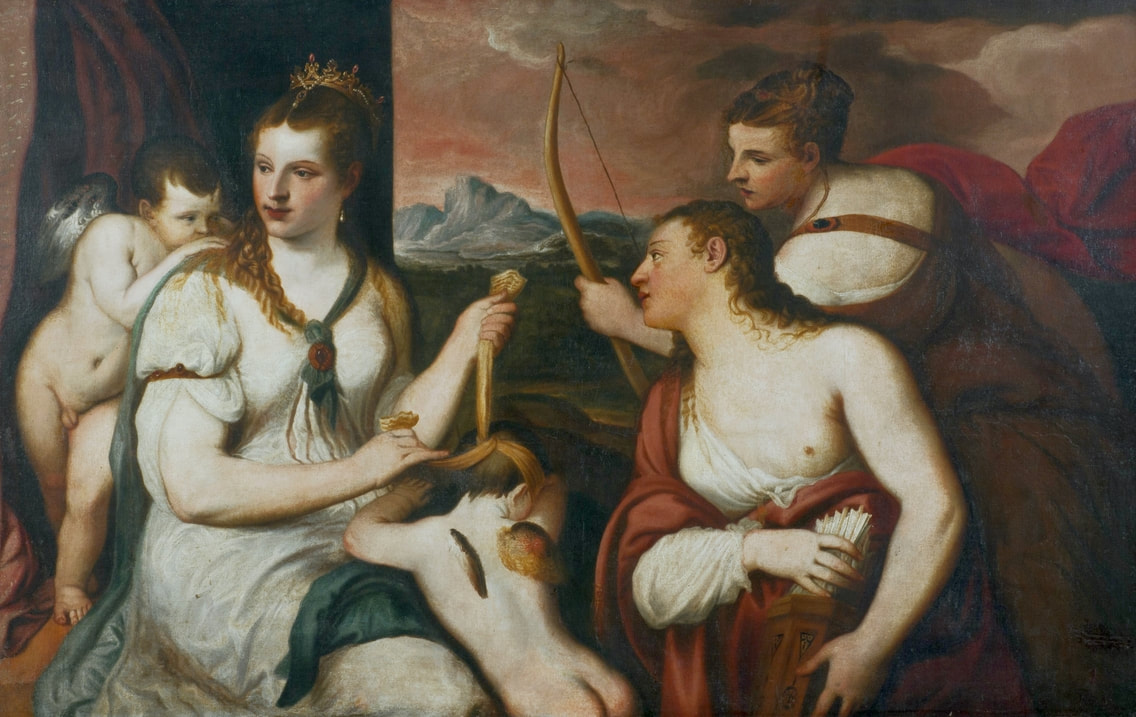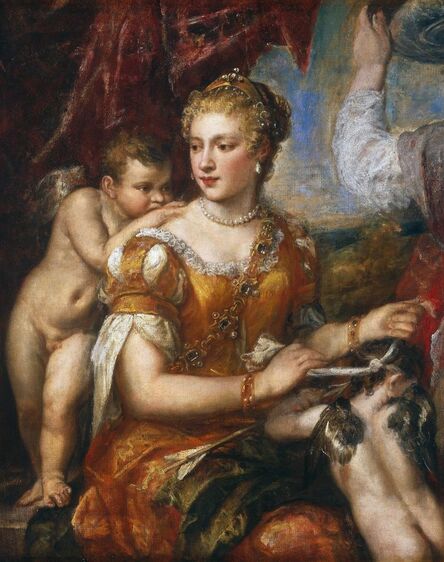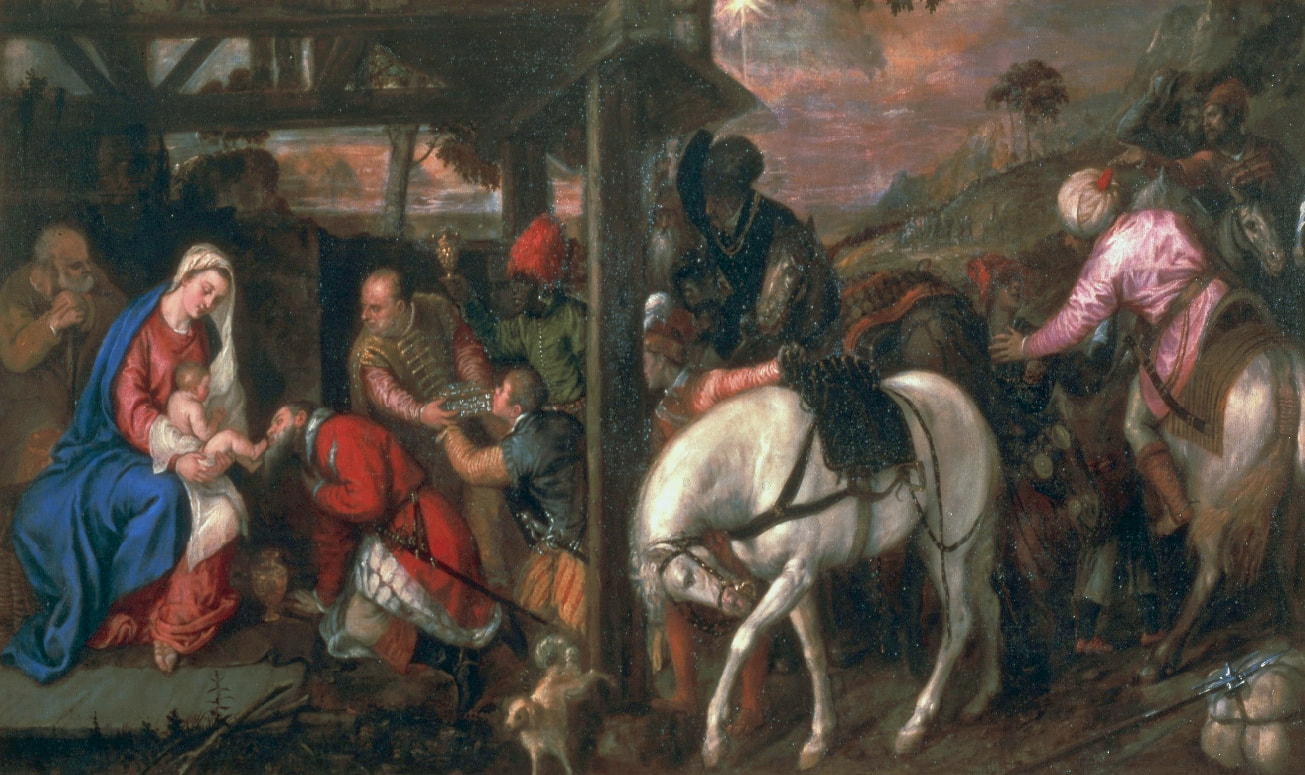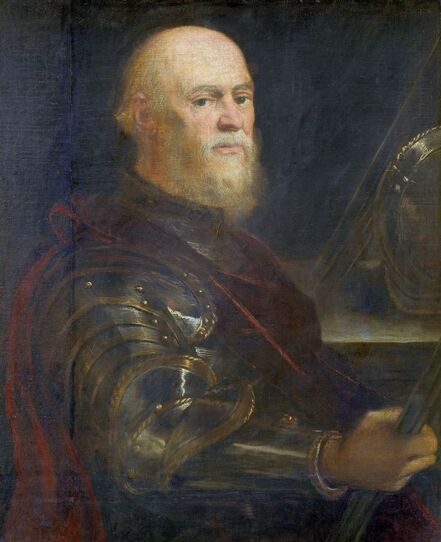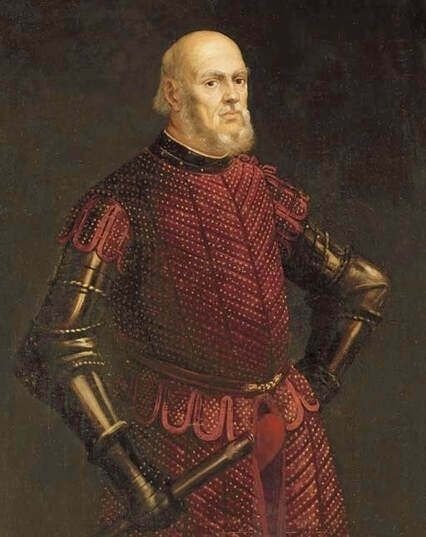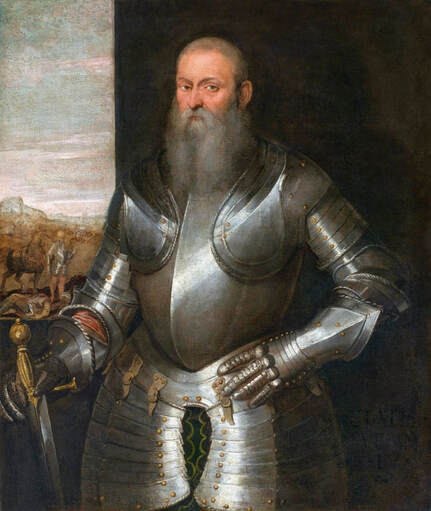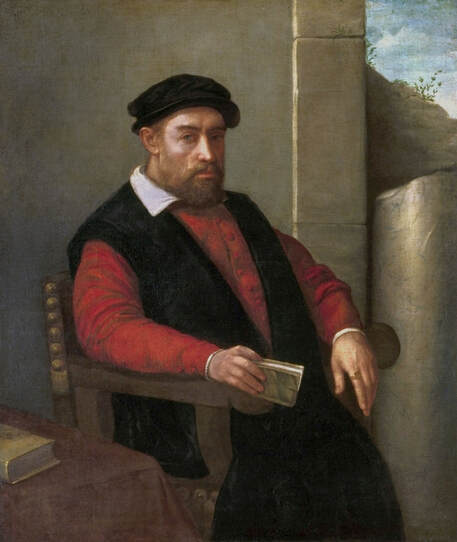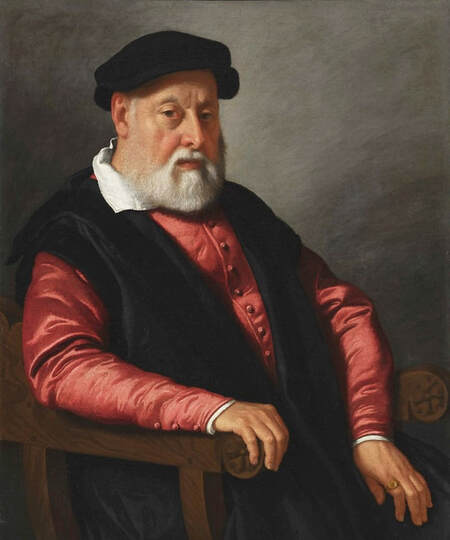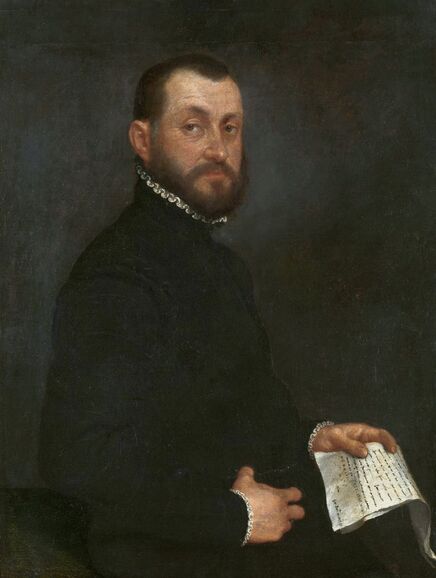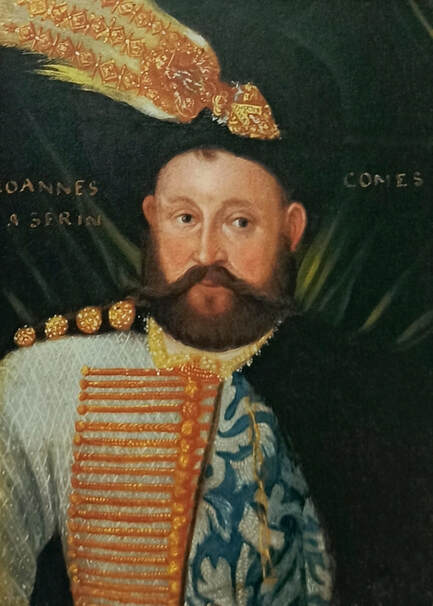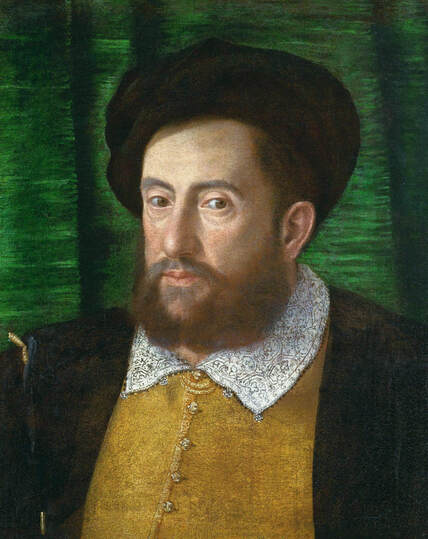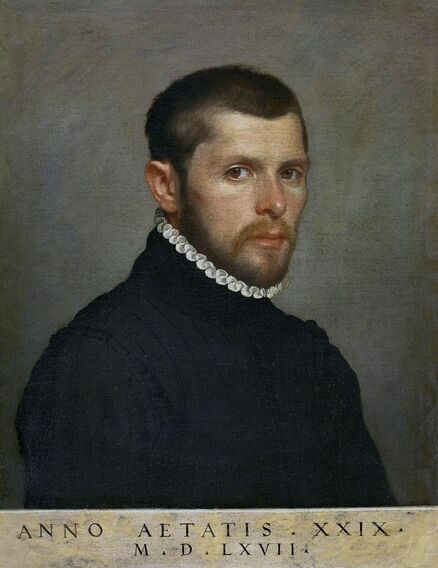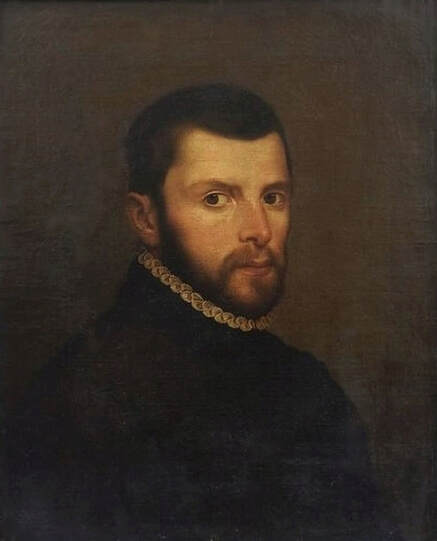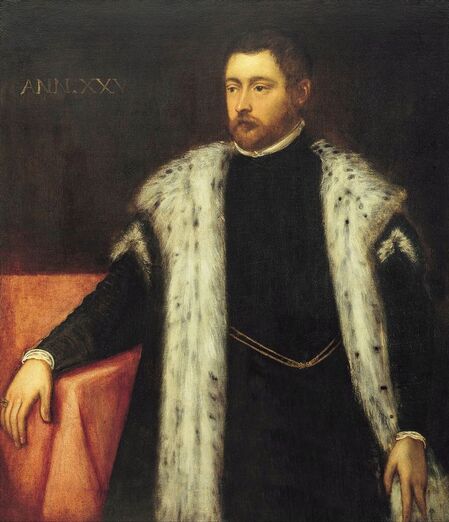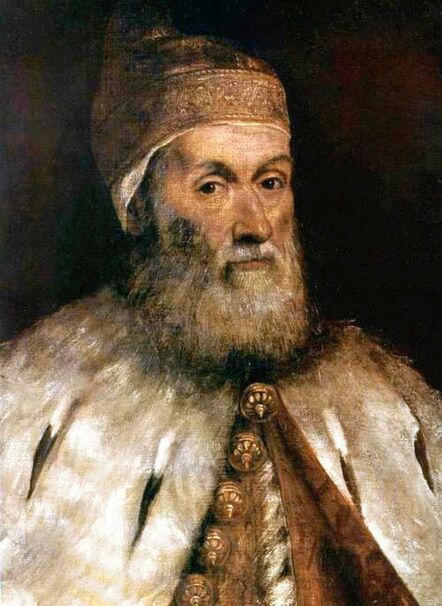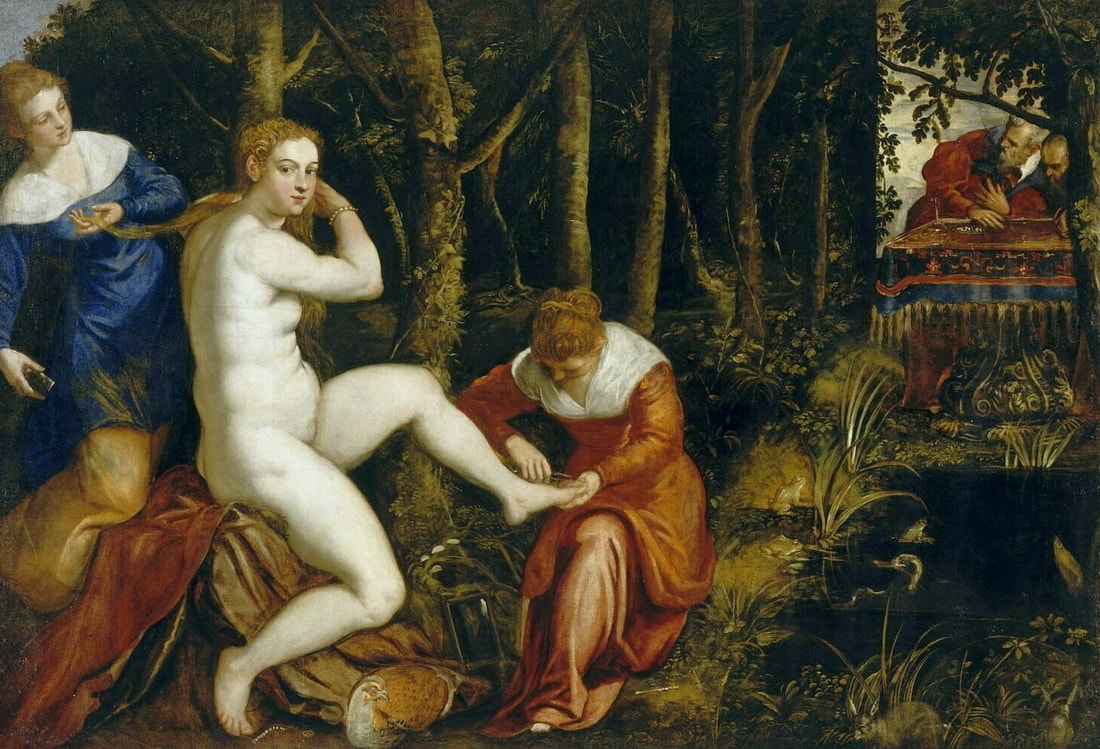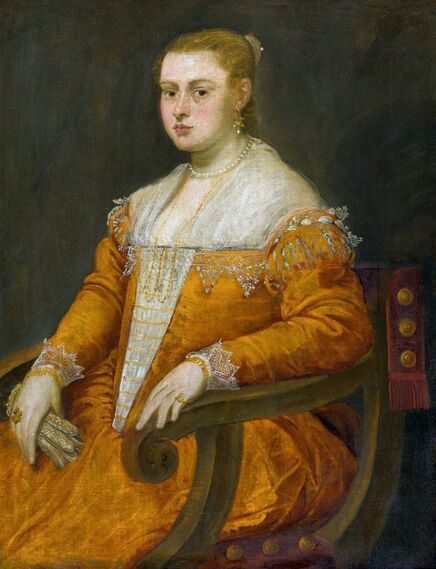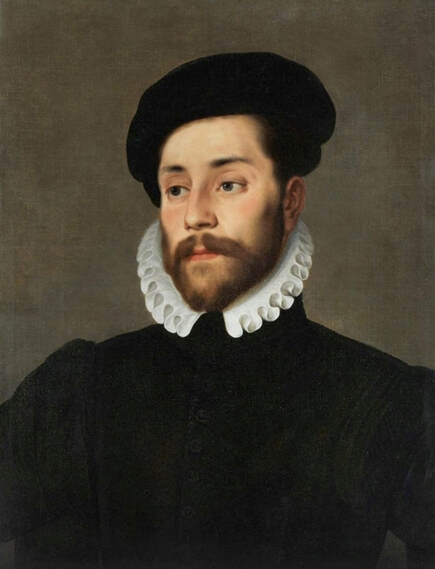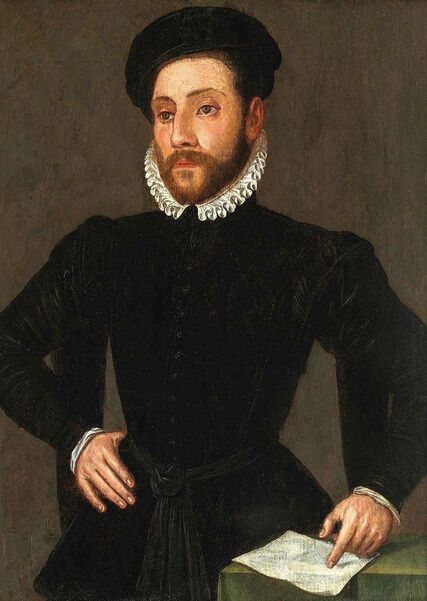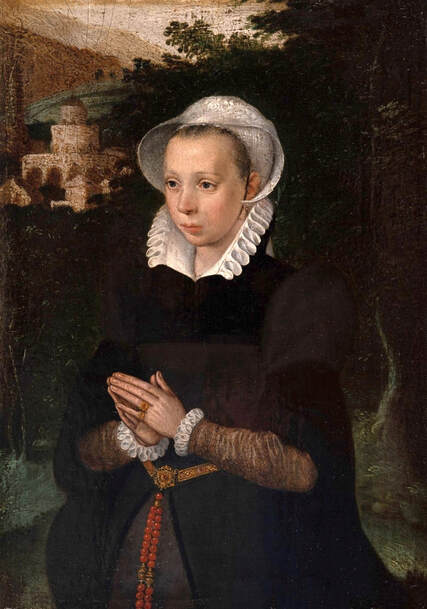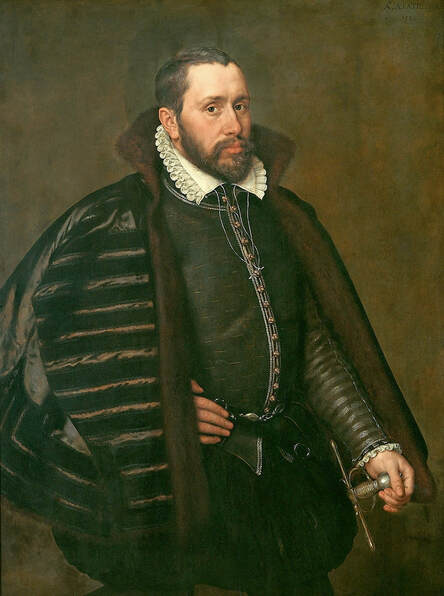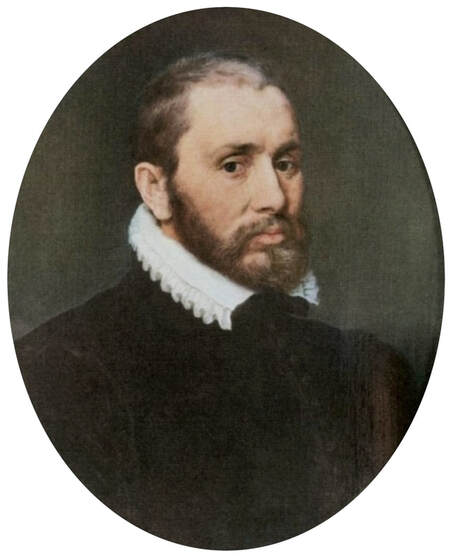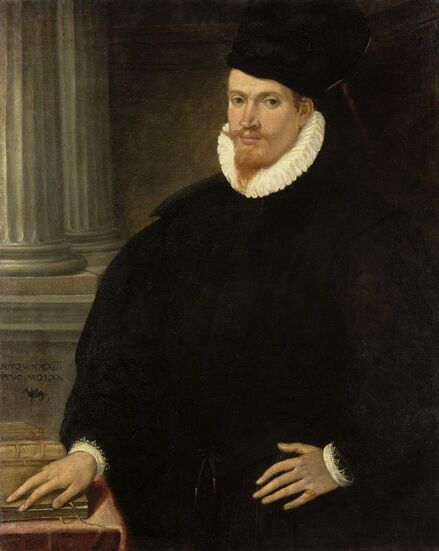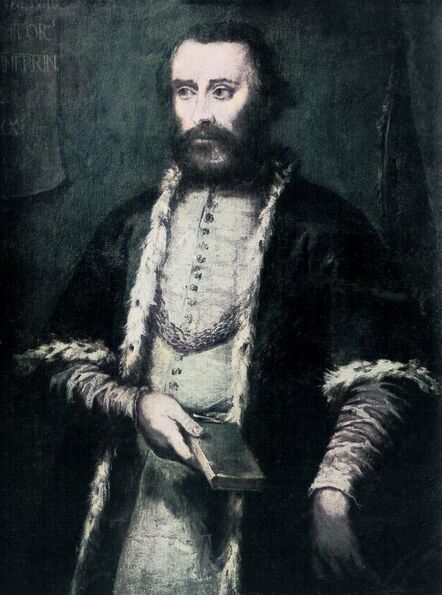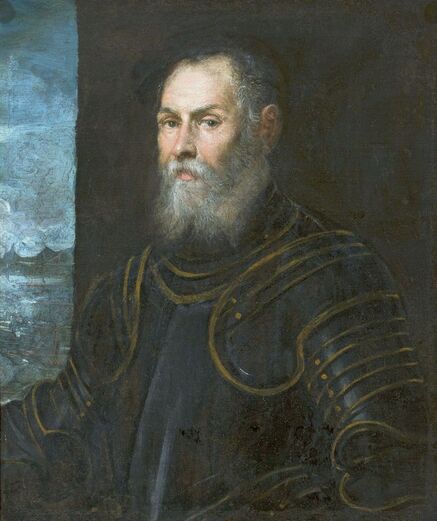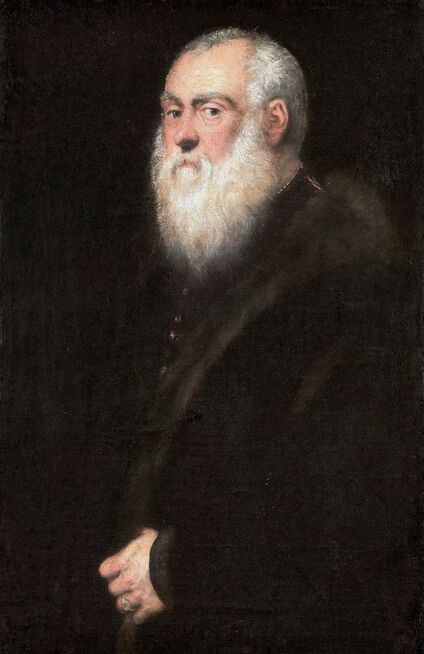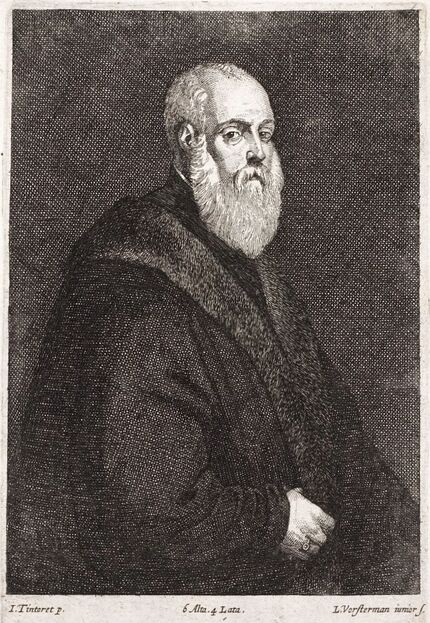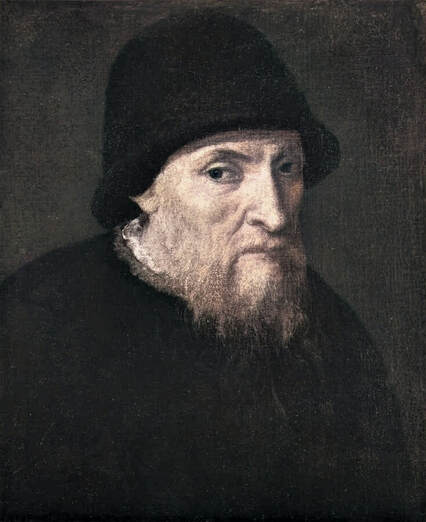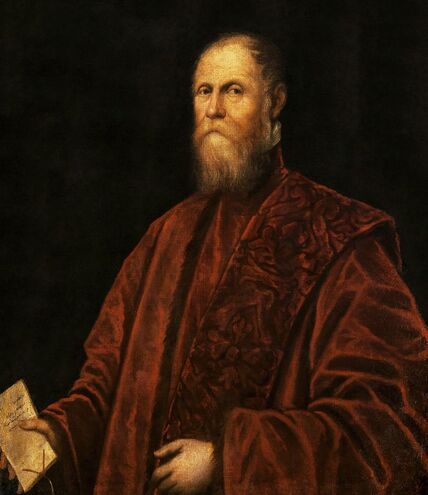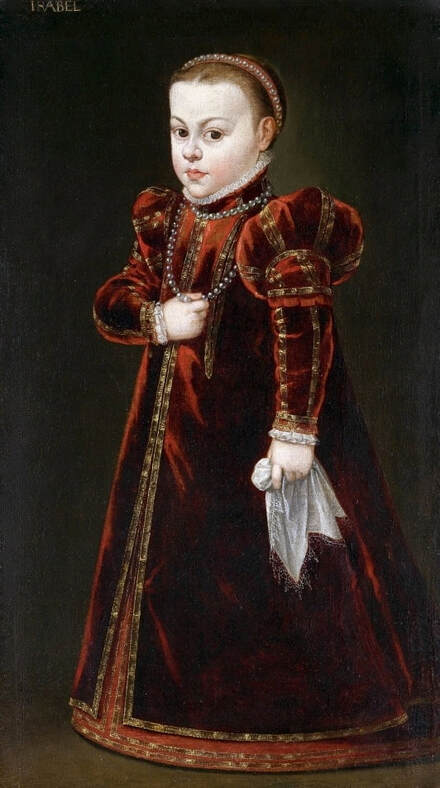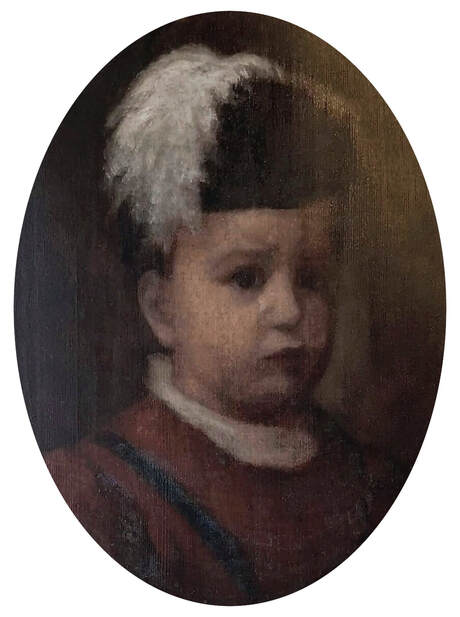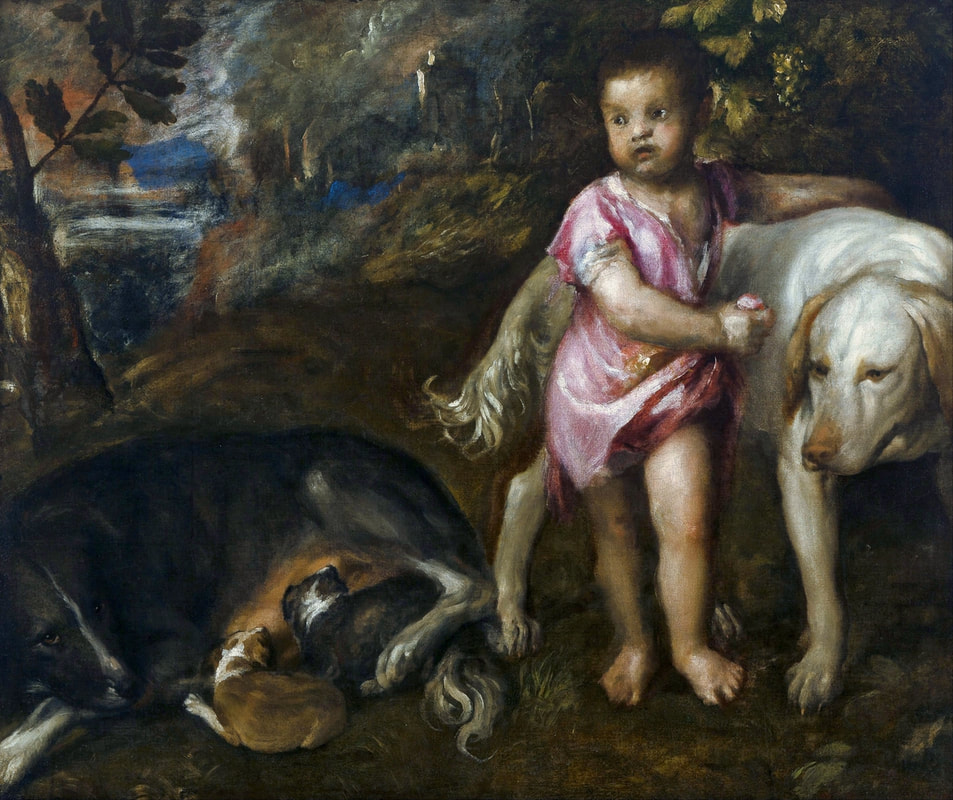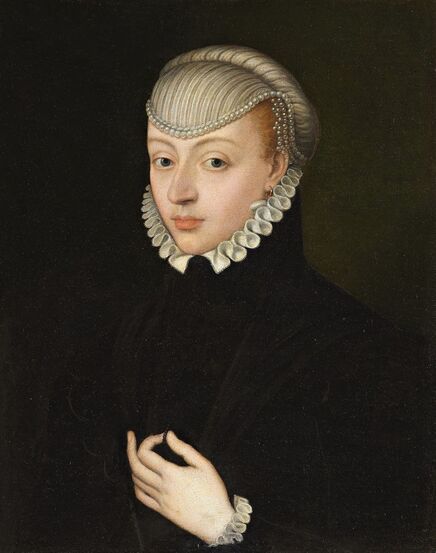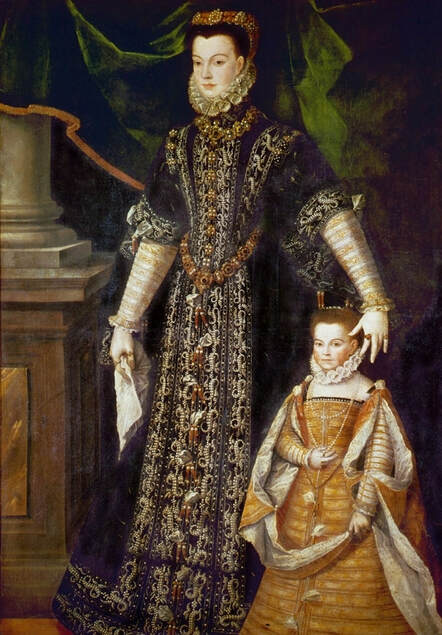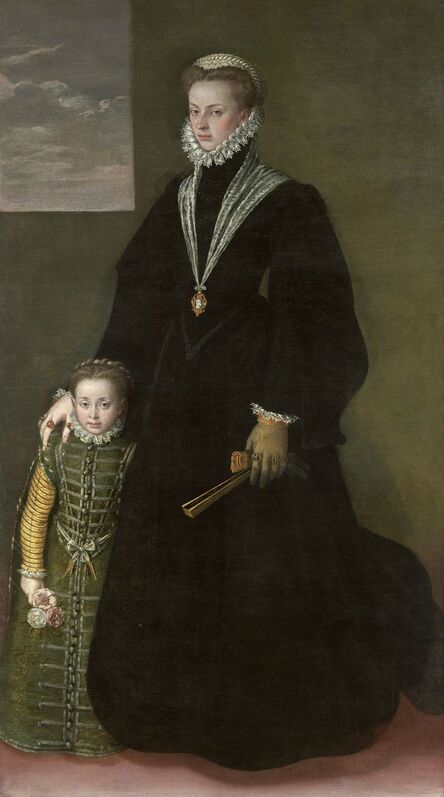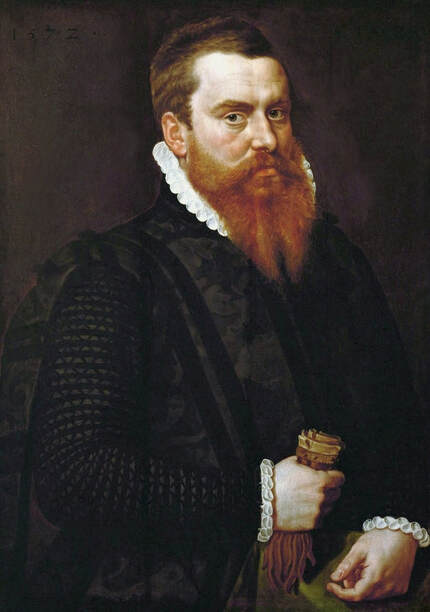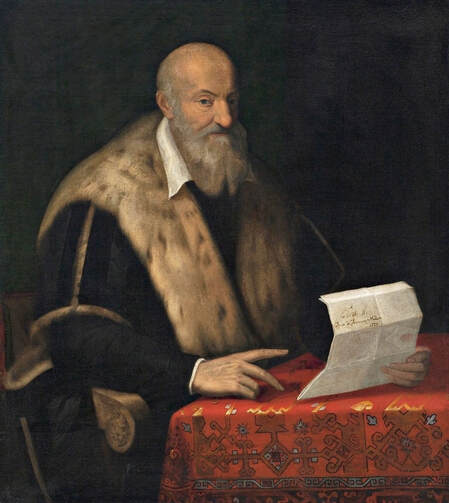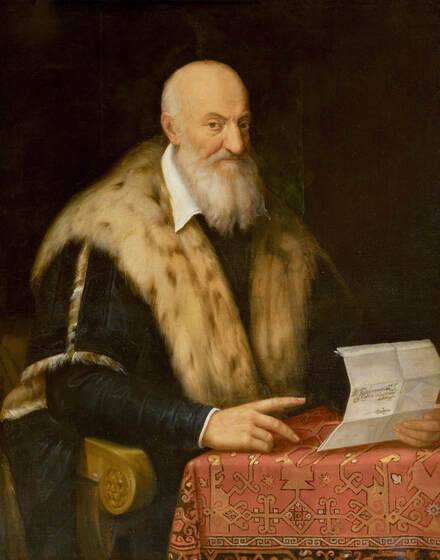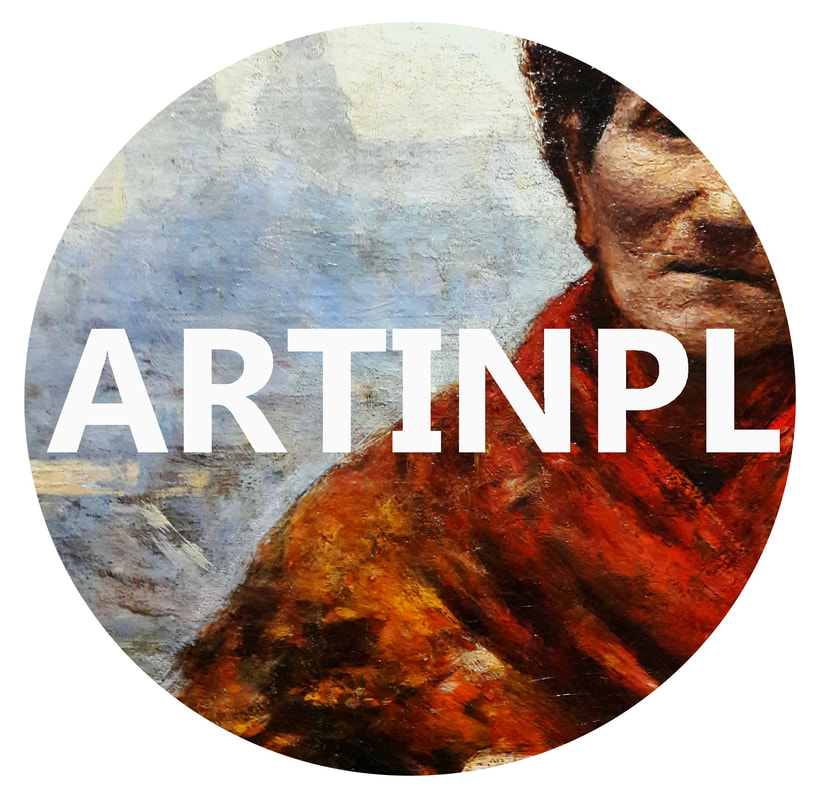|
Portraits of Sophia Jagiellon in Spanish costume
Daughters of Bona Sforza d'Aragona, Queen of Poland, Grand Duchess of Lithuania and Duchess of Bari and Rossano by her own right were descendants of Alfonso V, King of Aragon, Sicily and Naples.
Contacts with Spain intensified after 1550. In 1550 and 1553, Gian Lorenzo Pappacoda (1541-1576), a courtier of Queen Bona, was sent to the emperor with unknown instructions given to him by the queen. In March 1554, he also went to London and Brussels. Pappacoda's task was to convince the emperor and king of Spain to intervene on Bona's behalf at the court of Sigismund Augustus in order to facilitate her leaving Poland, and to obtain for her the position of viceroy of Naples, vacant since 1553 after the death of Pedro Álvarez de Toledo y Zúñiga (after "Odrodzenie i reformacja w Polsce", Volume 44, p. 201). In a letter dated May 11, 1550 from Valladolid, Juan Alonso de Gámiz, secretary of Charles V, informed King Ferdinand I of the arrival of the "secretary of the King of Poland with letters and gifts" (secretario del rey de Polonia con letras y presentes para sus altezas), including six horses with velvet tacks richly embroidered with royal emblems (seys cavallos portantes concubiertas de terciopelo morado y la devisa del rey bordada), as well as sable, ermine and wolf pelts for the king and queen (after "Urkunden und Regesten ..." by Hans von Voltelini, p. L-LI). The portrait of a blond lady in Spanish costume from the 1550s which exists in a number of copies, although idealized, bears a strong resemblance to the portrait of Sophia in French/German costume in Kassel by circle of Titian and her miniature in German/Polish dress by Cranach. At least two paintings are preserved in Poland (one in Kraków and the other in Warsaw) and one of inferior quality, most probably lost during World War II, was traditionally identified as Sophia (also similar to the very idealized portrait of Barbara Radziwill at the Musée Condé, known as "Anne Boleyn", inventory number PE 564). The Kraków painting was purchased between 1789 and 1791 by Princess Izabela Czartoryska in Edinburgh as a portrait of Mary, Queen of Scots, hence the inscription in French: MARIE STUART REYNE D'ESCOSSE, added in the 17th or 18th century (Czartoryski Museum, oil on panel, 22 x 17 cm, MNK XII-296). An almost exact copy of this effigy, attributed to circle of Jean Clouet, was sold in Zurich in 2011 (oil on panel, 23.3 x 18.2 cm, sold at Koller Auctions, April 1, 2011, lot 3012). The Warsaw version is slightly different and was purchased in 1972 from the Radziwill collection (National Museum in Warsaw, oil on panel, 24.5 x 19 cm, M.Ob.654). After marriage of Isabella Jagiellon in 1539, Sophia was the eldest daughter of Bona still unmarried. Three of Bona's younger daughters dressed identically, as evidenced by their miniatures by workshop of Lucas Cranach the Younger from about 1553 and inventory of dowry of the youngest Catherine includes many Spanish garments, like a black velvet coat with "53 Spanish buckles of 270 thalers worth", "buckles on (thirteen) French and Spanish robes", or "a robe of black velvet at the throat in Spanish style" with 198 buckles, etc. The fashion was udobtedly used in complex Jagiellonian politics and the portraits could be commissioned in the Spanish Netherlands and Italy. A portrait from the private collection in Sweden (oil on panel, 26 x 19 cm, sold at Metropol Auktioner in Stockholm, January 26, 2015, nr 938 5124), possibly taken from Poland-Lithuania during the Deluge (1655-1660), and created by the same workshop, showns Sophia in similar Spanish/French costume.
Portrait of Sophia Jagiellon (1522-1575) in Spanish costume by Flemish painter, 1550-1556, Czartoryski Museum in Kraków.
Portrait of Sophia Jagiellon (1522-1575) in Spanish costume by Flemish painter, 1550-1556, Private collection.
Portrait of Sophia Jagiellon (1522-1575) in Spanish costume by Flemish or Italian painter, 1550-1556, National Museum in Warsaw.
Portrait of Sophia Jagiellon (1522-1575) in Spanish/French costume by Flemish painter, 1550-1556, Private collection.
Portraits of Sigismund Augustus and Catherine of Austria as Adam and Eve from the Paradise Bliss tapestry
"Adam and Eve, the parents of calamity, stood both painted according to true image and the word all over the tapestries woven with gold. And since those portraits of the first parents, in addition to the other things to be seen, were of admirable material and workmanship, I will show them like Cebetis, so that from thence the work itself of an excellent artist, as well as the genius of the best king, may be perceived [...]. In the first tapestry, at the head of the nuptial bed, we saw the bliss in the faces of our parents; in which, when they were happy, they were not ashamed to be naked. Moreover, the nakedness of both of them so moved the spirits, especially that of Eve's husband, that lascivious girls would smile at Adam as they entered. For when the man's womb was opened, the sex of a woman is fulfilled" (calamitatis parentes Adam et Eva ad effigiem veritatis stabant textu picti ambo per omnes Cortinas, auro praetextati. Et quoniam illae primorum parentum effigies praeter caeteras res visendas, admirabili fuerunt materia et opere, eas ad Cebetis instar demonstrabo, ut inde cum opus ipsum praeclari artificis, tum vero ingenium optimi regis pernoscatis [...]. In prima Cortina, ad caput genialis lecti, parentum nostrorum contextu expressa felicitatis cernebatur effigies; in qua felices illi cum essent, non erubescebant nudi. Porro utriusque nuditas ita commovebat animos, ut viri Evae, Adamo vero lascivae introingressae arriderent puellae. Aperta enim pube ille viri, haec foeminae sexum sinu ostendebant pleno), thus praises the veracity of effigies of the figures of Adam and Eve in the tapestry commissioned by king Sigismund II Augustus, Stanisław Orzechowski (1513-1566) in his "Nuptial Panegyric of Sigismund Augustus, King of Poland" (Panagyricus Nuptiarum Sigimundi Augusti Poloniae Regis), published in Kraków in 1553.
Orzechowski (Stanislao Orichovio Roxolano or Stanislaus Orichovius Ruthenus), a Ruthenian Catholic priest, born in or near Przemyśl, educated in Kraków, Vienna, Wittenberg, Padua, Bologna, Rome and Venice and married to a noblewoman Magdalena Chełmska, described the festivities and decorations of the Wawel Royal Castle in Kraków during king's wedding celebrated on July 30, 1553. The bride was a sister of Sigismund Augustus first wife and widow of the Duke of Mantua, Catherine of Austria, daughter of Anna Jagellonica (1503-1547). Wedding chambers were adorned with tapestries from the series of the Story of Adam and Eve, created in Brussels by workshop of Jan de Kempeneer after cartoons by Michiel I Coxcie, most probably on this occasion, including the described Paradise Bliss. The author emphasizes that they were depicted naked, while both Eve and Adam's womb on this tapestry are today covered with vine branches. "A closer look at the technique of the fabric in these places reveals that the vine covering Eve's womb, and the other vine covering Adam's womb, are woven or embroidered separately and applied to the fabric itself", states Mieczysław Gębarowicz and Tadeusz Mańkowski in their publication from 1937 ("Arasy Zygmunta Agusta", p. 23). Vine branches were probably added in 1670 when the tapestry was transported to Jasna Góra Monastery for the wedding of king Michael Korybut Wiśniowiecki. Another intriguing aspect is the veracity of the images so underlined by Orzechowski. It is about the true image of the legendary first parents, a woman and a man or, most likely, the bride and groom? Adam's facial features are very reminiscent of images of king Sigismund Augustus, especially the portrait by Jan van Calcar against the Mausoleum of Empeor Augustus in Rome (private collection), while the face of Eve is very similar to that of Queen Catherine of Austria, depicted as Venus with the lute player by Titian (Metropolitan Museum of Art). These two effigies can be compared to the naked effigies of French monarchs from their tombs in the Basilica of Saint-Denis - tomb of Louis XII and Anne of Brittany (1515-1531), tomb of Francis I and Claude of France (1548-1570), and especially the tomb of Henry II and Catherine de' Medici (1560-1573), all inspired by Italian art.
Portrait of King Sigismund Augustus (1520-1572) as Adam from the Paradise Bliss tapestry by workshop of Jan de Kempeneer after design by Michiel I Coxcie, ca. 1553, Wawel Royal Castle.
Portrait of Queen Catherine of Austria (1533-1572) as Eve from the Paradise Bliss tapestry by workshop of Jan de Kempeneer after design by Michiel I Coxcie, ca. 1553, Wawel Royal Castle.
Tapestry with Paradise Bliss by workshop of Jan de Kempeneer after design by Michiel I Coxcie, ca. 1553, Wawel Royal Castle.
Portraits of Sophia Jagiellon and Catherine of Austria by Titian and workshop
"My heart moves me to tell of forms changed into new bodies" (In nova fert animus mutatas dicere formas corpora), states Ovid in the opening lines of his "Metamorphoses" (Transformations). If gods could turn into humans, why humans (and especially royals) could not turn into gods? At least in paintings.
When in June 1553 Sigismund II Augustus married his distant cousin Catherine of Austria, widowed duchess of Mantua, his three younger sisters Sophia, Anna and Catherine were not married. At the same time Catherine's cousin, Philip of Spain (1527-1598), Duke of Milan from 1540, son of Emperor Charles V, was unmarried after death of his first wife Maria Manuela (1527-1545), Princess of Portugal. Philip undeniably received a portrait of his distant relative Princess Sophia Jagiellon (1522-1575), the eldest of Bona Sforza's daughters, unmarried at that time. At the end of 1553 Philip's wedding to his second aunt, the Queen of England, Mary I (1516-1558), was announced. It turned out, however, that Philip was only a duke and there could be no marriage between the queen and someone of lower rank. Charles V solved the inconvenience by renouncing the Kingdom of Naples in favor of his son, so that he would be king. On July 25, 1554 Philip married the Queen of England. Painting of Salome with the head of John the Baptist by Titian in the Prado Museum in Madrid is dated to about 1550. Many authors underline an erotic dimension of the scene. The work was inventoried as part of the royal collection in the Alcazar of Madrid between 1666 and 1734, possibly acquired from the collection of the 1st Marquess of Leganés, between 1652-1655, who probaly bought it at the auction of collection Charles I of England. According to other sources "Salome, by Titian, painted around 1550, appears in an early inventory of the Lerma collection. In 1623 Philip IV gave it to the Prince of Wales, later Charles of England" (after "Enciclopedia del Museo del Prado", Volume 3, p. 805). Titian's workshop created several replicas of this painting transforming Salome into a girl holding a tray of fruit, most probably representing Pomona, a goddess of fruitful abundance and the wife of the god Vertumnus (Voltumnus), the supreme god of the Etruscan pantheon. According to Ovid's "Metamorphoses" (XIV), Vertumnus, after several unsuccessful advances, tricked Pomona into talking to him by disguising himself as an old woman and gaining entry to her orchard. The best version of this painting, acquired in 1832 from the Abate Luigi Celotti collection in Florence, is today in the Gemäldegalerie in Berlin. In both paintings the girl is wearing a rich jewelled tiara, so she is definitely a princess and the main fruit on her tray is a quince (or Cydonian apple), similar to that visible in watercolour paintings by Joris Hoefnagel from about 1595, one with Venus disarming Amor (National Gallery of Denmark), or less probably a lemon, a symbol of fidelity in love associated with Virgin Mary. A yellow lemon- or pear-shaped fruit, evocative of the female body, was sacred to Venus, herself often represented holding it in her right hand, as being the emblem of love, happiness, and faithfulness. "Both the Greeks and Romans used quince boughs and fruit to decorate the nuptial bedchamber. The fruit became an integral part of marriage ceremonies with the bride and groom partaking of honeyed quince. Eating the fruit was symbolic of consummating the marriage" (after Sandra Kynes' "Tree Magic: Connecting with the Spirit & Wisdom of Trees"). According to Columella (4 - ca. 70 AD), a prominent writer on agriculture in the Roman Empire, "Quinces not only yield pleasure, but health". "Romans would serve quince to their loved ones to encourage fidelity and those newly married would share a quince to ensure a happy marriage" (after Rachel Patterson's "A Kitchen Witch's World of Magical Food"). Around that time Titian's workshop created another version of this composition, which was before 1916 in the Volpi collection in Florence (hence both Pomonas were possibly initially in the Medici collection). The woman's face and pose is identical as in the Raczyński Herodias, which is the effigy of Queen Catherine of Austria. The face of the princess in the Prado painting bears great resemblance to effigies of Princess Sophia Jagiellon by Cranach and in Spanish costume by Flemish painter. Some of the copies of this Salome and Pomona were created by Titian's workshop, such as the Knebworth House copy, sold in 2003, or a reduced version, sold in 2020 (Bonhams London, October 21, 2020, lot 3), which also indicate that she was an important person. In another variant of Salome/Pomona by Titian's studio, the princess "metamorphoses" into another femme fatale - Pandora, now holding a rich jewelled box on her tray, like in later paintings by James Smetham (ca. 1865), Dante Gabriel Rossetti (1871), John William Waterhouse (1896) or Odilon Redon (1910/1912). Pandora was to be created by Hephaestus (Vulcan) on the order of Zeus (Jupiter), as the first human woman, to whom each of the gods gave some special gifts - Athena (Minerva) gave her intelligence, talent and manners and Aphrodite (Venus), beauty of a goddess, and she was also given a box containing all the evils that could afflict humanity, with a warning never to open it. In modern times, Pandora and her vessel have become, among other things, a symbol of the seductive power of women. This painting, from the French royal collection, mentioned among the paintings of Philippe II, Duke of Orléans (1674-1723), who was regent of the kingdom of France from 1715 to 1723, is today in a private collection in Milan. In the 19th and 20th centuries, many paintings returned to their place of origin, although this does not at all mean that the model was Italian (however, it is worth mentioning that through her mother, Princess Sophia was Italian). The fingers of her right hand, originally supporting larger tray in initial version (Salome) in this painting of Pandora, are eerily raised so that the girl is holding a heavy silver tray and a much heavier casket just by part of her hand. This is another proof that the painting was not taken from life, but based on study drawings sent from Poland-Lithuania, and it cannot be Titian's daughter posing for it, otherwise she would hurt herself holding these heavy objects like that. A version of a painting entitled "A Useless Moral Lesson" (allegorical subject of the loss of virginity and dangers of love) by Godfried Schalcken from 1690 (Mauritshuis) was sold in the United Kingdom in December 2020 as Pandora. Some copies of the painting by Titian's studio were sold as "Pandora's Box" (Manner of Guido Reni, 2014 and British School, 19th century, 2010) and Helena Tekla Lubomirska née Ossolińska (d. 1687), daughter of Chancellor Jerzy Ossoliński (1595-1650) was depicted in guise of Pandora, holding a bronze vase bearing the Lubomirski coat of arms - Szreniawa and inscription in Italian SPENTO E IE [IL] LUME / NON L'ADORE (the light is out, not the ardor), which is a paraphrase of a line from the poem Adone ("Adonis", 1623) by Giambattista Marino (attributed to Claude Callot and circle, National Museum and Wilanów Palace in Warsaw). Helena Tekla particularly liked different disguises in her effigies. In her portrait by Nicolas Mignard, thus ordered and created in France, she is depicted as Flora, Roman goddess of flowers and spring (inscribed on verso: Capitane Lubomirski / par Nic. Mignard., National Museum in Warsaw, M.Ob.1253 MNW) and inventory of Wiśnicz Castle from 1661 lists "a portrait of Her Highness, in the guise of Saint Helena" and "a full-length portrait of Her Highness, in the guise of Diana with greyhounds". Wanda Drecka interprets this representation of the widowed Princess Lubomirska "as the guardian of all virtues or Pandora who gives everything" (after "Dwa portrety księżnej na Wiśniczu", p. 386). It was not just a 17th century invention and such representations were known much earlier (Pandora from the French royal collection was considered to be the portrait of Titian's daughter Lavinia), also in Poland-Lithuania where Italian influences were so strong in the 16th century. Unfortunately, in Poland-Lithuania, the losses of cultural heritage during the Deluge (1655-1660) and the subsequent invasions were so great that everything was forgotten.
Portrait of Princess Sophia Jagiellon (1522-1575) as Salome by Titian, 1550-1553, Prado Museum in Madrid.
Portrait of Princess Sophia Jagiellon (1522-1575) as Pomona by workshop of Titian, 1550-1553, Gemäldegalerie in Berlin.
Portrait of Princess Sophia Jagiellon (1522-1575) as Pandora by workshop of Titian, 1550-1553, Private collection.
Portrait of Princess Sophia Jagiellon (1522-1575) by follower of Titian, after 1553, Private collection.
Portrait of Queen Catherine of Austria (1533-1572) as Pomona by workshop of Titian, 1553-1565, Private collection.
Allegorical portraits of Queen Catherine of Austria by workshop of Titian
Another version of the Pomona in Berlin by workshop of Titian was before 1970 in private collection in Vienna, Austria (oil on canvas, 99 × 82.5 cm), however, her facial features are slightly different, the face is more elongated and the lower lip is more protruding, as in most of the portraits of Catherine of Austria's relatives in Vienna. Her features are very similar to Saint Catherine of Alexandria in the Prado (inventory number P000447) and in the Raczyński Herodias. The same face and pose was copied in a painting of a nymph and a satyr which was before 1889 in James E. Scripps collection in Detroit (oil on canvas, 99 × 80.6 cm), attributed to follower of Titian, possibly by his student Girolamo Dente. The nymph playfully tugs at the ear of the satyr, who probably has the features of a court dwarf. Satyrs were nature deities and part of Bacchus's retinue. They were considered symbols of natural fertility or virility and were frequently portrayed chasing nymphs, symbolizing chastity.
Similar paintings were in royal and magnate collections in Poland-Lithuania. Inventory of the Kunstkammer of the Radziwill Castle in Lubcha from 1647 lists a painting of a "Naked lady with a satyr" offered by king John II Casimir Vasa and in 1633 a painting of "Diana with her maidens, the fauns laugh at" presented by his predecessor Ladislaus IV (after "Galerie obrazów i "Gabinety Sztuki" Radziwiłłów w XVII w." by Teresa Sulerzyska, p. 96). Inventory of paintings from the collection of princess Louise Charlotte Radziwill (1667-1695), drawn up in 1671, lists many nude and erotic paintings, some of which may be works by Titian: A lady half naked in sables (297, possibly a copy of a Girl in a fur by Titian in Vienna), Naked woman sleeps and two men watch (351), A naked woman sleeps and a lute and a flask with a drink is beside her and a man watches (370), A filthy image, Cupids and many naked people (371), Bacchanalia (372), Adonis wrestle with Venus (374, possibly a copy of Venus and Adonis by Titian in Madrid), A lady in flowers (375) and A lady with flowers (419, possibly a copy of Flora by Titian in Florence), Two naked women, one combs herself (420), A woman lying holding a glass, a man in front of her and Cupid embracing her (430), Three nymphs and Cupid (431), Two pictures on silver plates, one of Cupid with Venus, and the other with lustitia (628-629), Venus between two Cupids. A special image (762, most likely a painting from Bernardino Luini's workshop in the Wilanów Palace or a copy), A woman, naked, covered herself with cotton cloth, on a large panel (794, possibly a copy of a portrait of Beatrice of Naples as Venus by Lorenzo Costa in Budapest), Susanna and two old men, a large painting on canvas (815), Picture: a naked lady is sleeping and a satyr is next to her, this painting was given by King John Casimir (820), Three nymphs and Cupid (826), A lady with satyr, filthy (842), A lady lying. Small painting, golden frames (843), Naked lady with a swan, stone painting (844, possibly Leda by Alessandro Turchi, a pupil of Carlo Cagliari in Venice), A naked person in a red coat (863, possibly a copy of "Titian's Mistress" in Apsley House) (after "Inwentarz galerii obrazów Radziwiłłów z XVII w." by Teresa Sulerzyska). The inventory also includes several paintings which could be identified as Lucretia or Salome by Cranach and this is only a part of splendid collections of the Radziwlls that survived the Deluge (1655-1660). "The Goddess Diana with the God Pan / That chaste breast, which perpetually / Had made itself a shelter of modesty / And fled the consortium of people / To avoid some illicit act" (la Dea Diana col Dio Pan / Quel casto petto, che perpetuamente / S'era di pudicitia albergo fatto / E fuggiva il consortio de la gente / Per non venir a qualche illecito atto) is the inscription in Italian under an erotic (even obscene by some standards) print with Jupiter transformed into Satyr and Diana from the series of 15 sheets depicting the Loves of the gods (Gli amori degli dei). The version in the National Gallery of Denmark (Statens Museum for Kunst) in Copenhagen is attributed to Jacopo Caraglio, court goldsmith and medallist of King Sigismund II Augustus (inventory number KKSgb7584). Between 1527 and 1537 Caraglio was in Venice and from about 1539 in Poland-Lithuania, where he worked until his death on August 26, 1565.
Portrait of Queen Catherine of Austria (1533-1572) as Pomona by workshop of Titian, 1553-1565, Private collection.
Portrait of Queen Catherine of Austria (1533-1572) as a nymph with a satyr by follower of Titian, possibly Girolamo Dente, 1553-1565, Private collection.
Erotic print with Jupiter transformed into Satyr and Diana by Jacopo Caraglio, second quarter of the 16th century, National Gallery of Denmark.
Portrait of Sophia Jagiellon by circle of Titian
The portrait of Sophia Jagiellon (1522-1575), Duchess of Brunswick-Lüneburg from the Von Borcke Palace in Starogard, which was lost during World War II, was most probably the only signed effigy showing her features the most accurately. It bears a strong resemblance to the features of a lady by a Venetian painter from the circle of Titian in Kassel.
The portrait in Kassel is tentatively identified as effigy of Sophia's cousin Archduchess Eleanor of Austria (1534-1594), Duchess of Mantua (daughter of Anna Jagellonica, Queen of Germany, Bohemia, and Hungary), and a wife of Guglielmo Gonzaga, due to great similarity of garments and location, the Gonzagas of Mantua frequently commissioned their effigies in nearby Venice. However the face lacks an important feature, the notorious habsburg lip, allegedly stemming from Cymburgis of Masovia, a hallmark of prestige in the 16th century and inherited by Eleanor from her father, the Holy Roman Emperor Ferdinand I. The sitter's costume and features are very similar to these visible in a miniature showing Sophia's mother Bona Sforza (in the Czartoryski Museum in Kraków), who visited Venice in 1556, the year of Sophia's marriage with the 66-year-old Duke Henry V of Brunswick-Wolfenbüttel. It is highly possible that the painting was commissioned in Venice by Sophia's brother, king Sigismund II Augustus or her mother. In the same collection in Kassel, there are also two other portraits from the same period by Venetian painters, which are linked to Jagiellons, a portrait of Sophia's sister Anna Jagiellon (1523-1596) and a portrait of a general, which according to Iryna Lavrovskaya, could be an effigy of influential cousin of Barbara Radziwill (second wife of Sophia's brother), Nicholas "The Black" Radziwill (Heritage, N. 2, 1993. pp. 82-84). The marriage of a 34-year-old princess with an old man was mocked in a painting, created by workshop or follower of Lucas Cranach the Elder, preserved in the National Gallery in Prague. The work was acquired in 1945 from the Nostitz picture collection in Prague (first probable record 1738, definite record 1818). The painter used earlier effigies of the Princess in the popular subject of the "grotesque marriage", dating back to antiquity when Plautus, a Roman comic poet from the 3rd century BC, cautioned elderly men against courting younger ladies. The inscription SMVST.A. on her bonnet should be therefore interpreted as a satirical anagram.
Portrait of Sophia Jagiellon (1522-1575) in a black dress by circle of Titian, ca. 1553-1565, Gemäldegalerie Alte Meister in Kassel.
Portrait of Sophia Jagiellon (1522-1575) in black dress by circle of Titian, most probably Lambert Sustris, ca. 1553-1565, Memphis Brooks Museum of Art.
Ill-Matched Lovers, caricature of Sophia Jagiellon (1522-1575) and her husband Henry V of Brunswick-Wolfenbüttel (1489-1568) by follower of Lucas Cranach the Elder, ca. 1556, National Gallery in Prague.
Portraits of Zofia Tarnowska by Lambert Sustris and workshop of Titian
On January 18, 1553 the Sejm began in Kraków, but the proceedings were suspended immediately, as most of the deputies and senators went to Tarnów for the wedding of the nineteen-year-old daughter of Voivode of Kraków and Grand Hetman of the Crown. Zofia Tarnowska (1534-1570), the only daughter of Jan Amor Tarnowski and Zofia Szydłowiecka was marrying Constantine Vasily (1526-1608), son of Constantine, Prince of Ostroh and his wife Alexandra Olelkovich-Slutska.
In 1550, the twenty-five-year-old Constantine Vasily received from King Sigismund II Augustus the office of marshal of Volhynia. A year later he participated in the fight against the Tatars, who burned down the town and the castle in Bratslav, and probably met the Grand Hetman, Jan Amor Tarnowski, who came to the city with Polish reinforcements. Since the groom was Orthodox and the bride Catholic, the couple was blessed by priests of both rites. The celebrations must have been very impressive since Tarnowski borrowed 10,000 Hungarian zlotys from Queen Bona for this occasion or the wedding of his son just two years later. Emericus Colosvarinus (Imre Kolozsvár) from Cluj-Napoca, wrote a special speech, entitled De Tarnoviensibus nuptiis oratio, published in Kraków (he also published a speech on the occasion of the third marriage of King Sigismund Augustus that year). Taking Zofia Tarnowska as his wife, Constantine Vasily became the son-in-law of the highest secular dignitary of the Kingdom of Poland, the largest landowner, and a renowned military commander and military theoretician. Immediately after the wedding, Constantine Vasily and his wife went to his castle in Dubno in Volhynia. A year later, in 1554, Zofia gave birth to a son in Tarnów, who was named Janusz. Zofia's younger brother, Jan Krzysztof Tarnowski (1537-1567), become formal successor of his father, just few months after birth, after death of his brother Jan Amor (1516-1537). At the age of eleven, he was sent to Augsburg with his tutor Jakub Niemieczkowski, canon of Tarnów, where during the Diet of Augsburg on 25 February 1548, he witnessed the grand ceremony of inauguration of Duke Maurice (1521-1553) as Elector of Saxony. That same year also Titian and Lambert Sustris arrived to Augsburg. In December that year the young Tarnowski went to Vienna to continue his education at the court of King Ferdinand I. A year later, in November 1549, his father Hetman Jan Tarnowski bought Roudnice nad Labem estate in Bohemia for him. Between 1550-1556 Jan Krzysztof built the Renaissance eastern wing with arcades of the Roudnice nad Labem Castle. In 1553 he set off on another educational journey, which, according to Stanisław Orzechowski, was to cost his father a huge sum of 100,000 zlotys. He visited Germany, Brussels, where he was introduced to Emperor Charles V, and London. Then he went to Basel and to Italy, where he met a poet Jan Kochanowski. In Rome, he was a guest of Pope Julius III and in Parma of the Farnese princes. On April 22, 1551, died Zofia Szydłowiecka and she was buried in the collegiate church in Opatów. Peter a Rothis published in Vienna a panegyric on the deceased. A painting of a nude woman attributed to Lambert Sustris in the Rijksmuseum in Amsterdam is very similar to the portrait of Princess Isabella Jagiellon (Venus of Urbino), created few years earlier. In 1854 the painting, as by Titian, was in the collection of Joseph Neeld (1789-1856) in Grittleton House, near Chippenham. As in Venus of Urbino, all alludes to the qualities of a bride and the purpose of the painting. The pose of the woman, although inspired by Titian's painting, find its source in ancient Roman sculpture (e.g. statue of a young Roman lady from the Flavian period in the Vatican Museums). This pose was repeated in tomb monument of Barbara Tarnowska née Tęczyńska (d. 1521), first wife of Jan Amor in the Tarnów Cathedral, most probably created by Giovanni Maria Padovano in 1536 or earlier, monument to Urszula Leżeńska in the Church in Brzeziny by Jan Michałowicz of Urzędów, created between 1563-1568, and in the tomb monument of Zofia Tarnowska, Princess of Ostroh, daughter of Jan Amor, also in the Tarnów Cathedral, sculpted by Wojciech Kuszczyc, a collaborator of Padovano, after 1570. The face of a young woman with protruding ears greatly resemble the effigy of Zofia Tarnowska, Princess of Ostroh, most likely a 19th century copy of an original from the late 1550s (Museum of the Ostroh Academy), and portrait of Zofia's brother, mother and father. Jan Amor Tarnowski, a world man, who on July 4, 1518 sailed from Venice to Jerusalem, who on February 20, 1536 organized a grand wedding in Kraków for Krystyna Szydłowiecka, a younger sister of his second wife, who was getting married to Duke of Ziębice-Oleśnica and who on July 10, 1537 hosted at his castle in Tarnów the king and queen Bona, he could be planning an international marriage for his only daughter. A copy of this painting by workshop or circle of Titian, from the Byström collection, possibly taken from Poland during the Deluge (1655-1660), is in the Nationalmuseum in Stockholm. Another copy is in the Borghese Gallery in Rome, where there is also a portrait of Queen Anna Jagellonica (1503-1547) as Venus by Lucas Cranach the Elder. According to 1650 inventory of the Borghese collection it was one of a pair of similar paintings of Venus located in the same room (the small gallery, now room XI). The inventory of 1693 records them as two overdoor paintings in the same room (the sixth) as "a horizontal large painting of a naked woman on a bed with flowers on it with five other figures one that plays the cimbolo and the other that looks inside a chest" (un quadro bislongo grande una Donna Nuda sopra un letto con fiori sopra il letto con cinque altre figurine una che sona il Cimbolo e l'altra che guarda dentro un Cassa, number 333) and "a large painting of a naked Venus on a bed with a little dog sleeping with two other figures with her hand between thighs, 5 hand-palms high" (un quadro grande di una Venere nuda sopra il letto con un Cagnolino che dorme con due altre figure con la mano tra le coscie alto di 5 palmi, number 322), which was another version of Venus of Urbino - portrait of Isabella Jagiellon. Two other versions of this painting, both on a black background, were sold one in London - "A lady as Venus, reclining on a bed by follower of Titian" (Christie's, 11 July 2003, auction 9665, lot 199) and the other in Rome - "Venus, manner of Lambert Sustris" (Finarte Auctions, 28 November 2017, auction 144/145, lot 62). The same woman was also depicted in similar composition, this time more mythological due to presence of the god of war Mars and the god of desire Cupid, the son of the love goddess Venus and Mars, and a dove. "Romans sacrificed doves to Venus, goddess of love, whom Ovid and other writers represented as riding in a dove-drawn chariot". A white dove is a symbol of monogamy and enduring love, but also the regenerating and fertile powers of the goddess "arose from the conspicuous courtship and prolific breeding of the birds" (after Dean Miller's "Animals and Animal Symbols in World Culture", p. 54). It is known from at least three different versions, one by circle of Titian, is in the royal Wilanów Palace in Warsaw. The painting was most probably purchased by Stanisław Kostka Potocki before 1798 as the work of Agostino Carracci, although it cannot be ruled out that it was added to the collection much earlier. A smaller version in the style of Lambert Sustris is in the Hermitage in Saint Petersburg since 1792 and it comes from the collection of Prince Grigory Potemkin, who during his career acquired lands in the Kiev region and the Bratslav region, provinces belonging to the Polish-Lithuanian Commonwealth. A miniature copy of the Hermitage version, painted on copper, was in private collection in Italy before 2015. Another two versions, also attributed to Sustris or his circle, are in private collections in Florence and in Rome, the version in Florence being close to the style of Bernardino Licinio (d. 1565). The shape of the castle in the distant background matches the layout of the Tarnowski Castle at the Saint Martin's Peak in Tarnów. She was also depicted in a series of paintings depicting the biblical heroine Judith, exemplary in virtue and in guarding her chastity. In a version from private collection in Italy, she is depicted in a green dress with the raised sword in a composition close to the effigy of Zofia Szydłowiecka as Judith by workshop Lucas Cranach the Elder. Another version of this Judith was in private collection in Mönchengladbach in Germany. A version from the Cobbe Collection at Hatchlands Park shows her in a blue dress before the naked body of Holofernes. It was recorded in the posthumous inventory of the collection of a Swedish businessman born in Stockholm, Henrik Wilhelm Peill (1730-1797), as "Italian, Judith with the head of Holofernes". In a version from the Palais des Beaux-Arts de Lille she is depicted in a red dress and accompanied by a servant. This painting was acquired by Louis XIV, in 1662, from a banker and collector Everhard Jabach, born in Cologne. A lower quality copy of the version in Lille is in the Münsterschwarzach Abbey. During the Middle Ages its influence reached as far north as Bremen and in the south to Lambach, near Linz in present-day Austria. Between 1631 and 1634 the abbot of Münsterschwarzach lived in exile in Austria, it is possible that he acquired the paining there from the collection of Queen of Poland, Catherine of Austria, who died in Linz on February 28, 1572. Finally she was also depicted as another biblical heroine Susanna, epitome of female virtue and chastity, unjustly accused of sexual transgression. This painting was purchased in 1961 by the Museo de Arte de Ponce from the collection of the family Trolle-Bonde in the Trolleholm Castle in southern Sweden. The painter evidently used the same set of preparatory drawings to create the face of Susanna and Judith in Lille. The popularity of "obscene" images in Poland-Lithuana before the Deluge (1655-1660) was apparently so great that some authors urged against them. "Lascivious paintings and statues, speeches and songs full of obscenity [...], whom will they not lead to all kinds of debauchery?" (Picturae & statuae lascivae, sermones & cantilenae obscoenitatis plenae [...], quam aetatem quem sexum non contaminant?), wrote in his treatise "Commentaries on the Improvement of Commonwealth" (Commentariorvm de rep[vblica] emendanda) dedicated to king Sigismund Augustus and published in Kraków in 1551, his secretary Andrzej Frycz Modrzewski (1503-1572). Half a century later Sebastian Petrycy, professor of the Kraków Academy in his commentaries to Aristotle's Oeconomicum libri duo (Oekonomiki Aristotelesowey To Iest Rządu Domowego z dokładem Księgi Dwoie), published in Kraków in 1601, wrote that children and young ladies "looking at the painted naked people will easily learn to be shameful" and confirmed his opinion in a gloss to "Politics" by Aristotle (published in 1605), writing that "indecent images are to be hidden from the youth [...] so that young people would not be scandalized" (partially after "Ksiądz Stanisław Orzechowski i swawolne dziewczęta" by Marcin Fabiański, p. 57-58). The same Sebastian Petrycy also complains about the patricians, who in their newly built houses "put expensive pictures", depicting Vulcan, Jupiter, Mars, Venus and Cupid. According to Wanda Drecka, this "expensiveness" of the images would indicate imported paintings. The inventories of the collection of Boguslaus Radziwill from 1656 and 1657 include such paintings as "Cupid, Venus and Pallas", "Venus and Hercules" and "Venus and Cupid" (after "Polskie Cranachiana" by Wanda Drecka, p. 26-27) by Cranach or Venetian painters.
Portrait of Zofia Tarnowska (1534-1570) nude (Reclining Venus) by Lambert Sustris, 1550-1553, Rijksmuseum in Amsterdam.
Portrait of Zofia Tarnowska (1534-1570) nude (Reclining Venus) by workshop or circle of Titian, 1550-1553, Nationalmuseum in Stockholm.
Portrait of Zofia Tarnowska (1534-1570) nude (Reclining Venus) by circle of Lambert Sustris, 1550-1553, Borghese Gallery in Rome.
Portrait of Zofia Tarnowska (1534-1570) nude (Reclining Venus) by Lambert Sustris, 1550-1553, Private collection.
Portrait of Zofia Tarnowska (1534-1570) as Venus with a dove by circle of Titian, 1550-1553, Wilanów Palace in Warsaw.
Portrait of Zofia Tarnowska (1534-1570) as Venus with a dove by Lambert Sustris, 1550-1553, The State Hermitage Museum.
Portrait of Zofia Tarnowska (1534-1570) as Venus with a dove by Lambert Sustris, 1550-1553, Private collection.
Portrait of Zofia Tarnowska (1534-1570) as Venus with a dove by circle of Lambert Sustris, 1550-1553, Private collection in Rome.
Portrait of Zofia Tarnowska (1534-1570) as Venus with a dove by circle of Lambert Sustris or Bernardino Licinio, 1550-1553, Private collection in Florence.
Portrait of Zofia Tarnowska (1534-1570) as Judith with the head of Holofernes by Lambert Sustris, 1550s, Private collection.
Portrait of Zofia Tarnowska (1534-1570) as Judith with the head of Holofernes by Lambert Sustris, 1550s, Private collection.
Portrait of Zofia Tarnowska (1534-1570) as Judith with the head of Holofernes by Lambert Sustris, 1550s, The Cobbe Collection at Hatchlands Park.
Portrait of Zofia Tarnowska (1534-1570) as Judith with the head of Holofernes by Lambert Sustris, 1550s, Palais des Beaux-Arts de Lille.
Portrait of Zofia Tarnowska (1534-1570) as Judith with the head of Holofernes by Lambert Sustris, 1550s, Münsterschwarzach Abbey.
Portrait of Zofia Tarnowska (1534-1570) as Susanna by Lambert Sustris, 1550s, Museo de Arte de Ponce.
Portraits of Catherine of Austria and Zofia Tarnowska by Titian
Family events that took place in 1553 brought a great revival in the monotonous existence of the Jagiellons. In the spring, Queen Isabella arrived to Warsaw with her 13-year-old son, John Sigismund Zapolya, to live with her mother and sisters. Soon, Sigismund Augustus also visited Warsaw, and in June the whole family went to Kraków for his wedding with Catherine of Austria, widowed Duchess of Mantua. The dynastic marriage of the king with a daughter of Ferdinand I, just few months after the wedding of the only daughter of Hetman Jan Amor Tarnowski, was decided to prevent the threat of an alliance of Tsar Ivan the Terrible with the Habsburgs against Poland-Lithuania. In July, Catherine's brother, Archduke Ferdinand, governor of Bohemia, escorted her to Kraków. The ceremony was attended by Duke Albert of Prussia, the Silesian dukes of Cieszyn, Legnica-Brzeg and Oleśnica, the papal legate Marcantonio Maffei from Bergamo (Republic of Venice), many foreign envoys and Polish magnates. The ceremonial entry to Kraków took place on July 29 and the coronation the next day. During the procession, Jan Amor Tarnowski, carried the royal crown.
During his visit the Archduke demanded that the Habsburgs should be granted succession in Poland-Lithuania in the event of king's death without a male heir. Sigismund Augustus seemed willing to agree to this request, however the senators, inspired by Tarnowski, were to answer him that this would not happen, because the king had no right to do so. The same year, Francesco Lismanini, a preacher and confessor of Sigismund Augustus, was sent to Venice to procure books for his library. Before his return in 1556, he also visited Moravia, Padua, Milan, Lyon, Paris, Geneva, Zurich, Strasbourg and Stuttgart, while among books published in this period were two dedicated to Hetman Tarnowski, both by Italian physician Giovanni Battista Monte (Johannes Baptista Montanus), Explicationes, published in Padua in 1553 and In quartam fen primi canonis Avicennae Lectiones, published in Venice in 1556. In about 1553 died Giovanni Alantsee from Venice, a pharmacist from Płock, initially a supplier of the Dukes of Masovia and later of the court of Sigismund I, who remained in Bona's service (sent by her in 1537 on a secret mission to Vienna). One of the Italian envoys who traveled permanently to Venice on the orders of the Polish royal court was a certain Tamburino. On April 30, 1549, he received 1 ducat for an unspecified order. Before her departure for Italy, the Queen deposited in Venetian banks, and also borrowed at interest, her great income from Masovia, Lithuania and Bari. In November 1555 Queen Bona wrote to Hetman's wife, Zofia Tarnowska née Szydłowiecka, asking her to arrange for a mature lady (matronam antiquam) to accompany her daughter Sophia to her husband in Germany. In 1559 Sigismund Augustus admitted to his service in Vilnius two goldsmiths from Venice, Antonio Gattis and Pietro Fontana. If Philip II could commission paintings in Titian's Venetian workshop, the same could the king of Poland and Polish magnates. Kraków and Tarnów are closer to Venice by land then Madrid. Also some contacts of Princes of Ostroh with Venice and Italy are confirmed in sources. The teacher of Constantine Vasily's sons was, among others, a Greek, Eustachy Nathanael, from Crete. He was probably educated, like many Greeks from Crete, in Italy, probably in Venice. Other Greek, Emanuel Moschopulos, educated in Collegium Germanicum in Rome also settled in Ostroh. According to letters of Germanico Malaspina (ca. 1550-1604) from 1595, papal nuncio in Poland, Constantine Vasily even asked the Catholic patriarch in Venice to come to Poland: a riformare il suo dominio (to reform his domain). Herodias with the head of Saint John the Baptist, also known as Salome, by Titian is known from several versions. The best, the so-called Raczyński Herodias, was in the 19th century in the possession of the noble Raczyński family, according to the label on the back (after Nicholas Hall's "Nemesis: Titian's Fatal Women", p. 19). The woman's face is identical with the face of Venus with the lute player by Titian in the Metropolitan Museum of Art and Saint Catherine by Titian in the Prado Museum in Madrid, she is therefore Queen Catherine of Austria, third wife of Sigismund Augustus, in guise of the biblical temptress. A copy of this painting by Titian and workshop, which was by 1649 in the royal collection in England (Hampton Court), is today in the National Museum of Western Art in Tokyo. Another copy by workshop or follower of Titian from private collection in Germany was sold in Cologne (oil on canvas, 106 x 93.5 cm, Van Ham Kunstauktionen, May 19, 2022, lot 517). Also Parrasio Micheli (ca. 1516-1578), a painter profoundly influenced by Titian who belonged to the patrician Michiel family in Venice, copied this painting. It was owned by a Venetian family (oil on canvas, 104 x 93 cm, sold at Babuino Auction House, March 28, 2023, lot 18). There is also another similar painting by Titian of other biblical heroine, Judith, in identical pose. This painting was by 1677 in Florence in the collection of Marchese Carlo Gerini (1616-1673), today in the Detroit Institute of Arts. According to X-ray examination it was painted upon other unfinished portrait of a monarch holding an orb and sceptre (after Nicholas Hall's "Nemesis: Titian’s Fatal Women", p. 18), possibly Sigismund Augustus. The woman depicted bears gret resemblance to other effigies of Zofia Tarnowska (1534-1570), Princess of Ostroh by Lambert Sustris and workshop of Titian, especially her effigies as Judith.
Portrait of Queen Catherine of Austria (1533-1572) as Herodias (or Salome) with the head of Saint John the Baptist and servants (Raczyński Herodias) by Titian, 1553-1565, Private collection.
Portrait of Queen Catherine of Austria (1533-1572) as Salome with the head of Saint John the Baptist and servants by Titian, 1553-1565, National Museum of Western Art in Tokyo.
Portrait of Queen Catherine of Austria (1533-1572) as Salome with the head of Saint John the Baptist and servants by workshop or follower of Titian, 1553-1565, Private collection.
Portrait of Queen Catherine of Austria (1533-1572) as Salome with the head of Saint John the Baptist and a servant by Parrasio Micheli after Titian, 1553-1565, Private collection.
Portrait of Zofia Tarnowska (1534-1570), Princess of Ostroh as Judith with the head of Holofernes and a servant by Titian, 1553-1565, Detroit Institute of Arts.
Portrait of Constantine Vasily, Prince of Ostroh by Jacopo Tintoretto
The man in a black costume lined with white fur in a portrait by Jacopo Tintoretto in the National Galleries of Scotland in Edinburgh, on loan to the Gallery since 1947, bears a strong resemblance to effigies of Constantine Vasily (1526-1608), Prince of Ostroh, including that visible in a gold medal with his portrait (treasury of the Pechersk Lavra and the Hermitage), and his mother Alexandra Olelkovich-Slutska from paintings by Cranach and his workshop. It is dated to about 1550-1555, the time when in 1553, at the age of 27, Constantine Vasily married Zofia Tarnowska. The painting comes from William Coningham's collection in London, exaclty as the portrait of Queen Anna Jagiellon (1523-1596) with a dog by Francesco Montemezzano in the Metropolitan Museum of Art.
In 1559 Constantine Vasily became the voivode of Kiev. The economic power of his estates and his considerable political influence quickly earned him the title of "uncrowned king of Ruthenia". In 1574, he moved the princely residence from Dubno to Ostroh, where the reconstruction of Ostroh Castle began under the Italian architect Pietro Sperendio from Breno near Lugano. Cristoforo Bozzano (Krzysztof Bodzan) from Ferrara, called incola Russiae (resident of Ruthenia), who reconstructed the Ternopil Castle in 1566 for Jan Krzysztof Tarnowski, also most probably worked for Constantine Vasily.
Portrait of Constantine Vasily (1526-1608), Prince of Ostroh by Jacopo Tintoretto, 1553-1565, National Galleries of Scotland.
Portraits of Thomas Stafford, ambassador of the King of Poland by Giovanni Battista Moroni and workshop
The portrait of a man by Giovanni Battista Moroni presenting a letter dated in Italian September 20, 1553 (Di Settembre alli XX del M.D.LIII), is known from at least three versions. His left hand, holding another document, is very similar to Moroni's famous tailor in the National Gallery in London. One vesion, sold in 2015 in London, comes from the collection of Marquise de Brissac in France, the other in the Honolulu Museum of Art, was before 1821 in the collection of Edward Solly (1776-1844) in London and another from Scandinavian private collection, showing just the man's head, was auctioned in London (Sotheby's, 09.12.2003, lot 326). Two versions were painted on canvas and the smallest, attributed to Italian School early 17th century, was painted on wood.
Apart from the date and abbreviation D V S, which could be Dominationis Vestrae Servitor (Your Lordship's Servant) in Latin or Di Vostra Signoria (of Your Lordship) in Italian, the rest is illegible and could be either in Italian or in Latin. The man is therefore showing his letter, most probably a response, to someone very important. On July 9, 1553, Mary Tudor, the eldest daughter of Henry VIII of England, proclaimed herself Queen of England. On August 3, she triumphantly entered London with her sister Elizabeth, and ceremonially took possession of the Tower. On September 27, she and Elizabeth moved into the Tower, as was the custom just before the coronation of a new monarch and on October 1, 1553, Mary was crowned in Westminster Abbey. While in a letter, in Portuguese, dated in Lisbon, September 20, 1553, king John III of Portugal announces the despatch of Lorenzo Piz de Tavora, a member of his council, as his ambassador to congratulate her Majesty on succeeding to the throne, Sigismund Augustus, king of Poland, sends a letter, in Latin, dated in Kraków, October 1, 1553, addressed to queen Mary. He despatches to Her Majesty's presence Thomas Stafford, grandson of the Most Noble Edward Stafford, late Duke of Buckingham, for that purpose. He prays the Queen to place unhesitating confidence in the said Stafford, of whom he speaks in the highest terms of praise, especially with regard to his cultivated and gracefully modest manners (Lat. State Paper Office, Royal Letters, vol. XVI. p. 9). Also king's newly wed wife, Queen Catherine of Austria, sends a letter on October 1, 1553 to queen Mary, congratulating her upon her accession, speaking in terms of high commendation of Thomas Stafford, and earnestly requests that he may be restored to the honours and possessions formerly possessed by his ancestors (Lat. State Paper Office, Royal Letters, vol. XVI. p. 11). Shortly after Jan Łaski's departure from England, Hieronim Makowiecki came to London at the end of 1553 as an envoy of the Polish king, and in the following year Leonrad Górecki attended Mary's wedding to Philip II of Spain. According to a letter of Marc'Antonio Damula, Venetian ambassador to the Imperial Court, to the Doge and Senate, dated in Brussels, August 12, 1554: "It is being treated about, to give the government of the kingdom of Naples to the Queen of Poland [Bona Sforza], together with a council, and the Emperor has already said that he is content with this; and they are endeavouring to obtain the consent of the King of England, who is expected to give it readily, the kingdom of Naples being now weary and depressed by the many wrongs endured at the hands of the Spanish governors. The ambassador of the Queen aforesaid has purchased an organ at Antwerp for 3,000 crowns, as also goldsmith's work to the amount of 6,000, to give to the Queen of England, and will go thither to endeavour to arrange this business, which is supposed to be very near conclusion". Thomas Stafford (ca. 1533-1557) was the ninth child and second surviving son of Henry Stafford, 1st Baron Stafford and Ursula Pole. His maternal grandmother was Margaret Pole, Countess of Salisbury and the last direct descendant of the Plantagenets. This lineage made Thomas and his family particularly close to the throne of England. In 1550 he went to Rome, where his uncle Cardinal Reginald Pole (1500-1558) was nearly elected a pope in the papal conclave convened after the death of Pope Paul III, and where he remained for three years. He was resident in Venice in May of 1553 when the Signory permitted him to view the jewels of Saint Mark and to bear arms in the territories of the Republic. He arrived to Poland during the summer of 1553 when Sigismund Augustus was celebrating his third marriage with Catherine, daughter of Anna Jagiellonica. It was most likely on her initiative that Stafford became an envoy of Poland-Lithuania to England. The king's recommendation to restore him to the Dukedom of Buckingham appeared to have no effect, as in January 1554 he joined the rebellion, directed against Mary's plans to become the wife of Philip II. The rebels were defeated, Stafford was captured, but was able to escape to France, where he announced his claims to the crown of England. He returned to England in April 1557, but he was arrested and sentenced to death as a traitor. He was beheaded on May 28, 1557 on Tower Hill in London. The date on a letter in mentioned portraits match perfectly the time when Stafford could receive an ambassadorial nomination and send a response expressing his appreciation to the king of Poland. Also previous locations of the works match Stafford's journeys - one was in England, one in France and one in Scandinavia, possibly taken from Poland during the Deluge. The sitter bears a strong resemblance to effigies of Thomas' uncle Cardinal Reginald Pole by Sebastiano del Piombo and workshop, in the Museum of Fine Arts in Budapest and in the Hermitage Museum, and by unknown artist, in the Trinity College of the University of Cambridge.
Portrait of Thomas Stafford (ca. 1533-1557), ambassador of the King of Poland by Giovanni Battista Moroni, 1553, Private collection.
Portrait of Thomas Stafford (ca. 1533-1557), ambassador of the King of Poland by Giovanni Battista Moroni or workshop, 1553, Honolulu Museum of Art.
Portrait of Thomas Stafford (ca. 1533-1557), ambassador of the King of Poland by workshop of Giovanni Battista Moroni, ca. 1553, Private collection.
Portrait of Abraham Zbąski by Jacopo Tintoretto
In 1553 died Stanisław Zbąski, castellan of Lublin, the father of Abraham and Stanisław (1540-1585), and on the basis of his last will written in the Lublin town book, Abraham was to receive Kurów estate with a stonghold near Płonki, and Stanisław the town of Kurów and compensation of 1000 florins. The same year the Catholic church in Kurów was turned into a Protestant temple.
The castellan of Lublin, himself educated in Leipzig (1513/1514) and most probably in Italy, send his eldest son to a Protestant university in Wittenberg in February 1544, together with another Abraham Zbąski (D. Abrahamus / D. Abrahamus de Sbanski / poloni), identified as the son of Piotr Zbąski (d. 1543) from Greater Poland, the owner of Zbąszyń, who was most likely the same age as his friend Marcin Czechowic (born in November 1532) and the son of Stanisław. One Abraham Zbąski also studied in Królewiec (Königsberg) in Ducal Prussia in 1547 (as Abrahamus Esbonski. Polonus) and in Basel from May 1551. On November 30, 1550, Abraham Zbąski (the one from Kurów or from Zbąszyń) join the court of King Sigismund Augustus. Perhaps under Abraham Zbąski's influence Celio Secondo Curione (Caelius Secundus Curio), an Italian humanist, dedicated to King Sigismund Augustus his work De amplitudine beati regni Dei, published in Basel in 1554 - on December 1, 1552, in a letter to Zbąski, he asked about the title of the Polish king, as he intended to dedicate his book to him. Celio dedicated to Abraham his Selectarum epistolarum librer II, published in 1553, and his handwritten dedication to Zbąski preserved in a volume of his M. Tullii Ciceronis Philippicae orationes XIIII, published in 1551 (Poznań University Library). This Abraham Zbąski frequently travelled to Italy, mainly to Bologna, in 1553/1554, in 1558/1559 and between 1560 and 1564. "I heard that this Abram, who recently arrived from Italy, could be quite a gem in this family" (Jakoż słyszę ten Abram, nowo z Włoch nastały, Że to może w tym domu klenot być niemały), wrote about the Zbąski family in his Bestiary (Zwierziniec/Zwierzyniec), published in 1562, the Polish poet and prose writer Mikołaj Rej. In 1554 he continued his studies at the University of Leipzig, where he enrolled for winter semester (as Abrahamus Sbansky) with Marcin Czechowic (Martinus Czechowicz), a Protestant thinker and a leading representative of Polish Unitarianism, and Stanisław Zbąski of Lublin (Stanislaus Sboxsky Lubelensis), his brother or cousin. The portrait of a young man by Jacopo Tintoretto in the Barber Institute of Fine Arts in Birmingham was acquired in 1937 from the collection of Francis Drey (1885-1952) in London, who recalled that the portrait was previously in a French private collection. Basing on this, together with the style of the costume, it was suggested that the sitter is a Frenchman. His rich costume, more northern, sword and gloves indicate that he is a wealthy nobleman, like the Zbąskis of the Nałęcz coat of arms. According to Latin inscription in upper right corner, in the month of March (or May) 1554, the man was 22 years old (ANNO 1554 MENSE MA / AETATIS SUAE 22). This date and age match the age of one of the Zbąskis (both born in about 1531 or 1532), who was in Italy in 1553/1554 and in winter of 1554 enrolled at the University of Leipzig, further north of Venice. The man bear a resemblance to effigy of Stanisław Zbąski (1540-1585), from his tomb monument in Kurów, created by Italian sculptor Santi Gucci or his workshop, and to the distant descendant of the Zbąskis, bishop Jan Stanisław Zbąski (1629-1697) from his portrait in the Skokloster Castle in Sweden.
Portrait of Abraham Zbąski aged 22 by Jacopo Tintoretto, 1554, The Barber Institute of Fine Arts.
Portraits of Halszka Ostrogska by Bernardino Licinio and workshop of Tintoretto
"What's happening to me? where I was taken? To France, or to Italy, or elsewhere? And after all, a neighbor invited me to his wedding, and I see a strange dress in this circle of female gender, and I don't see any Polish woman here, I don't know who I honor and welcome. This one sits, I see, she's from the domain of Venice, and this one in this robe, from the land of Spain. This one is supposedly French, and the other wears a Netherlandish outfit, or it's Florentine?", describes the great diversity of women's fashion in the Polish-Lithuanian Commonwealth in his satire "Reprimand of Women's Extravagant Attire" (Przygana wymyślnym strojom białogłowskim), published in Kraków in 1600, Piotr Zbylitowski (1569-1649), a poet and courtier.
From 1585, Zbylitowski was a courtier of Stanisław Górka (1538-1592), voivode of Poznań, then, in 1593, he participated in the Czarnkowski embassy to King Sigismund III, who was staying in Sweden. After returning to Poland, he married Barbara Słupska and settled in the village of Marcinkowice near Sącz in Southern Poland. In addition to the diversity of dress, which has been confirmed in Poland-Lithuania since at least the sumptuous wedding ceremonies of Sigismund II Augustus in 1543, in this work, which he dedicated to his patroness starościna Zofia Czarnkowska née Herburt (d. 1631), he also criticize the great opulence of clothing and jewelry. Extravagant headdresses, crowns and ruffs on heads, pearls and rubies, necklaces of precious diamonds, dresses with "six sleeves" adorned with pearls and precious stones, Spanish and French farthingale (portugał jak się na niej koli), conical caps similar to Turkish kiwior, robes embroidered with gold, lead him to scathing remarks - "it's a pity that she doesn't hang anything on her nose either", "how the neck will not tear from these severe ruffs" of Flemish lace, "it would be hard for her to go to work" or "it is difficult to recognize them in such clothes". The women of Poland-Lithuania dressed according to the latest fashion from Italy, Spain and France, because due the high price of Polish grain "it is not expensive" and such a rich dress can be made just "for a heap of rye". To their conservative husbands wanting them to wear more modest or Polish clothes, the wives responded angrily: "I am your companion, not your handmaid, I am allowed as you, I am not a slave". The Synod of Protestants in Poznań convened in 1570, enacted a rule of reprimanding and punishing the "licentious clothes", which generally did not bring the desired results (after "Reformacja w Polsce" by Henryk Barycz, Volume 4, p. 39). This opulence of costume was as in Italy, Spain and France undoubtedly reflected in portraiture, however, someone checking the portraits of women from Poland-Lithuania before the Delugue (1655-1660), and this article, will unmistakably have the impression that it was a poor country of old nuns. This would be correct because the majority of the portraits that survived the destruction during the wars and the subsequent impoverishment of the country were created by less skilled local artists for churches and monasteries. Such portraits were commissioned by wealthy women in their old age for the temples they founded or supported. Thus, they were depicted in a black outfit covering the whole body, a white bonnet covering the hair and ears and holding a rosary. A large number of these portraits have survived because either they were not of high artistic class, or they were created for provincial churches, far from the major economic centers of the country, which were destroyed, or both. Over a century of portraiture in Poland-Lithuania of mainly young women, disappeared almost completely. In 1551, the richest bride in Poland-Lithuania - Elizabeth (1539-1582), Princess of Ostroh also known as Halszka Ostrogska (illustri virgini Elisabetae Duci Ostroviensi, Kxięzna Helska Ilijna Ostroska, Hałżbieta Ilinaja Kniażna Ostroskaja), reached the legal age of marriage (12) and the battle for her hand began. She was the only child of Beata Kościelecka (1515-1576), the illegitimate daughter of king Sigismund I and protegee of Queen Bona, and her husband Illia (1510-1539), Prince of Ostroh. Halszka's huge fortune aroused so much interest that in 1551 the Sejm in Vilnius adopted a special resolution stating that "the widow [Beata] may not marry her daughter without the consent of close relatives", including guardians, her uncle Prince Constantine Vasily (1526-1608) and king Sigismund II Augustus. Two years later, in 1553, Constantine Vasily decided to marry Halszka to Prince Dmytro Sangushko (1530-1554), a hero of the defense of Zhytomyr from the attack of the Tatars and the eldest son of her other guardian Prince Fyodor Sangushko (d. 1547). Dmytro received written consent from Constantin Vasily and the mother for the marriage, however, when the king objected, the mother withdrew her consent. At the beginning of September 1553, Constantin Vasily and Dmytro arrived in Ostroh, where the widow lived with her daughter and stormed the castle. During the forced marriage ceremony on September 6, 1553, Halszka was silent and her uncle answered for her. Beata wrote a complaint to the king that the marriage took place without her consent and Sigismund II Augustus deprived Sangushko of the post of the starost and ordered him to appear in January 1554 in Knyszyn at the royal court. Despite the intervention of Ferdinand I of Austria, King of the Romans and future Emperor, who was constantly intriguing against the Jagiellons, in a letter dated December 11, 1553, blaming the incident on Halszka's mother, who "began to appropriate her daughter and, without her uncle's permission and consent, wanted to marry her off as she wished", Prince Constantine Vasily was deprived of the rights of guardian by the king and Dmytro was sentenced to infamy for failure to appear at the court, expulsion from the state, confiscation of property and an obligation to return Halszka to her mother. On January 20, 1554, a reward of 200 złotys was announced for Sangushko's head. Dmytro and Halszka, disguised as a servant, fled to Bohemia, hoping to take refuge in the Roudnice castle, which belonged to the hetman Jan Amor Tarnowski, father-in-law of Prince Constantine Vasily. They were pursued by the Voivode of Kalisz Marcin Zborowski, who captured them at Lysá nad Labem near Prague and fearing that Ferdinand I would release Dmytro ordered his servants to kill him on the night of February 3 at Jaroměř near the Silesian border. For murder on the territory of a foreign state, Zborowski was arrested and imprisoned, however, thanks to the intercession of king Sigismund II Augustus, the Czech king soon ordered his release. Zborowski took Halszka to Poznań to her relatives, the Kościelecki and Górka families. On March 15, 1554, she saw her mother again, who arrived to Poznań. The beauty and wealth of a young 14-year-old widow again attracted numerous suitors, including the sons of Marcin Zborowski, Piotr and Marcin, Calvinists. Beata opted for Orthodox Prince Semen Olelkovich-Slutsky (d. 1560). The king, however, decided to marry her to his loyal supporter count Łukasz III Górka (d. 1573), a Lutheran, which was announced in May 1555. With the support of Queen Bona, Beata and her daughter strongly opposed the will of the monarch and Halszka even wrote to Górka that she would rather die than marry him. However, with Bona's departure for Italy in 1556, the situation for them became increasingly difficult. Eventually the king lost his patience and decided to force the marriage. The wedding took place on February 16, 1559 at the Royal Castle in Warsaw, however, the marriage remained unconsummated (non consummatum). When the royal court moved to Vilnius, Princess Beata and her daughter fled secretly to Lviv, where they found refuge in a fortified male Dominican monastery. The king ordered Halszka to be separated from her mother and taken to her husband. Royal forces besieged the monastery but the women only gave up after their water supply was cut off. To the surprise of the Lviv starost who entered the monastery by order of the king, Beata announced that her daughter had just been married to Prince Olelkovich-Slutsky, who entered the monastery disguised as a beggar, and the marriage was consummated, so Górka would no longer be entitled to Halszka. The young princess was delivered to Warsaw, where the king declared all agreements made with Prince Olelkovich-Slutsky to be null and void and she was handed over to Łukasz Górka, who, despite her resistance, soon brought her to his residence in Szamotuły. She often accompanied her husband, always dressed in black. When he died suddenly at the beginning of 1573, she intended to marry Jan Ostroróg, but her uncle Constantin Vasily did not allow her to do so. She returned to Ruthenia, where she died in Dubno in 1582 at the age of 43. No signed effigy of Halszka preserved. In 1996, a Ukrainian artist created her imaginative portrait and depicted her like a nun holding a prayer book. In the Galerie Canesso in Paris, there is a painting depicting the "Young Lady and her Suitor", attributed to Bernardino Licinio, who died in Venice around 1565 (oil on panel, 81.3 x 114.3 cm). This painter made portraits of Halszka's mother, Beata, identified by me. It was sold in 2012 (Sotheby's New York, 26 January 2012, lot 21) and comes from the collection of Caroline Murat (1782-1839), Queen of Naples, sold in 1822, while she was in exile at the castle of Frohsdorf in Austria. She therefore probably acquired it in Austria, where resided king Ferdinand I or Naples, where collections of Queen Bona were moved after her death in Bari. It cannot be excluded that one of them received this painting as a gift. The young lady with loose blond hair wears a green cloak, a color being symbolic of fertility. Her white linen chemise has fallen from her shoulder to reveal her breast. The bas relief behind her, showing a warrior in ancient armour, connotes mythology. It could depict Odysseus leaving Penelope, but at the later stage of the painting's creation, it was painted over and uncovered during a recent restoration of the work after 2012. The woman turns her face away while glancing at her suitor. In response, he places his right hand on her wrist and his left on his heart in a gesture imploring amorous passion and future promise. Echoing the beauties of Palma Vecchio and Titian, the painting is dated to around 1520, however, the costume of the suitor indicate that it was created much later. His crimson satin doublet and regularly slashed jerkin are almost identical to those seen in a portrait of Lodovico Capponi by Agnolo Bronzino (The Frick Collection, 1915.1.19), which is generally dated to around 1550-1555. His pose and his hat are reminiscent of King Edward VI holding a flower by William Scrots (National Portrait Gallery and Compton Verney), generally dated to around 1547-1550. A workshop copy or by an unknown 17th century copyist, such as Alessandro Varotari (1588-1649), of this painting was put up for sale in 2023 in Mosta, Malta (oil on canvas, 112 x 87 cm, Belgravia Auction Gallery, December 9, 2023, lot 512). The same woman was depicted in another painting attributed to Licinio. It was confiscated during World War II from the collection of Van Rinckhuyzen in the Netherlands for Hitler's Führermuseum in Linz (oil on canvas, 80.5 x 81 cm). This painting is usually dated around 1514, but in this case the dating is also not very adequate because her black dress most closely resembles that seen in portrait of a poetess Laura Battiferri, also by Bronzino (Palazzo Vecchio in Florence), dated around 1555-1560. She is holding a feather fan, similar to that in the portrait of Catherine of Medici (1519-1589), Queen of France by Germain Le Mannier (Palazzo Pitti in Florence, inv. 1890, n. 2448), created between 1547-1559. She was also represented in a painting by workshop of Jacopo Tintoretto, today in the Montreal Museum of Fine Arts (oil on canvas, 102.9 x 86.4 cm, inventory number 180) from the 1550s. In all of mentioned effigies the model's face resemble the effigies of Halszka's mother and father by Bernardino Licinio, identified by me. Consequently the suitor in the Paris painting could be Dmytro Sangushko, Semen Olelkovich-Slutsky or Łukasz III Górka.
Portrait of Elizabeth (1539-1582), Princess of Ostroh (Halszka Ostrogska) and her suitor by Bernardino Licinio, ca. 1554-1555, Galerie Canesso in Paris.
Portrait of Elizabeth (1539-1582), Princess of Ostroh (Halszka Ostrogska) and her suitor by follower of Bernardino Licinio, after 1554 (17th century?), Private collection.
Portrait of Elizabeth (1539-1582), Princess of Ostroh (Halszka Ostrogska) holding a feather fan by workshop of Bernardino Licinio, ca. 1555-1560, Private collection.
Portrait of Elizabeth (1539-1582), Princess of Ostroh (Halszka Ostrogska) by workshop of Tintoretto, 1550s, Montreal Museum of Fine Arts.
Portrait of Adam Konarski by Jacopo Tintoretto
In 1552, a brilliant diplomatic career of a young nobleman from Greater Poland, Adam Konarski (1526-1574), began. King Sigismund Augustus sent him to Rome as an envoy to Pope Julius III. Perhaps the effect of this mission was the sending of the first apostolic nuncio to Poland in 1555, Bishop Luigi Lippomano.
Adam was a son of voivode of Kalisz Jerzy Konarski and Agnieszka Kobylińska. He studied at the Lubrański Academy in Poznań, then in Frankfurt an der Oder, from 1542 in Wittenberg and later in Padua, from where he returned to his homeland in 1547. He decided to devote himself to a career in the church as a priest, but as a result of refusal to receive the office of coadjutor of Poznań, he decided, upon the advice of his father, to pursue a secular career. In 1548 he became the secretary of King Sigismund Augustus and in 1551 he was appointed chamberlain of Poznań, the official responsible for supervising the servants and the courtiers of the king. In the same year, he finally received the Poznań provostry, but he did not quit his job at the royal chancellery. On the occasion of the king's wedding with Catherine of Austria, he went to Kraków in June 1553 together with the nuncio Marco Antonio Maffei (1521-1583), Archbishop of Chieti (born in Bergamo in the Venetian Republic) and returned to Rome in November to stay there until April 1555 (after Emanuele Kanceff, Richard Casimir Lewanski "Viaggiatori polacchi in Italia", p. 119). Upon his return, he received the post of canon of Kraków and scholastic of Łęczyca. He was again sent to Rome in 1557 after the death of Queen Bona and in 1560, also to Naples, regarding the inheritance of the Queen. In 1562, for his services to the king, he received the office of the bishop of Poznań, which he took upon his return to Poland in 1564. In 1563 Girolamo Maggi (ca. 1523-1572), an Italian scholar, jurist and poet, also known by his Latin name Hieronymus Magius, dedicated to Konarski his Variarvm lectionvm seu Miscalleneorum libri IIII, published in Venice (Venetiis : ex officina Iordani Zileti). In 1566-1567 Adam travelled to Padua. Bishop Konarski died on December 2, 1574 in Ciążeń and was buried in the Poznań Cathedral. His beautiful tomb monument there (in the Holy Trinity chapel) was created by royal sculptor (mentioned in the documents of the royal court in 1562), Gerolamo Canavesi, who, according to his signature, created it in his workshop at St. Florian's Street in Kraków (Opus Ieronimi Canavesi qui manet Cracoviae in platea Sancti Floriani). It was transported and installed in Poznań in about 1575. The portrait of a bearded man holding gloves by Jacopo Tintoretto in the National Gallery of Ireland in Dublin was purchased at Christie's, London, in 1866. According to Latin inscription the man was 29 years old in 1555 (1555 / AETATIS.29), exactly as Adam Konarski when he was returning from his mission to Italy, undeniably through the Republic of Venice, to Poland-Lithuania. The man bears great resemblance to the effigy of Bishop Adam Konarski in the National Museum in Poznań and his tomb sculpture in the Poznań Cathedral.
Portrait of royal secretary Adam Konarski (1526-1574), aged 29 by Jacopo Tintoretto, 1555, National Gallery of Ireland.
Self-portraits and portraits of Sigismund Augustus and Barbara Radziwill by Lucia Anguissola
Provenance of a portrait of a lady sitting in a chair from the collection of the royal Wilanów Palace in Warsaw (inventory number Wil. 1602) is unknown. It was suggested that it comes from the collection of Aleksander Potocki or his parents - Aleksandra née Lubomirska and Stanisław Kostka Potocki, however it cannot be excluded that it comes from the royal collection. It may be tantamount to "The picture in which the Seated Lady" (No. 247. Obraz na ktorym Dama Siedzi), mentioned in the inventory of the Wilanów Palace from 1696 in the part concerning paintings brought from various royal residencies to Marywil Palace in Warsaw (Connotacya Obrazow, w Maryamwil, zostaiących, ktore zroznych Mieysc Comportowane były, items 242-303). The painting in Wilanów was attributed to Agnolo Bronzino and Scipione Pulzone.
The woman was also depicted in other similar portrait in quarter-length, which is in Galleria Spada in Rome. This painting is attributed to Sofonisba Anguissola, while the costume is similar to that visible in Lucia Anguissola's self-portrait in the Castello Sforzesco in Milan. The latter painting is more a miniature (28 x 20 cm) and was signed and dated '1557' by the author (MD / LVII / LVCIA / ANGUISOLA / VIRGO AMILCA / RIS FILIA SE IP / SA PINX.IT). Lucia was Sofonisba's younger sister and was initiated into painting by Sofonisba and perhaps she perfected herself in Bernardino Campi's studio. Just two years earlier, in 1555, Lucia and her two other sisters Europa and Minerva were portrayed by Sofonisba in her famous Game of Chess, signed and dated on the edge of the chessboard (SOPHONISBA ANGUSSOLA VIRGO AMILCARIS FILIA EX VERA EFFIGIE TRES SUAS SORORES ET ANCILLAM PINXIT MDLV). The Game of Chess was acquired in Paris in 1823 by Atanazy Raczyński and today forms part of the collection of the National Museum in Poznań. The effigy of Lucia in the Game of Chess is very similar to mentioned two portraits in Wilanów and Galleria Spada. A copy of the portrait from Galleria Spada, in green dress, is in private collection. It was identified as effigy of Bianca Cappello, Grand Duchess of Tuscany and attributed to Alessandro di Cristofano Allori or as Sofonisba's self-portrait. Also another portrait is similar to mentioned two works in Wilanów and Rome, a portrait of a lady as Saint Lucy, half-length, in a red embroidered dress and brown mantle, attributed to circle of Sofonisba Anguissola, which was sold in December 2012 (Christie's, lot 171). It was painted more from above, like a self potrait looking in the mirror above sitter's head, therefore the silhouette is more slender and the head bigger. She holds attributes of Saint Lucy (Latin Sancta Lucia, Italian Santa Lucia) - the palm branch, symbol of martyrdom and eyes, which were miraculously restored to her. The style of all these three larger effigies, in Wilanów, Galleria Spada and as Saint Lucy, is very similar to the best known work of Lucia Anguissola, the portrait of a physician from Cremona Pietro Manna holding the staff of Asclepius, today in the Prado Museum in Madrid. This work was also signed (LVCIA ANGVISOLA AMILCARIS / F[ilia] · ADOLESCENS · F[ecit]) and was probably sent to King Philip II of Spain to win the royal favor. Portrait of king Sigismund II Augustus in armour in full-length in the Alte Pinakothek in Munich, discovered by me in August 2017, is stylistically very similar to the portrait in Wilanów described above. In this portrait, however, the king has unnaturally big eyes, that were to become the hallmark of the Sofonisba's self-portraits and portrait miniatures by her hand. We can therefore assume that Lucia sent her self-portrait to Warsaw in order to enjoy royal favour and created some effigies of the royal family basing on miniatures created by her sister. On November 29, 2017 another portrait attributed to Lucia Anguissola was sold at an auction (Wannenes Art Auctions, lot 657). This work is similar to Lucia's self-portrait in Castello Sforzesco, however her costume and coiffure are almost identical with the so-called Carleton Portrait in Chatsworth House, the portrait of Sigismund Augustus' second wife Barbara Radziwill (1520/23-1551) by circle of Titian. If not the style and the frame of this small effigy painted on copper, it could be considered as another 18th century copy of Carleton Portrait. It cannot be excluded that Lucia, like Sofonisba, created her own effigy in the costume of Queen of Poland while working on a larger portrait of the Queen. The face features are also very similar to the portrait of Barbara by Flemish painter in Musée Condé.
The Game of Chess by Sofonisba Anguissola, 1555, National Museum in Poznań.
Self-portrait in a dress of gold cloth by Lucia Anguissola, ca. 1555-1560, Galleria Spada in Rome.
Self-portrait in a green dress by Lucia Anguissola, ca. 1555-1560, Private collection.
Self-portrait sitting in a chair by Lucia Anguissola, ca. 1555-1560, Wilanów Palace in Warsaw.
Self-portrait as Saint Lucy by Lucia Anguissola, ca. 1555-1560, Private collection.
Portrait of King Sigismund II Augustus by Lucia Anguissola, ca. 1555-1560, Alte Pinakothek in Munich.
Portrait of Queen Barbara Radziwill by circle of Sofonisba or Lucia Anguissola, 1550s, Private collection.
Portraits of the Jagiellons and Dukes of Pomerania by Giovanni Battista Perini and workshop
"The most illustrious prince, a very dear friend. Not so long ago Johannes Perinus, our distinguished and faithful painter, complained to us, although the inheritance of his uncle the late Johannes Perinus had passed to himself and his brothers by a legitimate line of succession as the closest relatives, yet they discovered Franciscus Taurellus and his consorts, who from the donation they would contend that the same inheritance belonged to them" (Illustrissime princeps, amice plurimum dilecte. Conquestus est apud nos non ita pridem Johannes Perinus, pictor insignis ac fidelis noster, etsi haereditas patrui quondam Johannis Perini ad se fratresque suos legitimo successionis tramite tanquam ad proximos agnatos ab intestato devoluta esset, repertos tamen Franciscum Taurellum et consortes eius, qui (quod) ex donatione eandem haereditatem ad se pertinere contenderent), wrote Duke John Frederick of Pomerania (1542-1600) in a letter dated June 10, 1578 from Szczecin to Francesco I de' Medici (1541-1587), Grand Duke of Tuscany.
The duke intervened in favor of the Italian painter Giovanni Battista Perini (Parine) from Florence, his court painter. Before he become the "Princely Pomeranian portrait painter" (fürstlich-pommerischen Contrafaitmaler), he worked for the Electoral court in Berlin and in about 1562 he created the portrait of Electress Hedwig Jagiellon (1513-1573), known from a copy by Heinrich Bollandt (Berlin Palace, lost during World War II), and the portrait of her husband Joachim II (Berlin City Museum, VII 60/642 x). He probably became Joachim's court painter in 1524, as a certain painter Johann Baptista was mentioned as such at that date, and he was considered "the best painter of all in the Margraviate [of Brandenburg]" (der beste Maler überhaupt in der Mark). As he worked for the Electress and as it was customary in the 16th century to lend painters to other royal and princely courts, he probably also worked for the Jagiellons. A certain Giovanni Battista Perini, son of Piero, is mentioned in Florence in 1561 and 1563, but the profession is not specified. If he was the painter of Joachim II, then either he returned to his homeland, or he worked on the orders of the Elector from Florence. We generally think of "remote work" as a 21st century invention, however, already in the 16th century or even earlier many artists were working remotely. Cranach thus worked for several of his clients, as well as many Venetian painters, in particular Titian, copying other paintings and study drawings. For Charles V, in 1548 he painted his wife Isabella of Portugal, who died in 1539, using a mediocre painting as a reference. The Roman sculptor Bernini thus worked for Cardinal Richelieu of France and King of England. The so-called "Book of Effigies" (Visierungsbuch), lost during the World War II, was full of various preparatory drawings for the effigies of the Pomeranian dukes, mainly by Cranach's workshop, including the portraits of John Frederick and his brother Ernest Louis from 1553. They were most likely rendered by the painters with the ready-made portraits. The scenario that the Elector's lack of payment prompted Perini to leave Florence to personally claim his due and when he did not receive it he decided to enter the service of the Duke of Pomerania, is also possible. Joachim II died in 1571 and that year he painted the Electress Catharine (in a letter to the same, he asked 110 thalers for it, while she only wanted to give him 80 thalers), and passed at this period much of his time at Kostrzyn (Cüstrin), where he painted the celebrated Leonhard Thurneysser, as appears from one of his letters. Thurneysser paid him 20 thalers for it (after "Berliner Kunstblatt" by Ernst Heinrich Toelken, Volume 1, p. 143). Perini was employed by the ducal house of Pomerania as early as 1575, because on September 6, 1575, the dowager Duchess Maria of Saxony (1515-1583) wrote in a letter from Wolgast to her eldest son, Duke John Frederick, that the painter complained to her about his salary which was not paid by the elector of Brandenburg (after "Baltische Studien", Volume 36, p. 66). In 1577 he created the retable for the ducal chapel in Szczecin, rebuilt in the Renaissance style between 1575-1577 and decorated with Italianate frescoes (destroyed during air raids in 1944). He undoubtedly made many portraits, however, only one mention, in the inventory of the estate of Duke Barnim X/XII (1549-1603), is known: "full-length effigy of the late Duke John Frederick and of his wife by Johann Baptist" (hochseligen Herzog Johann Friedrichs F. G. und derselben Gemahlin Contrafei per Johannem Baptistam ganzer Gestalt). He died on April 6, 1584 in Szczecin. Duke John Frederick's contacts with his "very dear friend" Grand Duke Francesco were certainly not limited to a single letter. Monarchs of this era frequently exchanged their effigies and precious gifts and Francesco was a renowned patron of the arts. In 1560, one of the most productive medalists of the Italian Renaissance, Pastorino de' Pastorini (1508-1592), who four years earlier (in 1556) created a medal with a bust of Queen Bona Sforza, made a medal with bust of Grand Duke Francesco (Metropolitan Museum of Art, 1974.167). On the obverse it shows the profile of the duke and on the reverse Tiberinus, the genius of the Tiber, and the inscription Felicitati Temporum S.P.Q.R. in Latin. Twelve years later, in 1572, he created another medal of the Duke and in 1579 a medal of his wife Bianca Cappello (Museo del Bargello and British Museum). Perhaps Francesco recommended Pastorini to Duke John Frederick because the gold medal with his bust was clearly created in Pastorini's style (Münzkabinett in Dresden, BRA4086). Stylistically it is particularly similar to the medals of Gianfrancesco Boniperti and Massimiano Gonzaga, Marquis of Luzzara from the 1550s (both in the Metropolitan Museum of Art) and the medal of Ercole II d'Este, Duke of Ferrara, from about 1534 (National Gallery of Art, Washington). According to the date in Latin it was minted in 1573 (M.D.LXXIII). His age is also in Latin (Æ XXXII), his name, however, and the title abbreviation are in German (Hans Friderich H[erzog] Z[u] S[tettin] P[ommern]). Medal with bust of Gracia Nasi the Younger (la Chica) by Pastorini from about 1558 bears the name of the sitter in Hebrew characters and her age in Latin, therefore, such mixtures of languages were not new to Pastorini. Two shaking hands and the inscription "Remember Me" (Memento Me) on the back of John Frederick's medal suggest that it was a gift to his relatives in Saxony. Between 1971 and 1984, the Royal Castle in Warsaw was rebuilt with funds collected by civil society committees organized throughout Poland and in many foreign countries with large Polish communities. The building, which was the seat of the Polish kings and parliament, was bombed by the Germans in September 1939. During the following years of German occupation, the castle was methodically robbed and looted by the occupier and deliberately left unrestored to cause further damage. In September 1944, shortly before the end of World War II, the Germans blew up the building. In 1977, the government of the Federal Republic of Germany donated three full-length portraits of the Jagiellons - Sigismund I, his second wife Bona Sforza and his eldest daughter Isabella Jagiellon, Queen of Hungary, to the rebuilt Royal Castle (oil on canvas, 203.5 x 108, 210.5 x 111, 203.5 x 111.5 cm, inventory number ZKW/59, ZKW/60, ZKW/61). The paintings come from the Wittelsbach collection in Munich and may have been part of the dowry of Anna Catherine Constance Vasa, the great-granddaughter of Sigismund and Bona. The painter evidently used the same or similar set of preparatory drawings as the studio of Lucas Cranach the Younger to create miniatures of the Jagiellon family, dated variably between 1553 and 1565 (Czartoryski Museum). These miniatures were bought in London before the mid-19th century by a Polish collector, Adolf Cichowski and purchased by Władysław Czartoryski in Paris in 1859 at the auction of his collection. The provenance of Cranach's set in England is not known. Miniatures commissioned by Polish monarchs from a foreign artist in the 16th century were again purchased abroad in the 19th century. At that time, Cranach's workshop created several full-length portraits, such as the effigy of Augustus, Elector of Saxony and his wife Anna of Denmark from around 1564 (Kunsthistorisches Museum in Vienna), from the imperial collection of the Stallburg in Vienna, therefore very probably a gift to the Habsburgs, or portraits of Joachim Ernest, Prince of Anhalt and his first wife Agnes of Barby-Mühlingen, painted in 1563 (Georgium in Dessau). Thus the paintings of the Jagiellons could be part of a large order for the effigies of the royal family from different painters, including Cranach. Because of this general similarity to miniatures, the Warsaw full-length portraits are attributed to a German or Polish painter, but their style and technique indicate Italian influences. The set in the Czartoryski Museum is made up of 10 miniature portraits, so at least 7 effigies from the Warsaw cycle are missing, assuming it reflected the Cranach miniatures. The portrait of Princess Catherine Jagiellon in the Germanisches Nationalmuseum in Nuremberg (oil on canvas, 201 x 99 cm, Gm 622), destroyed during the Second World War, was probably part of this series as well as two other paintings from this museum - portraits of two wives of Sigismund II Augustus, Elizabeth of Austria (1526-1545) and Catherine of Austria (1533-1572), daughters of Anna Jagellonica (1503-1547). The composition of the two latter is slightly different from the four paintings described above. They have similar measurements (oil on canvas, 200 x 103 cm, Gm617 and 195.5 x 101.5 cm, Gm623), however, these two have inscriptions in German and in Latin, so either they were from another set or these two alone were made and sent to the sister of the two queens Anna of Austria (1528-1590), Duchess of Bavaria. Both paintings depicting the wives of Sigismund Augustus have a similar monogram PF, which is identified as the painter's monogram, but his identity remains unknown, hence he is called the Monogramist PF. The style of the two paintings resembles that of the portrait of Joachim II by Perini in Berlin. His portrait is unsigned and bears a Latin inscription, but its style indicates that the author was a German court painter. It is possible that in the portraits of two queens of Poland the inscription was also added later, and the monogram could be the abbreviation of Perini fecit in Latin, that is, made by Perini. Possibly also the full-length portrait of Sigismund II Augustus in armor by Lucia Anguissola, discovered by me in 2017 (oil on canvas, 200 x 118 cm, Alte Pinakothek in Munich, 7128), belonged to this or a similar cycle, although its composition is different and the painter does not copy the same effigy as Cranach in the Czartoryski series. Another portrait that could be from the same workshop is the portrait of a bearded man in the Palace of Versailles (oil on paper mounted on canvas, 96 x 77 cm, 893 (M.R.B. 172)). It is generally dated to the 17th century, but its style and sitter's costume indicate that it dates from the mid-16th century. The man bears a strong resemblance to the effigy of King Sigismund II Augustus by Venetian painter Battista Franco Veneziano from around 1561 (print, Rijksmuseum Amsterdam, RP-P-OB-105.261). Another possible author of this painting could be Giovanni del Monte, who was court painter to the king around 1557, however no signed work by this painter is known. The only known portrait of Pomeranian rulers attributed to Giovanni Battista Perini was the effigy of Duke John Frederick in the Pomeranian Museum in Szczecin, which was lost during World War II. According to the Latin inscription, it was painted in 1571 (ANNO DOMINI 1571), four years before Perini is generally thought to have entered the Duke's service. Italianate portrait of Duke John Frederick and his wife Erdmuthe of Brandenburg as donors under the crucifix in the main altar of the Church of St. Hyacinth in Słupsk, was undoubtedly created in Perini's milieu. It was most probably founded by Erdmuthe and most likely painted by Jakob Funck in 1602, a painter and carpenter from Kołobrzeg, who signed it with a monogram I.F.F. (Jacobus Funck fecit) on the cross. He may have been trained in Perini's workshop. In the Nationalmuseum in Stockholm there is a similar small portrait of a princely couple, also close to the style of Perini, although attributed to Lucas Cranach the Younger (oil on panel, 32 x 52 cm, NMGrh 94). It comes from the Gripsholm Castle and according to the 18th century Swedish inscription it depicts Christian IV of Denmark (1577-1648) and his wife Anne Catherine of Brandenburg (1575-1612), which is obviously incorrect as the couple is dressed in costumes from the 1590s, but when they married in 1597, Christian and Anne Catherine were in their twenties while the couple in the painting is much older and effigies do not match other portraits of the King of Denmark and his wife. It can also be compared to the portrait of John Frederick's younger brother Bogislaw XIII and his wife Anna of Schleswig-Holstein-Sonderburg from 1600 and the effigy of a woman closely resembles the model medal with bust of Erdmuthe by Tobias Wolff from 1600 (Münzkabinett in Berlin). The man's face, apart from the mentioned portrait in Słupsk, also resembles the face of Duke John Frederick from his 1594 silver thaler (Münzkabinett in Berlin). Therefore, the painting was most likely transported to Sweden after 1630 during the Swedish occupation of Pomerania.
Portrait of King Sigismund I (1467-1548) by workshop of Giovanni Battista Perini, 1550s or 1560s, Royal Castle in Warsaw.
Portrait of Queen Bona Sforza (1494-1557) by workshop of Giovanni Battista Perini, 1550s or 1560s, Royal Castle in Warsaw.
Portrait of Isabella Jagiellon (1519-1559), Queen of Hungary by workshop of Giovanni Battista Perini, 1550s or 1560s, Royal Castle in Warsaw.
Portrait of Crown Princess Catherine Jagiellon (1526-1583) by workshop of Giovanni Battista Perini, 1550s or 1560s, Germanisches Nationalmuseum in Nuremberg, lost.
Portrait of Queen Elizabeth of Austria (1526-1545), aged 16 by Giovanni Battista Perini, 1542 or after, Germanisches Nationalmuseum in Nuremberg.
Portrait of Queen Catherine of Austria (1533-1572), aged 24 by Giovanni Battista Perini, 1557 or after, Germanisches Nationalmuseum in Nuremberg.
Portrait of King Sigismund II Augustus (1520-1572) by Giovanni Battista Perini or Giovanni del Monte, ca. 1560, Palace of Versailles.
Gold medal with bust of Duke John Frederick of Pomerania (1542-1600), aged 32 by Pastorino de' Pastorini, 1573, Münzkabinett in Dresden (Photo: © SKD).
Portrait of Duke John Frederick of Pomerania (1542-1600) and his wife Erdmuthe of Brandenburg (1561-1623) by circle of Giovanni Battista Perini, possibly Jakob Funck, 1590s, Gripsholm Castle.
Portraits of Sigismund Augustus and his third wife by Tintoretto and Lambert Sustris
After Sigismund I's marriage to Bona Sforza in 1518, the presence of Italian artists in Poland-Lithuania gradually increased.
In 1547 a painter Pietro Veneziano (Petrus Venetus), most probably in Kraków, created a painting to the main altar of the Wawel Cathedral. Ten years later, on March 10, 1557 in Vilnius, King Sigismund Augustus issues a passport to the Venetian painter Giovanni del Monte to go to Italy, and according to Vasari, Paris Bordone has "sent to the King of Poland a painting which was held very beautiful, in which was Jupiter and a nymph" (Mandò al Re di Polonia un quadro che fu tenuto cosa bellissima, nel quale era Giove con una ninfa). The latter also created an allegorical portrait of royal jeweller Giovanni Jacopo Caraglio, receiving medallion with king's effigy as a proof of his nobilitation and royal patronage of Sigismund Augustus. Giovanni Battista Ferri (Ferro) from Padua in the Venetian Republic worked in Warsaw in about 1548 and the royal accounts from 1563 provide information about the payment of over one hundred thalers to Rochio Marconio, pictori Veneciano for eight paintings made for the king. Portrait of Sigismund the Old from around 1547 from the collection of the Morstins in Pławowice, today at the Wawel Castle (inventory number ZKWawel 3239), is considered by Michał Walicki as a very definite manifestation of the Venetian tradition (after "Malarstwo polskie: Gotyk, renesans, wczesny manieryzm", p. 33). It is possible that this paining, which is sometimes attributed to German painter Andreas Jungholz, was actually created by Pietro Veneziano or his circle. Contacts with the Venetian milieu of Titian have very probably further intensified when in 1553 Sigismund Augustus married his cousin Catherine of Austria, widowed Duchess of Mantua as a wife of Francesco III Gonzaga. The high demand for paintings in the Venetian workshops required painters to complete their work quickly. This involved a change in technique which uses a series of fast brushstrokes to create the impression of faces and objects. For many prominent patrons, speed was very important as they required several copies of the same image to be sent to different relatives, like effigies of the Habsburgs by Titian. In a letter of 1548, Andrea Calmo eulogised Tintoretto's ability to capture a likeness from nature in a mere half hour and according to Vasari he worked so fast that he had usually finished while the others were just thinking about starting. On 18 December 1565 in Florence, Francesco I de' Medici, who since 1564 was regent of the Grand Duchy of Tuscany in place of his father, married Joanna of Austria, the youngest daughter of Anna Jagellonica (1503-1547), Queen of Germany, Bohemia, and Hungary, and sister of Catherine of Austria, Queen of Poland. According to preserved letters, that year Sigismund Augustus sent at least two envoys to Florence: letter of March 10, 1565 notifying Francesco about sending of the envoy Piotr Barzi (from a family of Italian origin), castellan of Przemyśl and two letters of October 2 and 6, 1565 about sending the envoy Piotr Kłoczowski, royal secretary, to attend the wedding (after "Archeion", Volumes 53-56, p. 158). Around that time Florentine painter Alessandro Allori and his workshop created several portraits of young Francesco I de' Medici holding a miniature of his wife Joanna, which were undoubtedly meant to be sent to different European royal and princely courts. It is possible that also king of Poland, who sent his envoy for Francesco's wedding, received a copy and the version which was acquired before 1826 by Gustav Adolf von Ingenheim (1789-1855), later transported to Rysiowice in Silesia and today in the Wawel Royal Castle (inventory number 2175), may possibly be considered as such. Also the princes of Tuscany undoubtedly had images of the Polish-Lithuanian royal couple. Portrait of a man in a fur coat, attributed to Tintoretto, in the Uffizi Gallery in Florence (inventory number Contini Bonacossi 33), was acquired in 1969 from the Contini Bonacossi collection in their Villa Vittoria in Florence. According to museum's description of the painting the relationships with Titian's portraiture appear evident in this work. A man with a long beard in his forties or fifties wears expensive fur coat, which were imported to Western Europe mainly from the eastern part of the continent. Poland and Lithuania at that time were considered as one on the largest exporters of pelts of various animals: "the total number of hides exported from Poland in the second half of the 16th century amounted to about 150,000" (Acta Poloniae Historica, 1968, Volumes 18 - 20, p. 203). In 1560 Berardo Bongiovanni, Bishop of Camerino reported that, "The king [Sigismund Augustus] dresses simply, but has all kinds of clothes, Hungarian, Italian, of gold cloth, silk, summer and winter attires lined with sables, wolves, lynxes, black foxes, worth over 80,000 gold scudi". Five years later, in 1565, Flavio Ruggieri described the king: "He is 45 years old, of fairly good height, mediocre, great sweetness of character, more inclined to peace than war, speaks Italian by the memory of his mother, he loves horses and he has more than three thousand of them in his stable, he likes jewels of which he has more than a million red zlotys worth, he dresses simply, although he has rich robes, namely furs of great value". The man bear a great resemblance to preserved effigies of Sigismund Augustus, especially a minaiture by Lucas Cranach the Younger in the Czartoryski Museum in Kraków (inventory number XII-538), created between 1553-1565. The same facial features were also captured in two other portraits attributed to Jacopo Tintoretto or his workshop, both in private collection. In one of them the man, much younger then in the version from the Contini Bonacossi collection, resemble greatly Sigismund Augustus from his effigy created by Marcello Bacciarelli (considered as the effigy of Jogaila of Lithuania), from the Marble Room at the Royal Castle in Warsaw, created between 1768 and 1771 (inventory number ZKW/2713). A companion to the portrait in Uffizi is undoubtedly another portrait from the Contini Bonacossi collection with similar dimensions (109 × 91 cm / 110 × 83 cm) and composition, showing the man's wife, now in Belgrade (National Museum of Serbia). Federico Zeri (1921-1998), noticed the great similarity of this portrait to minaiture of Catherine of Austria in the Czartoryski Museum (Fondazione Federico Zeri, card number 43428), created, like the effigy of Sigismund Augustus, by Lucas Cranach the Younger in his workshop in Wittenberg. However, the portrait is identified as depicting Christina of Denmark (1521-1590), despite bearing no resemblance to any confirmed effigy of widowed Duchess of Milan and Duchess of Lorraine, who dressed more according to French/Netherlandish fashion and not Central European, like the woman in the described portrait. She is holding a compass in her left hand and her right hand on a celestial globe. Catherine's interest in cartography is confirmed by support to cartographer Stanisław Pachołowiecki, who was in her service between 1563-1566 (after "Słownik biograficzny historii Polski: L-Ż" by Janina Chodera, Feliks Kiryk, p. 1104). She was depicted in a black dress, most probably a mourning dress after death of her father Emperor Ferdinand I (died 25 July 1564), therefore the portrait should be dated to about 1564 or 1565, shortly before her departure to Vienna (October 1566). A copy of the painting in Belgrade, painted on oak panel, is in Kassel (Gemäldegalerie Alte Meister, inventory number SM 1.1.940), where there are also several other portraits of the Polish-Lithuanian Jagiellons, identified by me. The style of the painting in Kassel is more Netherlandish and can be attributed to Lambert Sustris, a Dutch painter, presumably a student of Jan van Scorel, active mainly in Venice where he worked in Titian's studio. King Sigismund Augustus established a permanent postal connection between Kraków and Venice. "The tasks of the post office included taking orders in the markets, sending very expensive and light goods [like paintings on canvas] and bullion coin" (after "Historia gospodarcza Polski do 1989 roku: zarys problematyki" by Mirosław Krajewski, p. 82). Merchants importing luxury goods, like Tucci, Bianchi, Montelupi, Pinozzo family, coming from Venice, Battista Fontanini, Giulio del Pace, Alberto de Fin, Paolo Cellari, Battista Cecchi, Blenci and many others, used it frequently. It was organized on the Italian model and for many years it was operated mainly by Italians. From 1558 it was run by Prospero Provano, then, from 1562, by Christopher de Taxis, former Augsburg postmaster and imperial court postmaster, from 1564 by Pietro Maffon, a native of Brescia in the Venetian Republic, and after him from 1568 by Sebastiano Montelupi, a Florentine merchant, who received an annual salary of 1,300 thalers. In 1562, a shipment from Kraków through Vienna to Venice took about 10 days, and from Kraków to Vilnius through Warsaw - 7 days. Royal mail was free of charge, private senders paid according to the agreed rate. Montelupi was obliged to carry royal and diplomatic mail, so he sent horse messengers every week. The royal post was under the management of the Montelupi family for nearly 100 years and they maintained the line between Kraków and Venice until 1662.
Portrait of king Sigismund II Augustus wearing a black fur trimmed coat by Tintoretto, 1550s, Private collection.
Portrait of king Sigismund II Augustus (1520-1572) by Tintoretto, 1550s, Private collection.
Portrait of king Sigismund II Augustus (1520-1572) in a fur coat by Tintoretto, ca. 1565, Uffizi Gallery.
Portrait of queen Catherine of Austria (1533-1572) with a globe and a compass by Tintoretto or Titian, ca. 1565, National Museum of Serbia in Belgrade.
Portrait of queen Catherine of Austria (1533-1572) with a globe and a compass by Lambert Sustris, ca. 1565, Gemäldegalerie Alte Meister in Kassel.
Portrait of Francesco de' Medici (1541-1587) by Alessandro Allori, ca. 1565, Wawel Royal Castle.
Portaits of Sigismund Augustus, Catherine of Austria and court dwarf Estanislao by Venetian painters
In 1553 Sigismund II Augustus decided to marry for the third time with a widowed Duchess of Mantua and his cousin Catherine of Austria. The wedding celebrations lasted 10 days and Catherine brought as a dowry 100,000 florins as well as 500 grzywnas of silver, 48 expensive dresses, and about 800 jewels. Somewhat distant marriage continued for a few years and Catherine became close with two yet-unmarried sisters of Sigismund, Anna and Catherine Jagiellon.
The royal court travelled frequently from Kraków through Warsaw to Vilnius. In October 1558 the queen became seriously ill. Sigismund was convinced that it was epilepsy, the same disease that tormented his first wife and Catherine's sister. For this reason, the marriage has become even more distant and the king sought to obtain annulment. It was a matter of international importance, Catherine's father Ferdinand I, Holy Roman Emperor ruled vast territories to the west and south of Poland-Lithuania and assisted Tsar Ivan the Terrible in expanding his empire on eastern border of Sigismund's realm, while Catherine's cousin King Philip II of Spain was the most powerful man in Europe, ruler of half the known world from whom Sigismund was claiming the inheritance of his mother Bona. The queen become attached to her new homeland and her family used their influence to not allow the divorce. The arch-Catholic king of Spain undeniably received portraits of the couple. The portrait of a lady in a dress of green damask attributed to Titian from the Spanish royal collection is very similar to Catherine's portrait by the same painter in the Voigtsberg Castle and to her portrait in Belgrade. It is recorded in the inventory of the Buen Retiro Palace in Madrid of 1794 as a companion to a portrait of a soldier, now attributed to Giovanni Battista Moroni, a painter trained under Moretto da Brescia and Titian: "No. 383. Another [painting] by Titian: Portrait of a Madam: a yard and a quarter long and a yard wide, companion to 402. gilt frame" (Otra [pintura] de Tiziano: Retrato de una madama: de vara y quarta de largo y una de ancho, compañera del 402. marco dorado) and "No. 402. Another [painting] by Titian: half-length portrait of a man, a yard and a half high and a yard wide, with gilt frame" (Otra [pintura] de Tiziano: retrato de medio cuerpo de un hombre, de vara y media de alto y vara de ancho, con marco dorado). The effigy of "a soldier" bears great resemblance to portraits of the king and his costume is in similar style to that visible in a miniature by Cranach the Younger in the Czartoryski Museum. The portraits of Sigismund Augustus (most likely) and his third wife were in the collection of the favorite residence of King Philip II - the Royal Palace of El Pardo near Madrid, among the paintings by Titian - "In another box was the portrait of the king of Poland, in armor and without a helmet, on canvas" (En otra caja metido el retrato del rey de Polonia, armado e sin morrion, en lienzo) and "Catherine, wife of Sigismund Augustus, king of Poland" (Catalina, muger de Sigismundo Augusto, rey de Polonia) (compare "Archivo español de arte", Volume 64, p. 279 and "Unveröffentlichte Beiträge zur Geschichte ..." by Manuel Remón Zarco del Valle, p. 236). Both paintings have similar dimensions (119 x 91 cm / 117 x 92 cm, inventory number P000262, P000487) and matching compostion, just as portraits of Pietro Maria Rossi, Count of San Secondo and his wife Camilla Gonzaga by Parmigianino in the same collection (Prado Museum), with the wife's portrait painted with "cheaper", simple dark background. The portraits of Sigismund and Catherine from Contini Bonacossi collection, although very similar, differ slightly in style, one is closer to Tintoretto, the other to Titian, therefore it cannot be excluded that just as in case of Sigismund's famous Flemish tapestries his large commission for a series of portraits was realized by different cooperating workshops from the Venetian Republic. A smaller version (22 x 17 cm) of the portrait of a woman from Prado, today in the Museo Correr in Venice (inventory number Cl. I n. 0091), is attributed to Domenico Tintoretto (1560-1635). Sigismund Augustus reunited with his wife in October 1562 at the wedding of Catherine Jagiellon in Vilnius. The king's sisters and his wife dressed similarly and similar Venetian style dress to that visible in the portrait of queen Catherine is included in the inventory of Catherine Jagiellon's dowry: "Damask (4 pieces). A long green damask robe, on it the embroidery of gold cloth with red silk, wide at the bottom, covered with patterned green velvet, trimmed with gold lace on it with green silk. The bodice and sleeves along embroidered with the same embroidery." Sigismund Augustus had his ambassadors in Spain, Wojciech Kryski, between 1559 and 1562 and Piotr Wolski in 1561. He sent letters to the king of Spain and to his secretary Gonzalo Pérez (like on 1 January 1561, Estado, leg. 650, f. 178). He also had his informal envoys in Spain, dwarves Domingo de Polonia el Mico, who appears in the house of Don Carlos between 1559 and 1565, and Estanislao (Stanisław, d. 1579), who was at the court of Philip II between 1553 and 1562, and whom Covarrubias cited as "smooth and well proportioned in all his limbs" and other sources described as a skillful, well educated and sensible person (after Carl Justi's "Velázquez y su siglo", p. 621). Estanislao is recorded back in Poland between 1563-1571. Apart from being a skilled huntsman he was also most probably a skilled diplomat, just as Jan Krasowski, called Domino, a Polish dwarf of Catherine de' Medici, Queen of France or Dorothea Ostrelska, also known as Dosieczka, female dwarf of Sigismund's sister Catherine Jagiellon, queen of Sweden. Queen Catherine of Austria sent Polish dwarves to her brother Ferdinand II (1529-1595), Archduke of Austria, and to her brother-in-law Albert V (1528-1579), Duke of Bavaria. In the gallery of Archduke Ferdinand II in Ambras, there was a portrait of a "great Pole" (gross Polackh) in a yellow coat with the inscription DER GROS POLAC, probably copied by Anton Boys from an original, mentioned in the inventory of 1621 (Aber ain pildnus aines Tartarn oder Polln mit ainem gelben röckhl, f. 358), while the inventory of the ducal art chamber (Kunstkammer) in Munich of 1598 by Johann Baptist Fickler mentions a portrait of a Polish dwarf Gregorij Brafskofski (Conterfeht des zwergen Gregorij Brafskofski so ain Poläckh, 3299/3268) (after "Die Porträtsammlung des Erzherzogs ..." by Friedrich Kenner, item 159). In 1563 the king of Spain placed two portraits of Estanislao, one showing him in Polish costume of crimson damask, both by Titian, among the portraits of the royal family in his palace El Pardo in Madrid (included in the inventory of the palace of 1614-1617, number 1060 and 1070). It is also very probable that the king of Poland had his portrait. The portrait of unknown dwarf in Kassel attributed to Anthonis Mor (oil on panel, 105 x 82.2 cm, inventory number GK 39), although stylistically also close to Venetian school, seems to fit perfectly. In the same collection in Kassel there are also other portraits linked to Jagiellons. A pensive monkey in this painting is clearly more a symbol connected to deep knowledge and intelligence than joyfulness. A drawing by Federico Zuccaro (Zuccari) in Cerralbo Museum in Madrid (inventory number 04705) shows a monarch receiving an emissary with a cardinal and figures in Polish costumes. The effigy of the monarch is similar to portrait of King Sigismund II Augustus in coronation robes from the thesis of Gabriel Kilian Ligęza (1628) and other effigies of the king. In the National Gallery of Ireland, there is another drawing by Zuccaro, showing king's mother Bona Sforza (inventory number NGI.3247). Between 1563 and 1565, the painter was active in Venice with the Grimani family of Santa Maria Formosa. It is highly probable that he was also employed on some large order from the king of Poland. It is possible that Prado portraits were executed by Sofonisba Anguissola, born in Cremona in the Duchy of Milan, who in the winter of 1559-1560 arrived in Madrid to serve as a court painter and lady-in-waiting of Queen of Spain.
Portrait of king Sigismund Augustus in crimson costume by Giovanni Battista Moroni or circle of Titian, possibly Sofonisba Anguissola, ca. 1560, Prado Museum in Madrid.
Portrait of queen Catherine of Austria in a dress of green damask by Giovanni Battista Moroni or circle of Titian, possibly Sofonisba Anguissola, ca. 1560, Prado Museum in Madrid.
Portrait of queen Catherine of Austria holding a book by Venetian painter, ca. 1560, Museo Correr in Venice.
Portrait of court dwarf Estanislao (Stanisław, d. 1579) by Anthonis Mor or circle of Titian, ca. 1560, Gemäldegalerie Alte Meister in Kassel.
Sigismund II Augustus receiving an emissary, with a cardinal and figures in Polish costumes by Federico Zuccaro, 1563-1565, Cerralbo Museum in Madrid.
Bona Sforza, Queen of Poland by Federico Zuccaro, 1563-1565, National Gallery of Ireland.
Portrait of Marco Antonio Savelli by workshop of Giovanni Battista Moroni or Moretto da Brescia
The portrait of a gentleman, attributed to Moretto da Brescia, from the Potocki collection in Łańcut Castle, which was exhibited in 1940 in New York (catalogue "For Peace and Freedom. Old masters: a collection of Polish-owned works of art ...", page 25 , pic. 24), present whereabouts unknown, shows a man holding an open book on a stone pedestal. This painting is a copy of larger composition, today in the Calouste Gulbenkian Museum in Lisbon, acquired in Amsterdam in 1925, and originally most probably in the Uggeri collection in Brescia. According to Latin inscription on marble pedestal, the man was a member of a rich and influential Roman aristocratic family Savelli (· M · A · SAVELL[i] / EX FAM[ilia] · ROMAN[a]) and his name was most probably Marco Antonio Savelli. The portrait is attributed to Giovanni Battista Moroni and can be dated to the mid-16th century.
The most powerful member of the Savelli family around that time was cardinal Giacomo Savelli (1523-1587), who officially replaced Alessandro Farnese (1520-1589), Cardinal Protector of Poland (from 1544) during his absence from Rome from June 1562. From mid-1562 the royal chancellery more and more often turned with requests in Polish matters not only to the protector and vice-chancellor, but also to cardinal Charles Borromeo, protonotary apostolic, and to cardinals Giacomo Savelli and Otto Truchsess von Waldburg. It is possible that this unknown Marco Antonio Savelli, was sent by his relative the cardinal on a mission first to the Republic of Venice and then to Poland-Lithuania.
Portrait of Marco Antonio Savelli from the Łańcut Castle by workshop of Giovanni Battista Moroni or Moretto da Brescia, mid-16th century, present whereabouts unknown.
Portraits of Krzysztof Warszewicki by Paolo Veronese and Jacopo Tintoretto
Krzysztof Warszewicki (Christophorus Varsavitius or Varsevitius in Latin), a nobleman of the Kuszaba coat of arms, was born in Warszewice near Warsaw as the son of Jan Warszewicki, castellan of Liw (1544-1554), and later castellan of Warsaw (1555-1556), and his second wife Elżbieta Parysówna. He was born in the first months of 1543, and the year of his birth was certainly determined by Teodor Wierzbowski on the basis of a note by Vincenzo Laureo (Lauro), bishop of Mondovì, papal nuncio in Poland-Lithuania. Describing the Warsaw Convention of 1574, Laureo mentions the attacks and accusations that Warszewicki received from opponents for his previous conduct, especially for the reckless act he committed in Italy fifteen years ago, in 1559, "at the age of sixteen". In his speech to King James I of England in the spring of 1603, Warszewicki states that he is "over sixty years old" (mihi-ultra quam sexagenario).
The old father and the young mother indulged his whims. They send him to the court of King Ferdinand I in Prague and Vienna, where little Krzysztof was admitted as a page. From there the eleven-year-old boy, probably with Ferdinand's envoys, was sent to London for the marriage of Philip of Spain to Mary Tudor, Queen of England. The splendid entry of the Spanish prince into the capital of England on July 25, 1554, despite Krzysztof's young age, already made a strong impression on him and contributed to his sympathies with the Habsburg dynasty. Returning from London to Poland, Krzysztof probably stayed at the court of Jan Tarnowski, castellan of Kraków, or at the court of Jan Tęczyński, voivode of Sandomierz, with whose family Krzysztof's grandfather and father had close relations. He also stayed in his parent's house. Piotr Myszkowski, having met his father at the Piotrków Sejm in 1555, persuaded him to send his son abroad, where he could receive a better education. The castellan decided to send his son to Germany. At the end of April 1556 Krzysztof, together with Franciszek Zabłocki and Jan Głoskowski, came to Leipzig and enrolled as students of the "Polish nation" for the summer term, but after two months they left Leipzig for Wittenberg, where they also enrolled at the university in July of that year. Then Krzysztof went to Prague and Vienna, probably because there he could get letters of recommendation needed for Italy. Leaving Vienna, he took money and a horse from an Italian, but he was caught in Villach and forced to return the stolen things, as Mikołaj Dłuski claimed eighteen years later. 14 years old Warszewicki went Bologna, where he spent over two years studying at the University until the autumn of 1559. The natural stop on his journey from Vienna was Venice, although the precise dates of his stay are not known. In a speech given in Venice in March 1602, he says "after forty years I returned to you" (post quadragesimum annum ad Vos appuli). He also visted Naples, Rome, Florence and Ferrara. Certain aspects of his stay in Italy were discussed at the Convention of Warsaw on September 2, 1574 before the parliament, when he was chosen as envoy from Masovia. Abraham Zbąski and Piotr Kłoczewski, starost of Małogoszcz accused Warszewicki of stealing a gold chain from Krzysztof Lwowski in Naples, that he borrowed money in many Italian towns, escaped and was condemned in absentia, while the Poles lost their reputation with the Italians because of this, and indecency "by debauching with men in a dishonorable way". From Venice he returned via Vienna to Poland and in the spring of 1561 he was in Warsaw. He returned to Italy in 1567 and 1571 with Bishop Adam Konarski (1526-1574), as his courtier and secretary. He became a priest in 1598 and thanks to the grant of 150 zlotys from the Kraków chapter and 100 ducats from the council of Gdańsk in October 1600, he returned to Italy again, passing through Prague, Munich, Augsburg and Innsbruck. He visits Mantua, Rome, Genoa, Bologna and stays more than four months in Venice accompanied by Giovanni Delfino (1545-1622), procurator of San Marco (after "Krzysztof Warszewicki 1543-1603 i jego dzieła ...", pp. 56-64, 129). Krzysztof's half-brother Stanisław (d. 1591), who studied in Kraków, Wittenberg (under Philip Melanchthon) and Padua, was secretary to King Sigismund II Augustus from 1556. Warszewicki was one of the most vocal critics of the elective system in Poland-Lithuania, although he acknowledged that it was rooted in old Polish customs. His fascination with the Queen of the Adriatic is best reflected in his first major work, a narrative poem "Venice" (Venecia/Wenecia), first released in 1572 in Kraków, and later in 1587 also in Kraków. The poem applied the convention of a lament uttered by personified Venice, which painted a panoramic view of the relations between the Republic of Venice and the Ottoman Porte (after "Venice in Polish Literature ..." by Michał Kuran, p. 24). In the Museum Boijmans Van Beuningen in Rotterdam, there is a portrait of a boy attributed to Paolo Veronese (oil on canvas, 30.5 x 21.7 cm, inventory number 2570 (OK)). In 1928 the painting was in the collection of Jacques Goudstikker (1897-1940) in Amsterdam (after "Paolo Veronese ..." by Adolfo Venturi, p. 120) and it was purchased by the museum in 1958. The significantly reinforced inscription in the upper part dates the work to 1558 (Anno 1558), when the painter worked on the decoration of the Marciana Library in Venice, painted frescoes in the Palazzo Trevisan in Murano and between 1560 and 1561 he was called to decorate Villa Barbaro in Maser. The inscription may have been added after it left the artist's studio and the boy was 15 or 13 years old (Aetatis 15[3]) because the last number is not clearly visible. At that time, wealthy Venetians preferred larger effigies, full-length or group portraits and frescoes (portraits of Francesco Franceschini, Iseppo da Porto and his son, Livia da Porto Thiene and hier daughter, Giustinia Giustiniani on the balcony), so this small effigy, easy to transport and sent to other places, is quite unusual. Around 1558, when he was 15, Jan, Krzysztof's father, died and it is not known if he returned to Poland from Bologna, if so, he traveled through Venice or the vicinity. Such a small painting would be a good gift for his worried mother. The same man, although older, is depicted in another painting from the Venetian school. This larger, half-length portrait by a red curtain was created by Jacopo Tintoretto (oil on canvas, 70.3 x 58 cm, sold at Christie's London on December 7, 2007, live auction 7448, lot 195). It comes from the collection of Oskar Ernst Karl von Sperling (1814-1872), a German major general in the Prussian Army, who stationed in Wrocław and died in Dresden (sold at the Kunstsalon Paul Cassirer in Berlin on September 1, 1931). Its earlier history is unknown. The landscape behind him shows an imaginative waterside temple with large stairs, a triumphal arch-shaped doorway and a rose window. This is probably the temple of Apollo at Delphi on which the ancients had placed the inscription "Know thyself" (Gnothi seauton). "Let the diplomat, then, as instructed by Apollo of Delphi, and with my advice previously given, strive to know himself", advises Warszewicki in his De legato et legatione from 1595 (after "O pośle i poselstwach" by Jerzy Życki). In this work he also makes frequent reference to Venice. Early in 1567 he left for Rome. On March 21, 1567, he was in Padua and most likely returned to Poland with a letter of March 8, 1570 from Pope Pius V to the Infanta Anna Jagiellon. His letters to Konarski are addressed from Padua - May 18 and August 10, 1571. In both cases, the only direct link to Venice is the painter, but that does not mean that the model was also Venetian.
Portrait of Krzysztof Warszewicki (1543-1603) at the age of 15 by Paolo Veronese, 1558, Museum Boijmans Van Beuningen.
Portrait of Krzysztof Warszewicki (1543-1603) by Jacopo Tintoretto, ca. 1571, Private collection.
Portraits of Princess Elizabeth Radziwill by Lambert Sustris and Frans Floris
In 1554 the construction of a large fortess in Berezhany in western Ukraine, called the "Eastern Wawel", was accomplished and its founder Mikołaj Sieniawski (1489-1569), voivode of Ruthenia commemorated it on a stone plaque with Latin inscription above the southern gate. The architect of the building is unknown, however, the Renaissance decor suggests that he was Italian.
Descended from a noble family from Sieniawa in southeastern Poland, he raised the Sieniawski name to great power and importance. Under hetman Jan Amor Tarnowski, of the same clan crest of Leliwa, Sieniawski took part in the battle of Obertyn in 1531 and in as many as 20 other war campaigns. In 1539 with Tarnowski's intercession, he become the Field Hetman of the Crown and received from King Sigismund I the Medzhybizh Fortress, which he rebuilt in Renaissance style. Around 1518, he married Katarzyna Kolanka (d. after 1544), daughter of the Field Hetman of the Crown Jan Koła (d. 1543) and a niece of Barbara Kolanka (d. 1550), wife of George Radziwill (1480-1541), nicknamed "Hercules". Sieniawski was a Calvinist and raised his children as Protestants. Nevertheless his eldest son Hieronim (1519-1582), who became a courtier of the king Sigismund Augustus in 1548, married a Catholic, Princess Elizabeth Radziwill (d. 1565). The religion was unsurpassable obstacle in many countries of divided Europe at that time, but apparenly not in the 16th century Poland-Lithuania, the "Realm of Venus", godess of love. Hieronim and Elizabeth were married before May 30, 1558 as on this date Sieniawski bequeathed to his wife "for eternity" the estates, including Waniewo, which she had previously granted him "and bequeathed to him by particular Polish laws" (after "Podlaska siedziba Radziwiłłów w Waniewie z początku XVI wieku ..." by Wojciech Bis). Elizabeth, Princess of Goniądz and Medele (Myadzyel), was the youngest of three daughters of John Radziwill (d. 1542) and Anna Kostewicz of Leliwa coat of arms. As John had no son, the Goniądz-Medele line of the Radziwill family became extinct, and his domains were divided between his daughters, Anna, born in 1525, Petronella, born in 1526, and Elizabeth. On June 5, 1559, king Sigismund Augustus, orders Piotr Falczewski, Knyszyn leaseholder and Piotr Koniński, governor of Belz, to settle the matter between the royal subjects of the Tykocin Castle and the Kamieniec chamberlain Hieronim Sieniawski and his wife Elizabeth Radziwill. After Elizabeth's death her estates were inherited by her husband, who in 1577 sold Waniewo to the Princes Olelkovich-Slutsky. In the 18th century, the Berezhany Castle was famous for its collection of paintings parts of which are now kept in various museums of Ukraine. In 1762, the collection was located in 14 halls, other rooms and a library. The walls were covered with historical pictures. On the plafonds of two large halls there were battle compositions and the Great Hall was decorated with 48 portraits of the kings of Poland. In the "Viennese" halls, one with a large canvas on the ceiling showing the Relief of Vienna in 1683 and walls covered with red-gold brocade, there were portraits of Queen Jadwiga and Tsar Peter I, the other with Venetian style gilded ceiling and walls covered with green-red brocade was also hung with portraits. In the room with walls covered with Persian fabric with gold and silver, there were portraits of Hieronim Sieniawski, King Sigismund Augustus, Potocki, voivode of Kiev and a landscape painting. In the next room covered with green-red brocade and red portiere tapestries, there were Italian religious paintings. The gilded wooden ceiling of one of the rooms was decoarated with planets and carved human heads, most probably similar to the orginal coffered ceiling in the Chamber of Deputies at the Wawel Castle. There was a large pyramid-shaped chandelier there and several portraits of family members. Next was the library with other paintings and a room with gilded ceiling with 11 paintings showing the episodes from the Battle of Khotyn (1621) and several other portraits. In the fourth upper room there was a gilded ceiling filled with portraits (after "Brzeżany w czasach Rzeczypospolitej Polskiej: monografia historyczna" by Maurycy Maciszewski, p. 33-34). From 1772, after the First Partition of Poland, Berezhany belonged to Austria, while the descendants of the Sieniawski family were based in Russian partition. The abandoned castle gradually fell into disrepair. Many valuable items were sold at auction on August 16, 1784. When princess Lubomirska won the trial in Vienna against the Austrian government to recover the portraits of the Sieniawski family painted on silver and other valuables from the family tombs, it turned out that they were melted for coinage. Paintings and portraits were moved to the outbuildings, where they were rotting and crumbling to dust (after "Brzeżany w czasach Rzeczypospolitej ...", p. 54). The author of an article, published in Dziennik Literacki from 1860 (nr 49) recalled: "Today I will only add that there were very expensive Italian paintings in the chapel and castle halls in Berezhany. There are still people who remembered them. For some of these paintings, the Sieniawskis paid several thousand ducats. Years ago, when I asked the guardian of the chapel and the castle, a simple peasant, where are the paintings, he replied that the smaller ones were dismantled and stolen, and the larger canvases were cut into sacks on the order of the officialists. It happened 30 years ago. There were many historical portraits among the paintings, namely of the Sieniawski family". The deed of destruction was accomplished during the First and Second World War. The "Realm of Mars", god of war, left only ruins in Berezhany. The portrait of lady in the Museum of Western and Eastern Art in Odessa, Ukraine (inventory number ЗЖ-112) was acquired in 1950 from Alexandra Mitrofanovna Alekseeva Bukovetskaya (d. 1956), wife of Ukrainian painter Evgeny Iosifovich Bukovetsky (1866-1948). In 1891 Bukovetsky made a trip to western Europe, returning to Odessa in the same year. In Paris he attended the Académie Julian and worked for some time in Munich. Nevertheless, he or his wife, most likely acquired the painting later in Ukraine. The effigy is considered the work of a 16th-century Venetian artist and dated between 1550 and 1560. In 1954, on the back of the main canvas, a piece of another canvas was found with the inscription: restavrir 1877. Interestingly, between 1876-1878 Stanisław Potocki started renovation and restoration works in Berezhany. The costume of depicted woman is very similar to that visible in the effigy of Queen Catherine of Austria (1533-1572) in unknown collection (published on livejournal.com on June 2 2017). The portrait of the Queen is inscribed in Latin: CHATARINA.REGINA.POLONIE.ARCHI: / AVSTRIE, therefore should be dated to between 1553-1565, before the Queen's departure from Poland. It is also closely related to a portrait of an unknown lady wearing a red velvet gown with a V-shaped white lace front from the 1550s in the Apsley House. Another similar costume and pose of the sitter is visible in the portrait of a lady in red dress by Giovanni Battista Moroni in the Gemäldegalerie Alte Meister, dated to about 1560. The woman wears a heavy gold earrings with cameos with female busts and a belt with a large cameo with sitting goddess Minerva holding on her right hand a figure, the personification of victory. Similar cameos were set on the casket of Hedwig Jagiellon, created in 1533 (The State Hermitage Museum) and the casket of Queen Bona Sforza, created in or after 1518 (Czartoryski Museum, lost during World War II). A certain similarity can also be indicated with the cameo with bust of Queen Barbara Radziwill by Jacopo Caraglio, created in about 1550 (State Coin Collection in Munich). The style of the mentioned portrait in Odessa is very close to the portrait of Veronika Vöhlin, created in 1552 and to the portrait of Charles V seated, created in 1548, both in the Alte Pinakothek in Munich and both attributed to Lambert Sustris, the same painter who created several effigies of Zofia Tarnowska (1534-1570), the only daughter of hetman Jan Amor Tarnowski. The same woman was also depicted in another painting attributed to Sustris or his circle, and showing Venus and Cupid with the view of the evening landscape. It was painted on canvas (88 x 111 cm) and is today in the private collection in Germany. A smaller version of this composition (29.5 x 42 cm), painted on panel is today in the Hallwyl Museum in Stockholm. It was acquired in 1919 in Berlin, where before 1869 there was a Radziwill Palace (later Reich Chancellery). Basing on signature (F.F.) and style it is attributed to the Flemish painter Frans Floris, who traveled to Italy probably as early as 1541 or 1542. He spent several years there with his brother Cornelis. From 1547 until his death he lived in Antwerp, where he managed a large studio with many pupils. In 1549 Cornelis Floris was commissioned to make a funerary monument for Dorothea, wife of Albert, Duke of Prussia, cousin of King Sigismund II Augustus, in Königsberg Cathedral. Design for several tapestries with monogram of Sigismund Augustus (Wawel Royal Castle), created in about 1555, is attributed to Cornelis Floris. Until his death in 1575 he worked on an impressive series of sculptures at home and abroad, including the tomb for Duke Albert in Königsberg, carved in 1570. Königsberg, known as Królewiec in Polish, was the capital of Ducal Prussia, fief of Poland (till 1657) and one of the biggest cities and ports situated close to estates of the Goniądz-Medele line of the Radziwill family. Paintings by Frans Floris were imported to different countries in Europe already in the 16th century, like the Last Judgment, created in 1565, today in the Kunsthistorisches Museum in Vienna, which was verifiable in Prague in 1621, and he died while working on large paintings for a Spanish client. In Poland there is an Allegory of Caritas, acquired in 1941 for the Museum in Gdańsk (inventory number M / 453 / MPG) and a portrait of a girl as Diana in the National Museum in Wrocław (inventory number VIII-2247). The Holy Kinship by Frans Floris from the Łańcut Castle, dated to about 1555, was sold in 1945 in Zurich and tin sarcophagus of Sigismund Augustus with allegories of five senses (Wawel Cathedral) was created by Flemish/Dutch sculptors (Monogrammist FVA and Wylm van Gulich) in 1572 and inspired by engravings after drawings by Frans Floris. The sitter from the described paintings by Lambert Sustris and Frans Floris, bear a resemblance to effigies of Anna Kostewicz and John Radziwill (a print and a portrait in the National Museum in Warsaw), parents of Elizabeth Radziwill. Among paintings offered in 1994 by Karolina Lanckorońska to the Wawel Royal Castle in Kraków, there is a small painting depicting the Rest on the Flight into Egypt (oil on panel, 94.5 x 69.6), painted in the style close to Lambert Sustris (inventory number ZKWawel 7954). Before 1915 it was in the Lanckoroński Palace in Rozdil (Rozdół in Polish), between Berezhany and Lviv in Ukraine, and later transported to Vienna.
Portrait of Princess Elizabeth Radziwill (d. 1565) by Lambert Sustris, 1558-1560, Museum of Western and Eastern Art in Odessa.
Portrait of Princess Elizabeth Radziwill (d. 1565) as Venus and Cupid by Lambert Sustris or circle, 1558-1560, Private collection.
Portrait of Princess Elizabeth Radziwill (d. 1565) as Venus and Cupid by Frans Floris, 1558-1560, Hallwyl Museum in Stockholm.
The Holy Kinship from the Łańcut Castle by Frans Floris, ca. 1555, Private collection.
The Rest on the Flight into Egypt by Lambert Sustris, third quarter of the 16th century, Wawel Royal Castle.
Portraits of Anna Jagiellon, Catherine Jagiellon and Catherine of Austria as Venus by Titian
In 1558 died Mary Tudor and Philip II of Spain, ruler of the half of the known world was widowed again. He decided to marry. The future wife should be fertile and bear him many healthy sons, as his only son Don Carlos was showings signs of mental instability. At the same time the contacts of the Polish court with Spain increased. It is possible that Sigismund Augustus proposed his two unmarried sisters Anna and Catherine and sent to Spain their portraits. The match with the king of Spain, apart from great prestige, would also allow Sigismund to claim the heritage of his mother and the Neapolitan sums.
In January 1558, the councilor of the king of Spain, Alonso Sánchez took possession of the goods of the late Queen of Poland Bona in the name of the Spanish Crown and sequestered everything that was in the castle in Bari. Wojciech Kryski was sent to Madrid to appeal to Philip II about Bona's inheritance. Instructions for Kryski (January 16, 1558) and a letter from Sigismund Augustus to Philip (April 17, 1558) were dated from Vilnius. A letter of Pietro Aretino to Alessandro Pesenti of Verona, musician at the royal court, dated 17 July 1539, is the earliest witness to Giovanni Jacopo Caraglio's presence in Poland. Pesenti had been the organist to Cardinal Ippolito d'Este before becoming a royal musician at the Polish court on 20 August 1521. He was Bona's favourite organist and Caraglio created a medal with his profile on obverse and muscial instruments on reverse (Münzkabinett in Berlin). There were also other eminent Italian muscicians in royal capella, like Giovanni Balli, known in Poland as Dziano or Dzianoballi, who in the 1560s was paid 25 florins quaterly and many others. Among the lute players, the favourite of the king Sigismund II Augustus was Walenty Bakwark or Greff Bakffark (1515-1576), born in Transylvania who entered his service on 12 June 1549 in Kraków. He recieved many gifts from the king and his salary increased from 150 florins in 1558 to 175 florins in 1564. In 1559 he acquired a house in Vilnius and he travelled to Gdańsk, Augsburg, Lyon, Rome and Venice. From 1552 the court organist of the king was Marcin Andreopolita of Jędrzejów and Mikołaj of Chrzanów (d. 1562), an organist and composer. Most probably before his arrival to Poland Caraglio created numerous erotic prints, including sets of Loves of the Gods, which also contain very explicit scenes. One depicting Venus and Cupid (Di Venere et amore) is signed by him (Rijksmuseum Amsterdam). In April 1552, he made a brief return trip to Italy. On October 18, 1558 in Warsaw, Sigismund Augustus issued a privilege to Prospero Provano (or Prosper Provana, d. 1584), a Piedmontese merchant, to arrange permanent post Kraków - Venice via Vienna (Ordinatio postae Cracowia Venetias et super eandem generosus Prosper Provana praeficitur). The company was subsidized by the king and Prospero was paid 1,500 thalers a year by the royal treasury. The post was to transport luggage and people. Two paintings by Titian from the Spanish royal collection and one from the Medici collection in Florence by workshop of Titian shows Venus, goddess of love. They were created at the same time and they are almost identical, the protagonists however are different. In Prado versions the musician is interrupted in the act of making music by the sight of a nude beauty. He directs his eyes to her womb. In Uffizi version a musician is replaced with a partridge, a symbol of sexual desire. As in Venus of Urbino, all alludes to the qualities of a bride and the purpose of the painting. A dog is a symbol of fidelity, donkeys refer to eternal love, a stag is the attribute of the huntress Diana, a virgin goddess and protector of childbirth and a peacock, sacred animal of Juno, queen of the gods, sitting on a fountain refer to fecundity. A statue of satyr on the fountain is a symbol of the sexuality and voluptuous love. A pair of embraced lovers are heading towards the setting sun. A copy of "older" Venus from Prado is today in the Mauritshuis in The Hague (oil on canvas, 157 x 213 cm, inventory number 343). This painting was created in the studio of Titian and at the beginning of the 19th century was in the collection of Lucien Bonaparte, the younger brother of Napoleon Bonaparte, and later, until 1839, belonged to Cardinal Joseph Fesch in Rome. Another, most probably a workshop copy and close to the works by Lambert Sustris, is in the Royal Collection in England (oil on canvas, 96.3 x 136.9 cm, RCIN 402669). It once belonged to King Charles I and it is also attributed to Spanish artist Miguel de la Cruz (Michael Cross, active 1623-1660). Paintings from the Gemäldegalerie in Berlin, the Metropolitan Museum of Art and the Fitzwilliam Museum are similar, but the women are married. The musician directs his eyes to breasts of the goddess, a symbol of maternity, or her head crowned with a wreath. Her womb is covered and in Berlin painting the goddess is departing (carriage in the background) towards the peaks of the far north - a good quality copy of this painting, possibly from Titian's 19th century copyist, is in Kaunas, Lithuania (oil on canvas, 115.5 x 202 cm, National Museum of Art, inventory number ČDM MŽ 1217). The lanscape with stags and dancing satires in paintings of crowned Venus allude to fecundity. Despite the divine beauty of two sisters of king of Poland, Anna and Catherine Jagiellon, Philip decided for more favorable match with neighbouring France and married Elizabeth of France, who was engaged with his son. The younger Catherine married Duke of Finland in 1562 in Vilnius and departed to Finland. The painting in the Gemäldegalerie in Berlin was acquired in 1918 from private collection in Vienna and the painting in the Fitzwilliam Museum was in the Imperial collection in Prague by 1621, therefore both were sent to Habsburgs. Lambert Sustris created a reduced copy of the version from the Fitzwilliam Museum without the lute player (or possibly cut later), which was sold in Rome in 2014 (Minerva Auctions, November 24, 2014, lot 18). The painting in the Metropolitan Museum of Art was described in great detail in a 1724 inventory of the Pio di Savoia collection in Rome. Cardinal Rodolfo Pio da Carpi, humanist and patron of the arts, was the favorite candidate of Philip II of Spain in the Conclave of 1559. Catherine of Austria, willing to save her marriage and give the heir to Sigismund Augustus, most probably sent her portait to Rome to get a blessing, just as her mother Anna Jagellonica in about 1531 (Borghese Gallery). The effigy of Saint Catherine of Alexandria by Titian from about 1560 in the Prado Museum is very similar to other effigies of Queen Catherine and her portraits as Venus. The slashed wheel and the sword allude to the martyrdom of the saint and difficult marital situation of the Queen. Her royal status was appropriate for a foundation such as Royal Monastery of El Escorial (recorded as far as 1593). Despite her efforts she did not managed to save her marriage. The painting of Venus in Berlin was acquired in 1918, the year when Poland regained its independance after 123 years, eliminated by neighbouring countries. Blond goddeses of European culture were rulers of the country that should not exist (in the opinion of countries that partitioned the Polish-Lithuanian Commonwealth), something totally inimaginable and inacceptable to many people back then.
Portrait of Princess Anna Jagiellon (1523-1596) as Venus with the organ player by Titian, ca. 1558, Prado Museum in Madrid.
Portrait of Princess Anna Jagiellon (1523-1596) as Venus with the organ player by workshop of Titian, ca. 1558, Mauritshuis in The Hague.
Portrait of Princess Anna Jagiellon (1523-1596) as Venus with the organ player by workshop or follower of Titian, possibly Lambert Sustris, ca. 1558 or after, The Royal Collection.
Portrait of Princess Catherine Jagiellon (1526-1583) as Venus with the organ player by Titian, ca. 1558, Prado Museum in Madrid.
Portrait of Princess Catherine Jagiellon (1526-1583) as Venus with a partridge (Venere della pernice) by workshop of Titian, ca. 1558, Uffizi Gallery in Florence.
Portrait of Princess Catherine Jagiellon (1526-1583) as Venus with the organ player by Titian, ca. 1562, Gemäldegalerie in Berlin.
Portrait of Princess Catherine Jagiellon (1526-1583) as Venus with the organ player by follower of Titian, first half of the 19th century, National Museum of Art in Kaunas.
Portrait of Queen Catherine of Austria (1533-1572) as Venus with the lute player by Titian, 1558-1565, Fitzwilliam Museum in Cambridge.
Portrait of Queen Catherine of Austria (1533-1572) as Venus by Lambert Sustris, 1558-1565, Private collection.
Portrait of Queen Catherine of Austria (1533-1572) as Venus with the lute player by Titian, 1558-1565, Metropolitan Museum of Art.
Portrait of Queen Catherine of Austria (1533-1572) as Saint Catherine by Titian, 1558-1565, Prado Museum in Madrid.
Venus and Cupid by Giovanni Jacopo Caraglio, mid-16th century, Rijksmuseum in Amsterdam.
Portrait of Catherine Jagiellon in red by Giovanni Battista Moroni
A young woman in the portrait of a lady, known as La Dama in Rosso (Lady in Red) by Giovanni Battista Moroni in the National Gallery in London, bears great resemblance to Catherine Jagiellon's miniature in German costume by Lucas Cranach the Younger and her portraits by Titian and his workshop.
The identification as a portrait of poetess Lucia Albani Avogadro (1534-1568) is manly based on engraved effigy of Lucia in profile, with generic resemblance, by Giovanni Fortunato Lolmo created between 1575 and 1588, therefore almost ten years after her death, and inventory of Scipione Avogadro's collection in Brescia, which describes "two portraits by Moretto [da Brescia], one of the count Faustino, standing, the other of the countess Lucia, his wife" (Due ritratti del Moretto, uno del conte Faustino in piedi, altro della contessa Lucia sua moglie). The painting was purchased from Signor Giuseppe Baslini at Milan in 1876 with other portraits from Fenaroli Avogadro collection, most probably from their villa in Rezzato, near Brescia. Its previous history is unknown, it is threfore possible that it was acquired when their villa was extened in the 18th century or that Filippo Avogadro, who greeted Queen Bona in Treviso in 1556, wanted to have a portrait of her beautiful daughter. The sitter is pointing to a simple fan of straw worked with silk, the main accessory as in the portrait by Titian in Dresden. The fan was regarded as a status symbol in ancient Rome and developed as a means of protecting the holy vessels from pollution caused by flies and other insects in the Christian Church (flabellum), thus becoming a symbol of chastity. In Venice and Padua a fan was carried by betrothed or married women. Its specific octagonal shape might be a reference to renewal and transition as eight was the number of Resurrection (after George Ferguso's "Signs & Symbols in Christian Art", 1961, p. 154), can then be interpreted as readiness to change marital status. In 1560, at the age of 34, Catherine was still unmarried and did not want be betrothed to a tirant, Tsar Ivan IV, who invaded Livonia committing horrible atrocities. This portrait would be a good information that she prefers an Italian suitor. It was commissioned around the same time as portraits of Catherine's brother and his wife by Moroni, Titian or Sofonisba Anguissola (Prado Museum).
Portrait of Catherine Jagiellon (1526-1583) in red by Giovanni Battista Moroni or Sofonisba Anguissola, 1556-1560, National Gallery in London.
Portraits of Catherine Jagiellon by circle of Titian
In the 16th century fashion was an instrument of politics and princesses of Poland-Lithuania had in their coffers Spanish, French and German robes. The inventory of dowry of Catherine Jagiellon (1526-1583), Duchess of Finland includes many items similar to these visible in the portraits identified as portraits of the Duchess of Urbino:
- "Necklaces with precious stones, 17 pieces (the most expensive 16,800 thalers)", - "Pearl caps (13 pieces). From 40 thaler. to 335", - "Buckles on (thirteen) French and Spanish robes", - 17 velvet, long underneath garments, including one crimson with 72 French buckles, and "longitudinal pontałs [jewels and ornaments sewn onto the dress, imitating embroidery] with blocks with the same white and brown-red enamel is pair 146", - 6 satin underneath garments, one robe of white satin embroidered with gold and silver with 76 buckles, and a robe of brown-red satin embroidered along the length with gold thread. The famous pendant of Catherine with her monogram C with which she was buried, was not detailed in the inventory and a similar pearl snood net was depicted on the cameo of Catherine's mother Bona Sforza and on the portrait of a daughter of Ferdinand I of Austria, most probably one of the wives of Sigismund Augustus, in the National Gallery of Ireland. Numerous jewels and a bunch of roses allude to the purity and qualities of a bride. The necklace is a jewel in which three different stones are set, each with its own precise meaning: the emerald indicates chastity, the ruby indicates charity, the sapphire indicates purity and the big pearl is finally a symbol of marriage fidelity. The monogram on French-style (?) buckles visible in the portrait, could be interpreted as interlaced CC, just as in monogram of Catherine de' Medici, Queen of France. The identification as portrait of Giulia da Varano (1523-1547) is mainly based on inventory of the Ducal Palace of Pesaro from about 1624, which says about the portrait of the Duchess in ebony frames with her coat of arms and interlaced monogram G.G. of Giulia and her husband.
Portrait of Catherine Jagiellon (1526-1583) by Venetian school, 1550s, Bardini Museum in Florence.
Portrait of Catherine Jagiellon (1526-1583) in a pearl snood net by circle of Titian, ca. 1560, Private collection.
Portrait of Catherine Jagiellon (1526-1583) as a bride by circle of Titian, before 1562, Pitti Palace in Florence.
Portrait of Jan Firlej by Titian
After his missions to Emperor Charles V in Worms in 1545 and to the court of King Ferdinand I of Austria in 1547, the brilliant career of Jan Firlej (1521-1574) continued. He was a courtier of the king (1545), secretary of the king (1554), castellan of Belz (1555), voivode of Belz (1556), voivode of Lublin (1561), grand marshal of the Crown (1563), voivode and starost of Kraków (1572) and marshal of the Sejm (1573). After 1550, he converted to Lutheranism, then to Calvinism and introduced Protestantism in his estates. He was one of the most prominent promoters of Protestantism in the Commonwealth and an ardent defender of Polish dissidents.
Before Queen Bona left for Italy in 1556, Jan was delegated by King Sigismund Augustus, together with several other castellans under the direction of Crown Chancellor Jan Ocieski, to collect important state documents from her. The description of their activities, preserved in the letter of the chancellor of January 27, 1556 from Warsaw to the king, is interesting: "When we came to receive the letters, Her Highness began with the words: Praise God that everyone should know about my business. In my lord's time no one knew what I had in my chest; now I have to open it. But I am really happy to do it, and I will gladly do it" (Laudetur Deus quod omnes debent scire res meas; tempore domini mei nemo scivit quid ego in cista mea habebam; nunc oportet me aperire. Sed vere ego sum contenta, libenter faciam). It was mainly Queen Bona's protection that helped the house of Firlej grow: "The one who ran away from us with an immeasurable catch / Cunning, greedy, lustful, Italian in a word, [...] With what she stripped from others, she dressed the Firlejs", wrote Ignacy Krasicki (1735-1801). Interestingly, this negative opinion about the queen was written by the Catholic bishop, who after the first partition of Poland became a close friend of Frederick II of Prussia, considered misogynist and homosexual (after "Dwie książki o Ignacym Krasickim" by Stefan Jerzy Buksiński, p. 62). After the death of his brother-in-law Jan Boner (1516-1562), the castle of Ogrodzieniec passed into the possession of Jan Firlej, as husband of Zofia, daughter of Seweryn Boner. Zofia's father was a royal banker and baron in Ogrodzieniec, a title received from King Ferdinand I in 1540. Firlej was also the king's envoy to Moldavia, where he received the oath of allegiance from Bogdan IV (1555-1574), prince of Moldavia (from 1568 to 1572). During the first interregnum (1572-1573), the French court sent him rich gifts through a Pole, in order to obtain his support for the candidacy of Henry, Duke of Anjou to the throne of Poland-Lithuania, but Firlej rejected the gifts and severely rebuked the messenger. He allegedly wanted the throne for himself. In the picture gallery of the Kunsthistorisches Museum in Vienna, there is portrait of a man in a coat lined with expensive lynx fur, painted by Titian (oil on canvas, 115.8 x 89 cm, GG 76). The painting comes from the the collection of Archduke Leopold Wilhelm of Austria and was recorded in Theatrum Pictorium (number 95), after two paintings depicting Roxelana (numbers 93, 94), identified by me. David Teniers the Younger, court painter of Archduke Leopold Wilhelm, created between 1650-1656 a small copy of this painting, now in the Courtauld Institute of Art (oil on panel, 22.6 x 17 cm, P.1978.PG.436). He also depicted the painting in several views of Archduke's Gallery in Brussels (Schleißheim State Gallery, 1819, 1840, 1841), however in an incorrect layout, thus probably copying the earlier version of Lucas Vorsterman's engraving or a drawing. Titian's painting was previously thought to depict Filippo di Piero Strozzi (1541-1582), a member of the Florentine Strozzi family and condottiero, who in 1557 entered the French army and fought the Calvinist Huguenots, but this identification was rejected. Strozzi's miniature, possibly by Anton Boys, is also in the Kunsthistorisches Museum. The Habsburg collections included many portrait paintings of notable figures, mostly sent as gifts, so the man in the Venetian painter's painting must have been an important international figure. This is more of an official portrait, so the man was rather not a warrior or military leader, like Strozzi portrayed in a suit of armor of an admiral. He was most likely a diplomat or politician. The painting was initially larger in its upper part, as evidenced by old photographs and copies by Teniers. His face has also been changed. Possibly it was repainted by another painter because Titian does not render the likeness well and these alterations were removed in the 20th century. The man's pose and facial features, especially in the pre-restoration versions, resemble Jacopo Tintoretto's portrait in the Kröller-Müller Museum, depicting Firlej in 1547 at the age of 26. The painting is generally dated to around 1560, when Jan obtained important posts of voivode of Lublin (1561) and grand marshal of the Crown (1563). As a Calvinist close to Queen Bona, he can generally be seen as an opponent of the Habsburgs and their policies, but as an important dignitary, good relations with him, like for the French court, were undoubtedly important. So it was good to receive his beautiful portrait, but not necessarily to remember his identity.
Portrait of Jan Firlej (1521-1574) by Titian, 1560s, Kunsthistorisches Museum in Vienna.
Portrait of Jan Firlej (1521-1574) by Titian, 1560s, Kunsthistorisches Museum in Vienna (before restoration).
Portrait of Jan Firlej (1521-1574) by David Teniers the Younger after Titian, 1650s, Courtauld Gallery in London.
Portrait of Jan Firlej (1521-1574) from the Theatrum Pictorium (95) by Lucas Vorsterman the Elder after Titian, 1673, Slovak National Gallery in Bratislava.
Portrait of Catherine Jagiellon in white by Titian
In the first half of the 18th century, a Swedish painter Georg Engelhard Schröder, created copies of two portraits of Venetian ladies by Titian. These two portraits, in Gripsholm Castle near Stockholm, are undeniably a pair, pendants showing two members of the same family, sisters. They are the only two copies of Titian by Schröder in this collection, they have almost identical dimensions (99 x 80 cm / 100 x 81 cm), composition, the two women are similar and the paintings have even similar inventory number (NMGrh 187, NMGrh 186), a proof that they were always together. The woman holding a cross and a book is Anna Jagiellon, as in the painting by circle of Titian in Kassel, the other must be then her younger sister Catherine Jagiellon, Duchess of Finland from 1562 and later Queen of Sweden.
After 1715 the Gripsholm Castle was abandoned by the royal court and between 1720 and 1770, it was used as a county jail. In 1724 Schröder was made the court painter of Frederick I of Sweden, who highly valued him. It is very probable that the king ordered the painter to copy two old, damaged portraits of unknown ladies from Gripsholm, which were then thrown away, replaced with copies by Schröder. The portrait of a second lady, in white dress and holding a fan, considered to be Titian's mistress, his daughter as a bride or a Venetian courtesan, is known from several copies. The best known is that in Dresden (without a pattern on sitter's dress, which a pupil of Titian most probably forgot or didin't managed to add), acquired in 1746 from the collection of the d'Este family (Gemäldegalerie Alte Meister, oil on canvas, 102 x 86 cm, inventory number Gal.-Nr. 170), which were friends and allies of "the Milanese princess", Bona Sforza, Catherine's mother. The other, now lost, was copied by Peter Paul Rubens, most probably during his stay in Mantua between 1600-1608, tohether with a portrait of Isabella d'Este, also by Titian and also considered to be lost (both in Vienna - Kunsthistorisches Museum, oil on canvas, 96.2 x 73 cm, GG 531) and another recorded by Anton van Dyck in his Italian sketchbook (British Museum) from the 1620s. In case of a copy by Rubens, it's also highly probable that Catherine's son, Sigismund III Vasa, who ordered paintings and portraits from the Flemish painter, also commissioned a copy of a portrait of his mother in about 1628. Another copy by a Flemish painter, holding a rose, can be found in Canterbury Museums and Galleries (oil on canvas, 54 x 40 cm, CANCM:4036). The dress, as that visible in the portraits, is described among the dresses of the Duchess of Finland in the inventory of her dowry from 1562: "Satin (6 pieces). Satin white robe; on it four embroidered rows at the bottom made of woven gold thread with silver; the bodice and sleeves are also embroidered in a similar manner; buckles on them with red enamel 76". Even without Titian's idealization, Catherine, just as her mother, was considered a beautiful woman, which, unfortunately, is less visible in her portraits in German costume by Cranach the Younger. The Russian envoy reported to Tsar Ivan the Terrible in 1560 that Catherine was beautiful, but that she was crying (after Eva Mattssons' "Furstinnan : en biografi om drottning Katarina Jagellonica", 2018), unwilling to marry a man famous of his violence and cruelty. The painting in Dresden, and its copies, was most probably commissioned by Sigismund Augustus or Anna Jagiellon and sent to the Italian friends. Another version of this portrait by circle of Titian, most probably from the collection of Sophia Jagiellon (1522-1575), Duchess of Brunswick-Wolfenbüttel is also in Kassel not far from Brunswick (Wilhelmshöhe Castle, oil on canvas, 99 x 79 cm, inventory number 490). The three sisters Sophia, Anna and Catherine are therefore reunited in their portraits by circle of Titian in Kassel. In 1563, King Eric XIV of Sweden imprisoned his brother John and his consort Catherine Jagiellon in the Gripsholm Castle. Few years later Catherine granted authority to her sister Anna to fight for the Italian inheritance of Queen Bona. In the Uffizi Gallery in Florence there is also a miniature by an Italian painter, possibly Sofonisba Anguissola, showing the same blond woman in a costume similar to that visible in portraits of Catherine Stenbock, Dowager Queen of Sweden from the 1560s (oil on walnut board, 13 cm, Inv. 1890, n. 3953). It depicts Catherine Jagiellon during the time of imprisonment in Gripsholm Castle between 1563 and 1567. Althought considered a compassionate and loyal queen, the religious issues made Catherine unpopular with her contemporaries in Sweden. The Catholic queen maintained close relations with Poland-Lithuania and Italy. Her agent was Paolo Ferrari from Cremona, she also had her own ambassadors in Rome, a Dutch Catholic named Petrus Rosinus, and Ture Bielke. Catherine is considered to have had an influence on her husband John III of Sweden in many areas, such as his religious attitude, foreign policy and art. The names of her daughter and son, Isabella (in honour of her grandmother Isabella d'Aragona of Naples, Duchess of Milan) and Sigismund (in honour of her father), both contrary to Swedish tradition, indicates that, like her mother Bona Sforza, she had a much greater influence on politics than is officially claimed.
Portrait of Catherine Jagiellon, Duchess of Finland in white by Titian, ca. 1562, Gemäldegalerie Alte Meister in Dresden.
Portrait of Catherine Jagiellon, Duchess of Finland in white by circle of Titian, ca. 1562, Gemäldegalerie Alte Meister in Kassel.
Portrait of Catherine Jagiellon, Duchess of Finland in white by Peter Paul Rubens after lost original by Titian, ca. 1600-1608 or 1628, Kunsthistorisches Museum in Vienna.
Portrait of Catherine Jagiellon, Duchess of Finland holding a rose by Flemish painter after Titian, after 1562, Canterbury Museums and Galleries.
Portrait of Catherine Jagiellon, Duchess of Finland in white by Georg Engelhard Schröder after original by Titian, 1724-1750, Nationalmuseum in Stockholm.
Miniature portrait of Catherine Jagiellon, Duchess of Finland by Italian painter, possibly Sofonisba Anguissola, 1563-1567, Uffizi Gallery in Florence.
Portrait of king Sigismund Augustus holding a buzdygan by workshop or follower of Giovanni Battista Moroni
In 1551 Georg Joachim de Porris (1514-1574) or von Lauchen, also known as Rheticus, a mathematician and astronomer of Italian heritage, best known for his trigonometric tables and as Nicolaus Copernicus's sole pupil, lost his job at the Leipzig University following the alleged drunken homosexual assault on a young student, the son of a merchant Hans Meusel. He was sentenced to 101 years of exile from Leipzig. As a result, he would come to lose the support of many long-time benefactors including Philipp Melanchthon. Earlier rumors of homosexuality forced him to leave Wittenberg for Leipzig. Constitutio Criminalis Carolina, a comprehensive criminal code, promulgated in 1532 by Emperor Charles V and binding for the Holy Roman Empire until 1806, mandated the death penalty for homosexuality. He fled following this accusation, for a time residing in Chemnitz before eventually moving on to Prague, where he studied medicine. He then moved to Kraków. Having settled there, where he lived in the Kaufman's tenement house in the Main Square, he erects a large obelisk in Balice near Kraków with the financial and technical assistance of Jan Boner (1516-1562), the king's advisor and the leader of the Lesser Poland's Calvinists. This gnomon of 45 Roman feet high (about 15 meters) used to indicate the declination of the sun, necessary for astronomical observations and calculations, was ready in mid-July 1554 (according to letter from Rheticus to Jan Kraton, a Wrocław naturalist, July 20, 1554). The obelisk's pyramidal shape was thought to be a link between heaven and earth and a symbol of heavenly wisdom. Rheticus' obelisk become a symbol of Oficyna Łazarzowa (Officina Lazari), printing house of Łazarz Andrysowicz (died before 1577) in Kraków.
Between 1562-1563, Rheticus was closely associated with the court of king Sigismund Augustus, making rare astronomical instruments for him on the occasion of the famous August conjunction of Jupiter and Saturn in 1563. After the death of Jan Benedykt Solfa (1483-1564), the court physician of the king, Rheticus assumed his position as well as the function of court astrologer. According to accounts of Berardo Bongiovanni, Bishop of Camerino and Papal Nuncio to Poland (1560-1563), written in 1560, "the king keeps 2,000 horses in the stable, 600 of which I saw, the rest were in the villages for fodder, as well as the foals and the stud. I have also seen 20 royal armor, four of which are remarkable works, namely one with a beautiful carving and silver-clad figures, depicting all the victories of his ancestors over Moscow. It cost 6,000 scudi. There are other victories on others. [...] Finally, he has thirty saddles and horse tacks, so rich that it is impossible to see the richer elsewhere. Some are of pure gold and silver, it is not surprising, knowing that they belong to such a king, but that they are also a masterpiece of art, no one who has not seen it would not believe it. [...] In each craft, the king has skilled masters, Jacob of Verona for jewels and carving on them, several Frenchmen for casting cannons, a Venetian for woodcarving, a Hungarian expert lute player, Prospero Anacleri, a Neapolitan for dressage of horses, and then for any craftsmanship. He allows all these people to live as everyone likes, because he is so good and gracious that he would not want to cause anyone the slightest pain. I just wish he was a bit stricter in the matter of religion" (after "Relacye nuncyuszów apostolskich", Volume 1, pp. 96-100). In 1565 Flavio Ruggieri reported that, "The king has horses in Lithuania, brought from the Kingdom of Naples during the times of Queen Bona, when also many horses were brought to Italy from Poland". Another Ruggieri (or Ruggeri), Giulio, Papal Nuncio from 1565, recalled at the beginning of 1568, drew up for the Pope's information a full report, which, after the manner of the Venetian reports, stated about the king: "now he usually lives in Lithuania, most often in Knyszyn, a small castle of this province on the border of Mazovia, where he has stables with lots of beautiful horses, some of which are Neapolitan, the other Turkish, the other Spanish or Mantuan, and most Polish. This love of horses is, in a way, the reason that the king likes to live here, and maybe also that this place, being almost in the center of his countries, it is more convenient in terms of domestic administration for the king and those who have an interest, than Kraków, located on the Polish border" (after "Relacye nuncyuszów apostolskich", Volume 1, p. 182). Adam Miciński, the court equerry of the king, in his work published in Kraków in 1570 entitled O swierzopach i ograch (On mares and stallions), says that the royal herds consisted of Arab, Turkish and Persian stallions, and the Polish mares, and that Nicolaus Radziwill the Black (1515-1565), brought the king stallions from the Archipelago (Greek Islands), including from Venetian-ruled city of Candia (modern Heraklion, Crete). In 1565 Giert Hulmacher, a burgher from Gdańsk, supplied the king with two Friesian horses, bought in the Netherlands. Portrait of a man in armor in the North Carolina Museum of Art in Raleigh is signed in lower left corner with a monorgam G B M and a date '1563', thence attributed to follower of Giovanni Battista Moroni. The style of this painting is also very close to Moroni. In the early 19th century it was owned by the Lord Stalbridge in London. The man, in a partially gilded armor, is holding a gold flanged mace of Eastern origin, very popular in Poland-Lithuania in the 16th and 17th centuries and known as buzdygan. His crimson trunkhose of Venetian fabric are very similar to that visible in a portrait of Sigismund Augustus in crimson costume in the Prado Museum in Madrid. Behind the man, among antique Roman ruins, stand his white horse and an obelisk, similar to that visible in a reconstruction of the Mausoleum of Emperor Augustus in Rome published in 1575, on title page of Rheticus' Canon doctrinae triangulorum, published in Leipzig in 1551, several publications of Oficyna Łazarzowa, some sponsored or dedicated to Polish-Lithuanian monarchs, or in the portrait of royal jeweller Giovanni Jacopo Caraglio from about 1553. Facial features of a man bear a strong resemblance to effigies of king Sigismund Augustus by Tintoretto.
Portrait of king Sigismund Augustus in armor holding a buzdygan by workshop or follower of Giovanni Battista Moroni, 1563, North Carolina Museum of Art.
Portrait of King Sigismund II Augustus at the age of 43 by Tintoretto
"For the magnates, the elected ruler was only primus inter pares, to whom honor and respect were to be shown as a symbol of the state, but not necessarily obedience. Some magnates even allowed themselves to attack and ignore the monarch" (after "Obyczaje w Polsce ..." by Andrzej Chwalba, p. 203). In the great hall of his beautiful palace in Warsaw (Sandomierski Palace), among the portraits of the ancestors of Great Crown Chancellor Jerzy Ossoliński (1595-1650), there was a portrait of King Ladislaus IV Vasa with such inscription - Primus inter pares (First among equals). The term was introduced under Emperor Augustus to describe his position in the Roman state (Principate). Augustus wanted to use this designation to emphasize his subordination to the republican institutions, de facto, however, he was absolute ruler. According to Aleksander Bronikowski, the reign of Sigismund Augustus in Poland-Lithuania, a constitutional king with little power, shows the process of further limitation of monarch's prerogatives.
Such position of the Polish monarch also determined the iconography. The majority of people accustomed to the well-known effigies of Francis I, King of France and especially Henry VIII of England in rich fabrics and adorned with precious stones and jewels from head to toe, consider them an archetype of a Renaissance monarch. Despite the fact that his wardrobe was full of the most exquisite European and Oriental clothes, Sigismund Augustus usually dressed modestly, similar to the rulers of Europe's greatest power of the 16th century - Spain. In several of his portraits, Holy Roman Emperor Charles V (1500-1558) is dressed in simple black attire. If not for the distinctive features and the Order of the Golden Fleece, such portraits could be considered effigies of a mere merchant (e.g. series by workshop of Jan Cornelisz Vermeyen). Some of the portraits of the Emperor's brother and successor to the Imperial throne Ferdinand I of Austria (1503-1564), husband of Anna Jagellonica (1503-1547), by workshop and follower of Titian, were even inscribed with a standard latin inscription, indicating only the age of the model and the date (Prado Museum in Madrid and Private collection in Vienna). According to mentioned inscription Ferdinand was 46 in 1548 (MDXLVIII / ANNO ETATIS SVE / XXXXVI), which is not entirely accurate as he was born on March 10, 1503, so generally speaking should be 45 in 1548. However, the version from Fugger Castle in Babenhausen provides the titulature (FERDINANDVS. D.G. ROMA. / IMP. ANNO. 1548) and the resemblance to many other of his preserved effigies is so obvious that the identification is not disputed. What is also noticeable in the mentioned portraits of Ferdinand is the color of his hair which is different in all versions. He has the darkest hair in the versions in Spain (Prado and Convent de Las Descalzas Reales in Madrid, attributed to Anthonis Mor) and the brightest in the versions in Germany and Austria. Ferdinand commissioned his portraits from Titian's studio in Venice and one version was undoubtedly sent to Poland to a relative of his wife Sigismund II Augustus (also husband of two of Ferdinand's daughters). Around 1538 Titian and his disciples realized also a series of portraits of King Francis I of France (1494-1547), allegedly inspired by a medal engraved by Benvenuto Cellini in Fontainebleau in 1537. Two of these portraits, in the Louvre and in the Harewood House are very similar, but many details differ (hairstyle, costume, background), so it is more likely that he painted these portraits based on study drawings of the king sent from France. These portraits were gifts to various monarchs of Europe and were copied by various workshops. The portrait of Italian Duke of Savoy, Emmanuel Philibert (1528-1580), painted by circle of Antonis Mor in the Netherlands between 1555-1558, today in the Lviv National Art Gallery, could be a gift to Sigismund II Augustus. In a letter dated April 10, 1546 from Königsberg, Duke Albert of Prussia informs King Christian III of Denmark that the young King of Poland, Sigismund Augustus, had commenced building a new palace at Vilnius in Lithuania, for which he wished to have, among other things for its decoration, the portraits of the King and his family, and requesting that they should be furnished by his Majesty, whereupon the King, in a letter dated Kolding, the 6th of June, 1546, answers the Duke, that he willingly would have sent to the King of Poland the portraits wished for, but as they were not ready, and his Majesty's portraitist, Jacob Binck, whom he had some time before sent to the Duke, had not yet returned, he must rest contented until Binck came back and painted them (after "The Fine Arts Quarterly Review", Volume 2, pp. 374-375). In early 1570 a Swedish envoy arrived in Warsaw, where Sigismund Augustus settled for good from January 1570, with a portrait of Prince Sigismund (1566-1632), son of his sister Catherine. One of the few preserved, painted and inscribed effigies of "the last of the Jagiellons" is a portrait in the National Museum in Kraków (SIGISM. AUGUSTUS REX / POLONIÆ IAGELLONIDARUM / ULTIMUS, MNK I-21). It was probably created in the first half of the 17th century as a copy of a lost original by Lucas Cranach the Younger (known from a miniature from his workshop in the same museum, mirror view, Czartoryski collection, MNK XII-538). It was acquired in Sweden by a Pole Henryk Bukowski (1839-1900), who after the January Uprising settled in Stockholm and founded an antique shop. In 2022, a portrait of a gentleman by Jacopo Robusti known as Tintoretto from the Ferria Contin collection in Milan was auctioned (oil on canvas, 117 x 92 cm, Pandolfini Casa d'Aste, September 28, 2022, auction 1160, lot 21). According to inscription in Latin on the right the man was 43 in 1563 (AÑO ÆTATIS / SVÆ XXXX III / 1563), exacly as king Sigismund II Augustus (born on 1 August 1520), when workshop or follower of Giovanni Battista Moroni, realized his portrait holding a buzdygan (North Carolina Museum of Art). The man bears a striking resemblance to other effigies of the monarch by Tintoretto identified by me and his squinted eyes make him look very much like his mother in her portraits by Cranach. The same man with a similar expression on his face was depicted in another painting by Tintoretto, now in the Rollins Museum of Art in Winter Park, Florida (oil on canvas, 57.46 x 46.35, inventory number 1962.2). He is, however, much older and wears armour adorned with gold, similar to that in the portrait of Sigismund Augustus at the age of 30 with a royal galley (Kunsthistorisches Museum in Vienna, GG 24). The face is also similar, as well as to the smaller "derivative" works of this portrait. The portrait was previously attributed to Paolo Veronese.
Portrait of King Sigismund II Augustus (1520-1572), aged 43 by Tintoretto, 1563, Private collection.
Portrait of King Sigismund II Augustus (1520-1572) in armour by Tintoretto, 1565-1570, Rollins Museum of Art.
Portrait of Georgia of Pomerania, countess Latalska by Paolo Veronese or circle
On October 24, 1563 in Wolgast, Georgia of Pomerania, granddaughter of Anna Jagiellon (1476-1503), Duchess of Pomerania, married Stanisław Latalski (1535-1598), count in Łabiszyn, starost of Inowrocław and Człuchów. On this occassion Philip I (1515-1560), Duke of Pomerania-Wolgast asked the court administration of his uncle Barnim IX in Szczecin for a larger series of tapestries to decorate the festive chambers, altogether 28 pieces.
Georgia was a posthumous daughter of George I, Duke of Pomerania and his second wife Margaret of Brandenburg (1511-1577). She was born on November 28, 1531 as the only child of the couple and named after her father. When her mother remarried in 1534, she was brought up at the court of her stepfather, prince John V of Anhalt-Zerbst (1504-1551) in Dessau. It was decided, however, that when she reached her eighth birthday, in 1539, she must be returned to Pomerania under the custody of her half-brother Philip I. Despite this, Margaret was able to have kept her daughter with her until May 1543, when she was finally sent to Wolgast. There were plans to marry her to Jaroslav of Pernstein (1528-1560), Prince Eric of Sweden (1533-1577), future Eric XIV, when she was just 10 years old and later to Otto II (1528-1603), Duke of Brunswick-Harburg. In the fall of 1562, negotiations were initiated with Stanisław Latalski, who was an envoy of Greater Poland to the Piotrków Sejm in 1562/1563. Latalski was a son of Janusz, voivode of Poznań and Barbara née Kretkowska. His father received the title of Count of the Holy Empire from Emperor Charles V in 1538 and in 1543 he was sent to Emperor Ferdinand in order to arrange a marriage of Sigismund II Augustus with Elizabeth of Austria. In 1554 young Stanisław, accompanied by Jan Krzysztof Tarnowski, son of Hetman Jan Amor, and Mikołaj Mielecki travelled to England, Switzerland and Italy. The couple lived in Łabiszyn and in Człuchów, where Georgia was visited by her mother Margaret of Brandenburg. In 1564 Stanisław went to Wittenberg, to his wife's nephews, the Pomeranian princes Ernest Louis and Barnim, who were studying there. In the same year, under Georgia's influence, he converted to Lutheranism and brought the preacher Paul Elard (or Elhard) and his brother Hans from Szczecin, giving them in 1564 the castle chapel in Człuchów, and two years later also the parish church. Most of the city's population converted to Lutheranism. He also built a wooden Lutheran church in Łabiszyn. After the birth of her first child in 1566, three years after the wedding - a daughter named Maria Anna - Georgia lost her mind and never completely regained her sanity since. She died in childbirth in late 1573 or early 1574. Portrait of a lady wearing an elaborate yellow silk dress in Kensington Palace was painted in the style close to Paolo Veronese (oil on canvas, 87.6 x 64.8 cm, RCIN 400552). It was previously attributed to Leandro Bassano and comes from the collection of the Capel family at Kew Palace in London (acquired in 1731). The coat of arms, which is unidentified, was painted in a different style, hence it is clearly a later addition. It is painted over an original inscription in Latin, which is still in part legible: AETATIS SVAE XXXII. / ANNO DNI / 1.5.6.3 / SIBI. The woman was therefore 32 years old in 1563, exacly as Georgia of Pomerania, when she married Latalski. The upper part of her dress is transparent and embroidered with white flowers of five petals, very similar to the Luther rose visible on the epitaph of Katharina von Bora (1499-1552), wife of Martin Luther, in the Marienkirche in Torgau, created in 1552. Around her neck is a string of pearls, associated with purity, chastity and innocence and a large green jewel-pendant on a long chain, a color being symbolic of fertility. She is holding a green parrot on her hand, a symbol of motherhood. The woman bear a great resemblance to half-brother of Georgia of Pomerania, Prince Joachim Ernest of Anhalt (1536-1586) in his effigies by Lucas Cranach the Younger (Georgium in Dessau and private collection) and to effigies of Georgia's mother Margaret of Brandenburg by Lucas Cranach the Elder, identified by me (Grunewald hunting lodge in Berlin and private collection).
Portrait of Georgia of Pomerania (1531-1573/74), countess Latalska, aged 32 with a parrot by Paolo Veronese or circle, 1563, Kensington Palace.
Portrait of Anna Jagiellon holding a zibellino by Tintoretto
In 1562 on the occasion of the wedding of her younger sister Catherine in Vilnius, Anna ordered for herself three gowns: "one robe of red taffeta, and two hazuka dresses of red velvet" all sewn with pearls. The sisters dressed identically, as evidenced by their miniatures by workshop of Lucas Cranach the Younger from about 1553. Inventory of Catherine's dowry includes many items similar to these visible on the portrait of a lady holding a zibellino by Tintoretto from about 1565: a golden belt set with rubies, sapphires and pearls valued at 1,700 thalers, "a black sable stitched together from two, his head and four feet are golden, set with precious stones" of 1,400 thalers worth, a chain of large round, oriental pearls of 1,000 thalers worth, a neacklace of round, oriental pearls of 985 thalers worth, velvet long, crimson robe with three rows of pearl edgings with 72 French-style enameled buckles, velvet crimson hazuka dress lined with sables, four velvet outer garments for summer, eleven white linen shirts with gold sleeves, and even "one large yellow Turkish rug for the table".
In September 1565 arrived to Cracow count Clemente Pietra to announce the marriage of Francesco I de' Medici, Grand Duke of Tuscany with a cousin of Sigismund Augustus and Anna, Joanna of Austria (a sister of Sigismund Augustus' first and third wife) and to ask for the hand of Anna for 16 years old Ferdinando, brother of Duke Francesco. It is highly probable that on this occasion the king commissioned in the workshop of Tintoretto in Venice a portrait of himself, his wife and his 42 years old sister, created just as earlier effigies of the Jagiellons by medalier van Herwijck or painter Cranach the Younger, basing on drawings or miniatures sent from Poland. Experts frequently point out the uniqueness of this effigy, now at the Kunsthistorisches Museum in Vienna (oil on canvas, 98 x 75.5 cm, inventory number GG 48), not only because of the frontality of the woman's posture, but also the unusual cut of her outfit - red velvet dress. For the authors of the exhibition "Titian and the image of women in 16th century Venice" at the Royal Palace of Milan (February 23 to June 5, 2022), "she is not a Venetian gentlewoman but from the Venetian hinterland" (Il vestito fa ritenere che non si tratti di una gentildonna veneziana ma dell'entroterra veneto) and her jewelry and the oriental carpet express good taste and high social status. Similar to the effigy of the second wife of Anna's brother, Barbara Radziwill, known as "La Bella" (Pitti Palace in Florence, Inv. 1912 no. 18), a zibellino on her hand is a fertility talisman, indicating that she is an unmarried woman. Weasel pelts (zibellino) were mainly imported to Italy from Poland-Lithuania and Muscovy. This painting, sometimes also attributed to Marietta Robusti, known as Tintoretta (d. 1590), most probably comes from the collection of James Hamilton (1606-1649), 1st Duke of Hamilton, which after his death entered the collection of Archduke Leopold William of Austria in Brussels. Hamilton collected Venetian paintings through his agent, Viscount Basil Feilding, who was sent in 1634 as ambassador to Venice, where he remained for five years. It differs, however, from the work represented in the catalog of the Archduke's collection - Theatrum Pictorium (number 79). The print by Lucas Vorsterman the Younger shows a slightly larger image and fragments of architecture in the background and attributes the original painting to Titian. There is also no zibellino in this version. It is possible that the painting was modified or that it is one of the many versions belonging to the Habsburgs, relatives of Crown Princess Anna Jagiellon, who undoubtedly received her effigies. It was mentioned in the gallery in 1735. The portrait resembles Anna's miniature by workshop of Cranach from around 1553, her funerary monument from around 1584, and a portrait by Tintoretto in the Collegium Maius in Kraków.
Portrait of Anna Jagiellon (1523-1596) when Crown Princess of Poland-Lithuania holding a zibellino by Tintoretto, ca. 1565, Kunsthistorisches Museum in Vienna.
Portrait of Anna Jagiellon (1523-1596) when Crown Princess of Poland-Lithuania from the Theatrum Pictorium (79) by Lucas Vorsterman the Younger after Titian, 1660, Princely Court Library Waldeck.
Portraits of Queen Catherine of Austria as Venus Verticordia by Titian and workshop
"Today I came to Radom, where the queen lives, and that same evening I visited Her Highness, comforting her in the name of the Holy Father after the loss of Emperor His Higness, although three months ago I had fulfilled this obligation by one of my secretaries, whom I sent to Radom. The Queen seemed to accept this very pleasantly, and in return she kisses His Holiness' most holy feet in the most humble way. She asked me to visit her the next morning for easier conversation", wrote about his visit on December 3, 1564 to Queen Catherine of Austria, Venetian bishop and papal nuncio Giovanni Francesco Commendone (1523-1584), in his letter to Cardinal Charles Borromeo (1538-1584), future saint.
The next day this secret audience took place, a description of which we find in Commendone's next letter: "It was on it that she spoke of her unhappy condition, complaining that, apart from leaving her for no reason, there were also attempts to divorce her, and that this was the main cause of the Synod. She considered all the accusations made against her with such care, caution, and respect for the king that I do not know whether I felt more pity or admiration for her. Later she said extensively that she knew well how the ministers, especially the envoys of the courts, contribute to all this; so she begged me and beseeched me for the holy priesthood, in the name which I had until now, and for the kindness shown to me by her father, and by her brothers, and also the Bavarian prince, that I would have mercy on her; and then she opened up completely to me and said that she had been secretly informed about the efforts made with the Holy Father for divorce, and that His Holiness, with my advice and commitment, allows it. [...] She spoke all these words with bitter tears and sobbing so that I could hardly answer her. [...] I assured her, most honestly, that the king had not mentioned a word of divorce [...]. I wish and hope to convince the Queen someday that I did just the opposite; that I tried in various ways and under various appearances to dissuade from these intentions, to suppress these thoughts, and that the same is the opinion of the Holy Father. [...] At the supper (because she wanted me to dine with me) I saw her greatly comforted. Finally, bidding me farewell, she again took me aside and asked me to recommend her pious services to the Holy Father begging him to take care of her and not to forget in his holy prayers that God may console her in these worries. I understand that the Hungarian War increased the Queen's suspicions: some argue that for this divorce and for the Emperor's other practices with the Prussian Master and Moscow against the Kingdom of Poland, efforts were made to entangle him in these Transylvanian troubles. Whatever the answer to the matter of divorce, no matter how indifferent, I remind Your Majesty most humbly to write it with a key" (after Aleksander Przeździecki's "Jagiellonki polskie w XVI. wieku. Korrespondencya Polska", Volume 3, p. 104-107). Undobtedly also works of art, paintings, were part of all these secret negotiations and political efforts. In May 1562, the queen settled in Radom alone, abandoned by the king. As a widowed Duchess of Mantua, daughter of Emperor and cousin of Philip II of Spain, she knew the power of image and allegory. In the Borghese Gallery in Rome, where there is also a portrait of Catherine of Austria's mother Queen Anna Jagellonica (1503-1547) as Venus with Cupid stealing honey by Lucas Cranach the Elder, there is a painting of Venus blindfolding Cupid by Titian, dated by Adolfo Venturi to about 1565. It was probably acquired in 1608 as part of Cardinal Paolo Emilio Sfondrati's collection. According to Erwin Panofsky it shows Venus Verticordia between the blindfolded Cupid and Anteros, the one with his eyes open, symbols of contrasting aspects of love, the blind and sensuous, and the clear-sighted and virtuous, and two nymphs symbolizing Marital Affection and Chastity. The matrons of Rome, who were so renowned for good management that old Cato told the senate, "We Romans govern all the world abroad, but are ourselves governed by our wives at home," erected a temple to that Venus Verticordia, quæ maritos uxoribus reddebat benevolos (Venus the Turner of Hearts, who makes husbands well disposed to their wives), whither (if any difference happened between man and wife) they did instantly resort. There they did offer sacrifice, a white hart, Plutarch records, sine felle, without the gall (some say the like of Juno's temple), and make their prayers for conjugal peace (after Robert Burton's "The Anatomy of Melancholy", Volume 3, p. 310). Venus has the features of Queen Catherine of Austria, similar to her other effigies by Titian. The Queen probably commissioned it as a gift for the Pope or one of the cardinals. A copy of this painting was in the collection of Cornelis van der Geest and is seen in two paintings of his art gallery in the 1630s, by Willem van Haecht. In 1624 Prince Ladislaus Sigismund Vasa, grandson of Catherine Jagiellon, visited his gallery in Antwerp. The Nationalmuseum in Stockholm has two workshop copies of this painting, out of four known previously. One, attributed to Andrea Schiavone (inventory number NM 7170), came to the Nationalmuseum with the collection of Nicola Martelli, a Rome art dealer, in 1804, the other was transferred in 1866 from the Swedish royal collection (inventory number NM 205). It is possible that some previously known copies were taken from magnate or royal residencies in Poland during the Deluge (1655-1660), or even from the Royal Castle in Radom, which was ransaced and burned in the spring of 1656. Interestingly, in the Pinacoteca Ambrosiana in Milan, there is a painting of Adoration of the Magi by Titian from this period with figures in oriental costumes, very similar to contemporary Polish-Lithuanian attire. This work comes from the collection of Cardinal Federico Borromeo (1564-1631), cousin of Saint Charles Borromeo. It cannot be excluded that it was another luxury gift from the Queen of Poland commissioned in Venice. Some time later, most probably between 1566-1570, therefore after Queen's departure to Austria, Titian created another version of this composition. At some point after the painting's completion, most likely in the mid-18th century, its right side was cut away. Before 1739 it was in the collection of Charles Jervas or Jarvis in London (his sale, at his residence, London, 11-20 March 1739, 8th day, no. 543, as by Titian). In 1950 the painting was sold to the Samuel H. Kress Foundation, New York and in 1952 offered to the National Gallery of Art in Washington. The blonde goddess seems younger and more beautiful and composition was modified. The inventories up to 1780 describe the picture as "Venus binding the eyes of Cupid, and the Graces offering a Tribute", similar to the painting in the royal Wilanów Palace in Warsaw (Wil.1548), in which Venus bears the features of Crown Princess Anna Catherine Constance Vasa (1619-1651), granddaughter of Catherine Jagiellon, and to the painting in the Kunsthistorisches Museum in Vienna, where Venus has the features of Ladislaus Vasa's first wife Cecilia Renata of Austria. The figures bear attributes of the goddess of love: apples, a dove and flowers. They could also be interpreted as assistants of Fortuna Virilis, an aspect or manifestation of the goddess Fortuna, often depicted with a cornucopia (horn of plenty) and associated with Venus Verticordia. Fortuna Virilis, according to the poet Ovid, had the power to conceal the physical imperfections of women from the eyes of men. The x-radiographs have revealed a number of alterations, especially in woman's face, which was initially less sublime and more close to the features of the Queen. It is possible that through this painting, Catherine wanted to convince Sigismund Augustus that her rightful place is at his side and that she should return to Poland.
Allegory with portrait of Queen Catherine of Austria (1533-1572) as Venus Verticordia (Turner of Hearts) by Titian, 1563-1565, Borghese Gallery in Rome.
Allegory with portrait of Queen Catherine of Austria (1533-1572) as Venus Verticordia (Turner of Hearts) by workshop of Titian, attributed to Andrea Schiavone, 1563-1565, Nationalmuseum in Stockholm.
Allegory with portrait of Queen Catherine of Austria (1533-1572) as Venus Verticordia (Turner of Hearts) by Titian or workshop, 1566-1570, National Gallery of Art in Washington.
Adoration of the Magi with figures in Polish-Lithuanian costumes by Titian, ca. 1560, Pinacoteca Ambrosiana.
Portrait of Jan Amor Tarnowski by Tintoretto
In the Prado Museum in Madrid there is an interesting portrait attributed to Jacopo Tintoretto from the Spanish royal collection (oil on canvas, 82 x 67 cm, inventory number P000366). Because the painting was obviously created by a Venetian painter and the identity of the model is unknown, it is known as a "Portrait of a Venetian admiral". The man in rich armour etched with gold is holding a baton, that is traditionally the sign of a high-ranking military officer.
This work was offered to King Philip IV of Spain (1605-1665) by Diego Felipez de Guzmán (1580-1655), 1st Marquess of Leganés, a Spanish politician and army commander, who fought during more than 20 years in the Spanish Netherlands and in 1635 was named Captain General and Governor of the Duchy of Milan. Such portraits of important military commanders were frequently exchanged in Europe at that time and sent to different places, so that Leganés could acquire the painting in Italy, but also in Flanders or Spain. The portrait is astonishingly similar in features, pose and and style of armour to the well known effigy of Jan Amor Tarnowski commissioned by king Stanislaus Augustus Poniatowski in about 1781 for his gallery of effigies of Famous Poles at the Royal Castle in Warsaw (ZKW/3409). The effigy, just as the rest, was undoubtedly based on some original portrait still preserved in the royal collection. It was painted by court painter of king Stanislaus Augustus, Marcello Bacciarelli, who also copied other effigies of famous Poles, including Copernicus (ZKW/3433). During the Great Northern War, royal residencies of the Polish-Lithuanian Commonwealth, a Venetian style republic of nobles created in 1569 with support of the last male Jagiellon, Sigismund Augustus, were ransacted and burned again by different invaders in 1702 and 1707. That is why some effigy of Sigismund Augustus, survived in the royal collection in about 1768, was confused with the effigy of the progenitor of the Polish-Lithuanian dynasty - Ladislaus Jagiello in the cycle of Polish Kings in the Marble Room at the Royal Castle in Warsaw, commissioned by Poniatowski. Jan Amor Tarnowski (1488-1561) was a renowned military commander, military theoretician, and statesman, who in 1518 became a knight of the Order of the Holy Sepulchre in Jerusalem and was accoladed by King Manuel I in Lisbon as a knight of Portugal. In the first half of the 1540s, the hetman was already well known to the Habsburgs as a military officer and politician, as evidenced by the letter King Ferdinand I sent to Juan Alonso de Gámiz. The King of Bohemia requested not only that Elizabeth of Austria reward Tarnowski, but also that "he receive a favor in the Iberian Peninsula through Her Majesty". In the account of the expedition that the maestre de campo Bernardo de Aldana made to Hungary in 1548, he is mentioned as "the very noble Count Tornoz". The hetman corresponded frequently with the court of Vienna and perhaps also with Spain with the aim of obtaining a high position in the imperial and Spanish army. In July 1554, Charles V wrote from Brussels to Prince Philip and Mary of Hungary, either in reference to Jan Amor Tarnowski or to his son Jan Krzysztof, to inform them that "the Count of Tarna, Polish (…) came here requesting that he be present at your nuptials and to then travel to Spain at the first opportunity in order to see that province. And being the person he is, and having been highly recommended to us by the King and Queen of Bohemia my children, it is only fair that he be given a warm welcome and good treatment. I kindly request you to treat him with the utmost care for the duration of his stay" (after "Jan Tarnowski and Spain" by Paweł Szadkowski, pp. 55-57). The portrait bears finally some ressemblance to effigies of Jan Amor and his son on his monumental tomb in the Tarnów Cathedral, created between 1561 and 1573 by Venetian trained sculptor Giovanni Maria Mosca called Padovano, who also created tomb monuments of two wives of Sigismund Augustus. According to the inventory, a fine parade burgonnet from the collection of the Krasiński Estate in Warsaw, belonged to Hetman Tarnowski (Polish Army Museum, 35128 MWP). It was richly decorated with engraved and embossed mythological and biblical scenes - the Rape of the Sabine women, the Romans fighting the barbarian tribes, the arrival of Judith at the camp of Holofernes, scenes of camp life and the stylized Jagiellonian eagle with the letter 'S' of King Sigismund I on its chest. It is considered a work of Parisian, Italian or Polish workshop, which indicates that the hetman commissioned the exquisite works of art from abroad. The same man was depicted in another painting attributed to circle of Jacopo Tintoretto or Titian, standing three-quarter-length, in armour with a crimson tunic and holding a baton (oil on canvas, 120.7 x 94.9 cm). This "Portrait of a Venetian officer" comes from private collection and was sold in April 2006 (Christie's New York, lot 206). His velvet tunic with embedded metal plates is similar to so-called corazzina brigandine, a form of armour made of heavy cloth lined with small steel plates, such as that from the Royal Armoury in Warsaw, most likely made in Poland or Italy around 1550, now in the Livrustkammaren in Stockholm (Swedish war booty from 1655, 23167 LRK). Hetman's father-in-law, Chancellor Krzysztof Szydłowiecki, was depicted in a similar crimson brigandine and armour, in a painting by Titian (Pinacoteca Ambrosiana in Milan). His large codpiece, a prominent addition to the full suits of armour and the affirmation of virility, was "censored" and repainted, most likely in the 19th century. During the French wars of religion, which lasted from 1562 to 1598, Catholics mocked Huguenots as impotent ébraguettés (without virility) because they would not wear the prominent codpiece (after "A Cultural History of Dress and Fashion in the Renaissance" by Elizabeth Currie, p. 70).
Portrait of Jan Amor Tarnowski (1488-1561) in armour holding a baton by Jacopo Tintoretto, 1550-1575, Prado Museum in Madrid.
Portrait of Jan Amor Tarnowski (1488-1561) in armour with a crimson brigandine, holding a baton by circle of Jacopo Tintoretto or Titian, 1550s, Private collection.
Portrait of Jerzy Jazłowiecki by Lambert Sustris
In 1563 Stefan Tomsa, a descendant of Moldavian boyars, led a successful conspiracy against the Protestant ruler Iacob Heraclid, known as Despot Voda, who after a 3-month siege of the Suceava Castle was betrayed by mercenaries and personally killed by Tomsa. As a sign of submission to Sultan Suleiman I, Stefan ordered to send the captured Ruthenian Prince Dmytro Vyshnevetsky, who was involved in Moldavian affairs, to Istanbul, where Vyshnevetsky was tortured to death. Unable obtain recognition from the High Porte and to hold on to the throne, Tomsa fled to Poland, where King Sigismund II Augustus, in order to appease the Turks, ordered Jerzy Jazłowiecki (d. 1575), castellan of Kamianets to capture him. The Prince of Moldavia was imprisoned, then sentenced to death and beheaded in Lviv on May 5, 1564.
Jazłowiecki, born in or before 1510, was the son of Mikołaj Monasterski of the Abdank coat of arms (ca. 1490-1559), castellan of Kamianets and his wife Ewa Podfilipska. He was brought up at the court of the bishop of Kraków, Piotr Tomicki (1464-1535), but soon he began his military career under the supervision of Jan Amor Tarnowski (1488-1561) and Mikołaj Sieniawski (1489-1569) and participated in many battles. Already in 1528, as an 18-year-old, he became famous as a royal cavalry captain in the battle with the Tatars near Kamianets. In 1546, under the influence of his wife Elżbieta Tarło, he converted to Calvinism, and later closed the churches on his estates and expelled the Dominican monks. In 1544, he purchased from Mikołaj Sieniawski the town and castle of Yazlovets (Polish Jazłowiec) with the surrounding villages for 6,400 zlotys. The sum was finally paid in 1546 and from 1547 he began to call himself Jazłowiecki. Between 1550-1556 Jerzy rebuilt the Medieval fortress in Yazlovets in Renaissance style to design of Italian architects from the Lviv group of Antoni, Gabriel and Kilian Quadro, brothers of Giovanni Battista di Quadro, active in Poznań (after "Sztuka polska: Renesans i manieryzm", Volume 3, p. 120). It should be noted that the style of the stone portal above the entrance to the castle is similar to the one in the Mikołaj Sieniawski's Castle in Berezhany, created in 1554. In April 1564, he was sent as royal emissary to Sultan Suleiman the Magnificent for which he received a seat in the Senate from the king Sigismund Augustus. In 1567 Jerzy become the Voivode of Podolia, in 1569 the Voivode of Ruthenia and was appointed Field Hetman of the Crown and Grand Hetman of the Crown (without a formal nomination) that year. He also reorganized the defense of the southern borders against the Tatars. During the interregnum in 1573, Jazłowiecki was nominated by the Piast party as a candidate for the Polish throne and was supported by Sultan Selim II (after "Jak w dawnej Polsce królów obierano" by Marek Borucki, p. 69). In the Staatliche Kunsthalle in Karlsruhe, there is a portrait of a general, attributed to Lambert Sustris (inventory number 418), similar in style to portrait of Princess Elizabeth Radziwill (Museum of Western and Eastern Art in Odessa), daughter-in-law of Mikołaj Sieniawski, identified by me. This painting of unknown provenance was attributed to a Venetian follower of Titian in the gallery catalogs from 1881 to 1920. The 55-year-old man, according to Latin inscription in lower left corner of the painting (ETATIS / SVE AN / LV), is holding a heavy sword. His armour, beard and shaved head are strikingly similar to the statue of Mikołaj Sieniawski from his tombstone in Berezhany (destroyed during World War II). Behind him there is a view with the same man dismounted from the horse, standing before a body of another man, whose head was cut off. The killed man is wearing an Ottoman turban with pleated red velvet part, called külah, similar to that visible in a drawing by German School from the late 16th century and depicting Wallachian and Moldavian noblemen (inscribed ... reitten die Wallachen unnd Moldauer ..., Private collection). Michael the Brave (1558-1601), Prince of Wallachia and Moldavia, was depicted in similar turban in the Feast of Herod with the Beheading of St John the Baptist by Bartholomeus Strobel, created between 1630-1633 (Prado Museum in Madrid), as well as Alexander II Mavrocordatos Firaris (1754-1819), Prince of Moldavia, who is wearing a similar turban-like headpiece in his portrait created in 1785 or after (Private collection). The standing man in the view is not holding a sword, he did not execute the other man, he just captured him. The general from the painting bear a strong resemblance to portrait of Jerzy Jazłowiecki, when Field Hetman of the Crown, known from the photograph from the collection of the historian Aleksander Czołowski (1865-1944), most probably a 17th century copy of a painting created in about 1569. He was the same age (about 54 or 55) as Jazłowiecki when he captured the Prince of Moldavia in 1564.
Portrait of Jerzy Jazłowiecki (ca. 1510-1575), castellan of Kamianets, aged 55 by Lambert Sustris, ca. 1565, Staatliche Kunsthalle in Karlsruhe.
Portraits of Mikołaj Rej by Sofonisba Anguissola and Giovanni Battista Moroni
"Let Mantua be proud of Virgil, Verona of Catullus, You, Rej, her bard, let the country of Sarmatia [Poland-Lithuania] be proud. And all the more so that the land of Italy and Greece gave birth to many, You are almost the only one in Sarmatia" (Mantua Vergilium iactet, Verona Catullum: Te Rei, vatem Sarmatis ora suum. Hocque magis, multos quoniam tulit Itala tellus Graiaque: Sarmatiae tu prope solus ades) (after Polish translation in "Wizerunk własny ...", Part 2, by Helena Kapełuś, Władysław Kuraszkiewicz, p. 97), praises the poet Mikołaj Rej, or Mikołaj Rey of Nagłowice, in his Latin dedication Petrus Roysius Maureus (i.e. Piotr Roizjusz the Moor, born Pedro Ruiz de Moros). The Spanish poet and courtier of King Sigismund II Augustus, included this short poem in Rej's "Faithful image of an honest man" (Wizerunk własny żywota człowyeka poczciwego), published in Kraków in 1558-1560 before the poet's printed effigy showing him at the age of 50 (therefore created in 1555). Under Rej's portrait there is another Latin poem by his friend Andrzej Trzecieski (Trecesius, d. 1584) in which he calls him the Polish Dante (Noster hic est Dantes).
Considered the "father of Polish literature", Rej was one of the first poets to write in Polish (and not in Latin). He was born into a noble family at Zhuravne in Ukraine in 1505. In 1518 he was enrolled as a student of the Cracow Academy and in 1525 his father sent him to the magnate court of Andrzej Tęczyński. Between 1541 and 1548 he converted to Lutheranism, then to Calvinism. Rej participated in synods, founded churches and schools on his estates. The Catholics, who reproached him for the desecration of churches, the expulsion of Catholic priests and the persecution of monks, called him the unleashed Satan, the dragon of Oksza, Sardanapalus of Nagłowice and a man without honor and faith. In 1603, as an author, he was included in the first Polish Index of Forbidden Books. He maintained close contacts with the courts of Sigismund I the Old and Sigismund II August. Rej was also the first in Polish literature to receive a substantial reward for his work. He received Temerowce from King Sigismund I, and Dziewięciele from Sigismund Augustus as a lifelong possession and two towns, one of them Rejowiec, founded by Rej in 1547. He died at Rejowiec in 1569. His grandson, Andrzej Rej, royal secretary and Calvinist, was painted by Rembrandt in December 1637, while he was visiting Amsterdam as an ambassador (possibly the painting in the National Gallery of Art in Washington). Although he praised the wisdom of Queen Bona in his "Bestiary" (Zwierzyniec, 1562 - "A woman of wisdom, that even today she is famous in Poland, and long-remembered her words. She was from the Italian nation where wisdom is born"), beauty of her daughters Anna and Catherine and dedicated his "Life of Joseph" (Żywot Józefa, 1545) to her daughter Isabella, Queen of Hungary, he is perhaps the first author in Poland to oppose strong women and their inflences. In a dialogue between Warwas and Lupus on the cunning of women, written before 1547 and most likely published anonymously, he begins with an appeal to Venus (Wenera), the patroness of females. Women do not participate in local assemblies and parliamentary sessions (Sejm), they do not sit over books, and yet they lead men by the nose. All women are cunning and laugh secretly at men who drink even out of their shoes for their health (after "Mikołaja Reja, żywot i pisma" by Michał Janik, p. 36). He frequently criticizes women, their extravagant clothing and their excessive make-up - "looks like she's wearing a mask" (iż się zda jakoby była w maskarze). In the second known effigy of the poet, published in later edition of his "Faithful image of an honest man" and in "Speculum" (Zwyerciadło), published in 1568, similar to that from 1555, he is not depicted in national costume (crimson żupan), as one would expect from the national poet of the time, but in rich foreign costume – embroidered Italian-style shirt, rich doublet, wearing a hat and several chains. In this last portrait, he is holding a book, just to remind us that he is a poet. Both portraits are woodcuts, created by an artist working for a Kraków-based printer and bookseller Maciej Wirzbięta and most likely they were created after an original painted effigy of the poet as was customary. Later, engravers began to add the relevant inscriptions, that they were authors, not a painter who created the original portrait (fecit, sculpsit, pinxit, delineavit, invenit in Latin). Educated Poles, besides books, also commissioned and acquired portraits of their favorite foreign authors. Portrait of Dante Alighieri (1265-1321) by Pontormo or workshop in the Czartoryski Museum (inventory number XII-218) was most likely brought to Poland already in the 16th century (painted around 1530). Later it was acquired by Princess Izabela Czartoryska, who placed it next to those of Torquato Tasso (423), Francesco Petrarca (424) and Beatrice Portinari (425) in the Temple of Memory at Puławy, opened in 1801. In her collection, which she also enlarged by acquisitions abroad, there were also letters by Tasso (891), Ariosto (892), as well as portraits of French Renaissance poets François Rabelais (944), Clément Marot (945) and Michel de Montaigne (946) and even chairs of Jean-Jacques Rousseau (1310) and William Shakespeare (1311) in special box-cases, included in the inventory of the collection published in 1828 (Poczet pamiątek ...). Among the paintings belonging to the "Victorious King" John III Sobieski (1629-1696), which could come from earlier royal collections or those of his father Jakub Sobieski (1591-1646) and mentioned in the inventory of the Wilanów Palace from 1696, we find "A picture of Cicero in a black frame" (Obraz Cycerona wramach czarnych, No. 223), "A pair of paintings, one of which represents Petrarch and the other, Laura, his wife, in black frames" (Obrazow para na iednym Petrarcha, na drugim Laura zona iego, wramach czarnych, No. 223) and "A picture of Laura" (Obraz na ktorym Laura, No. 246). Why then couldn't the French or the Italians have the portrait of a famous Sarmatian poet? Especially when many Polish collections were transferred to France and Italy. In the Museum of Fine Arts in Reims, in France, there is portrait of a man sitting in a chair and holding a book (oil on canvas, 115 x 96.1 cm, inventory number 910.4.1). He was interrupted while reading so he put his finger in a book so as not to miss the page. He gazes at the viewer and the romantic ruins behind him suggest he is a poet. Another book is lying on a table. The overall style of the painting suggests Giovanni Battista Moroni as a possible author, but the technique is different, so perhaps it was done by a painter from Moroni's workshop or circle. However, it can also be compared to some works by Sofonisba Anguissola, such as her self-portrait with Bernardino Campi (Pinacoteca Nazionale di Siena) and self-portrait at the easel (Łańcut Castle), both from the 1550s. His eyes also indicate that she might be the author as she frequently enlarged them in her paintings. This portrait was earlier attributed to Lorenzo Lotto, who died in Loreto in 1556/1557, and can be dated to about 1550 at the earlierst (about 1560, according to some sources). The painting was bequeathed in 1910 by French politician Louis Victor Diancourt (1825-1910), born in Reims, and its earlier provenance is unknown. Perhaps there was initially an oral tradition or documents indicating that the painting depicts a famous poet of the 16th century, so since the portrait was in France, it has been identified as depicting a French poet - François Rabelais (born between 1483 and 1494, died 1553), despite the fact that there is no resemblance to his other effigies. Rabelais was in Italy, in Turin and Rome, in 1534, 1540, 1547-1550, as a physician and secretary to Cardinal Jean du Bellay, nevertheless, as a clergyman in majority of his confirmed effigies he is depicted wearing a large biretta of the Christian clergy, thus, because of this and the lack of resemblance, the identification is now rejected and the work is referred to as a "portrait of an unknown man". The man wears a crimson tunic, typical of the Polish-Lithuanian nobility of the time (Rej was a wealthy nobleman of Oksza coat of arms), and his hat, shirt and face looks very much like in the print showing Mikołaj Rej at the age of 50. Another version of this portrait exists, this one however is by Moroni, now at the Pope John XXIII Hospital in Bergamo (oil on canvas, 86 x 71 cm, inventory number 57099). Coming from the collection of a lawyer Giacomo Bettami de-Bazini and donated to the hospital by his son Antonio, the painting was in storage at the Carrara Academy since 1879. It was probably purchased on the Bergamo market in the early 18th century. "An old man seated in an armchair, entirely titianesque, is one of the best of this painter in the Bettame house" (Un vecchio seduto sopra sedia d'appoggio tutto tizianesco è de' migliori dell'autore in casa Bettame), praised the quality of the painting Francesco Maria Tassi in 1793. It is generally dated to the 1560s and the man is much older. His pose and costume are almost identical to the Reims painting, as if the painter had used the same study drawings created for the previous painting and just changed the face. His frowning eyebrows and more hooked nose are more like in the portrait of Rej published in 1568. Mikołaj dedicated his "Faithful image" to hetman Jan Amor Tarnowski (1488-1561), one of the richest people in Poland-Lithuania, whose portraits were painted by Jacopo Tintoretto and tomb monument carved by Giammaria Mosca called Padovano. Rej's portrait, similar to that of another eminent Polish poet of the Renaissance - Jan Kochanowski (1530-1584) from 1565 (Rijksmuseum Amsterdam), was therefore most likely created by Giovanni Battista Moroni from drawings sent from Poland. The same background as in the painting in Reims was used in another portrait by workshop of Moroni, today in the National Palace of Ajuda in Lisbon (oil on canvas, 112.7 x 109 cm, inventory number 496). It represents an ecclesiastic in a black biretta, seated on a chair and holding an hourglass. His face resembles more the effigies of Rabelais, in particular his laughing portraits, than the Reims painting.
Portrait of Mikołaj Rej (1505-1569) by Sofonisba Anguissola or circle of Giovanni Battista Moroni, ca. 1555, Museum of Fine Arts in Reims.
Portrait of Mikołaj Rej (1505-1569) by Giovanni Battista Moroni, ca. 1568, Pope John XXIII Hospital in Bergamo.
Portrait of Jan Kochanowski by Giovanni Battista Moroni
Almost all old churches in former territories of the Polish-Lithuanian Commonwealth have at least one good quality tomb monument in Italian style with effigy of deceased, but portrait paintings are very rare. Wars and invasions impoverished the nation and majority of non-religious paintings that preserved in the country, were sold by the owners.
The exact date of birth of Jan Kochanowski is unknown, however according to inscription on poet's epitaph in the church in Zwoleń near Radom, he died on August 22, 1584 at the age of 54 (Obiit anno 1584 die 22 Augusti. Aetatis 54), therefore he was born in 1530. He started his education at the Artium Faculty of the Kraków Academy in 1544. Presumably in June 1549, he left the Academy and, perhaps, went to Wrocław, where he stayed until the end of 1549. Between 1551-1552 he stayed in Królewiec (Königsberg), the capital of Ducal Prussia (fiefdom under the Polish crown). From Królewiec, he left for Padua in 1552, where he studied until 1555. Kochanowski was elected a counselor of the Polish nation at the University of Padua (presumably from June to August 2, 1554). He returned to Poland in 1555 and after several months in Królewiec and Radom, he left for Italy at the end of the summer of 1556, presumably to repair his health. He was back in Poland between 1557 and 1558 and in spring that year he left for Italy for the third time. At the end of 1558, Kochanowski went to France, and in May 1559, he finally returned to Poland. In mid-1563, Jan entered the service of Deputy Chancellor Piotr Myszkowski, thanks to which he become the royal secretary of king Sigismund Augustus, before February 1564, the office he held untill his death. In 1564, he helped his friend Andrzej Patrycy Nidecki (Andreas Patricius Nidecicus), also secretary at the traveling court and chancellery of Sigismund Augustus (Kraków - Warsaw - Vilnius). Nidecki was preparing the second fundamental edition of Cicero's "Fragments" for printing. It was published in Venice in 1565 by the printer Giordano Ziletti (Andr. Patricii Striceconis Ad Tomos IIII Fragmentorvm M. Tvllii Ciceronis ex officina Stellae Iordani Zileti), who also published many other Polish-Lithuanian authors. In October 1565 another royal secretary and Kochanowski's friend, Piotr Kłoczowski (or Kłoczewski), left for Ferrara as king's envoy to attend the wedding of Alfonso II d'Este with Sigismund Augustus' cousin Archduchess Barbara of Austria. Kłoczowski, who apparently accompanied him during his first trip to Italy, offered him a new journey: "Piotr, I don't want to take you to Italy a second time. You will get there alone: it's time for me to deal with myself. If I am to become a priest, or better a courtier, If I will live at the court or in my land", wrote the poet (Xięga IV, XII.). Jan Kochanowski, considered one of the greatest Polish poets, died in Lublin. His nephews Krzysztof (d. 1616) and Jerzy (d. 1633), founded him a marble epitaph in the family chapel in Zwoleń, created in Kraków in about 1610 by workshop of Giovanni Lucano Reitino di Lugano and transported to Zwoleń. The portrait of a man holding a letter by Giovanni Battista Moroni in the Rijksmuseum Amsterdam can be compared with poet's posthumous effigy in Zwoleń. It bears the inscription in Latin and artist's signature at the bottom of the letter: AEt. Suae. XXXV. Miii MDLXV. Giu. Bat.a Moroni (Age 35. 1565. Giovanni Battista Moroni), which match perfectly the age of Kochanowski in 1565.
Portrait of Jan Kochanowski (1530-1584) aged 35 holding a letter by Giovanni Battista Moroni, 1565, Rijksmuseum Amsterdam.
Portraits of Jan Krzysztof Tarnowski by circle of Dosso Dossi and Lambert Sustris
Wars and invasions contributed not only to the looting and destruction of works of art, including paintings, but also to the resulting chaos and impoverishment, so many preserved images as well as documents confirming the author and the identity of the sitter have been lost. Deteriorating living conditions also had an impact on art collections, as good quality and well-preserved paintings were frequently sold and neglected paintings, even by great masters, due to deterioration, had to be disposed of.
This is probably the reason why, in the 18th century, an unknown local painter made a copy of the full-length portrait of Count Jan Krzysztof Tarnowski (1537-1567), today in the National Museum in Warsaw (oil on canvas, 229 x 114 cm, inventory number MP 5249 MNW). The original must have been of good Venetian work, as the painter was inspired by the blurred brushstrokes of painters from the circle of Titian, particularly visible in the upper part of the painting. The identity of the model is confirmed by a large coat of arms of the Tarnowski family - Leliwa, above his head on the right, and a lengthy inscription in Latin on the left - Joannes Christophorus Comes / In Tarnow Tarnowski ..., listing all his titles. The painting comes from the Tarnowski collection, deposited with five other portraits in the National Museum during World War II. His costume, although generally resembling the 16th century attire of Polish-Lithuanian and Hungarian nobles, which were very similar (fanciful szkofia, a hat decoration of Hungarian origin, and Polish delia coat lined with fur), is quite unusual. A similar tunic with a longer part in the back, embroidered on the front with vertical rows of buttons, is visible in the effigy of a Pole (Polognois, f. 41) from Théâtre de tous les peuples et nations de la terre by Lucas de Heere, painted in the 1570s (Universiteitsbibliotheek Gent). However, the wider sleeves, the silver color, the belt and the garters are not typical and it is possible that he wore the costume made in Lisbon in 1516 for his father Jan Amor Tarnowski, as suggested by some authors. A Polish nobleman in a Hungarian-Portuguese costume is just another confirmation of the great diversity of fashion in Poland-Lithuania of the Renaissance, confirmed by so many authors, which has been forgotten today. King Manuel I of Portugal (1469-1521) was depicted in similar tunic in a disguised portrait as Saint Alexis in the scene of Wedding of Saint Alexis by Garcia Fernandes, painted in 1541 (Museu de São Roque in Lisbon), and Tarnowski's portrait and attire can be compared to some portraits of governors of Portuguese India - Francisco de Almeida (d. 1510) and Afonso de Albuquerque (d. 1515), created after 1545, both in the Museu Nacional de Arte Antiga in Lisbon. Such diversity was not only the Polish specialty and also occurred in other countries in Europe. The full-length portrait of a Spanish noble lady Doña Policena de Ungoa (Polissena Unganada), daughter of Juan de Ungoa, Barón de Sonek y Ensek, Mayordomo del Emperador (Emperor's Steward) and Margarita Loqueren, Camarera de la Emperatriz (Maid to the Empress), governess to the children of Empress Maria of Spain (1528-1603) and wife to Don Pedro Laso de Castilla, depicts her dressed in the German/Austrian fashion of the imperial court in Prague and Vienna from the 1550s (not the Spanish fashion, like the Empress). Inscription in Italian: ILL. DONNA POLISSENA UNGANADA MOGLIE DI D. PIETRO LASSO DE CASTIGLIA ..., confirms her identity. This portrait comes from the Arrighi de Casanova collection in the Château de Courson near Paris and was variably attributed to the Italian, Spanish (circle of Alonso Sánchez Coello) and Austrian school (follower of Jakob Seisenegger). In recent literature, the identification of the model in Warsaw portrait has been questioned due to the discovery of a miniature in the Kunsthistorisches Museum in Vienna (GG 5338). According to short inscription in Latin (IOANNES / COMES / A SERIN), it depicts Count Jan Zrinský (ca. 1565-1612), a nobleman from the Zrinský (Zrínyi) family of Zrin (Serin), son of Nikola IV Zrinski (ca. 1508-1566) and Eva z Rožmberka (1537-1591). According to Jan K. Ostrowski ("Portret w dawnej Polsce", p. 34), the sitter should rather be identified as the father of Jan, famous commander Nikola IV, so this inscription is partially incorrect, therefore, its author had a vague knowledge of who was really depicted. If the first part of the inscription (IOANNES) could be incorrect, the second (A SERIN) could also be questioned and the model is not Jan Zrinský, but Jan Tarnowski. This small miniature comes from a series of almost 150 contemporary and historical portraits of rulers of Europe and members of the imperial House of Habsburg, including many Polish monarchs. Many of them were created by Flemish painter Anton Boys for Archduke Ferdinand II of Austria (1529-1595), son of Anna Jagellonica (1503-1547), after 1579, when he become his court painter. Boys copied many other effigies form the Imperial collection, representing the models on dark or brown backgound, however some mistakes happened and the effigy of Viridis Visconti (1352-1414), Duchess of Austria and a daughter of the Lord of Milan, Bernabò Visconti, is most likely the effigy of Isabella of Aragon (1470-1524), Duchess of Milan and mother of Bona Sforza as it resembles greatly her profile from the lunette in the house of the Atellani in Milan. The miniature of Count Jan is different and shows a clear influence of Flemish (colors) and Italian (blurred brushstrokes) style. Unlike other miniatures in the series, it has a distinctive background - green fabric. Not only the technique is different, but also the composition. Thus, this earlier miniature by a different painter has just been adapted to the series by adding the inscription. What is also very important for the identification of the model is which man has been depicted on a larger version with a more detailed description. Mainly the person who ordered the portrait was interested in having the full version. The larger painting depict Count Jan Krzysztof Tarnowski. Only the possible author of the miniature remained and all the given factors speak for Lambert Sustris (d. 1584 or later), a Dutch painter active mainly in Venice, who in 1552 created full-length portraits of Hans Christoph Vöhlin and of his wife Veronika von Freyberg zum Eisenberg (Alte Pinakothek), as well as many effigies of Jan Krzysztof's sister Zofia Tarnowska (1534-1570), identified by me. The same man, also against green fabric, but now in a more Italian attire, yellow doublet and embroidered shirt, was depicted in another portrait, sold in London in 2019 (oil on canvas, possibly reduced, 56.5 x 45.3 cm, Sotheby's, 5 December 2019, lot 109). It comes from the Addeo collection in Rome and it was identified as portrait of Duke Alfonso I d'Este (1476-1534) and attributed to Dosso Dossi (d. 1542). Both identification and attribution were later rejected and the painting was sold as by circle of Girolamo da Carpi (1501-1556), who collaborated with Dosso Dossi on commissions for the d'Este family. The influences of Dossi's style are visible, thus the authorship of his pupils, such as Giuseppe Mazzuoli (d. 1589) or Giovanni Francesco Surchi (d. 1590), is possible. However, the style of this painting is also very similar to the head study of a young man, possibly being a portrait of the young Tintoretto, attibuted to Lambert Sustris (Slovak National Gallery, O 5116). The characteristic feature of the children of Zofia Szydłowiecka (1514-1551), protruding ears, visible in the funerary monument of Jan Krzysztof Tarnowski by Giammaria Mosca Il Padovano in the cathedral of Tarnów, as well as in the portraits of his sister by Sustris, is noticeable in both described paintings in Vienna and from the Addeo collection. Considering the age of the man, the two effigies were most likely created shortly before the death of Jan Krzysztof, who died of tuberculosis on April 1, 1567 as the last male representative of the Tarnów line of the Tarnowski family. Jan Krzysztof received his middle name in honor of his maternal grandfather Krzysztof Szydłowiecki (1467-1532), Grand Chancellor of the Crown, whose portrait by Titian is in the Pinacoteca Ambrosiana in Milan. He received an excellent education and traveled extensively in his youth. He was imperial count and proprietor of Roudnice nad Labem in Bohemia and he visited the imperial court in Vienna in 1548. In 1554 he went to Italy. After the death of his father in 1561, the young count maintained the closest relations with Nicolaus Radziwill the Black (1515-1565), the husband of his aunt. After Radziwill's death, Jan Krzysztof managed his estates located in the Crown including Szydłowiec. He maintained a large court, and his main supplier was a Jew from Sandomierz, Jakub Szklarz, who brought goods from Gdańsk (after "Panowie na Tarnowie ..." by Krzysztof Moskal, part 9). It was probably Jan Krzysztof who commissioned the monument for his father from Padovano, modeled on the monuments of the Venetian doges, the concept of which could have been conceived by the poet Jan Kochanowski, who dedicated several of his works to Jan Krzysztof. Pedro Ruiz de Moros dedicated him his Carmen fvnebre in obitv, published in Kraków in 1561, and Stanisław Orzechowski his Panagiricus nuptiarum, published in Kraków in 1553. Inventories of Tarnów Castle, like the castle itself, have not preserved, but the last will of the court physician and secretary to Count Jan Amor Tarnowski, Stanisław Rożanka (Rosarius), may give an idea of its wealth. Rożanka was educated at the University of Padua in the Venetian Republic. In his will of 1569, which was opened after his death in 1572, Stanisław, a Calvinist and the owner of a house in Saint Florian's Street in Kraków, mentioned many of his exquisite possessions. "And besides the things described above (these are valuables, dresses, utensils, etc.), I have old Roman and Greek numismatics, books, maps, pictures, etc. Of these, my brother, Dr. Walenty, all of my books and mappas and antiqua numismatics both gold and silver, to use and keep. [...] I want my second brother Mr Jan to be given a sable-lined damask szubka [fur coat], a silver cup with a lid, four precious cups and a silver ewer, and all flasks, and armours, also pictures, a chariot &c. &c." (after "Skarbniczka naszej archeologji ..." by Ambroży Grabowski, p. 65). In 1542, Jan Amor, aged 54, the father of Jan Krzysztof, suffering from gout, traveled to Italy for treatment, probably to Abano Terme, a health resort located near Padua. He also visited the Duke of Ferrara Ercole II d'Este and returned via Vienna, where King Ferdinand was to offer him command of his army during the war with the Ottoman Empire, but he did not accept the offer because of the good relations between King Sigismund I and the Turks. Such journeys serve to describe the origins of many beautiful Italian works of art in their collections for many European museums. The collections of the counts of Tarnów were undoubtedly exquisite and comparable to those of the dukes of Ferrara, however, today no traces of this patronage are kept in Tarnów, everything has been looted, destroyed or scattered. The Tarnowskis equaled or even surpassed the Venetian doges and the kings of Poland with their funerary monument and their portraits were equally splendid.
Miniature portrait of Count Jan Krzysztof Tarnowski (1537-1567) by Lambert Sustris, ca. 1565-1567, Kunsthistorisches Museum in Vienna.
Portrait of Count Jan Krzysztof Tarnowski (1537-1567) by circle of Dosso Dossi or Lambert Sustris, ca. 1565-1567, Private collection.
Portrait of Wawrzyniec Goślicki by Giovanni Battista Moroni
On January 3, 1567 Wawrzyniec Grzymała Goślicki (Laurentius Grimaldius Goslicius) obtained the degree of Doctor Utruisque Juris (doctor of both laws - civil and church law) at the University of Bologna.
Goślicki was born near Płock in Masovia and after studying at Kraków's Academy he left for Italy after 1562. During his studies in Padua, in 1564, he published the Latin poem De victoria Sigismundi Augusti, which he dedicated to the victory of king Sigismund II Augustus over tsar Ivan IV the Terrible in the war of 1560. After receiving his doctorate in Bologna he visited Rome, and then Naples together with his friends. On the way back, Goślicki stopped in Rome for a while. In 1568, during his stay in Venice, he published his best-known work, De optimo senatore, also dedicated to king Sigismund Augustus. The book printed by Giordano Ziletti was later translated into English with the titles of The Counselor and The Accomplished Senator. After his return to Poland in 1569, he entered the king's service as the royal secretary. He later decided to become a priest and he was elevated to the episcopal dignity in 1577. In 1586 he was made bishop of Kamieniec Podolski and according to a document issued by Cardinal Alessandro Farnese entitled Propositio cosistorialis, he was 48 in 1586, therefore he was born in 1538. Wawrzyniec Goślicki died on October 31, 1607 in Ciążeń near Poznań as the Bishop of Poznań (from 1601) and was buried in the city's cathedral. According to his last will his tomb monument was to be modeled on the monument to his predecessor Bishop Adam Konarski, the work of Girolamo Canavesi, a sculptor from Milan, who had his workshop in Kraków. Goślicki's monument created in Kraków, most probably by workshop of Giovanni Lucano Reitino di Lugano, as Konarski's monument, was transported to Poznań after 1607. The effigy of a young man by Giovanni Battista Moroni in Accademia Carrara in Bergamo (oil on canvas, 56.9 x 44.4 cm) is very similar to Goślicki's features in his statue in Poznań. According to inscription in Latin (ANNO . AETATIS . XXIX . / M . D . LXVII) the man was 29 in 1567, exactly as Goślicki when he earned his degree at Carolus Sigonius in Bologna. Another version by workshop or follower of Moroni is in private collection in Florence (oil on canvas, 52 x 42 cm).
Portrait of Wawrzyniec Goślicki (1538-1607) aged 29 by Giovanni Battista Moroni, 1567, Accademia Carrara in Bergamo.
Portrait of Wawrzyniec Goślicki (1538-1607) by workshop or follower of Giovanni Battista Moroni, ca. 1567, Private collection.
Portrait of royal secretary Jan Zamoyski by Tintoretto
"Carissimo Signore Valerio Montelupi, I have received a letter from my Ursyn [Niedźwiedzki] from Padua. He writes that, in accordance with my instructions, he went to Venice in the affairs of a painter. He looked at the paintings almost finished. From his description, I can see two things that should be given close attention. First of all - it was my intention that only two figures should be imagined clearly and decoratively, and this is the figure of the standing Savior and the figure of St. Thomas kneeling with his hand stretched to Christ's side", writes in Italian Chancellor Jan Zamoyski (1542-1605) in a letter of 1602 regarding paintings for the Collegiate Church in Zamość, commissioned in the workshop of Domenico Tintoretto in Venice (after "Jan Zamoyski klientem Domenica Tintoretta" by Jan Białostocki, p. 60).
Zamoyski studied at the Universities of Paris and Padua, where he became Councillor of the Polish Nation and rector of the university in 1563. He also abandoned Calvinism in favor of Catholicism and discovered his love for politics. In the Archives of Venice there is a one-of-a-kind document in which the Venetian Senate congratulates the King of Poland on having such a citizen in his country, and expresses the highest appreciation for Zamoyski (Senato I Filza, 43. Terra 1565 da Marzo, a tutto Giugno): "It happened on April 7, 1565 at a session of the Senate. To the Serene King of Poland. Jan Zamoyski, the son of a noble starost of Belz, spent several years with great glory and honor at our University of Padua; last year, the most esteemed man was a gymnasiarch [the rector] [...] In this office he was doing so well and so excellently that not only the hearts of all young people who came to Padua to educate their minds with science, but also all citizens, especially our officials, he was able to win kindness in a special way. For this reason, we always welcomed him with the best will, and whenever there was an opportunity, we tried to surround him with favor and respect. There were various reasons for doing so; first of all, to your Majesty, whom we love greatly and to whom we are completely devoted, to please in the best possible way, and also, because we are deeply attached to the most noble Polish nation, finally in the conviction that Zamoyski's merits and virtues required us to do so". After returning to Poland, Zamoyski was appointed secretary to King Sigismund II Augustus and in 1567, when he was 25 years old, he acted as the king's commissar entrusted with a responsible and dangerous mission. At the head of the court armed forces, he forcibly took away the illegally seized starosties of Sambor and Drohobych from the Starzechowski family. A painting by Jacopo Tintoretto from the Fundación Banco Santander in Madrid shows a young twenty-five year old man (ANN.XXV). His high social status is accentuated with gold rings, a belt embroidered with gold and a coat lined with ermine fur. He stands proudly with his hand on the table covered with crimson fabric. His hands and the table were not painted very diligently, which may indicate that it was completed in a hurry by the artist's studio working on a large order. The man bear a great resemblance to effigies of Jan Zamoyski, especially his portrait painting, attributed to Jan Szwankowski (Olesko Castle) and engraving by Dominicus Custos after Giovanni Battista Fontana (British Museum), both created in his later years. A portrait attributed to Tintoretto or Titian from the same period is in the Odessa Museum of Western and Eastern Art. It represent Girolamo Priuli (1486-1567), who was a Doge of Venice between 1559-1567, when Zamoyski was in Venice. During the restoration of the painting, the inscriptions TIZIANO and the letters TI (over the shoulder) were discovered, however a very similar portrait in private collection and majority of larger versions are attributed to Tintoretto. The portrait of Priuli was transferred from the State Hermitage Museum in Saint Petersburg to the Odessa Museum in 1949. The painting comes from the collection of Prince Lev Viktorovich Kochubey (1810-1890), who distinguished himself in the storming of the Warsaw fortifications during the November Uprising (1830-1831), the armed rebellion in the heartland of partitioned Poland against the Russian Empire. The inventory number on the back '453' is sometimes interpreted as tantamount to an entry in the 18th century catalog of Gonzaga's collections, however, it is unknown where exactly Kochubey acquired the painting. After the collapse of the November Uprising the collections of magnates who sided with the insurgents were confiscated, e.g. painting of Madonna and Child by Francesco Francia in the State Hermitage Museum (inventory number ГЭ-199), created between 1515-1517, was confiscated in 1832 from the Sapieha collection in Dziarecyn, comprising 36 paintings of Old Masters and 72 portraits (after "Przegląd warszawski", 1923, Volumes 25-27, p. 266). In this case the thesis that Priuli's portrait was originally offered to Zamoyski or king Sigismund II Augustus is very probable.
Portrait of royal secretary Jan Zamoyski (1542-1605) aged 25 by Jacopo Tintoretto, ca. 1567, Fundación Banco Santander.
Portrait of Girolamo Priuli (1486-1567), Doge of Venice by Tintoretto or Titian, 1559-1567, Odessa Museum of Western and Eastern Art.
Portraits of Zuzanna Orłowska by Jacopo Tintoretto
"The King-Deceiver, of mixed Lithuanian and Italian blood, did not deal honestly with anyone. In repaying the shame with which he has covered me, I want to repay him bad for bad", noted the accusations made by Zuzanna (Susanna) Orłowska (or Szabinówna Charytańska, died after 1583), the mistress of King Sigismund II Augustus, historian Świętosław Orzelski (1549-1598) in his book Interregni Poloniae libri VIII (1572-1576).
The king's third marriage with his distant cousin and the Austrian Archduchess Catherine, concluded in 1553, was not happy from the very beginning. Even before his wife's departure in 1566, at the beginning of the 1560s, he allegedly had an affair with Regina Rylska, the wife of the courtier Jan Rylski. The romance of the king and Zuzanna, probably began in 1565, that is, before Queen Catherine left Poland. According to the account of the courtier of the King, Zuzanna was to be the illegitimate daughter of a canon of Kraków, other sources, however, indicate that her father was Szymon Szabin Charytański. The king and his entourage called her Orłowska (Lady of the Eagle or Mistress of the Eagle), possibly in reference to the king's coat of arms (White Eagle). Orłowska was suspected of knowing magic and together with her aunt, famous healer (or a witch-doctor) Dorota Korycka, she was to treat Sigismund Augustus, and received high remuneration for her services. With time, the feeling of the king towards Orłowska weakened, and after recovering, the king decided that "he would have no contact with demons and similar women", as he wrote in a letter to his courtier Stanisław Czarnotulski. He abandoned his mistress, and her place in the royal alcove was taken by Anna Zajączkowska, a lady of the court of Sigismund's sister Anna Jagiellon. Most likely the reason for Zuzanna's separation from the king was her betrayal. Although Orłowska herself was not faithful to him, she believed that it was the king who had disgracedly abandoned her and humiliated her. Apparently, every Thursday, "having invited the devils to a supper", according to Orzelski who knew it from the bed-chamber servant (łożniczy) of the King, Jan Wilkocki, she used magic and sprinkled peas on hot coals, saying: "Whoever has abandoned me, let him suffer so much and sizzle". When in 1569, Sigismund Augustus became seriously ill, he ordered Korycka and Orłowska to be summoned. When both women refused to help him, he promised his former lover, a thousand zlotys as a dowry when she gets married. After the king's death, Zuzanna Orłowska married the Polish nobleman Piotr Bogatko, who in 1583 bequeathed 2,400 florins to his wife as a dower and they had four sons. Jacopo Tintoretto's Bathing Susanna in the Louvre (oil on canvas, 167 x 238 cm, inventory number INV 568; MR 498) shows a moment from the Old Testament story in which biblical heroine Susanna, epitome of female virtue and chastity, unjustly accused of sexual transgression, is watched by two elderly men, acquaintances of her husband, who desire her. She sits naked in a garden beside a pool, while her maidservants are drying or brushing her hair and cutting her nails. A partridge at her feet is a symbol of sexual desire and three frogs is a symbol of fecundity and fertility. "The frog was also sacred for Venus, Roman goddess of love and fertility. Venus's yoni (female genitals) sometimes was depicted as a fleur-delis consisting of three frogs" (after Marty Crump's "Eye of Newt and Toe of Frog, Adder's Fork and Lizard's Leg: The Lore and Mythology of Amphibians and Reptiles", p. 135). "Many medieval recipes for magical and medicinal potions and ointments included frogs and/or toads as ingredients, and the animals were used in rituals intended to cure drought. In addition, medieval and Renaissance people generally thought that witches could turn themselves into frogs and toads at will. The devil too was said to sometimes take the shape of a frog or toad" (after Patricia D. Netzley's "Witchcraft", p. 114). Two ducks represent constancy and rebirth and a rabbit symbolizes fertility. The outwardly turned face of the sitter gazing at the viewer is a clear information that she is someone important. The work is an oil painting on canvas and is generally dated to the third quarter of the 16th century (1550-1575). Neoclassical frame is not original and was added in the 19th century. Bathing Susanna was acquired by King Louis XIV of France in 1684 from Marquis d'Hauterive de L'Aubespine. It is believed to have previously belonged by King Charles I of England (his sale, London June 21, 1650, no. 229), however, it could be also tantamount to "A picture painted on canvas, which shows a naked woman, without frame" (item 440) from the inventory of belongings of king John Casimir Vasa, great-grandson of Sigismund I, sold in Paris in 1673 to Mr. Bruny for 16.10 pounds. "Saint Susanna and two old men, a large painting on canvas" (815) is mentioned among the paintings from the collection of Princess Louise Charlotte Radziwill (1667-1695), inventoried in 1671 (after "Inwentarz galerii obrazów Radziwiłłów z XVII w." by Teresa Sulerzyska). The same woman was also depicted in a portrait painting by Tintoretto, owned by Rijksdienst voor het Cultureel Erfgoed in Amersfoort (oil on canvas, 101.5 x 77.5 cm, NK1639), which was before 1941 in the collection of Otto Lanz in Amsterdam. She is sitting in a chair, dressed in a rich Venetian style costume of orange silk. "In ancient Rome, the wives of the priests of Jupiter [king of the gods] wore a flammeum, an orange and yellow veil. The young Roman women betrothed in marriage copied this style as a symbol of hope for a long and fruitful marriage" (after Leatrice Eiseman's "Colors for Your Every Mood: Discover Your True Decorating Colors", p. 49). Based on all these facts the sitter should be identified as king's mistress Zuzanna Orłowska. Just as royal effigies, the portraits of king's mistress were created in the Republic of Venice basing on drawings or miniatures sent from Poland-Lithuania. The so-called Marshal's Book, a register of official state expenses of the court of Sigismund Augustus between 1543-1572, which was described in a publication from 1924 by Stanisław Tomkowicz ("Na dworze królewskim dwóch ostatnich Jagiellonów", pp. 31, 32, 36), is silent about court painters, as are the bills. Tomkowicz suggests that perhaps their wages were recorded separately and adds that the king often bought paintings, mostly portraits, even in batches of 16 and 20 pieces, however, "over the course of several years, one expense was recorded for the purchase of a painting depicting... a naked woman". The accounts of 1547 also mention a payment to a prostitute (meretricem) Zofia Długa (Sophia Long), who dressed in armor was to fight with Herburt and Łaszcz in a jousting tournament at the expense of the court treasury.
Portrait of Zuzanna Orłowska, mistress of King Sigismund II Augustus, as Bathing Susanna by Jacopo Tintoretto, 1565-1568, Louvre Museum.
Portrait of Zuzanna Orłowska, mistress of King Sigismund II Augustus by Jacopo Tintoretto, 1565-1568, Rijksdienst voor het Cultureel Erfgoed.
Portraits of Andreas Jerin by circle of Giovanni Battista Moroni and Gillis Claeissens
In the summer of 1566, young Andreas Jerin (also von Jerin, Gerinus or Jerinus) went to Rome to continue his philosophical-theological studies. From 1559 he studied at the University of Dillingen in Bavaria, where he earned a baccalaureate and a master's degree in 1563. As tutor to the brothers Gebhard and Christoph Truchsess von Waldburg, sons of Imperial Councilor, he continued his studies at the University of Leuven (Louvain) in the Spanish Netherlands in 1563 and was accepted as an alumne in the Collegium Germanicum et Hungaricum in Rome in October 1566 on the recommendation of Petrus Canisius, a Dutch Jesuit priest. Two years later he was ordained a priest in the sacristy of St. Peter's Basilica (December 15, 1568). He was then pastor to Swiss Guard. In 1571 he received his theological doctorate at the University of Bologna and Cardinal Otto Truchsess von Waldburg gave him the parish of Dillingen.
As early as 1570 he received a canonship at the Wrocław Cathedral of St. John the Baptist in Silesia, where he became a cathedral preacher in 1572. At the same time he was given the office of rector at the Wrocław seminary. From 1573 he was custodian of the Church of the Holy Cross (till 1538 Copernicus was a scholastic of this church). At that time Hieronim Rozdrażewski (d. 1600) was the provost of Wrocław. Rozdrażewski received the provostship in 1567, however, due to the strong resistance of the chapter, he took over it only in 1570. The provost, who in his childhood stayed with his brothers at the royal court in France and studied in Ingolstadt and Rome, become the royal secretary at the end of the reign of Sigismund Augustus. He took part in the political life of Poland and his duties in Wrocław were performed at his request by Andreas. In 1578, Rozdrażewski resigned from the provostship in favor of Jerin. On September 29, 1578 Jerin was elevated to the Bohemian nobility in Prague. For his services as an imperial envoy in Poland, Emperor Rudolf II elevated him to the imperial and hereditary Austrian nobility on February 25, 1583. After the death of Martin von Gerstmann, Bishop of Wrocław, the cathedral chapter elected Jerin, the emperor's candidate, as his successor on July 1, 1585. Despite some opposition to Jerin as a non-Silesian and of commoner background, he was consecrated on February 9, 1586. At the same time, the emperor appointed him senior governor of Silesia. Andreas celebrated important events in his life with portraiture. Two of his preserved portraits were created after his elevation to bishop of Wrocław. One, attributed to Martin Kober, is in the National Museum in Wrocław. The other showing him at the age of 47 (suae aetatis XXXX VII) and attributed to Bartholomeus Fichtenberger, was most likely offered by the bishop himself to the parish church of St. George in his hometown of Riedlingen on the river Danube in the south-west of Germany, approximately 400 km north of Bergamo and Milan. He also offered a silver chalice with his coat of arms to the church in Riedlingen (the portrait and chalice are now in the local museum). He was a patron of the sciences and arts. In 1590 he had the goldsmith Paul Nitsch (1548-1609) make a precious silver high altar for the Wrocław Cathedral, which was recently reconstructed after World War II destruction. In 1624, during his visit in the city, the altar was admired by prince Ladislaus Sigismund Vasa (future king of Poland as Ladislaus IV). Fichtenberger painted the wings of this retable in 1591 and the bishop was depicted in the scene of the Sermon of Saint John the Baptist and as Saint Ambrose, Bishop of Milan and patron saint of this city, in the outer wings with the Fathers of the Church. In 1586 Nitsch also created a gold portable altarpiece for the bishop (Wrocław Cathedral). On March 28, 2019 a portrait of a gentleman, half-length, in a black doublet, white ruff and black hat, attributed to circle of Giovanni Battista Moroni was sold on an auction in Munich (Hampel Fine Art Auctions, oil on canvas, 68.6 x 52.7 cm, lot 1045). According to original inscription in Latin, covered because of bad condition and repeated by the restorer on the reverse, the man was 27 in 1567 (ÆTATIS. SVE. 27. / ANNO DNI 1567, upper left), exacly as Jerin when he was studying in Rome. If he traveled there from Riedlingen, where he was born in 1540, or from Leuven via Riedlingen, his possible stop before October 1566 was Bergamo in the Venetian Republic or Milan, where he could order a portrait. The most famous painting workshop in this area at that time was that of Moroni, who in 1567 created a painting of Last Supper for the church in Romano di Lombardia and the portrait of Wawrzyniec Grzymała Goślicki (Accademia Carrara in Bergamo). The man from the painting bear a strong resemblance to mentioned effigies of Andreas Jerin. Almost an exact copy of this portrait exist, three-quarter-length, which however was created by different workshop, more close to the Flemish school. It was also sold at Hampel, Munich (December 4, 2020, oil on wood, 43 x 33.5 cm, lot 1121) and comes from private collection in Paris. It is attributed to Flemish painter Gillis Claeissens (d. 1605) or his circle. Gillis, born in Bruges, was a member of a prominent family of artists and he is identified with the Monogrammist G.E.C. He was admitted as a master of the Guild of St. Luke of Bruges on 18 October 1566 and he remained in the workshop of his father Pieter Claeissens the Elder until 1570. Jerin seems to have commissioned a copy of his Italian portrait in Flanders for his friends in Leuven or elsewhere. A portrait painted in a very similar style is in Lviv, Ukraine (National Art Gallery, oil on wood, 28.8 x 21, inventory number Ж-453). It shows a young girl in prayer and her costume indicate that the painting was created in the 1570s. It is attributed to a German or Sothern Netherlandish painter and comes, most likely, from the collection of the Princes Lubomirski. Before everything was destroyed by war and hatred, the Polish-Lithuanian Commonwealth, established by the Union of Lublin in July 1569, was a land of great prosperity for different people. Since the Middle Ages, Venetian, Genoese and other merchants coming to Lviv brought spices, silk fabrics, jewels, decorative weapons and morocco products from Kaffa, the great center of Genoese trade on the Black Sea. From there eastern goods were sent further to Kraków and Wrocław, and then to Nuremberg and as far as the port of Bruges in Flanders. Merchants in Lviv sold them cloth, amber, raw hides and herring (after "Prace Komisji Historycznej", Volume 65, p. 198). In the 14th - 15th centuries, there was a trading post of the Teutonic Order in Lviv and in 1392 Prussian amber was stored in the city in the cellar of the merchant Ebirhard Swarcze. From Lviv amber was exported to Constantinople (after "Z historii południowo-wschodniego szlaku bursztynowego" by Jarosław R. Daszkiewicz, p. 261). Trade flourished in the second half of the 16th century - two Jews from Lviv paid fifty pounds of amber to Chaim Kohen of Constantinople for wine, rice and roots (cassiae), Armenian Christopher, translator of His Highness, takes from Chaskiel Judowy wine and gives him in return tin, cloth from Lyon and Gdańsk and karazye cloth, Greek merchant Konstantinos Korniaktos (Konstanty Korniakt) takes English and Dutch cloths from the Lviv merchant Wilhelm Boger, and pays him with alum, rye and wheat. The export of grain to Gdańsk in the second half of the 16th century in Lviv was dominated by two local merchants Zebald Aichinger and Stanisław Szembek and in the second row there was a whole colony of Englishmen who had settled in the city, such as Tomasz Gorny, Wilhelm Allandt, Jan Whigt, Wilhelm Babington, Jan Pontis, Ryszard Hudson and Wilhelm Moore. One of the principal buyers of grain in Lviv at that time was a London merchant, Richard Stapper, whose agent in Lviv was Jan Pontis (after "Patrycyat i mieszczaństwo lwowskie ..." by Władysław Łoziński, p. 43, 46-47). Foreign artists, like Italian architects Pietro di Barbona (d. 1588) and Paolo Dominici Romanus (d. 1618), architect Andreas Bemer (Andrzej Bemer, died after 1626) of German or Czech origin, and Dutch sculptor Hendrik Horst (d. 1612), were active in Lviv. It is possible that the girl depicted was a daughter of a merchant and her portrait was commissioned in Bruges and sent to Lviv. During his studies, Jerin had the opportunity to meet many Poles and during his stays in the Polish-Lithuanian Commonwealth as the imperial envoy (Lublin, 1589 and Kraków, 1592), he had the opportunity to admire some of the exquisit works of art from the royal collection, including the famous silver altar of Sigismund I in his chapel at the Wawel Cathedral, created in Nuremberg between 1531-1538, which probably inspired Andreas' foundation for the Wrocław Cathedral. On the occasion of peace negotiations with the Commonwealth in 1589 Andrzej Schoneus from Głogów (Andreas Glogoviensis), later rector of the Kraków Academy, published two odes in Kraków about "the Sarmatian peace" (De pace Sarmatica Odae II Ad Andream Gerinum), dedicated to Jerin.
Portrait of Andreas Jerin (1540-1596), aged 27 by circle of Giovanni Battista Moroni, 1567, Private collection.
Portrait of Andreas Jerin (1540-1596) in a black doublet by Gillis Claeissens, ca. 1567, Private collection.
Portrait of a young girl as donor by Gillis Claeissens, 1570s, Lviv National Art Gallery.
Portraits of Wojciech Sędziwój Czarnkowski by Adriaen Thomasz. Key
In the summer of 1568 died Jakub Ostroróg, General Starost of Greater Poland, "a man endowed with extraordinary gentleness, piety and prudence, a lover of justice and equality before the law", in the words of the chronicler of the city of Poznań. Ostroróg was a prominent magnate and politician from Poznań and one of the main leaders of the community of Bohemian Brethren. The Protestant community in the city expanded under his protection. He was appointed Starost of Poznań and General Starost by King Sigismund II Augustus in 1566.
The place of the dissident in the Poznań royal castle was taken by the Catholic Wojciech Sędziwój Czarnkowski (1527-1578), and soon the Jesuits were provided with buildings in Poznań (after "Życie codzienne w renesansowym Poznaniu, 1518-1619" by Lucyna Sieciechowiczowa, p. 91). Czarnkowski, a nobleman of Nałęcz III coat of arms, studied in Wittenberg in 1543 and Leipzig in 1545 and he became a royal courtier in 1552. He and his older brother Stanisław Sędziwój (1526-1602), Crown referendary, were strong supporters of the House of Habsburg. Stanisław, educated at German universities in Wittenberg and Leipzig, stayed at the court of Charles V and in 1564 he was an envoy to the Pomeranian dukes, and in 1568, 1570 and 1571 to Sophia Jagiellon (1522-1575), Duchess of Brunswick-Lüneburg. In 1575, the brothers signed the election of Emperor Maximilian II of Austria against the Queen Anna Jagiellon and her husband. During the next royal election in 1587 his son Adam Sędziwój (1555-1627) and brother signed the election of Archduke Maximilian III of Austria (1558-1618) against the Queen's candidate, Sigismund III Vasa. The portrait of Adam Sędziwój, created between 1605-1610 and most probably sent to the Medicis, is in the Uffizi Gallery in Florence (inventory number 2354 / 1890). Later in his life he become a supporter of king of Sigismund III Vasa, he organized a confederation in Greater Poland in defense of the king during the Zebrzydowski's rebellion and in his portrait he was depicted in national costume (crimson żupan and delia coat). In the Kunsthistorisches Museum in Vienna there is a portrait of a man in Spanish costume attributed to Adriaen Thomasz. Key (oil on panel, 109 x 82.5 cm, inventory number GG 1034). It is identifiable in the treasury of the imperial collection in Vienna in 1773. The painting was most likely a gift to the Habsburgs. According to inscription in Latin in upper right corner of the painting the man was 41 in 1568 (A°.ÆTATIS.41 /.1568.), exaclty as Wojciech Sędziwój Czarnkowski when he become the General Starost of Greater Poland. A reduced bust-length version of this portrait in oval was most likely in a private collection, present whereabouts unknown (after "Adriaen Thomasz. Key ..." by Koenraad Jonckheere, p. 89). Netherlandish influences were increasing at that time in Poland-Lithuania, which is reflected in the architecture of cities of the former Commonwealth like Gdańsk, Elbląg, Toruń and Königsberg (at that time Duchy of Prussia was a fief of Poland). Some Netherlandish painters, like court painter Jakob Mertens from Antwerp or Isaak van den Blocke (born in Mechelen or Königsberg), also decided to settle in the Commonwealth. Others, like Tobias Fendt (Kraków, around 1576) and Hans Vredeman de Vries (active in Gdańsk between 1592-1595), went there temporarily or only took orders from customers from Poland-Lithuania. Many famous artists were unwilling to travel, especially when busy with high local demand. In order to have a marble bust made by famous Italian sculptor Gian Lorenzo Bernini, active in Rome, King Charles I of England ordered his Triple Portrait painted 1635-1636 by the Flemish artist Sir Anthony van Dyck, showing the king from three viewpoints (Royal Collection, RCIN 404420). He also ordered a similar portrait and bust of his wife Henrietta Maria in 1638. In about 1640-1642 also Cardinal Richelieu of France sent his Triple Portrait by Philippe de Champaigne to Rome (National Gallery in London, NG798) as a study for his statue by Francesco Mochi and a bust by Bernini (Louvre, MR 2165) and in August 1650, Francesco I d'Este, duke of Modena and Reggio sent paintings by Justus Sustermans and Jean Boulanger as a study for his marble bust by Bernini (Galleria Estense in Modena). In 1552 marble blocks and statues created by Giovanni Maria Mosca called Padovano and Giovanni Cini in Kraków for monuments of two wives of Sigismund II Augustus were floated down the Vistula to Gdańsk and Königsberg, then up the Nemunas and Neris rivers to the capital of the Grand Duchy of Lithuania - Vilnius, covering a total of over 1,500 km. Paintings were less heavy and easier to transport over great distances than the heavy and fragile sculptures.
Portrait of Wojciech Sędziwój Czarnkowski (1527-1578), General Starost of Greater Poland, aged 41 by Adriaen Thomasz. Key, 1568, Kunsthistorisches Museum in Vienna.
Portrait of Wojciech Sędziwój Czarnkowski (1527-1578), General Starost of Greater Poland by Adriaen Thomasz. Key, ca. 1568, Present whereabouts unknown.
Portrait of doctor Wojciech Oczko by Venetian painter
In 1569 doctor Wojciech Oczko (1537-1599), called Ocellus, physician, philosopher and one of the founders of Polish medicine, who studied syphilis and hot springs, returned from his studies abroad to his hometown Warsaw and newly created republic of Poland-Lithuania - the Union of Lublin, signed on 1 July 1569, created a single state, the Polish-Lithuanian Commonwealth. He began to practice medicine at St. Martin's Hospital.
Oczko's father was the Warsaw cartwright Stanisław (d. 1572), one of his brothers Rościsław (Roslanus) was a priest, and his sister Jadwiga married the painter Maciej. He left for the Academy of Kraków around 1559 or 1560, because in 1562 he received bachelor's degree there. He then received a master's degree at the cathedral school in Warsaw and a funding from the chapter in 1565 to study medicine in Italy. Wojciech studied at the Universities of Padua, Rome and Bologna, where he earned a doctorate in medicine. He also travelled to Spain and France, where he spent time in Montpellier. In order to keep him in Warsaw, the chapter of St. Martin's Hospital gave him a house close to the hospital without any payment, provided that he lived in it himself and did the necessary repairs. Later another resolution was passed in 1571 that Oczko should treat the poor free of charge in the hospital. At that time, his fame and renown was so great in the country that he became the archiater (a chief physician) of Sigismund Augustus and the royal secretary (D. D. Sigism: Aug: Poloniae regis Archiatro ac Secretario), according to inscription on his epitaph. He then served for a time as personal physician to Franciszek Krasiński, bishop of Kraków, and from 1576-1582 (with some breaks) as the court physician to Stephen Bathory (the king and his predecessor Sigismund Augustus suffered from venereal diseases, among others). Wojciech also had literary interests and prepared the staging of Jan Kochanowski's "The Dismissal of the Greek Envoys", a play staged at the wedding of Deputy Chancellor Jan Zamoyski in the royal Ujazdów Castle in Warsaw - a note in the accounts of the Deputy Chancellor states on January 6, 1578: "I gave doctor Oczko for building, painting, etc., 151 (zlotys) for the tragedy". His major work "French court disease" (Przymiot francuski), published in Kraków in 1581, is an extensive essay on syphilis, in which he denies the false views of his contemporaries - in Russia, where it certainly came at about this time, it was called the Polish disease (after Oliver Thomson's "Short History of Human Error", p. 328). In his other essay "Hot springs" (Cieplice), published in Kraków in 1578, he speaks about the importance and benefits of mineral waters. From 1598 Oczko lived in Lublin, where he died a year later. He was buried in the Bernardine Church in Lublin, where his nephew Wincenty Oczko, canon of Gniezno, founded him an epitaph made of two-color marble. Portrait of a red-bearded man in the Städel Museum in Frankfurt am Main was acquired on April 17, 1819 from the collection of Johann Friedrich Morgenstern (1777-1844), a German landscape painter, as a work of Titian. Morgenstern most probably purchased the painting during his studies at the Dresden Academy of Fine Arts, between 1797-1798 (in the first half of the 18th century Dresden was the informal capital of the Polish-Lithuanian Commonwealth as the main residence of the Saxon kings). The man in a courtly black costume in French/Italian style is holding his hand on books, so he must be a scholar. According to inscription in Latin on the base of the column he was 33 in 1570 ([A]NNOR[VM]. XXXIII / ANNO. MDLXX), exactly as Wojciech Oczko when he become the royal physician in Warsaw. The sign below the inscription is interpreted as showing a dragon, however it could be also Scorpio, the sign which rules the genitals, as in a German woodcut from 1512 (Homo signorum or zodiacal man) or a print created in 1484 depicting a person with syphilis. An outbreak of syphilis in November 1484 was assigned by Gaspar Torella (1452-1520), physician to Pope Alexander VI and Cesare Borgia, and Bartolomeo della Rocca known as Cocles (1467-1504 ), astrologer from Bologna, to the conjunction of the four great planets in Scorpio. Oczko's portrait could have been created by a Venetian artist active at that time at the royal court or commissioned in Venice, basing on drawings, like the royal effigies.
Portrait of doctor Wojciech Oczko (1537-1599), chief physician of king Sigismund Augustus, aged 33 by Venetian painter, 1570, Städel Museum.
Portrait of a man in eastern costume, possibly singer Krzysztof Klabon by Jacopo Tintoretto
The catalogue of Wallraf-Richartz-Museum in Cologne from 1927 ("Wegweiser durch die Gemälde-Galerie des Wallraf-Richartz-Museums", p. 70, number 516) includes a portrait painting of a man in eastern costume painted in the style of Jacopo Tintoretto, possiby lost during World War II. His long inner robe of bright silk buttoned up with gold buttons is similar to Polish żupan and his dark coat is lined with fur, he also wears a heavy gold chain. This garment resemble greatly the costume of a horseman in the Crucifixion by circle of Lucas Cranach the Elder, created in 1549 (Salzburg Museum), the attire in the portrait of Jan Opaliński (1546-1598), created in 1591 (National Museum in Poznań) or costumes in Twelve Polish and Hungarian types by Abraham de Bruyn, created in about 1581 (Rijksmuseum Amsterdam).
The inscription in Latin is only partially visible on preserved photograph, covered with a later frame: [...] VIII / [...] NTOR / [...] MNI PRIN. / [...] D. / [...] XX. Presumably the text originally read: "His age 28, the chief singer of all, in the Year of our Lord 1570" ([ÆTATIS SVÆ XX]VIII / [CA]NTOR / OMNI[VM] PRIN.[CEPS] / [A.]D. / [MDL]XX). The sitter is holding a small book, which could be a psalter, a book containing a verse translation of the Book of Psalms, meant to be sung as hymns. The man is therefore likely to be Krzysztof Klabon or Clabon (Christophorus Clabonius), who, according to some sources, came from Königsberg in what was then the Ducal Prussia, fiefdom of Poland (a note from 1604: Eruditus Christophorus Clabonius Regiomontanus S.R.M. chori musices praefectus) or he was Italian and his real name was Claboni. If he was born in 1542 (aged 28 in 1570), he could arrive to Poland in 1553 with Queen Catherine of Austria, widowed Duchess of Mantua. Prior to 1565, he belonged to a group of young singers in the royal chapel orchestra of King Sigismund II Augustus, and from 1565 to a group of instrumentalists (translatus ex pueris cantoribus ad numerum fistulatorum). On February 4, 1567, together with four other musicians, he was promoted to full wind-players (ad fistulatores maiores). Antoni Klabon, most probably Krzysztof's brother, was admitted into the king's service at court as a trumpeter in Lublin on June 25, 1569 (Antonius Klabon tubicinator. Susceptus in servitium Maiestatis Regiae Liublini die 25 Iunii 1569, habebit omnem provisionem similem reliquis). In 1576, during the reign of Stephen Bathory, Krzysztof became the bandmaster of the court band and he was replaced by Luca Marenzio in 1596, during the reign of Sigismund III Vasa. He sang at the wedding of Jan Zamoyski with Griselda Bathory (1583), with a lute at two weddings of Sigismund III and at the ceremony on the occasion of the capture of Smolensk (1611). He traveled twice with Sigismund III to Sweden (1593-1594 and 1598). Klabon was also a composer, his extant works are "Songs of the Slavic Calliope. On present victory at Byczyna" (Pieśni Kalliopy słowieńskiey. Na teraznieysze pod Byczyną zwycięstwo) for 4 mixed voices, 3 equal voices, and for solo voice with lute, published in Kraków in 1588, one sacred piece, the five-part Aliud Kyrie (Kyrie ultimum) from the lost Łowicz organ tablatures and the soprano part of one other, Officium Sancta Maria. "Numerous residences dispersed the courtiers of Sigismund Augustus. Many of them stayed away from the king. For example, in 1570 the superior of the royal band, Jerzy Jasińczyc, along with some of the musicians, lived in Kraków, while the rest were in Warsaw with the king, who, moreover, complained that there were not enough of them" (after "Barok", Volume 11, 2004, p. 23). Some famous musicians from the royal capella, like Valentin Bakfark, traveled extensively around Europe. According to accounts of the court of Albert V, Duke of Bavaria in Munich, a singer from Poland was paid 4 florins for a performance in 1570 (Ainem Sänger aus Polln so vmb diennst angehalten 4 fl. after "Beiträge zur Geschichte der bayerischen Hofkapelle", Volume 2, p. 47).
Portrait of a man in eastern costume, possibly singer Krzysztof Klabon by Jacopo Tintoretto, ca. 1570, Wallraf-Richartz-Museum.
Portraits of Sigismund Augustus with his maritime fleet and at the old age by Tintoretto
Between 1655-1660 the Polish-Lithuanian Commonwealth, a wealthy Venetian style republic of nobles created in 1569 with support of the last male Jagiellon, Sigismund Augustus was invaded by neighbouring countries from north, south, east and west - the Deluge. Royal and magnate residencies in Warsaw, Kraków, Grodno and Vilnius and other locations were ransacted and burned which resulted in the loss of works by the greatest Venetian painters, like Paris Bordone, Tintoretto or Palma Giovane and a loss of memory of the royal effigies and their patronage.
The portrait of a "Venetian admiral" in armour from the 1570s, acquired by the National Museum in Warsaw in 1936 from the Popławski collection (oil on canvas, 81 x 68 cm, inventory number M.Ob.635, earlier 34679) bears a great resemblance to the effigies of the king from the last years of his life, notably a miniature by workshop of Dirck de Quade van Ravesteyn at the Czartoryski Museum (MNK XII-146), painted after the original from around 1570. According to Universae historiae sui temporis libri XXX (editio aucta 1581, p. 516), originally published in Venice in 1572, the king was about to set up an enormous fleet against Denmark, consisting of galleys with three, five and more rows on the Venetian model in order to protect "Sarmatia". In the spring of 1570 he entrusted the Maritime Commission with the construction of the first ship for the Polish-Lithuanian maritime fleet, while bringing in specialists Domenico Zaviazelo (Dominicus Sabioncellus) and Giacomo de Salvadore from Venice. Shortly before turning 50 in 1570, the king's health rapidly declined. Antonio Maria Graziani recalls that Sigismund was unable to keep standing without a cane when greeting Venetian Cardinal Giovanni Francesco Commendone in November 1571 who was sent by Pope Pius V to join Venice, Papal States and Spain in the interest of a crusade against the Ottoman Empire. During research carried out in 1996 at the National Museum, an x-ray revealed an unfinished portrait of another man or the same but younger, perhaps unpaid work or not accepted by the client. The painter used the earlier composition to paint a new image on it, which was a common practice in his studio. In the Popławski collection the painting was attributed to Tintoretto. Jan Żarnowski, in the 1936 collection catalog, suggested Jacopo Bassano as a possible author, however, he pointed out the resemblance of this painting among others to two portraits by Tintoretto at the Kunsthistorisches Museum in Vienna (after "Katalog wystawy obrazów ze zbiorów dr. Jana Popławskiego", number 19, p. 48). One is a portrait of Sigismund Augustus with a royal galley (GG 24), identified by me, the other is a portrait of an old man in a fur coat and carmine tunic, similar to the Polish-Lithuanian żupan (oil on canvas, 92.4 x 59.5 cm, GG 25). The receipt issued by Princess Anna Jagiellon after the death of Sigismund Augustus to Stanisław Fogelweder, in addition to Italian, German and Persian dresses, lists numerous fur garments, such as sable coats, made of leopards, wolverines, lynxes, wolves and black foxes and traditional costumes - żupany, kopieniaki, kabaty, kolety, delie (after "Ubiory w Polsce ..." by Łukasz Gołębiowski, p. 16), which were generally crimson. The resemblance of the men in all the mentioned effigies, in Vienna and Warsaw, is striking. The image of a man in a fur coat is also dated around 1570, like the Warsaw painting, and comes from the collection of Archduke Leopold William of Austria in Brussels, included in the catalog of his collection - Theatrum Pictorium (number 103). The intensity of Poland-Lithuania's contacts with the Republic of Venice around 1570 is attested by some preserved works of art. Portrait of a Venetian senator holding a letter by Jacopo Tintoretto of unknown provenance in the National Art Museum of Belarus in Minsk, was most probably transported to the Polish-Lithuanian Commonwealth at that time, possibly offered to the king Sigismund II Augustus or the Radziwills. The map of the Polish-Lithuanian Commonwealth - "The Sarmatian part of Europe, which is subject to Sigismund Augustus, the most powerful king of Poland" (Partis Sarmatiae Europae, quae Sigismundo Augusto regi Poloniae potentissimo subiacet) by Andrzej Pograbka (Andreas Pograbius), dedicated to Mikołaj Tomicki, son of the castellan of Gniezno, was published in Venice in 1570 by Nicolò Nelli. In a painting by Tintoretto from a private collection, the same man, although older, was depicted with a dark hat, very similar to those seen on many printed effigies of the last male Jagiellon - effigy by Frans Huys and Hieronymus Cock (1553-1562), at the age of 35 by Hans Sauerdumm (1554), by Battista Franco Veneziano (ca. 1561), in Jan Herburt's Statuta y przywileie koronne ... by Monogrammist WS (1570) or by Dominicus Custos (1601), as well as in the portrait painting at the age of 41, thus painted in about 1561, at the Wawel Royal Castle (inventory number 535).
Portrait of king Sigismund II Augustus (1520-1572) in armour with his maritime fleet by Tintoretto, ca. 1570, National Museum in Warsaw.
Portrait of king Sigismund II Augustus (1520-1572) in a żupan and a fur coat by Tintoretto, ca. 1570, Kunsthistorisches Museum in Vienna.
Portrait of king Sigismund II Augustus (1520-1572) from the Theatrum Pictorium (103) by Lucas Vorsterman the Younger after Tintoretto, 1660, Princely Court Library Waldeck.
Portrait of king Sigismund II Augustus (1520-1572) in a hat by Tintoretto, ca. 1572, Private collection.
Portrait of a Venetian senator holding a letter by Jacopo Tintoretto, third quarter of the 16th century, National Art Museum of Belarus in Minsk.
Portraits of children of Catherine Jagiellon by Sofonisba Anguissola and Titian
In a letter of 8 January 1570 from Warsaw (in the imperial archives in Vienna), the imperial envoy, Johannes Cyrus, abbot of the Premonstratensian monastery in Wrocław, informs Baron Trautson von Sprechenstein that the king of Sweden, John III, has sent an envoy to the Polish-Lithianian court with a portrait of his son, Prince Sigismund, and that he will probably want to promote him to the throne of Poland-Lithuania. He also adds that a year earlier the Swedish monarch had received many letters from Germany (most probably from Sophia Jagiellon, Duchess of Brunswick-Lüneburg), Prussia and Poland urging him to look after his son's interests and succession in Poland-Lithuania (after "Dyarysze Sejmów koronnych 1548, 1553 i 1570 r. ..." by Józef Szujski, p. 134).
In March 1569, Sigismund Augustus agreed to meet with the emperor about the succession. Maximilian II even fixed the date of the congress in Wrocław for August 1569, but the king asked for a delay. In the end, despite the efforts of abbot Cyrus, the congress did not take place at all, because Sigismund Augustus deliberately delayed its date. Prince Sigismund, as the only son of the reigning King of Sweden, was first and foremost his successor, as Sweden was a hereditary monarchy, so the success of all these endeavors should be attributed primarily to the wife of John III, Catherine Jagiellon. With her siblings Sigismund Augustus, Sophia and Anna, she was most likely willing to create a peaceful union of different countries of Europe under one king, thus expanding the idea of the Commonwealth (Res publica), established by the Union of Lublin in July 1569. A very innovative project in 16th century Europe, when many people thought it was noble to invade other nations, kill people, loot, destroy, subjugate others and thus create primitive empires. Unfortunately, such peaceful coexistence never had a reliable chance in Europe before the tragedy of World War II. Catherine ruled Sweden similarly to her mother Bona in Poland-Lithuania, in a way described by Mikołaj Rej in his dialogue between Warwas and Lupus, thus many of her decisions are attributed or signed by her husband. In many cultures, it is said that the man is the head, but the woman is the neck and she can turn the head any way she wants. It was therefore she who had her son's portrait painted and sent with official legation to Poland-Lithuania. The symbolism of this portrait must have been obvious to everyone in the country, so it can be assumed that, like the other effigies of the Jagiellons, it was commissioned from a renowned foreign workshop and that the prince was dressed in the national costume. No other document concerning this painting has been preserved, like probably the effigy itself. However, such portraits were frequently created in series for different notables. It cannot be the full-length portrait of the 2-year-old prince, attributed to the Dutch painter Johan Baptista van Uther (Wawel Royal Castle, inventory number 3221, from the collection of the Polish Academy of Arts and Sciences in Kraków), because according to the inscription it was created two years earlier, in 1568, when the prince had actually 2 years (ÆTATIS SVÆ 2 / 1568). What's more the more German or Flemish costume of a boy with a ruff, would not please the supporters of the national cause. In the Zamość Museum there is a small oval portrait of a boy with a feathered hat, which at first glance may resemble the works by the great Polish painter Olga Boznańska (1865-1940), who was inspired by the works of Diego Velázquez (1599-1660) and also painted children, or a 19th century pastiche of portraits of the Spanish infantes by Velázquez, such as effigies of Philip Prospero, Prince of Asturias (1657-1661), however, according to museum experts, the painting is by the Italian school and it was created at the beginning of the 17th century. It was recently included in the exhibition in late 16th century interiors above another importation from Italy, an oriental-style chest of drawers inlaid with mother-of-pearl, ivory and silver, the so-called Certosina technique, from the beginning of the 18th century. Many of the oldest paintings in the museum, such as the Putto with a tambourine by circle of Titian or Lorenzo Lotto from the first half of the 16th century, a copy of the original attributed to Titian from around 1510 (Kunsthistorisches Museum in Vienna), comes from the collection of the Zamoyski estate in Warsaw. In addition to purchasing the Italian paintings, the Zamoyskis also received them as gifts, such as in 1599 when Papal Nuncio Claudio Rangoni, Bishop of Reggio, gave Chancellor Jan Zamoyski and his wife a copy of the miraculous image of Our Lady of Reggio and in 1603 the same Rangoni also sent a portrait of Pope Clement VIII to Zamoyski. The 1583 inventory mentions two religious paintings of Mary Magdalene and Christ carrying the cross (after "Kultura i ideologia Jana Zamoyskiego" by Jerzy Kowalczyk, p. 97-98), possibly disguise portraits by Italian school. The 1604 print with effigy of Jan Zamoyski (British Museum) was created by the Roman engraver Giacomo Lauro (Iacobus Laurus Romanus) most likely from a study drawing or a miniature sent from Poland. The boy's crimson outfit and characteristic hat are typical of the national fashion of the Polish-Lithuanian Commonwealth at the turn of the 16th and 17th centuries. We can find similar costume in many works of art depicting Polish-Lithuanian nobles like miniature with Polish horsemen from the Kriegsordnung (Military ordinance) of Albert of Prussia from 1555 (State Library of Berlin), a copy of which most likely belonged to his cousin and overlord Sigismund Augustus, or a Polish-Lithuanian nobleman (Polacho) from Habiti Antichi Et Moderni di tutto il Mondo ... by Cesare Vecellio, published in Venice in 1598 (Czartoryski Library in Kraków). A similar crimson costume and hat can also be seen in the effigy of a Pole (Polognois) from Lucas de Heere's Théâtre de tous les peuples et nations de la terre, painted in the 1570s (Universiteitsbibliotheek Gent), images of Polish-Lithuanian nobles in Theatrum virtutum ac meritorum D. Stanislai Hosii by Tomasz Treter, painted between 1595-1600 (National Library of Poland) or in a much later fragment of the Commonwealth's map (Poloniae Nova et Acvrata Descriptio) by Jan Janssonius, published in Amsterdam in 1675 (National Library of Poland). The broad, blurry brushstrokes of Zamość's painting are characteristic of a one painter living near the beginning of the 17th century - Titian. He was one of the first to leave such visible stains of paint created through dynamic short brushstrokes, thus providing inspiration for many later artists, Velázquez and Rembrandt among them. A large number of orders required him to be quick and to simplify the painting technique. It is particularly noticeable in his late paintings, made between 1565 and 1576 - Boy with dogs in a landscape (Museum Boijmans Van Beuningen), Saint Jerome (Thyssen-Bornemisza Museum) and the Crowning with thorns (Alte Pinakothek). The portrait of a boy was painted on cedar wood, a precious wood particularly appreciated by cabinetmakers, imported to Venice from Lebanon, Cyprus and Syria in the 16th and 17th centuries. Titian and his workshop are usually associated with canvas as the primary material, however, some of the master's smaller exquisite paintings for royal patrons were done on more expensive wood or even marble, such as Mater Dolorosa with clasped hands from 1554 (oil on panel, 68 x 61 cm, Prado Museum, P000443) and Mater Dolorosa with her hands apart from 1555 (oil on marble, 68 x 53 cm, Prado Museum, P000444), both commissioned by Emperor Charles V, and also the Penitent Magdalene, probably painted for Francesco Maria della Rovere, Duke of Urbino, between 1533 and 1535 (oil on panel, 85.8 x 69.5 cm, Pitti Palace, Palatina 67) or portrait of Pope Julius II, painted between 1545-1546, from the collection of Vittoria della Rovere (oil on panel, 100 x 82.5 cm, Pitti Palace, Palatina 79). The boy in the painting may be three or four years old, as Prince Sigismund, born June 20, 1566, and the effigy resemble the earlier painting and the portrait of Sigismund's sister, Princess Elizabeth "Isabella" Vasa (1564-1566), at Wawel Castle (oil on canvas, 94.8 x 54.7 cm, 3934). The latter portrait is another intriguing aspect of the patronage of the Queen of Sweden. The style of the painting is obviously Italian and due to the inscription ISABEL in Spanish (medieval Spanish form of Elizabeth) it was initially believed to represent Catherine's older sister, Isabella Jagiellon (1519-1559) and dated about 1525. This painting comes from the collection of the Sapieha family in Krasiczyn. The costume of the young girl with a small ruff is much later and the effigy resembles the statue of Princess Isabella as depicted on the sarcophagus of her tomb sculpted by Willem Boy, carved around 1570 (Strängnäs Cathedral). As the eldest daughter of Catherine, she received the name in honor of her famous great-grandmother Isabella of Aragon (1470-1524), Duchess of Milan and suo jure Duchess of Bari. The style of this effigy most closely resembles the paintings attributed to Sofonisba Anguissola, who was court painter and lady-in-waiting to Elisabeth of Valois (Isabel de Francia, Isabelle de Valois), Queen of Spain, from 1560 until queen's death in 1568, and lived at the Spanish court in Madrid. Among the closest analogous paintings are the self-portrait with Bernardino Campi from the 1550s (Pinacoteca Nazionale di Siena), the double portrait of the two young girls from around 1570 (Royal Palace of Genoa) and the portrait of a young woman from around 1580 (Lázaro Galdiano Museum). To be painted by the court painter of the Queen of Spain was a great prestige in the 16th century, moreover on the maternal side Catherine was a descendant of some Aragonese monarchs. Very wealthy Jagiellons could easily afford such "extravagance". The style of this painting both in composition and technique resembles the series of paintings of children of Emperor Maximilian II (1527-1576), son of Anna Jagellonica (1503-1547), in the Kunsthistorisches Museum in Vienna - Archduchess Anna (1549-1580) (95 x 60 cm, 8148), Archduke Rudolf (1552-1612) (95 x 55.5 cm, 3369), Archduke Matthias (1557-1619) (95 x 56 cm, 3372), Archduke Maximilian (1558-1618) (95 x 55.5 cm, 3370), Archduke Albert (1559-1621) (95 x 55.5 cm, 3267) and Archduke Wenceslaus (1561-1578) (95 x 55.5 cm, 3371). They were probably commissioned in Spain, as their mother was the Spanish Infanta Maria (1528-1603), daughter of Emperor Charles V and Isabella of Portugal. Also, the dimensions and style of inscription of all these paintings are similar, so the portrait of Isabella Vasa could be one of many paintings depicting the children of Catherine Jagiellon by Anguissola or her workshop. It is also possible that the Wawel Castle painting does not depict the Vasa Princess at all, because some paintings from the Habsburg series are missing, including the effigy of Elizabeth of Austria (1554-1592), future queen of France. The style of the princess's portrait can also be compared to Sofonisba's self-portrait at the easel (Łańcut Castle), which was probably an advertisement of her talent or a gift to a generous client sent to Poland. Catherine most likely commissioned the effigies of her children through her envoys, such as Ture Bielke (1548-1600), who visited Szczecin in 1570 and later went to Venice or Count Olivero di Arco, who entered into relations with the royal court of Sweden after the autumn of 1568 and in the summer of 1570 presented himself in Venice as official ambassador of the Swedish monarch (after "Le Saint-Siège et la Suède ..." by Henry Biaudet, p. 208). In November 1569, Venetian Cardinal Giovanni Francesco Commendone, papal legate to Poland, wrote to Princess Anna asking if it was possible for Anna's sister, as the new queen of Sweden, to influence the country's politics, while Catherine corresponded at the same time with the pope (e.g. letter from Pius V to Catherine Jagiellon, March 8, 1570). Intermediaries at the Spanish court could have been the Polish ambassadors, Piotr Dunin-Wolski (1531-1590), representing Commonwealth's interests between 1561-1573, or Piotr Barzy, starost of Lviv, sent in 1566 to Madrid, where he died in 1569. Also the mentioned painting of a boy with dogs in a landscape (oil on canvas, 99.5 x 117 cm, Museum Boijmans Van Beuningen), could be related to Poland-Lithuania. Because the artist used the same study drawing of a dog as in a portrait of a general in the Gemäldegalerie Alte Meister in Kassel, painted between 1550 and 1552, it is thought to have been commissioned by the same client or his family. According to Iryna Lavrovskaya, the portrait of a general could be an effigy of Nicholas "The Black" Radziwill (Heritage, N. 2, 1993. pp. 82-84). The effigy of a boy embracing the dog who looks at a second dog suckling two puppies on the left recalls the story of abandoned Romulus and Remus (Capitoline Wolf), the founders of the city of Rome and the children of the god of war Mars and the priestess Rhea Silvia. Interestingly enough, the eldest son of Nicholas "The Black", Nicolaus Christopher (1549-1616) is said to have received the nickname "the Orphan" when King Sigismund Augustus found the child left unattended in one of the rooms of the royal palace. After his studies in Strasbourg, in mid-1566, the young 17-year-old Radziwill went through Basel and Zurich to Italy. He stayed longer in Venice, Padua and Bologna, he also visited Florence, Rome and Naples and, as he himself wrote, "everything worth seeing". He returned to the country in 1569 (after "Polski słownik biograficzny", 1935, Volume 24, p. 301). After the death of his mother in 1562 and his father in 1565, at this time in his life he could really feel like an orphan, so an allegorical painting reminiscent of his father would be a good souvenir from Venice.
Portrait of Princess Elizabeth "Isabella" Vasa (1564-1566), daughter of Catherine Jagiellon or Elizabeth of Austria (1554-1592), granddaughter of Anna Jagellonica (1503-1547) by Sofonisba Anguissola, 1560s, Wawel Royal Castle.
Portrait of Prince Sigismund Vasa (1566-1632), son of Catherine Jagiellon, in Polish-Lithuanian costume by Titian, ca. 1570, Zamość Museum.
Boy with dogs in a landscape, most probably allegorical portrait of Nicolaus Christopher "the Orphan" Radziwill (1549-1616) by Titian, 1565-1576, Museum Boijmans Van Beuningen.
Portrait of Infanta Juana de Austria with court dwarf Ana de Polonia by Sofonisba Anguissola
"We have a great joy with them (...) each day this gift becomes more pleasant to us, for which we also offer our grateful appreciation to Vostrae Serenitati" wrote emperor Charles V on May 11, 1544 to Queen Bona Sforza, who sent him two dwarfs raised at her court, Kornel and Katarzyna.
Dwarfs were present at the Polish court since the Middle Ages, however it was during the reign of Sigismund I and Bona that their presence was significantly strengthened. As servants of Osiris and their association with other Egyptian gods of fertility and creation, like Bes, Hathor, Ptah, dwarfs were also symbols of fertility, revival and abundance in Ancient Roman World and one fresco from Pompeii near Naples is a very special example of it (after "The meaning of Dwarfs in Nilotic scenes" in: "Nile into Tiber: Egypt in the Roman World", Paul G.P. Meyboom and Miguel John Versluys, 2007, p. 205). To secure the endurance of the dynasty in the times when child mortality was very high, fertility was very important to Bona, granddaughter of Alfonso II, King of Naples. There were Spanish dwarfs at the Polish court, like Sebastian Guzman, who was paid 100 florins, a cubit of Lyonian cloth and damask and Polish monarchs sent their dwarfs to Spain, like Domingo de Polonia el Mico, who appears in the house of Don Carlos between 1559-1565. The presence of Polish dwarfs was also significant at the French court. In 1556 Sigismund Augustus sent to Catherine de Medicis, Queen of France two dwarfs, called grand Pollacre and le petit nain Pollacre and in 1579 a dwarf Majoski (or Majosky) was even studying at her cost. A lot of female dwarfs were at the court of the Jagiellons, like a certain Maryna, an old dwarf of Queen Bona, who was paid salary by king Stephen Bathory or Jagnieszka (Agnieszka), female dwarf of Princess Sophia Jagiellon, who was her secretary. Queen Barbara Radziwill, had at her court a dwarf Okula (or Okuliński) and she received two female dwarfs from the wife of voivode of Novogrudok. After her mother left for her native Italy, when all her sisters were married and her brother was occupied with affairs of state and his mistresses, Anna Jagiellon spent time on embroidery, raising her foster children and dwarfs. A portrait showing a little girl hiding under protective arm of a woman by Sofonisba Anguissola in Boston (Isabella Stewart Gardner Museum, oil on canvas, 194 x 108.3 cm, P26w15), due to appearance of her ruff can be dated to the late 1560s or early 1570s. The woman is Infanta Doña Juana de Austria (Joan of Austria), widowed Princess of Portugal, sister of king Philip II of Spain, ruler of one half of the world and mother of king Sebastian of Portugal, ruler of the second half of the world (according to Treaty of Tordesillas, 1494), sister of Holy Roman Empress Maria of Austria, as well as Archduchess of Austria, princess of Burgundy, a friend of Ignatius of Loyola, founder of the Society of Jesus (Jesuits), one of the most influential religious orders of the Catholic Reformation, and whose confessor was her cousin Francis Borgia, third Superior General of the Jesuits. She was the most influential and powerful woman in Europe. The portrait which is said to depict Catherine Stenbock (1535-1621), Queen of Sweden from the Stenbock Palace in Kolga (Kolk) in Estonia, now in private collection (oil on canvas, 63 x 50 cm, sold at Bukowskis in Stockholm, Sale 621, December 11, 2019, lot 414), is de facto a copy or a version of Juana de Austria's portrait by Alonso Sánchez Coello from 1557 (Kunsthistorisches Museum in Vienna), most probably created by Sofonisba in about 1560. Kolga Palace was once owned by Swedish soldier Gustaf Otto Stenbock (1614-1685), who during the invasion of the Polish-Lithuanian Commonwealth was promoted to field marshal. The painting, once sent to Sigismund Augustus or his sister Anna by Juana, was therefore taken from one of the royal residences during the Deluge (1655-1660) and this unknown lady was later identified as a Queen of Sweden from the Stenbock family. The portrait in Boston is also very similar to the portrait in the Basque Museum in Bayonne by workshop of Sofonisba or Juan Pantoja de la Cruz (oil on canvas, 170 x 120 cm, inventory number G 2). It depicts Isabel de Francia (Elisabeth of Valois, 1545-1568), Queen of Spain, daughter of Catherine de Medicis and third wife of Philip II, with a little girl, which could be her French female dwarf Doña Luisa. It was a portrait of Queen Isabel that Sofonisba sent to the Pope Pius IV in 1561: "I heard from the most reverend Nuncio of your Holiness, that you desired a portrait, from my hands, of her Majesty the Queen, my mistress", according to Sofonisba's letter dated Madrid, September 16, 1561 and "We have received the portrait of the most serene Queen of Spain, our dearest daughter, that you have sent us" according to Pope's letter dated Rome, October 15, 1561. The girl in Boston portrait is holding in her hand three roses. The association of the rose with love is too common to require elaboration, it was the flower of Venus, goddess of love in ancient Rome. Three flowers symbolize also Christian teological virtues, faith, hope and love, with love pointed as "the greatest of these" by Paul the Apostle (1 Corinthians 13). She is therefore a foreigner at the Spanish court and the painting is a message: I am safe, I have a powerful protector, do not worry about me, I love you, I remember about you and I miss you. It is a message to someone very important to the girl, but also important to Juana. We can assume with a high degree of probability that it is a message to the girl's foster mother Anna Jagiellon, who to strengthen her chances to the crown after death of her brother, assumed the unprecedented but politically important Spanish title of Infanta: Anna Infans Poloniae (Anna, Infanta of Poland, e.g her letter to cardinal Stanisław Hozjusz, from Łomża, 16 November 1572). In the 16th century Spanish portraiture even members of the same family were rarely depicted together. Suffocating court etiquette made exception only to dwarfs and court jesters, like in the portrait of infanta Isabella Clara Eugenia with a female dwarf Magdalena Ruiz by Alonso Sánchez Coello from about 1585 (Prado Museum) or in the portrait of pregnant youger sister of Anna of Austria (1573-1598), Queen of Poland - Margaret, Queen of Spain with a female dwarf Doña Sofía (her name might indicate Eastern origin) from about 1601 by Juan Pantoja de la Cruz or Bartolomé González (Kunsthistorisches Museum). Blood connections and family ties were very important to Spanish Habsburgs, Ana de Austria (Anna of Austria, 1549-1580), fourth wife of Philip II, was his niece (her mother Maria was his sister and her father was his cousin). Spanish sources mentions that in 1578 died Doña Ana de Polonia, court dwarf of Queen Ana de Austria (after "Ana de Austria (1549-1580) y su coleccion artistica", in: "Portuguese Studies Review", Almudena Perez de Tudela, 2007, p. 199), most probably the same mentioned in 1578 in Cuentas de Mercaderes (Merchant Accounts), M. 4, granting her a skirt and other clothing. If this girl is the same with that in the portrait of Juana, and after death of Juana in 1573 she joned the court of a foreign queen who arrived to Spain in autumn of 1570, this lovely green-eyed girl was probably someone more than an agreeable court dwarf. Her name might indicate, apart from the country of her origin, also her family, like Doña Juana de Austria (Joan of Austria, Joan from the House of Austria, the Habsburgs), who was born in Madrid and never visited Austria, hence Doña Ana de Polonia (Anna of Poland, Anna from the House of Poland, the Jagiellons). So was this girl an illegitimate daughter of Sigismund Augustus, who after death of Barbara in 1551 was desperate to have a child or his sister Anna, a vigorous (gagliarda di cervello) spinster? Such a bold hypothesis cannot be excluded due to its nature that rather should be concealed and kept secret, and lack of sources (in Poland apart from paintings, also many archives were destroyed during wars). The preserved sources, especially from the last years of reign of Sigismund Augustus are controversial. Imperial envoy, Johannes Cyrus, Abbot of the Premonstratensian monastery in Wrocław, in a letter dated March 3, 1571 states that "The king would even marry a beggar, if she only gave him a son" and Świętosław Orzelski, Sejm deputy and Lutheran activist, in his diary that "in the same castle [Royal Castle in Warsaw], where Infanta Anna lived, Zuzanna was lying in one bed, Giżanka in the second, third at Mniszek's, the fourth in the room of the royal chamberlain Kniaźnik, fifth at Jaszowski's" about "the falcons" (Zuzanna Orłowska, Anna Zajączkowska and Barbara Giżanka among others), mistresses of the king. He also allegedly had illegitimate daughters with them. Maybe a research in Spanish archives will allow to confirm or exclude the hypothesis that Ana de Polonia was a daughter of Sigismund or of his sister Anna and was sent to distant Spain. The painting was purchased by Isabella Stewart Gardner in 1897 from the collection of Marchese Fabrizio Paolucci di Calboli in Forli. Its earlier history is unknown. It was most probably aquired in Poland by cardinal Camillo Paolucci, born in Forli, who was a papal nuncio in Poland between 1727-1738. Also earlier provenance is possible through cardinal Alessandro Riario Sforza, a distant relative of Anna from the branch of the family who were lords of Forli and Imola, who was named papal legate in Spain in 1580, just two years after death of Ana de Polonia, and who could acquire a copy of painting made for the Queen of Poland.
Portrait of Infanta Juana de Austria (Joan of Austria) from the Stenbock Palace by Sofonisba Anguissola or workshop, ca. 1560, Private collection.
Portrait of Queen Isabel de Francia (Elisabeth of Valois) with a female dwarf by Sofonisba Anguissola or workshop, 1565-1568, Basque Museum in Bayonne.
Portrait of Infanta Juana de Austria (Joan of Austria) with female dwarf Ana de Polonia by Sofonisba Anguissola, ca. 1572, Isabella Stewart Gardner Museum in Boston.
Portrait of Stanisław Reszka by Adriaen Thomasz. Key
In 1569 Stanisław Reszka (Rescius), secretary of cardinal Stanisław Hozjusz went with him to Rome. During his stay there, he assisted the cardinal in his public activities in the Roman Curia and during the conclave in 1572. That year he was also an envoy in his name to the Viceroy of Naples, Cardinal Granvelle ("On the third day after the election of Pope Gregory XIII, I left with the most eminent Cardinal Granvelle for Naples", wrote Reszka in a letter), and the following year to King-elect Henry of Valois. He helped the cardinal with organization during his journey and stay in the Eternal City. He was also increasingly active in the cultural and literary field. Rescius assisted in the publication of the works of Cardinal Hozjusz (Paris 1562, Antwerp 1566 and 1571, Cologne 1584). Opera qvae hactenus extitervnt omnia ... was published in Antwerp by the publishing house of the widow and heir of Joannes Steelsius (Antverpiae : in aedibus viduae et haeredum Ioannis Stelsij), shortly after Hozjusz's return to Poland after the 1565-6 papal conclave (20 December - 7 January) and Opera omnia was published by the same publishing house in 1571, hence the work was prepared and directed from Rome. The full-length portrait of Cardinal Hozjusz, offered by Pope John Paul II in 1987 to the reconstructed Royal Castle in Warsaw (inventory number ZKW/2207/ab, previously in the Vatican Library), was painted in 1575 by Flemish painter Giulio (Julius) della Croce, called Giulio Fiammingo. Reszka himself published in Rome portraits with biographies of popes (1580), Roman emperors (1583), Cardinal Hozjusz (1588) and Polish kings (1591) (after "Vademecum malarstwa polskiego" by Stanisław Jordanowski, p. 44).
Stanisław, educated at the Lubrański Academy (Collegium Lubranscianum) in Poznań, in Frankfurt an der Oder as well as in Wittenberg and Leipzig, came from a bourgeois family. He was born in Buk in Greater Poland on September 14, 1544. He obtained his doctorate in Perugia and in 1559 he became the secretary of Bishop Stanisław Hozjusz. In 1565 he was ordained a deacon in Rome and in 1571 he became a canon of Warmia. Two years later, in 1573 he was appointed by King Henry of Valois as the royal secretary and in 1575 he was ordained priest by Hozjusz in the church of St. Clement in Rome. From 1592 he stayed in Naples as an envoy of the Commonwealth. One of Reszka's greatest achievements in Rome was the founding of the Polish College. He recommended many Poles and Prussians to Marcin Kromer, Prince-Bishop of Warmia, like Leonard Neuman, an Olsztyn resident, who was not admitted to the Collegium Germanicum in Rome (after "Działalność polonijna Stanisława Reszki ..." by Aleksander Rudziński, p. 70, 72). As a diplomatic agent in Rome, distinguished by his artistic taste, Rescius also becomes an artistic agent of the monarchs of the Polish-Lithuanian Commonwealth. He was an important supplier of works of art for Sigismund III Vasa, who purchased them in Naples, Rome and Venice, along with Tomasz Treter, Jan Andrzej Próchnicki, Bartłomiej Powsiński, Spanish and Italian envoys and magnates traveling abroad (after "Malarstwo europejskie w zbiorach polskich, 1300-1800" by Jan Białostocki, Michał Walicki, p. 19). He also corresponded with Queen Anna Jagiellon, to whom he sent from Rome on January 19, 1584 "the Indian stone". In the Kunsthistorisches Museum in Vienna there is a portrait of a man with a reddish beard by Adriaen Thomasz. Key (oil in panel, 85 x 63 cm, inventory number GG 3679, signed top left with the monogram: AK). This painting is verifiable in the imperial collection Prague in 1685 and was transferred to Vienna in 1876. Key, a Calvinist painter active in Antwerp in the Spanish Netherlands, painted in 1579 several versions of effigy of William the Silent, the leader of the Dutch revolt, however some portrait paintings of William's opponent Don Fernando Álvarez de Toledo, 3rd Duke of Alba, are also attributed to him, in collaboration with Willem Key (in Palacio de Liria in Madrid and in Museum Prinsenhof in Delft), as well as portraits of Margaret of Parma (1522-1586), Catholic Regent of the Netherlands (Kunsthistorisches Museum in Vienna, GG 768 and Museum Prinsenhof in Delft). The man with a reddish beard is holding gloves in his right hand and his black costume and pose resemble the portraits of Antoine Perrenot de Granvelle (1517-1586), when bishop of Arras, especially the painting by Antwerp painter Antonis Mor in the Kunsthistorisches Museum, created in 1549 (GG 1035) or a similar portrait of future cardinal by Titian, created a year earlier (Nelson-Atkins Museum of Art, 30-15). According to Latin inscription in upper part of the painting the man was 28 in 1572 (1572 / Æ T A. 28), exacly as Rescius, when he accompanied Cardinal Granvelle to Naples. The diplomat died there in 1600.
Portrait of Stanisław Reszka (1544-1600), aged 28 by Adriaen Thomasz. Key, 1572, Kunsthistorisches Museum in Vienna.
Portraits of Don Joseph Nasi, Duke of Naxos by Lorenzo Sabatini and circle
"While Selim was staying in Kütahya as the governor of the sultan, Don Joseph Nasi had just arrived at the sultan's court, and by his skilful manners, polite conversation and, above all, his riches, he captured the sultan's heart so much that he wrote a letter to Ercole II, Duke of Ferrara, asking him to allow Don Joseph's relative move with his property to Turkey, which also happened in 1558", writes Aleksander Kraushar in his "History of Jews in Poland", published in Warsaw in 1865 (Historya Żydów w Polsce, Volumes 1-2, p. 314).
The author is referring to Prince Selim (1524-1574), son of Hurrem Sultan (Roxelana), wife of Sultan Suleiman the Magnificent, who after death of his mother in 1558 engaged in an open struggle with his brother Bayezid for the throne. Prince Selim, who had the support of his father, emerged victorious and Bayezid escaped to the Safavid Empire with his sons and a small army. Don Joseph Nasi (ca. 1524-1579), mentioned in this fragment, was a Jewish diplomat, banker and financial advisor at the court of the Ottoman Sultans Suleiman I and his son Selim II. In his eventful life he went by different names: Portuguese João Miques in Portugal, Italian Giovanni Miches in Venice, Castilian Juan Miguez in Spain and Flanders and Joseph Nasi or Jusuff Nassy in Constantinople (Istanbul) and many variations of these names. He was born around 1524 in Portugal, where the family had fled from persecution in Castile. Joseph's father, Agostinho, was a doctor who taught at the University of Lisbon and his aunt was Gracia Mendes Nasi (1510-1569), also known by her Christianized name Beatrice de Luna Miques, wife of Don Francisco Mendes. The latter, in partnership with his brother Diogo, built a veritable commercial empire by trading mainly in spices. In the 1530s, following the establishment of the Inquisition in Portugal and the death of Don Francisco, Joseph fled with his aunt Dona Gracia, who took over the management of her husband's banking operations, to Antwerp. The enormous wealth enabled her to influence kings and popes. In about 1545 the family moved to Venice and from there to the more tolerant Ferrara. During this time, they more openly returned to Judaism. In 1553 a Judaeo-Spanish translation of the Hebrew Bible, one dedicated to Duke Ercole II d'Este (1508-1559), and one for the Jewish public dedicated to Gracia Nasi, was published in Ferrara - the Ferrara Bible. Soon, after disputes over control of the family properties with her sister Brianda and an agreement reached in 1552, ratified before the Senate of Venice, Gracia moved with her daughter Ana, who had adopted the name of Reyna, and her court to Istanbul, where she settled in the European quarter of Galata in 1553. In January that year, Joseph abducted his wealthy cousin Beatrice (Gracia la Chica, Little Gracia), Brianda's daughter, from Venice and married her in Ravenna. He was caught and permanently banned from Venetian territory, including all Mediterranean possessions of the Republic. Nasi then traveled to Rome to get the Pope to lift the ban and to have his wife and her fortune restored to him. His aunt sent a ship from Ragusa to Ancona to fetch him and his brother Samuel (Bernardo), and they embarked for Istanbul in November 1553. A few months after his arrival in Constantinople, he openly professed the Jewish religion and had himself circumcised, married his cousin Reyna (Ana) according to the Jewish rite and moved into a magnificent palace with her and his aunt, the Belvedere with a view of the Bosphorus. Nasi's political career began in the service of the Ottoman Sultan, Suleiman the Magnificent, who, in addition to his wealth, also appreciated his excellent economic and political connections throughout Europe and his familiarity with the mentality of the Christian empires. According to one report "There are few persons of account in Spain, Italy, or Flanders who are not personally acquainted with him". German merchant, Hans Dernschwam, who participated in the embassy of Ferdinand I to Constantinople (1553-1555), described Nasi and his family in his diary: "The aforementioned scoundrel arrived in Constantinople in 1554, with about twenty well-dressed servants, who follow him as though he were a prince. He wears silk clothing, with sable lining". Dernschwam criticizes his lavish lifestyle, his following the fashion of the European nobility, arranging tournaments and theatrical performances in his garden (after "The Long Journey of Gracia Mendes" by Marianna D. Birnbaum). In the meantime, in Italy, when Brianda and her daughter declared their intention to confess openly to Judaism, the Council and the Doge decided that the women should leave Venice. They moved to Ferrara, where in 1558 Gracia la Chica (Beatrice) was engaged to Samuel (Bernardo) Nasi, Joseph's brother. Nasi, through the sultan's emissaries, successfully negotiated the safe conduct of his brother and his former wife in Christian rite to join their family in Constantinople, after approval granted by the Duke of Ferrara on March 6, 1558 and by Venice in May that year (after "Italia judaica ...", p. 177). Around that time or after the arrival in Istanbul, a bronze medal with the bust of Gracia la Chica at the age of 18 (A AE XVIII), commemorating the marriage or the engagement, was commissioned from an Italian medalist, active mainly in Florence and in nearby Siena - Pastorino de' Pastorini (British Museum, 1923,0611.23). Although it is claimed that he traveled extensively in Italy to create his medals, it is more likely that the majority of them were created from drawings sent from different places. Also Queen Bona ordered a medal with her bust, created in 1556 (National Museum in Kraków, MNK VII-Md-70), most probably commissioned from Bari. Joseph obtained the favor of Prince Selim who made him a member of his honor guard. When Pope Paul IV sentenced a group of converts in Ancona in the Papal States in 1556 to be burned at the stake, Gracia and Joseph organized a trade embargo of the port. Then Gracia signed a long-term lease agreement with Sultan Suleiman for the region of Tiberias in the Galilee. Starting in 1561 Joseph had the city walls rebuilt and encouraged the immigration of Jewish artisans from Venice and the Papal States. When Pope Pius V published the bull of February 26 , 1569 expelling the Jews from his state, many went to the Nasi fief. After the death of Sultan Suleiman I in 1566 and the ascension of Selim II to the Sultanate, he rewarded Joseph with the Duchy of Naxos and the Cyclades for his services which he ruled through his governor Francesco Coronello, a Spanish Jew. Joseph was at the peak of his economic and political power. He supported the war with the Republic of Venice, at the end of which Venice lost the island of Cyprus. Nasi primarily ruled the duchy from his Belvedere Palace, where he also maintained his own Hebrew printing press, which was kept by his wife, Dona Reyna, after Joseph's death. As an influential figure in the Ottoman Empire he corresponded with the most important monarchs of Europe and their representatives, including Sigismund II Augustus. He was introduced to the monarch of Poland-Lithuania in 1562 by Sultan Suleiman himself, in these words: "a gentleman worthy of all honor, faithful and favored by Us" (after "History of the Turkish Jews ... " by Elli Kohen, p. 74). According to some surviving letters, the two corresponded in Latin and Italian - "To Joseph Nasi the Jew. Brisk, grateful, dear to us" (Josepho Nasi Judaeo. Strenue, grate, nobis dilecte), wrote the king in Latin recommending his ambassador to the High Porte in 1567 the Calvinist Piotr Zborowski (d. 1580), castellan of Wojnicz. "Sacred Majesty! [...] I greatly desire to serve Your Majesty not only in this case of good and great value, but in every other thing that you commands me" (Sacra Magesta! [...] Essendo io desideratissimo servir Vestra Magesta non solo in questo si bene e di tanto valore, ma in ogni altera cosa che quella mi commandi), replied Nasi in Italian regarding friendly relations with Selim. In a letter of February 25, 1570 from Warsaw (Varsaviae, die XXV Februari) "To the Jew Nasi, King Sigismund Augustus: Distinguished sir, our beloved friend!" (Judaeo Nasi Sigismundus Augustus rex: Excelens domine amice Nr. dilecte), the king refers to a secret affair (negotii), probably a plan to buy the Principality of Wallachia from the sultan, "about which you will learn in detail from Our envoy Wancimulius, to whom we have orally entrusted this matter for security". This envoy was Zuane Vancimuglio of Vicenza (Joannes Vancimulius Vincentinus), who previously, as a spy for the Inquisition, tracked heretics in the Venetian possessions. Nasi sent him to Poland to let the king know that the Turks were ready to provide military support to obtain Bari and Rossano from Spain (after "Zuane Vancimuglio, agent wioski Zygmunta Augusta" by Stanisław Cynarski, p. 361). In September 1569 he was the king's envoy to Rome and after return to Poland he was sent to Turkey. In June 1570, Vancimuglio was in Poland and in the late autumn of that year he returned to Rome and was imprisoned there on charges of homosexuality (de Venere vetita) with a "boy who was already publicly flogged in Rome" (Chłopcza thego, quo abusus esse dicitur yuz chwostano publice po Rzimye), probably a male prostitute, and spying for Turkey, as informed Jerzy of Tyczyn (Georgius Ticinius), king's secretary, in a letter of December 2, 1570 to Bishop Marcin Kromer. The last mention of him comes from a letter of very reluctant to him Cardinal Stanisław Hozjusz to the king of March 31, 1571, in which he writes that "Vancimuglio has already received his reward" (Vancimulius iam accepit mercedem suam). In a letter of March 7, 1570, also from Warsaw (Datum Varsaviae, die VII martii anno MDLXX), recommending his ambassador Jędrzej (Andrzej) Tarnowski, the king calls Nasi "Illustrious prince, our beloved friend" (Illustris Princeps amice noster dilecte) and assures him that "Your Illustriousness may be convinced that We are also ready to provide you with similar services whenever the opportunity arises". As a result of the special relations that developed between Don Joseph and Polish kings, especially Sigismund Augustus, several of his agents settled in Lviv, and the city served as a base for Polish-Turkish trade (after "Jewish history quarterly", Issues 1-4, 2004, p. 8). He also obtained commercial privileges from the king. Sigismund Augustus undoubtedly had a painted effigy of the Duke of Naxos and Joseph had a portrait of the Polish-Lithuanian monarch in his Belvedere Palace, as was customary in the 16th century for such important figures. Similar to the medal with the profile of his cousin Gracia la Chica, such effigies were commissioned in Italy, but probably not in Venice, since the relations of the Nasi family with the "Queen of the Adriatic" were not friendly. The opulent residences of Polish-Lithuanian kings and magnates, like the Koniecpolski Castle in Pidhirtsi (Podhorce) near Lviv in western Ukraine, were filled with the most exquisite works of art created by local, European and Oriental artists (paintings, sculptures, tapestries, silverware, parade weapons, horse tacks, carpets, Turkish and Persian jewelry, etc.). Elected king Stanislaus Augustus Poniatowski (1732-1798), commissioned portraits of Chajka and Elia, two Jewish women from Zhvanets (National Museum in Warsaw), and from the time of Esterka, the Jewish mistress of king Casimir the Great, who reigned between 1333 and 1370, the Jews were close to the royal court as physicians, suppliers and bankers, so many portraits of them were also in the royal collection, unfortunately everything was looted, destroyed and dispersed. In 1567 Joseph made public his attachment to Spain. That year, negotiations for a truce between the Ottoman Empire and the Holy Roman Empire began, while Nasi began importing wool and merino sheep (for wool) from Spain and mulberry trees (for silkworms) from France, with the intention of starting a textile industry. In 1570, Joseph even asked for safe conduct for himself and his entire household to return to Spain. He asked to be pardoned for following Jewish law. It is not known if he was serious in this admission and his intentions are not clearly known (after "Joseph Nasi, Friend of Spain" by Norman Rosenblatt, p. 331). After the defeat suffered by the Ottoman forces at the Battle of Lepanto (October 7, 1571), Joseph's influence at court gradually diminished. Selim II's death in 1574 caused him to retire from court, he was nevertheless allowed to retain his titles and income. Nasi died on August 2, 1579, leaving no descendants. In 2017 a portrait of an old bearded man in a rich coat lined with fur, "probably Hercules II of Este, Duke of Ferrara and Modena", was sold in Barcelona, Spain (oil on canvas, 112.6 x 100.6 cm, Balclis, May 31, 2017, lot 1393). The painting is attributed to Italian school from the second half of the 16th century. It represents an old man sitting in a chair, and near a table covered with a red carpet. The man bears no resemblance to the Duke of Ferrara from his effigies, such as the Pastorini medal of about 1534 (National Gallery of Art, Washington), so this identification must be rejected. He is holding a letter and pointing to the recipient "To Ercole II, Duke of Ferrara and Modena, 1558" (A / Hercole II. / Duca di Ferrara e Modena / 1558). Dates were usually not added in the addressee field, so the letter and the portrait itself commemorate an important event in the sitter's life. In 1558 the sultan at the request of Joseph Nasi corresponded with Ercole II regarding the relocation of his relatives from Ferrara. An almost exact copy (or original) of this painting exists. It is now in the Galleria Estense in Modena (oil on canvas, 115 x 92 cm, inventory number R.C.G.E. 12) and before 1784 it was in the collection of the Dukes of Modena in their palace (Palazzo Ducale). This painting is of better quality, so the one from Spain could be a workshop copy. It is dated to around 1570-1576 and unanimously attributed to Lorenzo Sabatini (died August 2, 1576), a painter from Bologna in the Papal States, who moved to Rome in 1573 to work under Vasari in the Vatican. The recipient of the man's letter is different. It is addressed to Quaranta Malvasia of Bologna, treasurer of Romagna (All Ill.re Sig.r mio prone oss.mo Il / sig.r Quaranta Malvasia Thes.ro di Romagna / Bologna), identified with a certain Cornelio Malvasia who was a member of the Council of forty senators (Consiglio dei Quaranta), which governed the city of Bologna. Sabatini worked for the Malvasia family in Bologna (around 1565 he painted the altarpiece and the frescoes in their chapel in the church of San Giacomo Maggiore, and he was the author of portraits mentioned in their house), however, why Quaranta Malvasia commissioned a portrait in which he points to his name on the letter? If this would be his portrait, he would prefer to hold a letter from the Pope, the Emperor, King of Poland or even the Sultan. He rather commissioned or received a portrait of a famous man holding a letter to him, which would be a sign of great respect. The man was most likely an important contractor to the treasurer of Romagna (Papal States, including the Duchies of Ferrara and Modena) and the letter concerned financial matters or the safe conduct of Jews from the Papal States. The man is therefore Don Joseph Nasi, who was around 52 in 1576 (born in 1524 or before) and died exactly 3 years after Sabatini.
Portrait of Don Joseph Nasi (ca. 1524-1579), Duke of Naxos holding a letter to Ercole II, Duke of Ferrara by circle of Lorenzo Sabatini, ca. 1570-1576, Private collection.
Portrait of Don Joseph Nasi (ca. 1524-1579), Duke of Naxos holding a letter to Quaranta Malvasia of Bologna, treasurer of Romagna by Lorenzo Sabatini, ca. 1570-1576, Galleria Estense in Modena.
Comments are closed.
|
Artinpl is individual, educational project to share knowledge about works of art nowadays and in the past in Poland.
If you like this project, please support it with any amount so it could develop. © Marcin Latka Categories
All
Archives
April 2023
|
